|
Meinem Lehrer und Freund Prof. Dr. Heinrich von Stietencron in Dankbarkeit gewidmet. |
Zitierweise | cite as: Amarasiṃha <6./8. Jhdt. n. Chr.>: Nāmaliṅgānuśāsana (Amarakośa) / übersetzt von Alois Payer <1944 - >. -- 2. Dvitīyaṃ kāṇḍam. -- 6. vanauṣadhivargaḥ III. -- Fassung vom 2011-01-01. -- URL: http://www.payer.de/amarakosa/amara206.htm
Erstmals hier publiziert: 2010-11-24
Überarbeitungen: 2011-01-01 [Verbesserungen] ; 2010-12-02 [Ergänzungen]
©opyright: Creative Commons Lizenz (Namensnennung, keine kommerzielle Nutzung, share alike)
Dieser Text ist Teil der Abteilung Sanskrit von Tüpfli's Global Village Library
|
Meinem Lehrer und Freund Prof. Dr. Heinrich von Stietencron in Dankbarkeit gewidmet. |
Falls Sie die diakritischen Zeichen nicht dargestellt bekommen, installieren Sie eine Schrift mit Diakritika wie z.B. Tahoma.
Die Devanāgarī-Zeichen sind in Unicode kodiert. Sie benötigen also eine Unicode-Devanāgarī-Schrift.
"Those who have never considered the subject are little aware how much the appearance and habit of a plant become altered by the influence of its position. It requires much observation to speak authoritatively on the distinction in point of stature between many trees and shrubs. Shrubs in the low country, small and stunted in growth, become handsome and goodly trees on higher lands, and to an inexperienced eye they appear to be different plants. The Jatropha curcas grows to a tree some 15 or 20 feet on the Neilgherries, while the Datura alba is three or four times the size in>n the hills that it is on the plains. It is therefore with much diffidence that I have occasionally presumed to insert the height of a tree or shrub. The same remark may be applied to flowers and the flowering seasons, especially the latter. I have seen the Lagerstroemia Reginae, whose proper time of flowering is March and April, previous to the commencement of the rains, in blossom more or less all the year in gardens in Travancore. I have endeavoured to give the real or natural flowering seasons, in contradistinction to the chance ones, but, I am afraid, with little success; and it should be recollected that to aim at precision in such a part of the description of plants is almost hopeless, without that prolonged study of their local habits for which a lifetime would scarcely suffice."
[Quelle: Drury, Heber <1819 - 1872>: The useful plants of India : with notices of their chief value in commerce, medicine, and the arts. -- 2d ed. with additions and corrections. London : Allen, 1873. -- xvi, 512 p. ; 22 cm. -- S. VIII f.]
Bei der Identifikation der lateinischen Pflanzennamen folge ich, wenn immer es möglich ist:
Bhāvamiśra <16. Jhdt.>: Bhāvaprakāśa of Bhāvamiśra : (text, English translation, notes, appendences and index) / translated by K. R. (Kalale Rangaswamaiah) Srikantha Murthy. -- Chowkhamba Varanasi : Krishnadas Academy, 1998 - 2000. -- (Krishnadas ayurveda series ; 45). -- 2 Bde. -- Enthält in Bd. 1 das SEHR nützliche Lexikon (nigaṇṭhu) Bhāvamiśras.
Pandey, Gyanendra: Dravyaguṇa vijñāna : materia medica-vegetable drugs : English-Sanskrit. -- 3. ed. -- Varanasi : Chowkhamba Krishnadas Academy, 2005. -- 3 Bde. ; 23 cm. -- ISBN: 81-218-0088-9 (set)
Wo möglich, erfolgt die aktuelle Benennung von Pflanzen nach:
Zander, Robert <1892 - 1969> [Begründer]: Der große Zander : Enzyklopädie der Pflanzennamen / Walter Erhardt ... -- Stuttgart : Ulmer, ©2008. -- 2 Bde ; 2103 S. -- ISBN 978-3-8001-5406-7.
 WARNUNG: dies ist
der Versuch einer Übersetzung und Interpretation eines altindischen Textes. Es
ist keine medizinische Anleitung. Vor dem Gebrauch aller hier genannten
Heilmittel wird darum ausdrücklich gewarnt. Nur ein erfahrener, gut
ausgebildeter ayurvedischer Arzt kann Verschreibungen und Behandlungen machen!
Die Bestimmung der Pflanzennamen beruht weitgehend auf Vermutungen kompetenter
Āyurvedaspezialisten.
WARNUNG: dies ist
der Versuch einer Übersetzung und Interpretation eines altindischen Textes. Es
ist keine medizinische Anleitung. Vor dem Gebrauch aller hier genannten
Heilmittel wird darum ausdrücklich gewarnt. Nur ein erfahrener, gut
ausgebildeter ayurvedischer Arzt kann Verschreibungen und Behandlungen machen!
Die Bestimmung der Pflanzennamen beruht weitgehend auf Vermutungen kompetenter
Āyurvedaspezialisten.
Hortus malabaricus
Hortus Indicus Malabaricus : continens regni Malabarici apud Indos cereberrimi onmis generis plantas rariores, Latinas, Malabaricis, Arabicis, Brachmanum charactareibus hominibusque expressas ... / adornatus per Henricum van Rheede, van Draakenstein, ... et Johannem Casearium ... ; notis adauxit, & commentariis illustravit Arnoldus Syen ... -- 11 Bde. -- Amstelaedami : sumptibus Johannis van Someren, et Joannis van Dyck, 1678-1703. -- Online: http://www.biodiversitylibrary.org/bibliography/b11939795. -- Zugriff am 2010-01-01
Zu den Identifikationen siehe:
Dillwyn, L. W. (Lewis Weston) <1778-1855>: A review of the references to the Hortus malabaricus of Henry Van Rheede Van Draakenstein [sic]. -- Swansea : Printed at the Cambrian-Office, by Murray and Rees, 1839.
Roxburgh
Roxburgh, William <1751-1815>: Plants of the coast of Coromandel, selected from drawings and descriptions presented to the hon. court of directors of the East India company / by William Roxburgh. Published by their order under the direction of Sir Joseph Banks <1743 - 1820> ... -- London : Printed by W. Bulmer for G. Nicol, 1795-1819. -- 3 Bde. : 300 kolorierte Tafeln ; 59 cm. -- Online: http://www.botanicus.org/title/b12006488 usw. -- Zugriff am 2009-09-19
Wight Icones
Wight, Robert <1796 - 1872>: Icones plantarum Indiae Orientalis :or figures of Indian plants. -- 6 Bde. -- Madras : published by J.B. Pharoah for the author, 1840-1853. -- Online: http://www.biodiversitylibrary.org/bibliography/92. -- Zugriff am 2010-01-01
Wight Illustrations
Wight, Robert <1796 - 1872>: Illustrations of Indian botany :or figures illustrative of each of the natural orders of Indian plants, described in the author's prodromus florae peninsulae Indiae orientalis. -- 2 Bde. + Suppl. -- Madras : published by J. B. Pharoah for the author, 1840-1850. -- Online: http://www.biodiversitylibrary.org/bibliography/9603. -- Zugriff am 2010-01-01
Kirtikar-Basu
Kirtikar, K. R. ; Basu, B. D.: Indian medical plants with illustrations. Ed., revised, enlarged and mostly rewritten by E. Blatter, J. F. Caius and K. S. Mhaskar. -- 2. ed. -- Dehra Dun : Oriental Enterprises. -- 2003. -- 11 Bde : 3846 S. : Ill. ; 26 cm. -- Unentbehrlich! -- Reprint der Ausgabe von 1933, die Abbildungen stammen aus der Ausgabe von 1918
Menispermaceae (Mondsamengewächse)
Rankengewächs
| 1. vatsādanī chinnaruhā guḍūcī tantrikāmṛtā jīvantikā somavallī viśalyā madhuparṇy api
वत्सादनी छिन्नरुहा गुडूची तन्त्रिकामृता । [Bezeichnungen für Tinospora cordifolia (Willd.) Miers ex Hook. f. & Thoms. - Guduchi:]
|
Colebrooke (1807): "Guricha. Menispermum glabrum [Burm. f. = Tinospora cordifolia (Willd.) Miers ex Hook. f. & Thoms.]"
Siehe auch 2.V.3.a./b.!
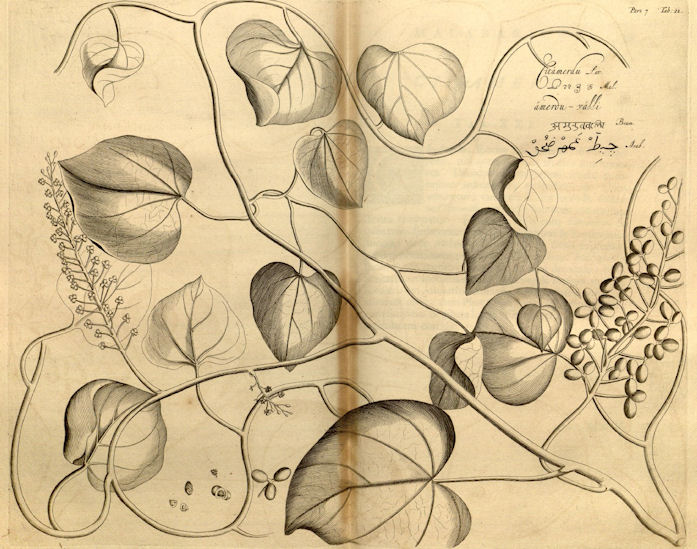
Abb.: गुडूची । Tinospora cordifolia (Willd.) Miers - Guduchi
[Bildquelle: Hortus malabaricus VII. Fig. 21, 1686]
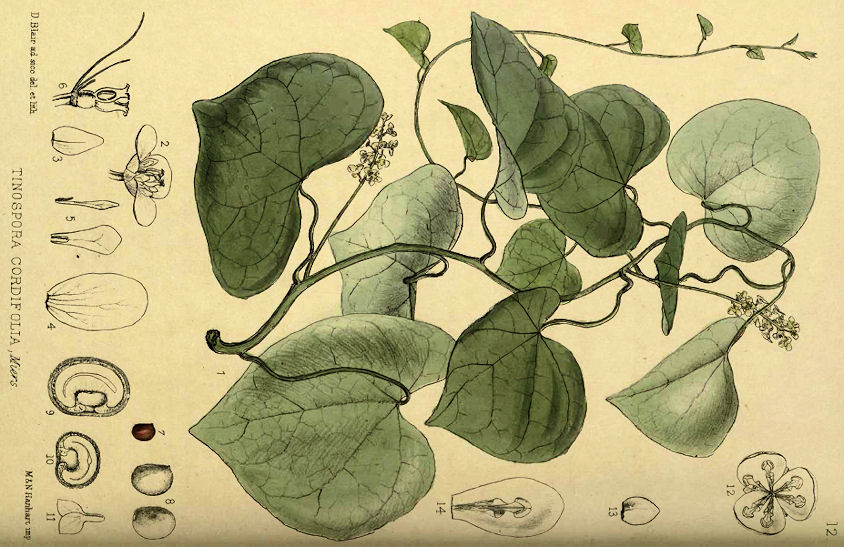
Abb.: तन्त्रिका । Tinospora cordifolia (Willd.) Miers - Guduchi
[Bildquelle: Medicinal plants. Being descriptions with original figures of the
principal plants employed in medicine and an account of the characters,
properties, and uses of their parts and products of medicinal value. / by Robert
Bentley and Henry Trimen. Plates by David Blair. In four volumes., 1880. -- vol.
1, pl. 12]
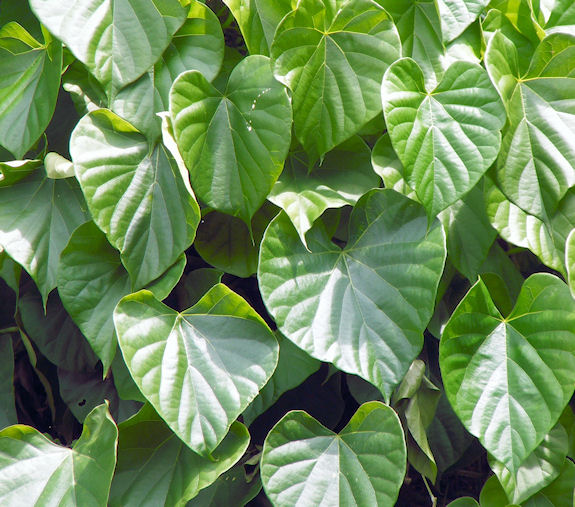
Abb.: मधुपर्णी । Tinospora cordifolia (Willd.) Miers - Guduchi
[Bildquelle: Trnd / Wikimedia. -- Public domain]
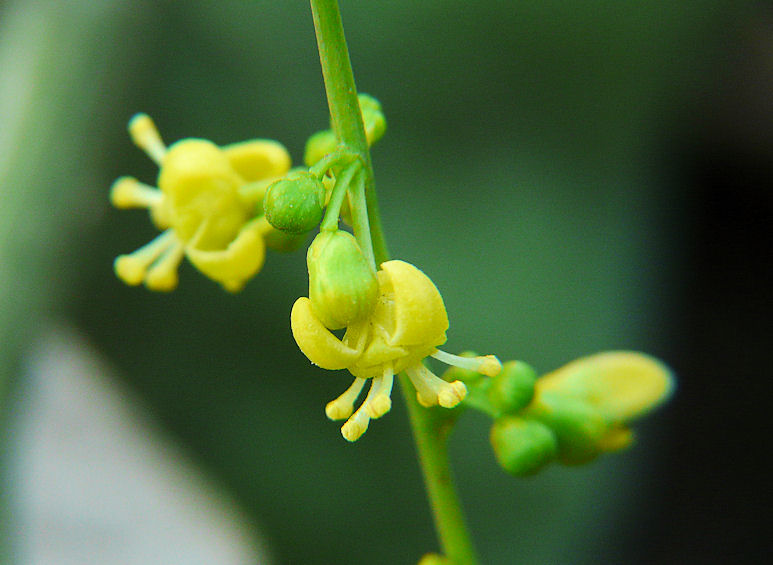
Abb.: सोमवल्ली । Tinospora cordifolia (Willd.) Miers ex Hook. f. & Thoms.
- Guduchi
[Bildquelle: dinesh_valke. --
http://www.flickr.com/photos/dinesh_valke/3052473798/. -- Zugriff am
2010-10-18. --
Creative
Commons Lizenz (Namensnennung, keine kommerzielle Nutzung, share alike)]
"Tinospora cordifolia (Miers). [...]
Description.—Twining shrub; [...]
Fl. April—July.
Hook. & Thoms. Fl. Ind. i 184. — W. & A. Prod. i. 12. — Wight Icon. ii t. 485.
Cocculus cordifolius, Dec.
Menispermum cordifolium, Willd.—Rheede, vii. t. 21.
Peninsula. Bengal. Assam.
Medical Uses.—What is known as Guluncha extract is procured from the stems of this plant It is a well-known specific in the bites of poisonous insects, as well as in fevers and rheumatism. The leaves beaten up and mixed with honey are applied externally to ulcers, and with oil to the head as a remedy in colds. In decoction they are given as a tonic in gout. The native practitioners use this plant extensively in a great variety of diseases, especially in fevers, jaundice, and visceral obstructions. The parts chiefly used are the roots, stem, and leaves, from which a decoction called Pachuna is prepared. The extract called Paho is procured also from the stem, and is reputed of much value in urinary affections.
Dr Wight states that from 15 to 20 grains of the powdered root constitute a good emetic, a fact also recorded by Ainslie, who especially remarks that it is a successful remedy in snake-bites, administered in the above dose about three times a-day, at an interval of twenty minutes between each dose. The bitterness of the extract varies according to the season when the plant is gathered, which should be during the hot weather. The young leaves bruised and mixed with milk are used as a liniment in erysipelas. It is stated in the ' Bengal Dispensatory' that in experiments made at the college hospital, the Guluncha was found to be a very useful tonic. The decoction or cold infusion was of great utility in chronic rheumatism and secondary venereal affections. Its action is decidedly diuretic and tonic in a high degree.—(Bengal Disp. Roxb. Trans. Med. and Phys. Soc., Calcutta. Ainslie.) The T. crispa (Miers), and some other allied species inhabiting various parts of India, possess the bitterness, and probably the tonic properties, of Guluncha.—Pharm. of India."
[Quelle: Drury, Heber <1819 - 1872>: The useful plants of India : with notices of their chief value in commerce, medicine, and the arts. -- 2d ed. with additions and corrections. London : Allen, 1873. -- xvi, 512 p. ; 22 cm. -- s.v.]
"TINOSPORA CORDIFOLIA, Miers. Fig.—Rheede, Hort. Mal. vii., 21 ; Bentl. and Trim., t. 12.
Hab.—Tropical India.
[...]
History, Uses, &c.—A well-known medicinal plant, long in use in Hindu medicine, and called in Sanskrit Guduchi, Pittaghni (bile-destroying), Bhishakpriya (dear to physicians), Nirjara (not perishing), &c. It is considered to be cold and dry, or according to Arabic and Persian writers, hot and dry in the first degree. In native practice it is much valued as an antiperiodic in fevers, and as a tonic and alterative; it is also credited with aphrodisiac properties.* The fresh plant is said to be more efficient than the dry; it is taken with milk in rheumatism, acidity of the urine and dyspepsia. The juice with Pakhanbed and honey is given in Gonorrhoea, and is an ingredient in Paushtiks given in Phthisis. In Guzerat, a necklace called Kamala-ni-mala (jaundice necklace) is made of small pieces of the stem, and is supposed to cure that disease. The stem, if placed upon a bush in the open air, will retain its vitality through the hot season, and when the rains commence, put forth leaves and long whipcord-like roots, which soon reach the ground, whence the Sanskrit synonym Chinnaruha, or, growing when cut. The plant is very common in many parts of India, and may always be obtained in the green state. Elephants are very fond of the stems, and the hill tribes in Sikkim give it to their cattle to cure pains in the stomach. The dry stem is to be seen in every drag shop ; from it is prepared a kind of starch known-in Hindustani as Giloe-ka-sat, and in some parts of India as Palo. It is prepared by powdering the stem and washing out the starch with water ; the latter retains a little of the bitterness of the drug. T. cordifolia appears first to have attracted the notice of Europeans in India at the early part of the present century, and to have been favourably spoken of by those who have tried it as a tonic, antiperiodic and diuretic, but it has never come into general use in European practice. It is now official in the Pharmacopoeia of India, and has lately (1884) been re-introduced to the notice of the profession in Europe as a specific tonic, antiperiodic and diuretic. (Zeitschrift des Oesterr. Apoth. Ver., J884, 312.)
* For original Sanskrit prescriptions, see Dutt's Hindu Materia Medica, p. 105; most of them contain several other equally active remedies."
[Quelle: Pharmacographia indica : a history of the principal drugs of vegetable origin met with in British India / by William Dymock [1834-1892], C. J. H. Warden and David Hooper [1858-1947]. -- Bd. 1. -- London, 1890. -- S. 54f.]
Asclepiadaceae (Seidenpflanzengewächse)
Rankengewächs
| 2. mūrvā devī madhurasā moraṭā tejanī sravā madhūlikā madhuśreṇī gokarṇī pīluparṇy api
मूर्वा देवी मधुरसा मोरटा तेजनी स्रवा । [Bezeichnungen für Marsdenia tenacissima (Roxb.) W. & A. 1824:]
|
Colebrooke (1807): "Aletris. Aletris hyacinthoides [zeylanica L. = Sansevieria zeylanica (L.) Willd. 1799 - Teufelszunge - Devil's Tongue] or Dracona nervosa [= Dracaena nervosa = Dracaena reflexa var. nervosa H. Perrier]"
Marsdenia tenacissima (Roxb.) W. & A. 1824
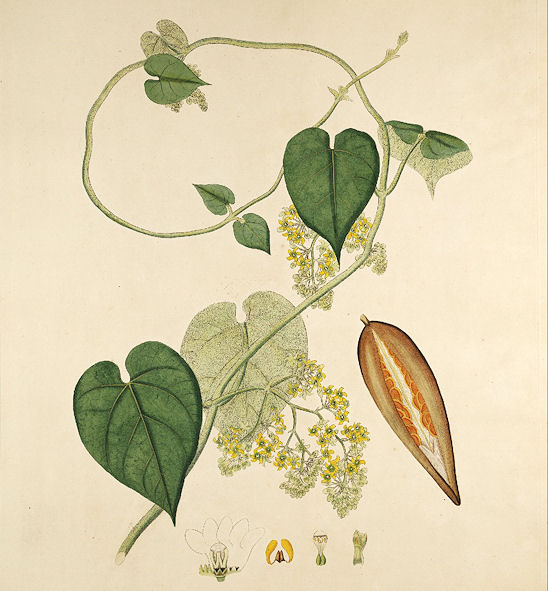
Abb.: गोकर्णी ।
Marsdenia tenacissima (Roxb.) W. & A. 1824 (Roxb.: Asclepias tenacissima)
[Bildquelle: Roxburgh. -- Vol III. -- 1819. -- Tab. 240. -- Image courtesy
Missouri Botanical Garden.
http://www.botanicus.org. --
Creative Commons Lizenz
(Namensnennung, keine kommerzielle Nutzung)]
"Aletris tenacissima. Roxb.
[...]
This plant is a native of the mountains near Rajemahl, and the fibres of its bark are employed by the inhabitants to make their bow strings.
This elegant, and very useful species was first taken notice of in 1800 by Mr.
W. Roxburgh, junior, growing wild on the above mentioned hills, and by him introduced into the Botanic Garden at Calcutta, where the plants thrive luxuriantly, blossom in April, and ripen their seed about ten months afterwards.Stem perennial, twining over trees, &c. to a very great extent, and in general about as thick as a large ratan. Branches few, young shoots downy. From wounds there exudes a milky juice, which thickens into an elastic substance, very like Caoutchouc and rubs out blacklead pencil lines as readily as that does, and I think
may be reckoned an additional species of it. [...]The bark of the young luxuriant shoots yields a large portion of beautiful fine silky fibres, with which the mountaineers of Rajemahl make their bow strings, on account of their great strength, and durability. During the rains, they cut the shoots into lengths at the insertion of the leases, peel off the barii, and with their nails, or a bit of stick on a board, remove the pulpy part. A person accustomed to this work, will, I
am told, clean as much as six pounds of the fibres in one day. These fibres, and those of the bark of the Malay plant Battang-callooee, or poolas (Urtica tenaclssima, R.) are by far the strongest fibres which I have met with in the vegetable kingdom, far exceeding those of the leaves of my Sanseviera Zeylanica. A line made of common hemp, for a standard, broke with 158 pounds when dry, and 190 when wet ; the average of several trials. A similar line of this substance broke with 248 when dry, and 343 when wet, while one of Battang-callooee broke with 240 when dry, and 278 when wet."[Quelle: Roxburgh, William <1751-1815>: Flora indica, or, Descriptions of Indian plants / by the late William Roxburgh. -- Serampore : Printed for W. Thacker, 1832. -- Vol. 2, S. 51ff.]
"Marsdenia tenacissima (R. W.) N. O. Asclepiaceae.
Description.—Twining; [...] flowers greenish yellow.
Fl. April.
Wight Contrib. p. 41.—Icon. t. 590.
Asclepias tenacissima, Roxb. Fl. Ind. ii. 51.—Cor. iii t. 240.
RajmahaL Chittagong. Mysore.
Economic Uses.—The bark of the young shoots yields a large portion of beautiful fine silky fibres, with which the mountaineers of Rajmahal make their bowstrings, on account of their great strength and durability. These fibres are much stronger than hemp, and even than those of the Sanseveria Zeylanica. A line of this substance broke with 248 lb. when dry, and 343 lb. when wet. Wight considers this species not to be a native of the Peninsula. The specimens in the Madras herbarium are—the one from the missionary's garden; the other (A. echinata) was sent to Klein by Heyne, but is not the plant of Roxburgh. The milk exuding from wounds made in the stem thickens into an elastic substance, acting like caoutchouc on black-lead marks.—(Roxb. Wight) Another species, the M. tinctoria, is cultivated in Northern India, being a native of Silhet and Burmah. The leaves yield more and superior indigo to the Indigofera tinctoria, on which account it has been recommended for more extensive cultivation.--Roxb. Wight."
[Quelle: Drury, Heber <1819 - 1872>: The useful plants of India : with notices of their chief value in commerce, medicine, and the arts. -- 2d ed. with additions and corrections. London : Allen, 1873. -- xvi, 512 p. ; 22 cm. -- s.v.]
Sansevieria zeylanica (L.) Willd. 1799 - Teufelszunge - Devil's Tongue
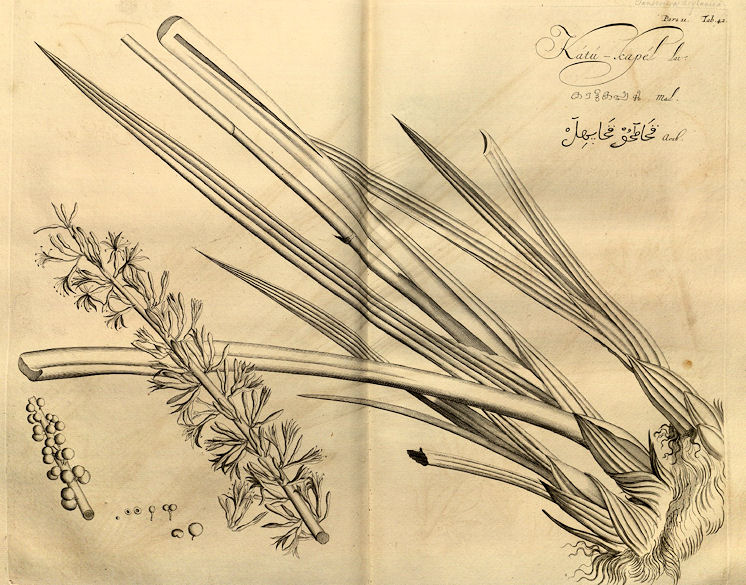
Abb.: Sansevieria
zeylanica (L.) Willd. 1799 - Teufelszunge - Devil's Tongue (?)
[Bildquelle: Hortus malabaricus XI. Fig.
42, 1692]
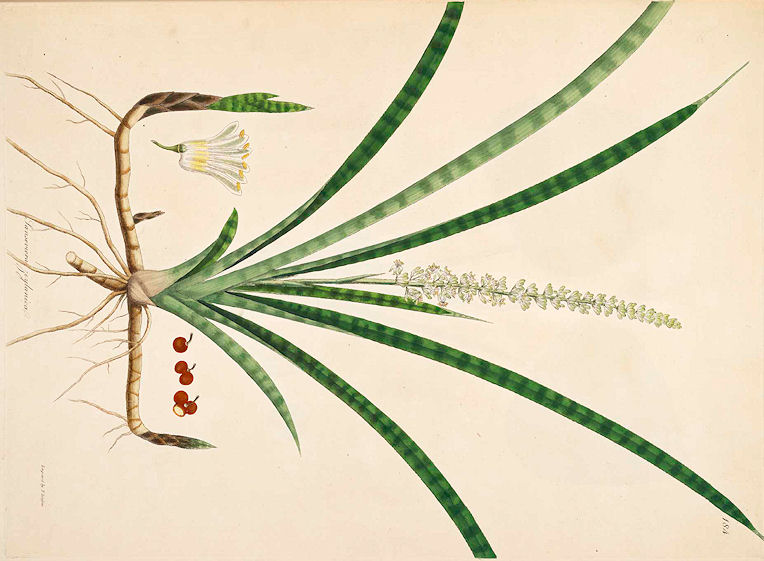
Abb.: Sansevieria zeylanica
(L.) Willd. 1799 - Teufelszunge - Devil's Tongue
[Bildquelle: Roxburgh. -- Vol II. --
1795. -- Tab. 184. -- Image courtesy Missouri Botanical Garden.
http://www.botanicus.org. --
Creative Commons Lizenz
(Namensnennung, keine kommerzielle Nutzung)]
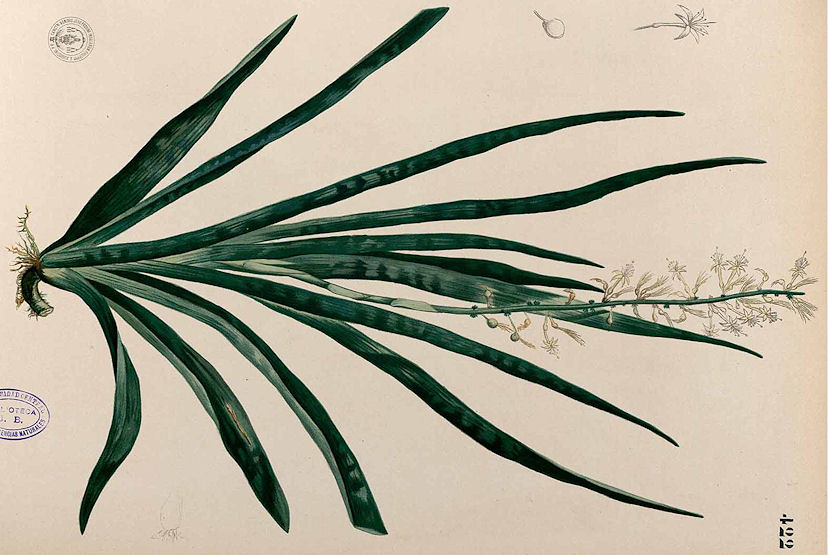
Abb.: Sansevieria zeylanica
(L.) Willd. 1799 - Teufelszunge - Devil's Tongue
[Bildquelle: Flora de Filipinas, 1880 /
Wikipedia. -- Public domain]
"Sanseviera Zeylanica (Willd.) N. O. Liliaceae. Bowstring Hemp [...]
Description. — Stemless ; roots perennial; [...]
Fl. Aug.—Sept
Roxb. Fl. Ind. ii. 161. —Cor. ii. 184.
S. Roxburghiana, Schult.
Bengal. Peninsula. Dindigul hills.
Economic Uses.—This species is probably not different from the S. Roxburghiana, though some botanists have separated the two species. The present one is well known for the excellent fibres it yields. It is easily propagated by cuttings, and thrives in almost any soil, throwing up abundance of fresh root-shoots, and thus extending itself in every direction.
The method of preparing the fibres usually adopted by the natives is to steep the leaves, which are 3 or 4 feet long, in water for several days, in order that the pulpy part may rot. The fibres are then easily separated, but putting them in water is apt to discolour them. In other cases they are first beaten to separate the fibres more easily, and placed on a board and scraped with a piece of rough stick or iron till all the pulp is removed. For every 40 lb. of the fresh leaves, Dr Roxburgh obtained about 11 lb. of the clean fibre; and he reckoned that two crops might be easily calculated upon where they are planted for the sake of these fibres. In 1831 the plant was discovered in the neighbourhood of Cuttack by the Rev. Mr. Garrow, and its fine qualities brought to light, as will be seen by the following notice quoted by Dr Royle: " In the course of a short time afterwards he discovered a short species of Aloe, growing wildly and profusely in all the moist woods of the neighbourhood, which the natives called Moorgabbee. On experiment, this plant produced a most beautiful fibre, as soft and as fine as human hair, but possessing, notwithstanding, extraordinary strength and tenacity. He derived a great quantity of flax from this plant, which, when portioned off in hanks, bore a strict resemblance to raw silk; indeed, side by side, the difference could not be distinguished. It was this article that first induced the writer to turn his attention to the manufacture of cloth. He engaged two native weavers to construct a narrow loom for this purpose. They at first found some difficulty in the undertaking, but in the course of four or five days they produced as fine a piece of cloth as was ever beheld."
The Moorva fibre is very soft, silky, and pliant, especially if well prepared, more resembling that of the pine-apple than any other. The fibres are used for ropes, twine, thread, bowstrings, and cord. They are considered valuable for the manufacture of paper, and are used for that purpose at Trichinopoly. Regarding the comparative strength of the Moorva fibre, Dr Roxburgh had a line 4 feet long, which bore a weight of 120 lb., a cord of similar size, made of Russian hemp, breaking at 105 lb. In other experiments the fibre in an untwisted state bore 280 lb., and Agave fibre only 270 lb.
This is certainly a plant deserving every attention for the sake of its fibre. Its easy propagation, its general distribution over the country, the simple process of preparing the fibre, and the variety of uses to which it can be applied, whether for rope, paper, cloth, or other purpose, render it valuable in every way.—Royle Fib. Plants. Roxb. Ainslie."
[Quelle: Drury, Heber <1819 - 1872>: The useful plants of India : with notices of their chief value in commerce, medicine, and the arts. -- 2d ed. with additions and corrections. London : Allen, 1873. -- xvi, 512 p. ; 22 cm. -- s.v.]
"SANSEVIERA ZEYLANICA, Willd. Fig.—Roxb. Cor. Pl. ii., t. 184; Bot Reg., t. 160; Rheede, Hort. Mai. xi. t. 42.
Bowstring Hemp (Eng.).
Hab.—Indian Peninsula.
[...]
History, Uses, &c.—This pant is the Murva of Sanskrit writers; it is mentioned by Manu (ii, 42,44) as the source of the fibre from which the bowstrings and girdle (maurti) of the Kshatriya or warrior caste of Hindus was made. In the Uttaracharitra the young prince Lava is represented as wearing a garland of Murva as symbolical of his position of warrior and penitent. In the Nighantas it bears numerous synonyms, such as Devi "goddess," Morata, Madhurasa, Madhusrava "having a sweet juice," Snighda-parni "having glossy leaves," Prithak-parni "diverse-leafed," Pilu-parni, &c., and is described as purgative, heavy, sweet, pungent, tonic, and cardiacal; a remedy for bile, heat of blood, gonorrhoea, tridosha (a corruption of the three humors), thirst, heart disease, itch, leprosy, fever, rheumatism, and glandular enlargements. Rheede gives the following account of its medicinel uses in Malabar:—"Folia trita et in formam boli redacta, adversus opthalmiam et oculorum suffusionem assumuntur: cum radice addito Allio ac Auripigmento in oleo Sergelim decocta, gonorrhaeam sanant, si nempe caput cum oleo illo illinatur. Bulbus cum Sandalo citrino et butyro bubulino tritus linimentum exhibet, in nervorum con- tractionibus et ardoribus adhibendum. Tota denique planta oleo butyroque incocta omnium acculorum vitia emendat."
Ainslie (Mat, Ind. ii., 192)remarks:—"This fleshy creeping root is, in a slight degree, warm to the taste, and of a not unpleasant odour; and is prescribed, by the native practitioners, in the form of an electuary, in consumptive complaints and coughs of long standing, to the quantity of a small teaspoonful twice daily. The juice of the tender shoots of the plants they administer to children to clear their throats of viscid phlegm. The plant is cultivated in great abundance at Cumbum, and jon the Vursenand Mountains in the Dindigul District.""
[Quelle: Pharmacographia indica : a history of the principal drugs of vegetable origin met with in British India / by William Dymock [1834-1892], C. J. H. Warden and David Hooper [1858-1947]. -- Bd. 3. -- London, 1893. -- S. 493f.]
Dracaena reflexa Lam.
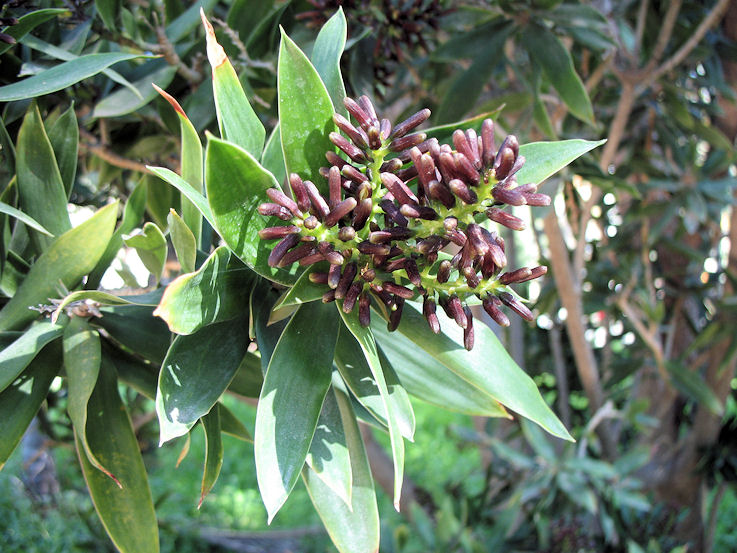
Abb.: Dracaena reflexa Lam., Malaga, Spanien
[Bildquelle: tree-species. --
http://www.flickr.com/photos/22327649@N03/2194886667/. -- Zugriff am
2010-11-18. --
Creative Commons Lizenz (Namensnennung)]
Menispermaceae (Mondsamengewächse)
Rankengewächs
| 3. pāṭāmbaṣṭhā viddhakarṇī sthāpanī śreyasī rasā ekāṣṭhīlā pāpacelī prācīnā vanatiktikā
पाटाम्बष्ठा विद्धकर्णी स्थापनी श्रेयसी रसा । [Bezeichnungen für Cissampelos pareira L.:]
|
Colebrooke (1807): "Acanadi. Cissampelos hexandra [Roxb.]"
Cissampelos pareira L.
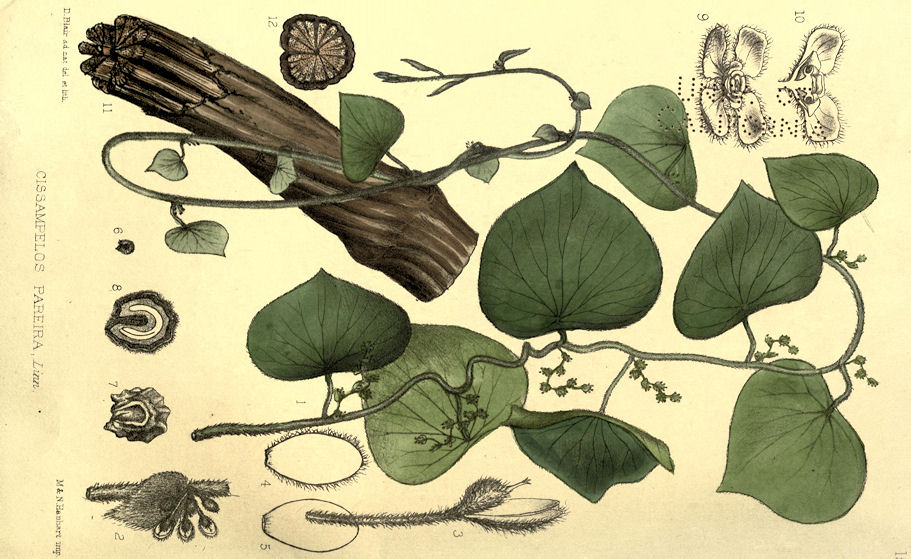
Abb.: स्थापनी । Cissampelos pareira L.
[Bildquelle: Medicinal plants. Being descriptions with original figures of the
principal plants employed in medicine and an account of the characters,
properties, and uses of their parts and products of medicinal value. / by Robert
Bentley and Henry Trimen. Plates by David Blair. In four volumes., 1880. -- vol.
1, pl. 15]
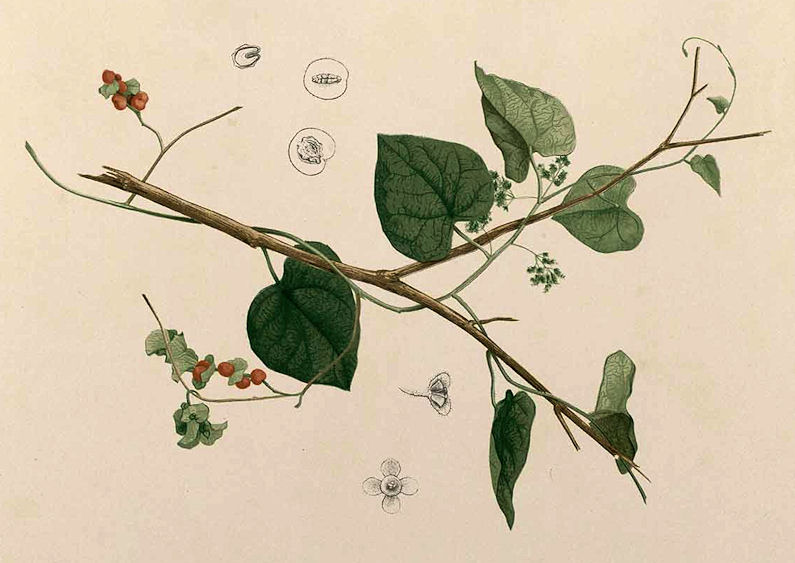
Abb.: श्रेयसी ।
Cissampelos pareira L.
[Bildquelle. Flora de Filipinas 1880 / Wikimedia. -- Public domain]
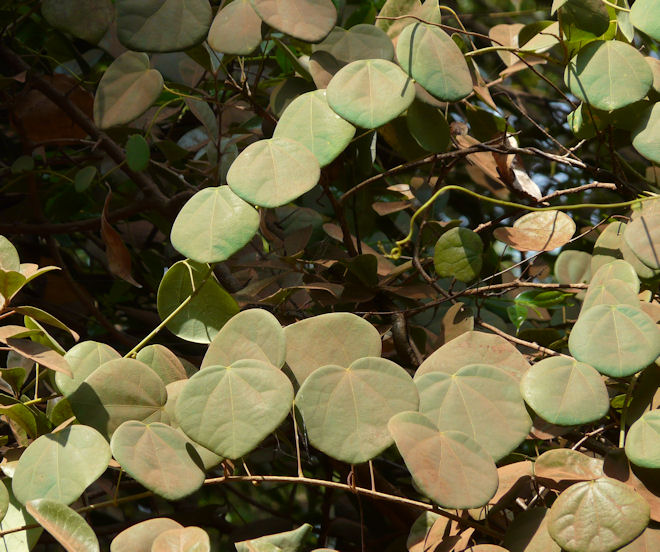
Abb.: पाटा । Cissampelos pareira L.
[Bildquelle: dinesh_valke. --
http://www.flickr.com/photos/dinesh_valke/3296117955/. -- Zugriff am
2010-10-18. --
Creative
Commons Lizenz (Namensnennung, keine kommerzielle Nutzung, share alike)]
"Cissampelos Pareira (Willd.) N. O. Menispermaceae.
[...]
Description.—Twining; [...] flowers very small, yellowish.
Fl. April—Aug.
W. & A. Prod, i. 14.—Roxb. Fl. Ind. iii. 841.
Common in hedges. Peninsula. Rajmahal. NepauL
Medical Uses.—The dried root is at first sweetish and aromatic, and afterwards becomes intensely bitter. It is employed as a mild tonic and diuretic.—Pharm. of India."
[Quelle: Drury, Heber <1819 - 1872>: The useful plants of India : with notices of their chief value in commerce, medicine, and the arts. -- 2d ed. with additions and corrections. London : Allen, 1873. -- xvi, 512 p. ; 22 cm. -- s.v.]
"CISSAMPELOS PAREIRA, Linn.
Fig.—Bentl. and Trim., t. 15.
Hab.—Tropical and sub-tropical India. Cosmopolitan in warm regions.
[...]
History, Uses, &C—The plant appears to have been long in use as a bitter tonic and diuretic in Northern and Southern India, and is mentioned by Ainslie. Chakradatta recommends it in fever with diarrhoea and in internal inflammations ; it is combined in native practice with bitters and aromatics. In Europe it has never been an article of commerce, though for a long time it was supposed to produce the Pareira root of the shops (confer. Pharmacographia, p. 25). The Sanskrit names are Ambashta, Patha and Venivela (braided creeper), Pahadamula and Akanadi. In the Punjab and Sind the leaves and roots are employed in the cure of ulcers and in Pudukota for dysentery. The drug is not used in Europe; it appears to act as a mild tonic and diuretic. It is reputed to be antilithic."
[Quelle: Pharmacographia indica : a history of the principal drugs of vegetable origin met with in British India / by William Dymock [1834-1892], C. J. H. Warden and David Hooper [1858-1947]. -- Bd. 1. -- London, 1890. -- S. 53.]
Cissampelos hexandra Roxb.
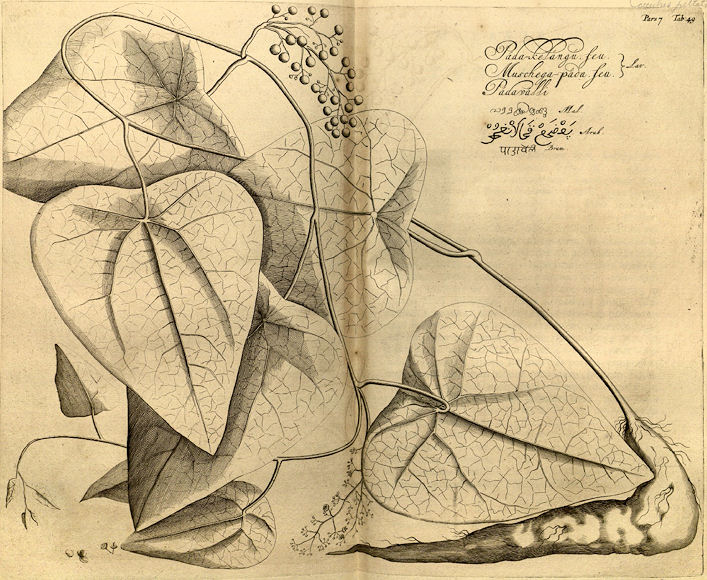
Abb.: Cissampelos
hexandra Roxb.
[Bildquelle: Hortus malabaricus VII. Fig. 49, 1686]
"Cissampelos hexandra. Roxb
[...]
Pada-valli, or Pada kelangu, Rheed. Mal. vii. t. 49. is like the female plant.
Stephania rotunda. Lourier. Cochinch. 747.
Menispennum peltatum. Willd. iv. 827.
A native of Bengal. Flowering time the beginning of the rains."
[Quelle: Roxburgh, William <1751-1815>: Flora indica, or, Descriptions of Indian plants / by the late William Roxburgh. -- Serampore : Printed for W. Thacker, 1832. -- Vol. 3, S. 841.]
Scrophulariaceae (Braunwurzgewächse / Rachenblütler)
| 4. kaṭuḥ kaṭambharāśokarohiṇī kaṭurohiṇī matsyapittā kṛṣṇabhedī cakrāṅgī śakulādanī
कटुः कटम्भराशोकरोहिणी कटुरोहिणी । [Bezeichnungen für Picrorrhiza kurroa Royle ex Benth. 1835:]
|
Colebrooke (1807): "Catuci. A medicinal plant so called."
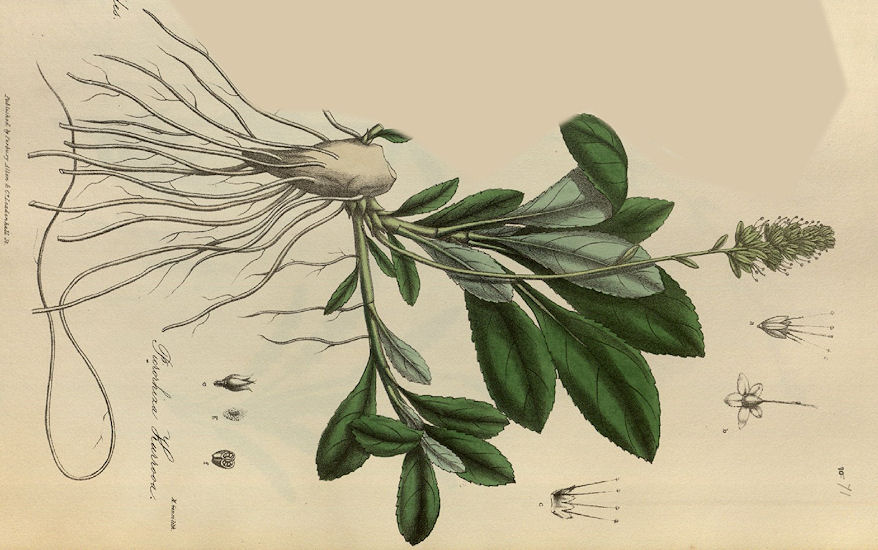
Abb.: कटुः ।
Picrorrhiza kurroa Royle ex Benth. 1835
[Bildquelle: Royle, J. Forbes <1799-1858>: Illustrations of the botany and other
branches of the natural history of the Himalayan Mountains :and of the flora of
Cashmere. -- Vol 2: Plates. -- London : Allen, 1839. -- Pl. 71.]
"PICRORHIZA KURROOA, Benth. Fig.—Royle III, t. 71.
Hab.—Alpine Himalaya; from Cashmere to Sikkim.
[...]
History, Uses, &c.—This well-known drug is the Kutaki of Sanskrit writers, who speak of it as Dhanvantari-grasta, " the plant eaten by Dhanvantari," the physician of the gods, who was produced at the churning of the Ocean, holding a cup of amrita in his hands; he was the author of the Ayurveda. In the Nighantas it bears the following synonyms: Rohini, Katu-rohini, Vakragra, Matsya-pitta, Matsya-vinna, Kanda-ruha, Krishna-bhedi, Dvijangika, Asoka-rohini, Sakuladani and Chakranga. It is described as digestive, bitter, pungent, dry, aperient, light and cold; and is recommended as a remedy for worms, asthma, bile, phlegm, and fever. Kutaki is a favorite remedy in bilious dyspepsia accompanied by fever, and is given daily in decoction, with liquorice, raisins, and Neem bark, half a tola (90 grains) of each, water 32 tolas, boiled down to one-fourth. In dyspepsia and dysentery it is combined with aromatics and is given in doses of ten to twenty grains.
It is considered to be specially indicated in those cases in which the secretions are scanty and the bowels costive, and is often prescribed for children suffering from worms, whence the Marathi name Balakadu, "children's bitter."
Chakradatta states that about two drachms of the powdered root given with sugar and warm water act as a gentle aperient. Mahometan writers give Katki or Kutki as an Indian synonym for black Hellebore, and unmistakably describe the latter plant and its medicinal properties. This mistake has misled most European writers upon Indian drugs, but Ainslie, though he describes the drug in his article upon black Hellebore (Mat. Ind., p. 164), has the following remarks:—"I have given the names Kadagoroganie and Kali-kootkie as the Tamool and Dukhanie appellations of the black Hellebore, as the root procured in the Indian bazars is commonly said to be so; but I have great doubts of it, and I here offer a caution respecting it, as it by no means agrees in appearance with the black Hellebore of the European shops."
Royle (III. p. 291) notices that the root of P. Kurrooa possesses much bitterness and is employed medicinally by the natives. Irvine (Mat. Med. p. 58) mentions the use of Kutki as a tonic, but owing to a general impression that the bazar drug was Hellebore root, European medical men appear to have generally avoided making experiments with it. Mr. Moodin Sheriff was the first modern writer to clearly demonstrate that the bazar drug has no dangerous properties, but is a valuable tonic and antiperiodic. He also identified it with the P. Kurrooa of Royle, an identification which we are now able to confirm through the kindness of Mr. J. F. Duthie who has supplied us with a specimen of the plant collected in Kumaon. As regards the medicinal properties of the drug, the accounts given by Sanskrit writers appear to be correct. Mr. M. Sheriff speaks favourably of it as a powerful bitter tonic and anti- periodic. Other medical men in India have expressed a similar opinion, and we can state from personal observation that it is used successfully as an antiperiodic in native practice; its slight laxative action is rather benefioial than otherwise. The dose as a tonic is from 10 to 20 grains, as an antiperiodic from 40 to 50 grains; it is best administered in combination with aromatics."
[Quelle: Pharmacographia indica : a history of the principal drugs of vegetable origin met with in British India / by William Dymock [1834-1892], C. J. H. Warden and David Hooper [1858-1947]. -- Bd. 3. -- London, 1893. -- S. 10f.]
Fabaceae (Hülsenfrüchtler)
Einjährige (selten zweijährige) krautige Kletterpflanze
| 5. ātmaguptā jaḍāvyaṇḍā kaṇḍūrā prāvṛṣāyaṇī ṛṣyaproktā śūkaśimbiḥ kapikacchuś ca markaṭī
आत्मगुप्ता जडाव्यण्डा कण्डूरा प्रावृषायणी । [Bezeichnungen für Mucuna pruriens (L.) DC. 1825 - Samtige Juckbohne - Velvetbean:]
|
Colebrooke (1807): "Cawach or Cowitch. Dolichos pruriens [L. = Mucuna pruriens (L.) DC. 1825]"
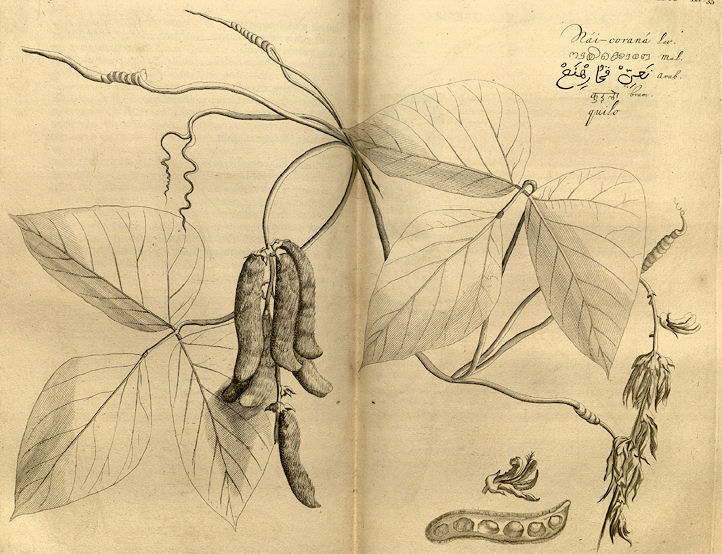
Abb.: आत्मगुप्ता । Mucuna pruriens (L.) DC. 1825 - Samtige
Juckbohne - Velvetbean
[Bildquelle: Hortus malabaricus VIII. Fig. 35, 1688]
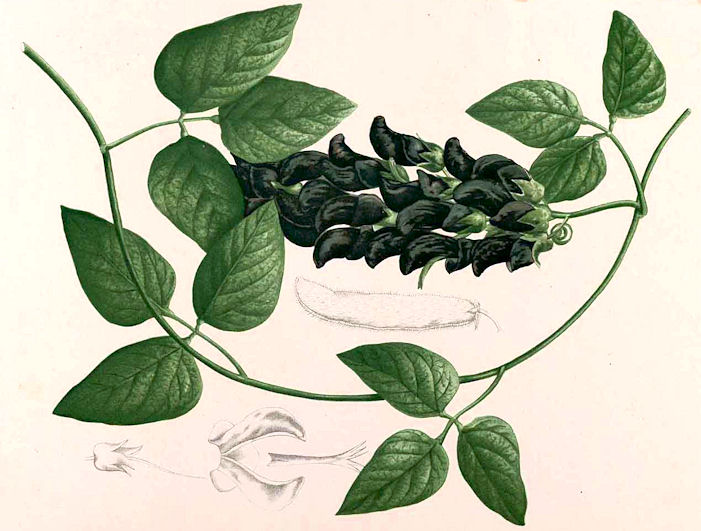
Abb.:
जडा । Mucuna pruriens (L.) DC.
1825 - Samtige Juckbohne - Velvetbean
[Bildquelle. Flora de Filipinas 1880 / Wikimedia. -- Public domain]
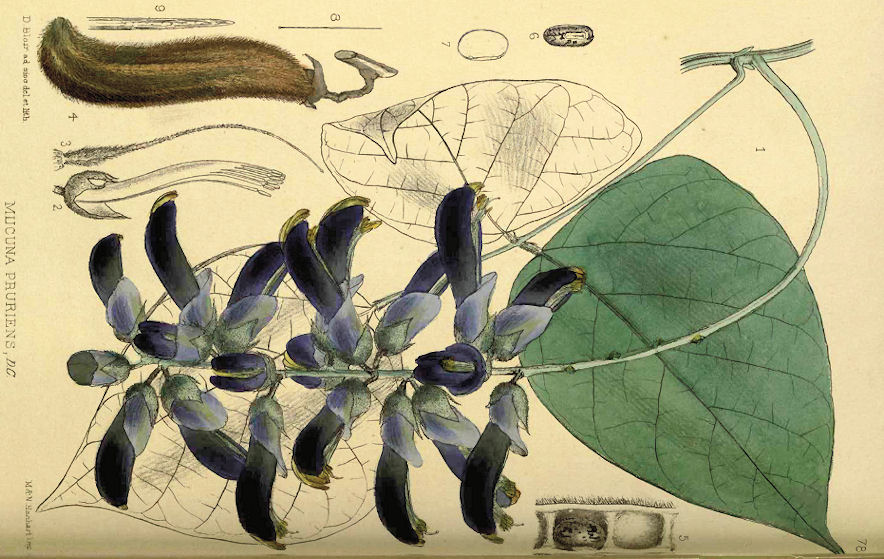
Abb.: कण्डूरा । Mucuna pruriens (L.) DC. 1825 -
Samtige Juckbohne - Velvetbean
[Bildquelle: Medicinal plants. Being descriptions with original figures of the
principal plants employed in medicine and an account of the characters,
properties, and uses of their parts and products of medicinal value. / by Robert
Bentley and Henry Trimen. Plates by David Blair. In four volumes., 1880. -- vol.
1, pl. 78]
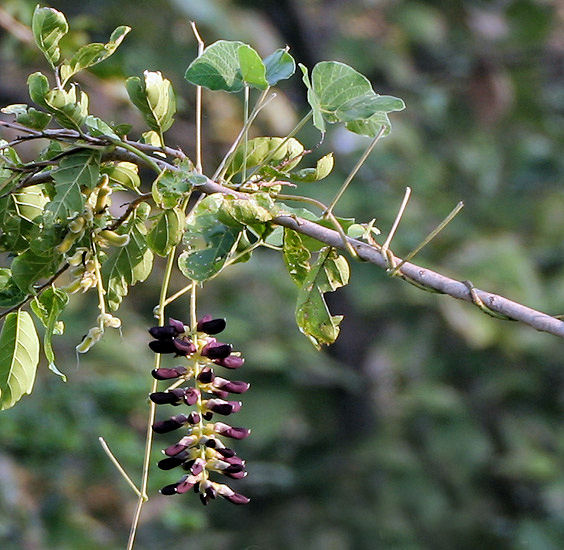
Abb.: जडा । Mucuna
pruriens (L.) DC. 1825 - Samtige Juckbohne - Velvetbean, Kawal Wildlife
Sanctuary, Andhra Pradesh
[Bildquelle: J. M. Garg / Wikipedia. -- GNU FDLicense]
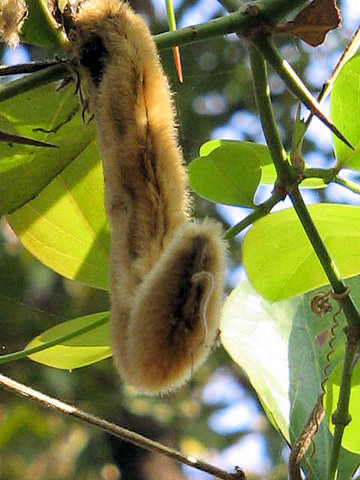
Abb.: आत्मगुप्ता ।
अव्यण्डा । शूकशिम्बिः । Mucuna pruriens (L.) DC. 1825 - Samtige Juckbohne
- Velvetbean
[Bildquelle: shobha
r. --
http://www.flickr.com/photos/9336138@N03/1400053341. -- Zugriff am
2010-10-18. -- Creative
Commons Lizenz (Namensnennung)]
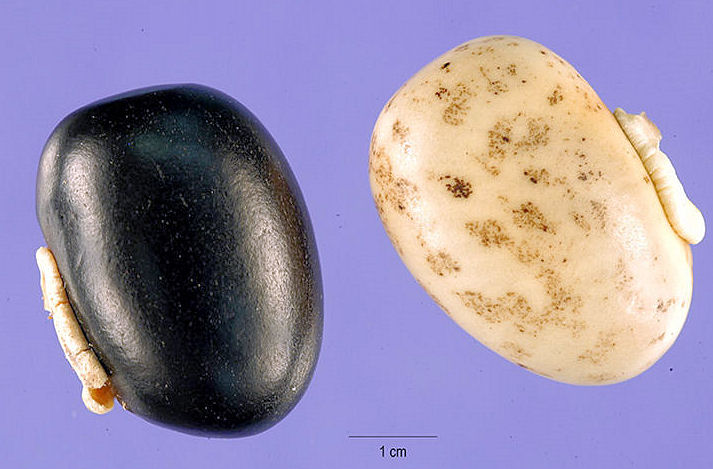
Abb.: Mucuna pruriens
(L.) DC. 1825 - Samtige Juckbohne - Velvetbean
[Bildquelle: USDA-NRCS / Wikipedia. -- Public domain]
"Carpopogon pruriens. Roxb.
Annual, twining.
[...]
Dolichos pruriens. Linn. Supp. 657. &c.
Nai-corana. Rheede Mal. viii. t. 35.
Sans. Murkuti. Alma goopta or Kupikuchoo,
Common in hedges, in most parts of India.
Flowering time the cold season.
I have never been able to learn that the natives of these parts of India, make any use of any part of this plant, except the hairs of the legumes which they do not use as a medicine, (vermifuge) but as an ingredient to help to poison wells. However its having been of late taken inwardly to destroy worms, proves that it is not that poison they take it for ; and it is more than likely that the other plants enjployed for ihe same base end, are fortunately much less dangerous than those who employ them imagine. Indeed it is only the most ignorant, superstitious Poligar mountaineers who are known to attempt to poison water. Nor can it be done to any other than such as is confined in wells, or small tanks."
[Quelle: Roxburgh, William <1751-1815>: Flora indica, or, Descriptions of Indian plants / by the late William Roxburgh. -- Serampore : Printed for W. Thacker, 1832. -- Vol. 3, S. 283.]
"Mucuna prurita (Hook.) Cowhage [...]
Description.—Annual, twining; [...] flowers large, dark purple.
Fl. Dec.—Feb.
W. & A. Prod. i. 255.
Carpopogon pruriens, Roxb.—Rheede, viii. t. 35.
Peninsula. Bengal. Dheyra Dhoon.
Medical Uses.—The root in infusion is administered in cholera, and a syrup thickened with the hairs till it is of the consistence of honey is prescribed by European practitioners as a good anthelmintic ; but the natives do not use the stinging hairs of the pods for this purpose. There is no doubt, Ainslie observes, but that it is simply by these mechanical means that the hairs act in worm cases. Neither the tincture nor decoction has the same effect. If the pods are incautiously touched, they will cause an intolerable itching in the fingers. In the West Indies a decoction of the root is reckoned a powerful diuretic and cleanser of the kidneys, and is also made into an ointment for elephantiasis. The leaves are applied to ulcers, and the beans reckoned aphrodisiac. A vinous infusion of the pods (12 to a quart) is said to be a certain remedy for the dropsy.—Ainslie. Rheede.
Economic Uses.—The seeds of many species are edible, and reckoned equal to the English bean. Among these may be enumerated the M. monosperma (Dec.), known as the Negro Bean, a favourite vegetable with Brahmins; the M. nivea is also cultivated, the tender fleshy pods of which, when stripped of their exterior skin, make a most excellent vegetable for the table, scarcely inferior to the garden-bean of Europe. The present species is a native of both Indies. The seed is said to absorb the poison of scorpions, and to remain on the sting until all is removed.—Powell's Punj. Prod. Roxb."
[Quelle: Drury, Heber <1819 - 1872>: The useful plants of India : with notices of their chief value in commerce, medicine, and the arts. -- 2d ed. with additions and corrections. London : Allen, 1873. -- xvi, 512 p. ; 22 cm. -- s.v.]
"MUCUNA PRURIENS, DC.
Fig.—Wight Ic., t. 280; Bentl. and Trim., t. 78.
Cowhage
Hab.—From the Himalayas in the plains, to Ceylon and Burma.
History, Uses, &c.—The plant has long been used medicinally by the Hindus; according to Susruta the seeds are aphrodisiac. The Bhavaprakasa gives the following directions for their administration:—"Take of Mucuna seeds 82 tolas, boil them in 4 seers of cow's milk till the latter becomes thick. The seeds should now be decorticated and pounded, fried in ghi (clarified butter), and made into a confection with double their weight of sugar. The mass should then be divided into balls and steeped in honey. Dose about a told (180 grs.)." This preparation is said to be powerfully aphrodisiac. (Dutt's Hindu Materia Medica, p. 148.) Similar properties are ascribed to the seeds (Hab-el-kulai) in Persian works, In the Concan a paushtik for spermatorrhoea is made by powdering the seeds of Gori Ruhili (cultivated mucuna) and Tribulus terrestris, the roots of Eriodendron anfractuosum and Asparagus adscendens, emblic myrobalans, Tinospora starch, and sugar candy, in equal proportions; of this powder 6 massa with 2 tolas of ghi are given in cow's milk twice a day. The root is considered a nervine tonic, and is prescribed in' paralysis.. The Sanskrit names of the plant are Atmagupta, "having hidden properties," Kapikachchhu, "monkey's itch," and Vanari, "monkey plant." According to Ainslie, a strong infusion of the root, sweetened with honey, is given by the Tamil doctors in cholera. The use of the hairs of the Mucuna pod as a vermifuge to expel ascarides appears to have originated in the .West Indies, no mention of such an employment of them being found in native Indian works.* They were introduced to the notice of English physicians by Bancroft about 1769, and were probably first used in India upon their admission into the Edinburgh and London Pharmacopeias (1783-1609). They are now official in the Indian Pharmacopoeia, but are hardly ever prescribed in this country. Still there is a considerable demand for the article in the Indian market for exportation to Europe, and it is supposed to be required for the preparation of some patent vermifuge.
* In the Wanaushadi Prakasha, a Marathi work which describes the domestic remedies of the Concan, their use with gur as an anthelmintic is mentioned, but as this work is of very recent date, the practice may have been introduced."
[Quelle: Pharmacographia indica : a history of the principal drugs of vegetable origin met with in British India / by William Dymock [1834-1892], C. J. H. Warden and David Hooper [1858-1947]. -- Bd. 1. -- London, 1890. -- S. 447f.]
Euphorbiaceae (Wolfsmilchgewächse)
Kleiner Baum
| 6.citropacitrā nyagrodhī dravantī śambarī vṛśā pratyakśreṇī sutaśreṇī raṇḍā mūṣikaparṇy api
चित्रोपचित्रा न्यग्रोधी द्रवन्ती शम्बरी वृशा । [Bezeichnungen für Croton tiglium L. 1753 - Krotonölbaum - Purging Croton:]
|
Colebrooke (1807): "Musali. A medical plant; probably Anthericum tuberosum, R[oxb.] Mss. [= Chlorophytum tuberosum (Roxb) Baker]"
1 शम्बरी - śambarī f.: Śambarī
"ŚAMBARA. In the Vedas, a demon, also called a Dasyu, who fought against King Divodasa, but was defeated and had his many castles destroyed by Indra. He appears to be a mythical personification of drought, of a kindred character to Vṛtra, or identical with him. In the Purāṇas a Daitya who carried off Pradyumna and threw him into the sea, but was subsequently slain by him. (See Pradjumna.) He was also employed by Hiraṇya-kaśipu to destroy Prahlāda." [Quelle: Dowson, John <1820-1881>: A classical dictionary of Hindu mythology and religion, geography, history, and literature. -- London, Trübner, 1879. -- s.v. ]
Croton tiglium L. 1753 - Krotonölbaum - Purging Croton
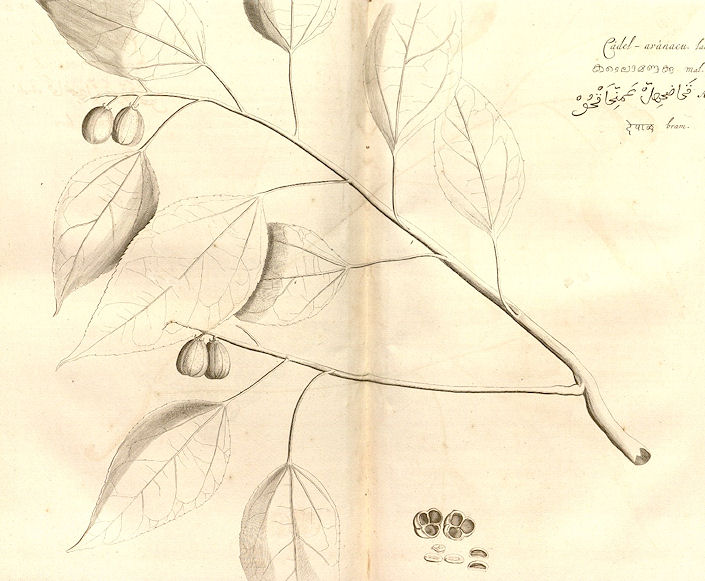
Abb.: द्रवन्ती । Croton tiglium L. 1753 -
Krotonölbaum - Purging Croton
[Bildquelle: Hortus malabaricus II. Fig. 33, 1679]
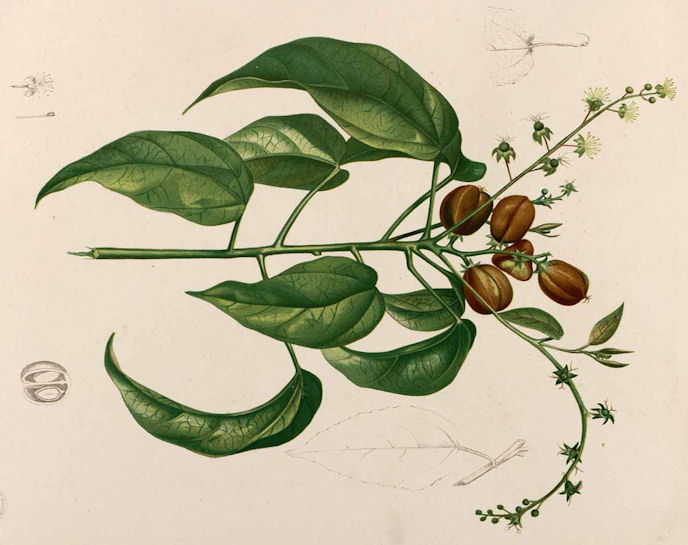
Abb.: मूषिकपर्णी । Croton tiglium L. 1753 - Krotonölbaum - Purging Croton
[Bildquelle. Flora de Filipinas 1880 / Wikimedia.
-- Public domain]
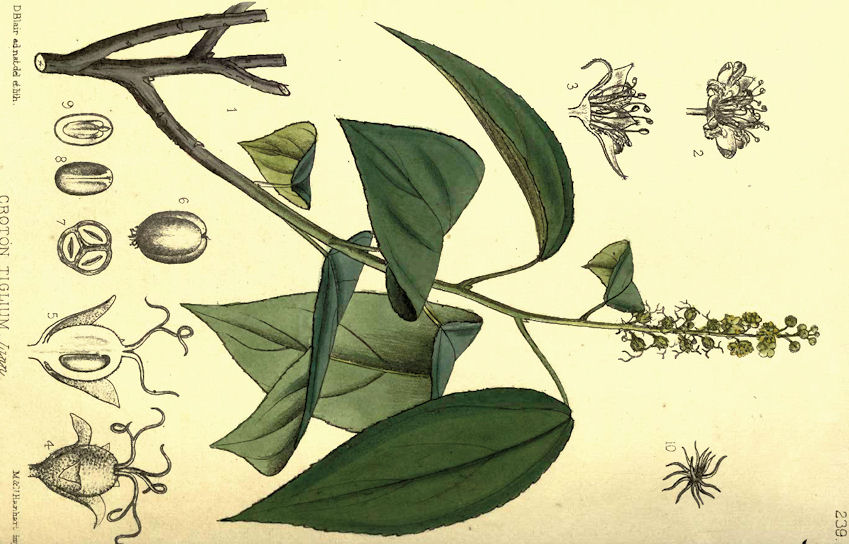
Abb.: सुतश्रेणी । Croton tiglium L. 1753 -
Krotonölbaum - Purging Croton
[Bildquelle: Medicinal plants. Being descriptions with original figures of the
principal plants employed in medicine and an account of the characters,
properties, and uses of their parts and products of medicinal value. / by Robert
Bentley and Henry Trimen. Plates by David Blair. In four volumes., 1880. -- vol.
2, pl. 239]
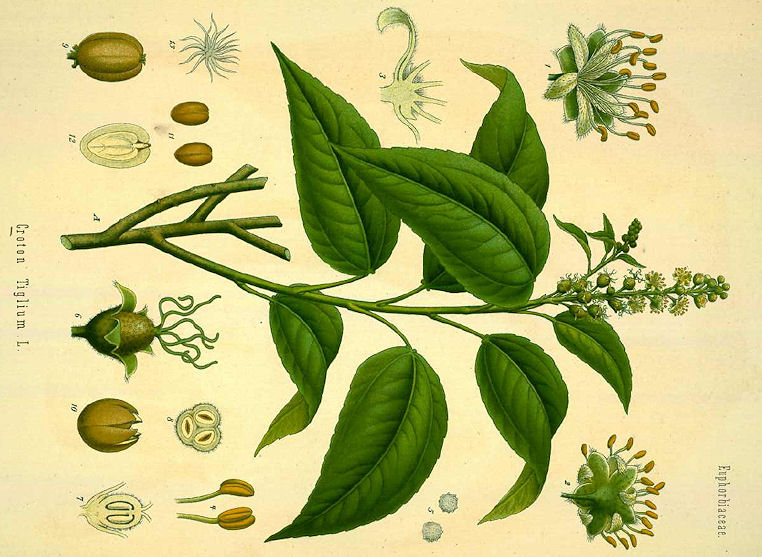
Abb.: प्रत्यक्श्रेणी । Croton tiglium L. 1753 -
Krotonölbaum - Purging Croton
[Bildquelle: Köhler, 1883-1914]
"Croton Tiglium. Willd. iv. 453.
Arboreous. [...]
Sans, Jayapala.
Cadai avanacu, Rheed. Mal. ii. t. 33.
Granum Moluccum. Rumph. Amb. iv. t. 42.
It grows to be a small tree, from fifteen to twenty feet in height, in the Company's Botanic garden at Calcutta, and in flower most part of the year.
[...]
The tree has a disagreeable smell, the taste of the leaves is exceedingly nauseous and of long duration. Tamul Physicians say the seed of this tree purges efiectually and easily, removing all obstructions in the bowels ; and that it cures all venereal complaints, and bites of venomous animals."
[Quelle: Roxburgh, William <1751-1815>: Flora indica, or, Descriptions of Indian plants / by the late William Roxburgh. -- Serampore : Printed for W. Thacker, 1832. -- Vol. 3, S. 682f.]
"Croton tiglium (Linn.) N. O. Euphorbiaceae. Croton-oil plant [...]
Description.—Small tree with a few spreading branches; [...] flowers small, downy, greenish yellow.
Fl. April—June.
Wight Icon. t. 1914 .—Roxb. Fl. Ind. iii. 682.—Rheede, ii. t. 33.
Coromandel. Travancore.
Medical Uses.—The seeds yield the well-known Croton-oil. They are the size of a sloe, and are considered one of the most drastic purgatives known. Ten or twenty seeds have been known to kill a horse by producing the most violent diarrhoea. The usual way to get the oil is first to roast the seeds and then compress them. The colour is brownish, or brownish yellow, soluble in fixed and volatile oils. So powerful is its action that a single drop of the oil applied to the tongue is considered sufficient to insure the full results, especially in incipient apoplexy, paralysis of the throat, or difficulty of breathing arising from these causes, even should the patient be insensible at the time. But this must be of the pure oil, for it is often adulterated with olive, castor, or purging nut oil. It is also employed in visceral obstruction, and occasionally in dropsy. The seeds mixed with honey and water are often applied to obstinate buboes in native practice. The expressed oil of the seed is a good remedy, externally applied, in rheumatism and indolent tumours. Rheede says that the leaves rubbed and soaked in water are also purgative, and when dried and powdered are a good application to snake-bites. If the leaves are chewed they inflame the mouth and lips, and cause them to swell, leaving a burning sensation. The mode of preparing the oil in Ceylon is by pulverising the seeds; the powder is then put into bags, placed between sheets of iron, left to stand for a fortnight and then filtered. Alcohol is then added to twice the weight of the residue. Much caution is requisite to avoid injury from the fumes which arise during the process. The wood, which is bitter-tasted, is gently emetic and powerfully sudorific.—(Ainslie. Roxb. Lindley.) The seeds of the G. polyandrum are reckoned a useful purgative. The natives mix them with water, administering two or three at a time, according to circumstances.—Roxb. Lindley."
[Quelle: Drury, Heber <1819 - 1872>: The useful plants of India : with notices of their chief value in commerce, medicine, and the arts. -- 2d ed. with additions and corrections. London : Allen, 1873. -- xvi, 512 p. ; 22 cm. -- s.v.]
"CROTON TIGLIUM, Linn. Fig.—Bentl. and Trim., t. 239; Rheede, Hort. Mal. ii. t. 33.
Purging Croton
Hab.—China. Cultivated in India.
[...]
History, Uses, &c.—Croton seeds were not known to the ancient Hindu physicians; in recent Sanskrit works they are noticed under the names of Jayapala, Tittiriphala and Kanakaphala, and are described as heavy, mucilaginous and purgative, useful in fever, constipation, enlargements of the abdominal viscera, ascites, anasarca, cough, &c., expelling bile and phlegm. They are directed to be boiled in milk, the outer skin and embryo having been removed, to fit them for internal administration. The following prescription from the Bhavaprakasa may be taken as an example :—
Mahanaracha rasa.—Take Chebulic myrobalans, pulp of Cassia fistula, Emblic myrobalans, root of Baliospermum axillare (danti), Picrorhiza Kurrooa (tikta), milky juice of Euphorbia neriifolia (snuhi), root of Ipomoea Turpethum (trivrit), and the tubers of Cyperus rotundus (mustaka), each one tola : pound them to a coarse powder, and boil in four seers of water till the latter is reduced to one-eighth. Then take a tola of husked Croton seeds, tie them in a piece of thin cloth, and boil them in the abovementioned decoction, till the latter is reduced to the consistence of a fluid extract. To this extract add a powder composed of eight parts of purified Croton seeds, three parts of ginger, and two of black pepper, mercury, and sulphur in quantity sufficient to make a pill mass ; rub them together for twelve hours, and make into two-grain pills. These are given with cold water in tympanitis, colic, ascites, &c., as a drastic purgative. After the operation of this medicine, rice should be given with curdled milk and sugar.
The Indian names for Croton seeds lead us to suppose that they were first introduced into the country through Nepal. Under the name of Dand they were known to the Persians at a very early date, and were doubtless introduced into that country from China by the Caravan route through Central Asia. The Arabs retained the Persian name, but also called them Hab-el-khatai, " Cathay seeds," and Hab-el-salatin, "Sultans' seeds." Ibn Sina describes them under the name of Dand-el-sini, "China Dand," and also mentions an Indian Dand of smaller size (probably Baliospermum seeds). Ainslie states that Croton seeds were known to the Arabs under the name of Fill, but this is incorrect, as may be seen by referring to Ibn Sina, who describes Fil as an Indian drug having the properties of the Mandrake. Mahometan physicians describe the seeds as detergent, a purgative of phlegm, black bile, and adust humors; and recommend their use in dropsy, calculus, gout, and other diseases arising from cold humors. On account of its irritant action upon the fauces, the seed, after having been boiled in milk, is to be crushed and enclosed in a raisin for administration. The author of the Makhzan remarks that the Hindus give small doses with fresh ginger tea, to children, as a remedy for whooping cough. He also notices its irritant action upon the skin, and its use as an external application to tumours, &c.; should excessive purging occur, he directs lime juice to be administered. The envelopes of the seed and plumule must always be rejected. Croton Tiglium was first described by Christoval Acosta in 1578, afterwards by Rheede in 1679, and Rumphius in 1743. In 1812, Drs. White and Marshall brought the use of the seeds as a purgative to the notice of Europeans in India. The former gentleman gives the following directions for their administration, which he received from a learned Parsee Vaidia of Surat:—"After having removed the shells from the seeds, tie the kernels in a small piece of cloth, like a bag; then put this into as much cowdung water as will cover the bag, and let it boil; secondly, when boiled, split the kernels in two and take a small leaf from them, which is said to be poisonous; and thirdly, pound the whole into a mass, to which add two parts of Katha (catechu), and divide into pills of two grains each, two of which are sufficient for one dose." The addition of the Katha is said to correct the acrimony of the drug, and to prevent any griping of the bowels.
Ainslie (Mat. Indica, Vol. I., p. 105) notices the use. of the expressed oil (nervalum unnay) by the Tamils as an external application in rheumatic affections, but it does not appear to have been used for internal administration until the year 1821. (Confer. London Medical Depository for January 1822.)
In modern European medicine, croton oil, more or less diluted, is used externally as a counter-irritant, and causes an abundant pustular eruption. This effect is increased by the addition of an alkali to the liniment. Internally it is given in doses of 1/2 to 1 minim as a purgative, and is particularly valuable in those cases in which the condition of the patient prevents him from swallowing; it may be placed on the back of the tongue. The oil has also been used with success as an anthelmintic. In modern pharmacy its chief consumption is in the preparation of castor oil capsules."
[Quelle: Pharmacographia indica : a history of the principal drugs of vegetable origin met with in British India / by William Dymock [1834-1892], C. J. H. Warden and David Hooper [1858-1947]. -- Bd. 3. -- London, 1893. -- S. 281ff.]
Chlorophytum tuberosum (Roxb) Baker
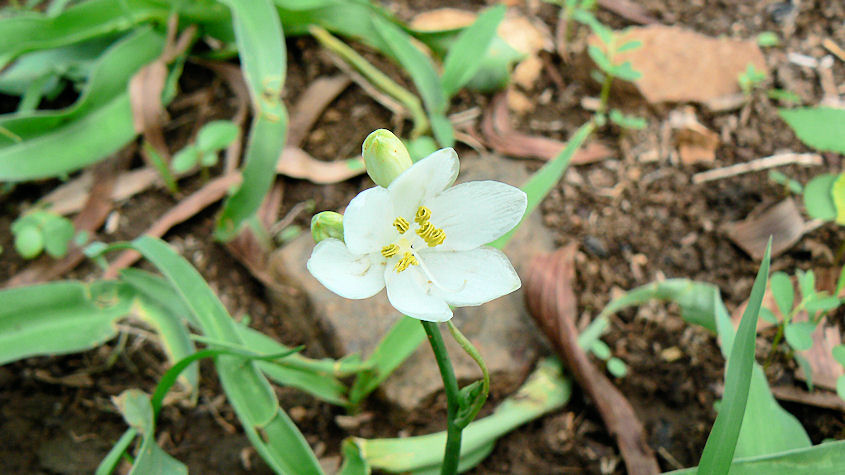
Abb.: Chlorophytum
tuberosum (Roxb) Baker, Maharashtra
[Bildquelle: dinesh_valke. --
http://www.flickr.com/photos/dinesh_valke/581813872/. -- Zugriff am
2010-11-14. --
Creative
Commons Lizenz (Namensnennung, keine kommerzielle Nutzung, keine
Bearbeitung)]
"Anthericum tuberosum. Roxb.
[...]
Sans. Chitra, also Vrishna.
A native of the moist vallies up amongst the Circar mountains. Flowering time the rainy season.
[...]
I have had many of the plants in my garden for several years ; they are very beautiful when in blossom, and have a long succession of flowers."
[Quelle: Roxburgh, William <1751-1815>: Flora indica, or, Descriptions of Indian plants / by the late William Roxburgh. -- Serampore : Printed for W. Thacker, 1832. -- Vol. 2, S. 149f.
Amaranthaceae (Fuchsschwanzgewächse)
Kraut (Unkraut)
| 7. apāmārgaḥ śaikhariko dhāmārgava-mayūrakau pratyakparṇī keśaparṇī kiṇihī kharamañjarī
अपामार्गः शैखरिको धामार्गव-मयूरकौ । [Bezeichnungen für Achyranthes aspera L. - Spreublume - Prickly Chaff Flower:]
|
Colebrooke (1807): "Apang. Achyranthes aspera."
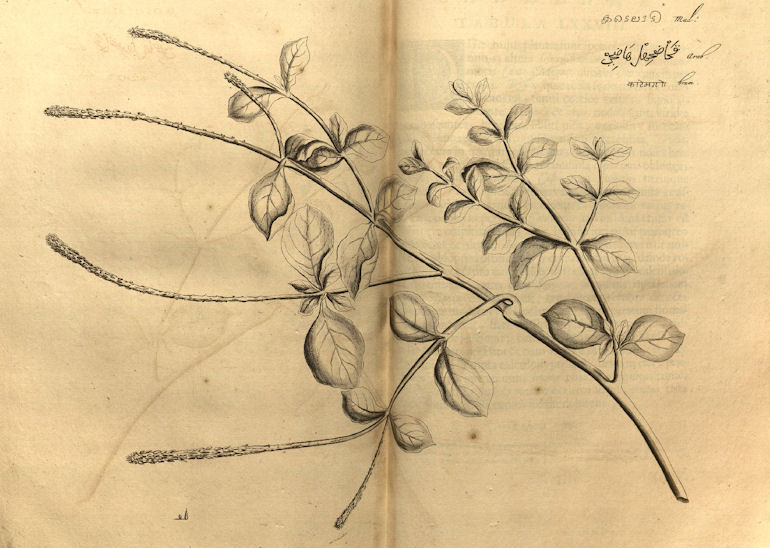
Abb.: अपामार्गः । Achyranthes aspera L. -
Spreublume - Prickly Chaff Flower
[Bildquelle: Hortus malabaricus X. Fig. 78, 1690]
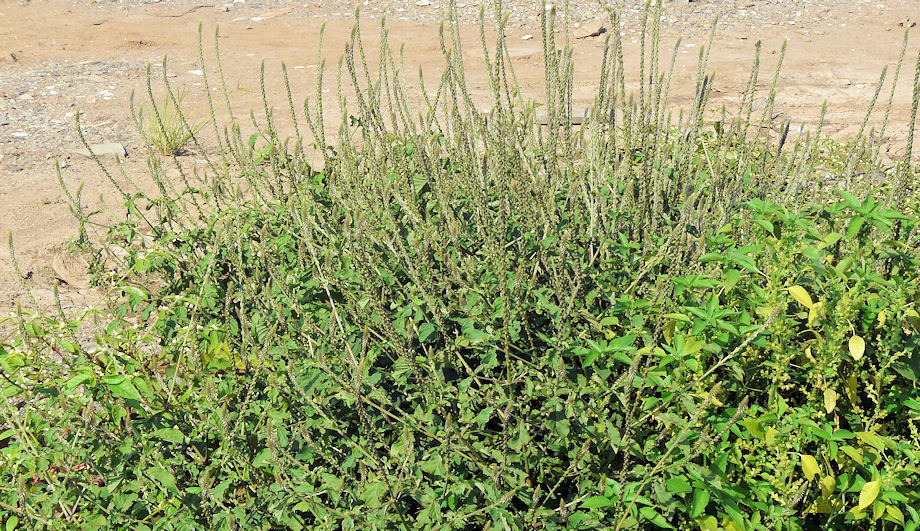
Abb.: प्रत्यक्पर्णी ।
Achyranthes aspera L. - Spreublume - Prickly Chaff Flower
[Bildquelle: dinesh_valke. --
http://www.flickr.com/photos/dinesh_valke/2898027087/. -- Zugriff am
2010-10-18. --
Creative
Commons Lizenz (Namensnennung, keine kommerzielle Nutzung, share alike)]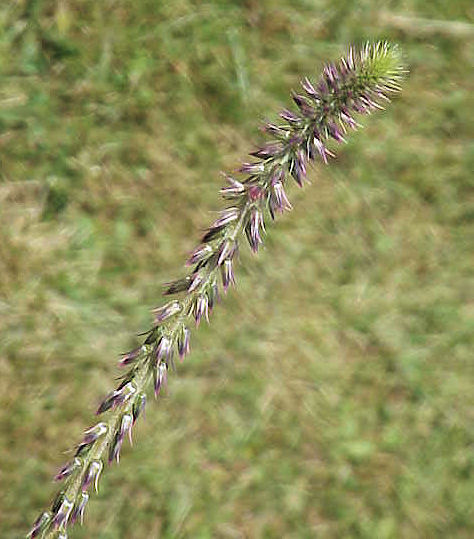
Abb.: खरमञ्जरी ।
Achyranthes aspera L. - Spreublume - Prickly Chaff Flower
[Bildquelle: Kurt Stueber / Wikimedia. -- GNU FDLicense]
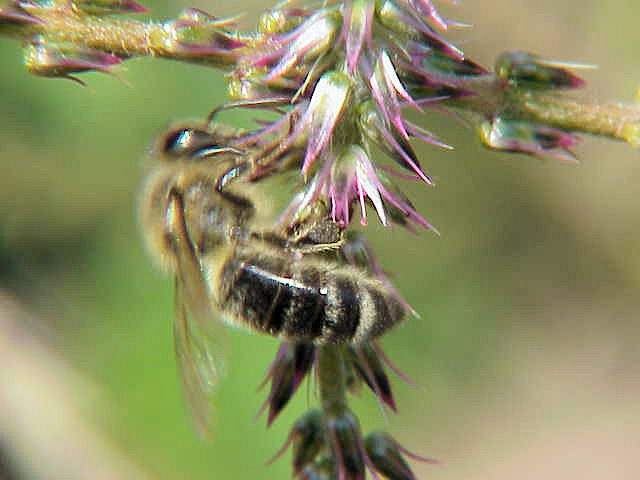
Abb.: मयूरकः ।
Achyranthes aspera L. - Spreublume - Prickly Chaff Flower
[Bildquelle: Kurt Stueber / Wikimedia. -- GNU FDLicense]
"Achyranthes aspera. Willd. spec. i. 1101.
[...]
Cadelari. Rheed. Mal. x. 155. t. 78.
Amaranthus spicatus zeylanicns, foliis obtusis. Burm, zeyl. 16. t. 50. f. 3.
A troublesome weed in every part of India, chiefly during the rainy and cold season, but in some measure all the year."
[Quelle: Roxburgh, William <1751-1815>: Flora indica, or, Descriptions of Indian plants / by the late William Roxburgh. -- Serampore : Printed for W. Thacker, 1832. -- Vol. 1, S. 672.]
"Achyranthes aspera (Linn.) N. O. Amarantaceae. [...]
Description.—Shrub about 6 feet; [...] capsules 5-seeded, reddish.
Fl. nearly all the year.
Roxb. Fl. Ind. i. 672.— Wight Icon. t. 1777.— Rheede, x. t. 78.
A. obtusifolia, Lam.
Bengal. Peninsula.
Medical Uses.—The seeds are given in hydrophobia, and in cases of snake-bites, as well as in ophthalmia and cutaneous diseases. The flowering-spikes rubbed with a little sugar are made into pills, and given internally to people bitten by mad dogs. The leaves taken fresh and rubbed to a pulp are considered a good remedy applied externally to the bites of scorpions. The ashes of the burnt plant mixed with conjee is a native remedy in dropsical cases. Astringent and diuretic properties are assigned to this plant, and Dr Cornish states having employed it largely in dropsy with favourable results. The whole plant, when incinerated, yields a considerable quantity of potash. These ashes, in conjunction with infusion of ginger, are likewise esteemed in dropsical affections. The flowering-spike has the repute in Oude and other parts of India of being a safeguard against scorpions, which it is believed to paralyse. It has also been used successfully as a local application in scorpion- stings and in snake-bites.—Pharm. of India. Long in Journ. of Agri. Hort. Soc. of India, 1858, x. 31. Madras Quart. Journ. of Med. Sc., 1862, iv. 10.—Wight. Ainslie. Hamilton."
[Quelle: Drury, Heber <1819 - 1872>: The useful plants of India : with notices of their chief value in commerce, medicine, and the arts. -- 2d ed. with additions and corrections. London : Allen, 1873. -- xvi, 512 p. ; 22 cm. -- s.v.]
"ACHYRANTHES ASPERA, Linn.
Fig.--Wight, Ic. t. 1780.
Prickly Chaff-flower
[...]
Hab. - Throughout India and tropical Asia.
This plant has given a name to the sacrificial offering called Apamarga Homa, which consisted of a handful of the flour of the seeds offered at daybreak, but which is not now, as far as we know, practiced in India. According to the Black Yajurveda, Indra, having killed Vritra and other demons was overcome by Namuchi and made peace with him, promising never to kill him with any solid or liquid, neither by day or by night. But Indra collected some foam, which is neither solid nor liquid, and killed Namuchi in the morning between night and daybreak. From the head of the demon sprung the herb Apamarga, with the assistance of which Indra was able to kill all demons. Hence this plant has the reputation of being a powerful talisman, and is now popularly supposed to act as a safeguard against scorpions and snakes by paralysing them. (Compare with Scribonius Comp. 163, 164, where similar superstitions are recorded.) It is waved round the body whilst taking the ceremonial bath early in the morning on the Naraka Chaturdasi or first day of the Divāli (new year) festival.
The Sanskrit synonyms for the plant are Shikhari, Kini, or Kinihi, Khara-manjari "having a rough flower-stalk," Adhvashalya "roadside rice," Shaikharika, Pratyak-pushpi "having reverted flowers," and Mayuraka "crested." It is described in the Nighantas as purgative, pungent, digestive; a remedy for phlegm, wind, inflammation of the internal organs, piles, itch, abdominal enlargements, and enlarged cervical glands. The ashes are used by the Hindus in preparing caustic alkaline preparations. The diuretic properties of the plant are well known to the natives of India, and European physicians agree as to its value in dropsical affections; one ounce of the plant may be boiled in ten ounces of water for 15 minutes, and from 1 to 2 ounces of the decoction be given 3 times a day. (Pharm. of India, p. 184.)
Different parts of the plant are ingredients in many native prescriptions in combination with more active remedies.In Western India the juice is applied to relieve toothache. The ashes with honey are given to relieve cough; the root in dosed of one tola is given at bedtime for night blindness, and rubbed into a paste with water it is used as an anjan (eye salve) in opacities of the cornea. The seeds are often used as a famine food in India, especially in Rajputana, where the plant is called Bharotha (grass)."
[Quelle: Pharmacographia indica : a history of the principal drugs of vegetable origin met with in British India / by William Dymock [1834-1892], C. J. H. Warden and David Hooper [1858-1947]. -- Bd. 3. -- London, 1893. -- S. 135f.]
Verbenaceae (Eisenkrautgewächse)
Strauch
| 8. phañjikā brāhmaṇī padmā bhārgī brāhmaṇayaṣṭikā aṅgāravallī bāleyaśākabarbaravardhakāḥ
फञ्जिका ब्राह्मणी पद्मा भार्गी ब्राह्मणयष्टिका । [Bezeichnungen für Clerodendrum serratum (L.) Spreng. - Losbaum:]
|
Colebrooke (1807): "Bamanaithi. Ovieda verticellata, R[oxb.] [= ???]"
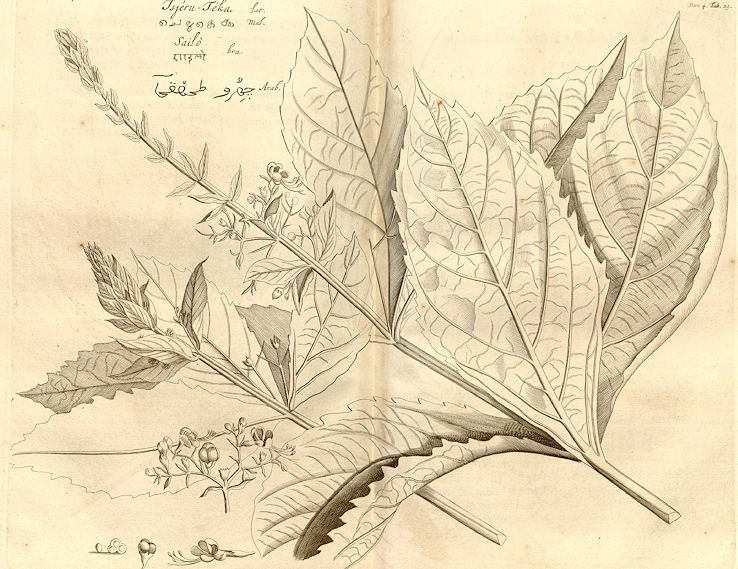
Abb.: वर्धकः । Clerodendrum serratum (L.)
Spreng. - Losbaum
[Bildquelle: Hortus malabaricus IV. Fig. 29, 1683]
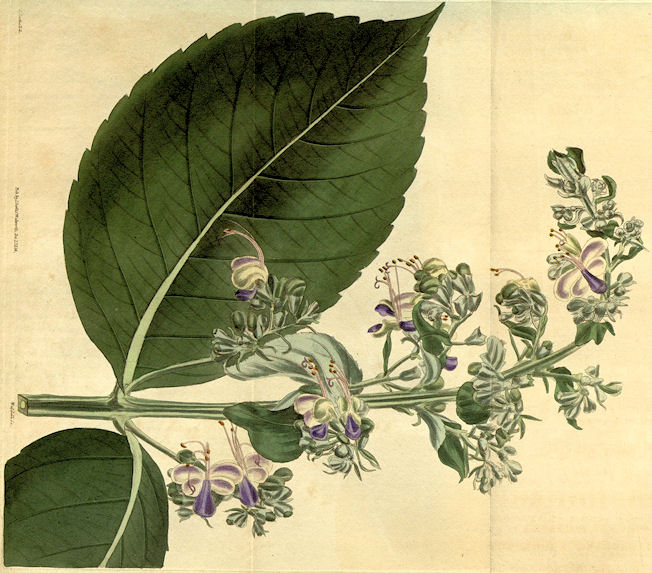
Abb.: बालेयशाखः । Clerodendrum serratum
(L.) Spreng. - Losbaum oder Clerodendrum macrophyllum
[Bildquelle: Curtis's Botanical Magazine, v. 52 (1825), Tab. 2536]
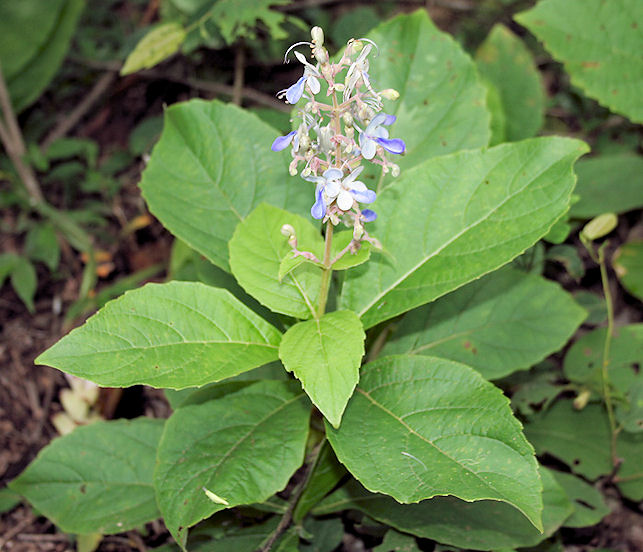
Abb.: ब्राह्मणयष्टिका । Clerodendrum serratum
(L.) Spreng. - Losbaum, Narsapur - నరసాపురం,
Andhra Pradesh
[Bildquelle: J. M. Garg / Wikimedia. -- GNU
FDLicense]
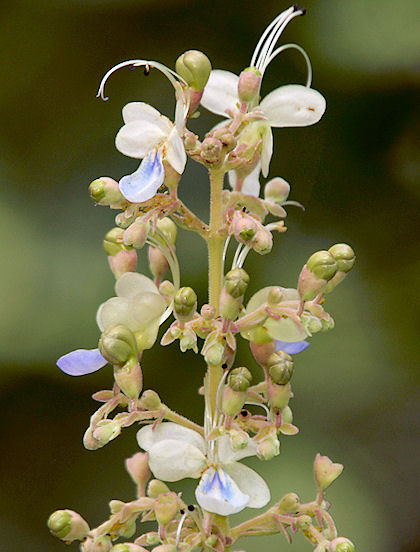
Abb.: बर्बरः । Clerodendrum serratum (L.)
Spreng. - Losbaum, Narsapur - నరసాపురం,
Andhra Pradesh
[Bildquelle: J. M. Garg / Wikimedia. -- GNU
FDLicense]
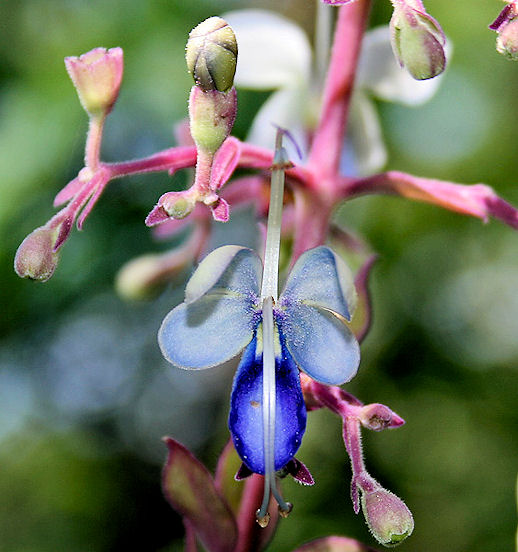
Abb.: भार्गी । Clerodendrum serratum (L.)
Spreng. - Losbaum, Narsapur - నరసాపురం,
Andhra Pradesh
[Bildquelle: J. M. Garg / Wikimedia. -- GNU
FDLicense]
"Volkameria serrata. Willd. iii. 384.
Shrubby.
[...]
Found in Mysore by Dr. Buchanan, who sent the seeds to the botanic garden at Calcutta, where the plants blossom during the rains."
[Quelle: Roxburgh, William <1751-1815>: Flora indica, or, Descriptions of Indian plants / by the late William Roxburgh. -- Serampore : Printed for W. Thacker, 1832. -- Vol. , S. 62f.]
"Clerodendron serratum (Blume). [...]
Description.—Shrub; [...] flowers pale blue, with lower lip indigo-coloured.
Fl. May—June.
Wight Icon. 1.1472.
Volkameria serrata, Linn.—Roxb. Fl. Ind. iii 62.—Rheede, iv. t. 29.
Courtallum. Bombay. Cultivated in Travancore.
Medical Uses.—In the Northern Circars the root is known by the name of Gunta-Bharinjie, and is largely exported for medical purposes. It is used by the natives in febrile and catarrhal affections.—(Pharm. of India.) The leaves boiled with oil and butter are made into an ointment useful as an application in cephalalgia and ophthalmia. The seeds bruised and boiled in butter-milk are slightly aperient, and are occasionally administered in cases of dropsy.— Ainslie. Rheede. J. Grah."
[Quelle: Drury, Heber <1819 - 1872>: The useful plants of India : with notices of their chief value in commerce, medicine, and the arts. -- 2d ed. with additions and corrections. London : Allen, 1873. -- xvi, 512 p. ; 22 cm. -- s.v.]
"Clerodendron Siphonanthus, Br., Lam. III., t.79, f. 1 ; Wight Ill., t, 173, is stated by M. C. Dutt to be in use in Bengal as Bharangi, but the samples of that drug which we obtained from Calcutta and Cawnpore proved to be the stems and roots of C. serratum, Spr., Wight Ic. t. 1472; Bot. Mag., t. 2536, From enquiries we have made there is no doubt that the latter plant is largely used in many parts of India as a substitute for Premna herbacea, the true Gantu Bharangi, but if we regard the root of C. serratum as the true Bharangi, and the root of P. herbacea as the Gantu (or knotted) Bharangi, there will be no confusion. C. serratum has a light-coloured root, very often contorted, and seldom more than an inch in diameter. A light brown epidermis and thin bark cover the tough woody portion, which shows well-marked medullary rays and concentric rings. The drug contains much starch, it is faintly bitter, and has no peculiar odour. The young tops and light blue flowers are used as a vegetable by the natives. The root of C. serratum did not yield anything of great activity when examined chemically, which proves that there is little to recommend it as a medical agent. The wood of the root is almost inert and tasteless ; the thin bark constitutes only one fifth of the weight of the dried root and contains a small quantity of the peculiar bitter principles, dissolved by ether, associated with an acrid resinous substance, and some fatty material. It is interesting to observe, however, that the reactions of the bitter principle, although occurring in such small quantity, were identical with that obtained in the leaves of the other two species, where it formed from 1/2 to 1 per cent of the total."
[Quelle: Pharmacographia indica : a history of the principal drugs of vegetable origin met with in British India / by William Dymock [1834-1892], C. J. H. Warden and David Hooper [1858-1947]. -- Bd. 3. -- London, 1893. -- S. 81f.]
Rubiaceae (Krappgewächse)
Kraut
| 9. mañjiṣṭā vikasā jiṅgī samaṅgā kālameṣikā maṇḍūkaparṇī maṇḍīrī bhaṇḍī yojanavally api
मञ्जिष्टा विकसा जिङ्गी समङ्गा कालमेषिका । [Bezeichnungen für Rubia cordifolia L. 1767 - Ostasiatischer Krapp - Indian Madder:]
|
Colebrooke (1807): "Madder. Rubia munjeet (manjith), R[oxb.] [= Rubia cordifolia L. 1767]"
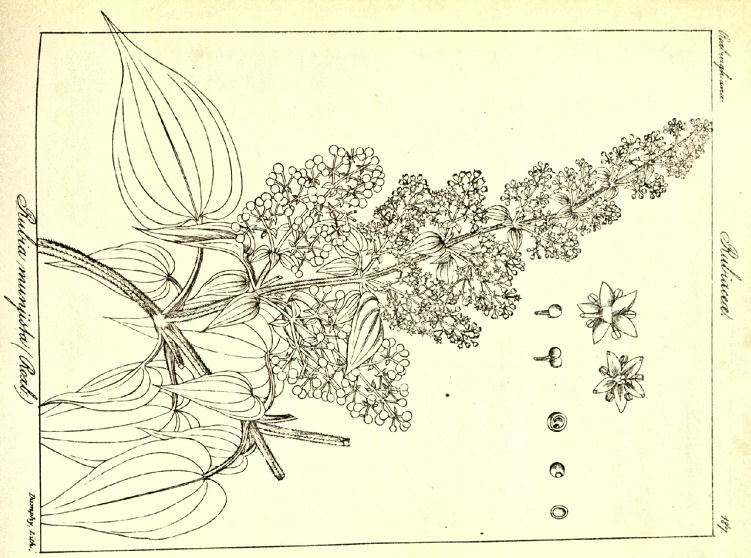
Abb.:
मञ्जिष्टा । Rubia cordifolia L.
1767 - Ostasiatischer Krapp - Indian Madder
[Bildquelle: Wight Icones I, Tab. 187, 1840]
"Rubia Munjista. Roxb.
[...]
Fleming in Asiat. Res. xi. 177.
Sans. Munjistha, Vikusa, Jingee, Sumunja, Kalumeshika, Mudooku urnee, Bhundeeree or Bhundiree, Bhundee, Yozunuvullee.
A native of Nepal, and other mountainous countries, north and north-east of Bengal. It grows in the Botanic garden at Calcutta, but requires uncommon care to keep it alive during the rainy season, and has never blossomed there.
[...]
Obs. It differs from R. cordifolia in being pentandrous.
The roots, stems, and larger branches are used to dye red with."
[Quelle: Roxburgh, William <1751-1815>: Flora indica, or, Descriptions of Indian plants / by the late William Roxburgh. -- Serampore : Printed for W. Thacker, 1832. -- Vol. 1, S. 374f.]
"Rubia cordifolia (Linn.) N. O. Cinchonaceae. Bengal Madder[...]
Description.—Herbaceous; [...] flowers usually 5-cleft, whitish ; berries red or black.
W. & A. Prod. i. 442.
R. Munjista, Roxb. Fl. Ind. i 374.— Wight Icon. t. 187.
Neilgherries. Dindigul.
Medical Uses.—An infusion made from the root is prescribed by native doctors as a grateful deobstruent drink in cases of scanty lochial discharge.—Ainslie.
Economic Uses.—There are varieties of this plant with glabrous, hairy, narrower or broader leaves, and disposed 8 in a whorl. The plant yields a red dye. The plant would appear to be chiefly produced in Kuchar, and the root is in great demand in the adjacent countries for dyeing coarse cloths and stuffs red: the Nepaulese barter it for rock-salt and borax. The fibres of the root are exported to Europe, but have not been used medicinally except as above related. Its use as a dye-stuff is increasing yearly, and it is well worth the attention of dyers. It is cultivated in Assam, Nepaul, Bombay, and other parts of this country. The price in the London market ranges from 20 to 30 shillings the cwt. — Simmonds, Ainslie."
[Quelle: Drury, Heber <1819 - 1872>: The useful plants of India : with notices of their chief value in commerce, medicine, and the arts. -- 2d ed. with additions and corrections. London : Allen, 1873. -- xvi, 512 p. ; 22 cm. -- s.v.]
"RUBIA TINCTORIUM, Linn.
Hab.—Cashmere, Sind, Afghanistan, Europe.
Madder
"RUBIA CORDIFOLIA, Linn.
Fig.—Wight Ic. t. 187; Done in Jacq. Voy. Bot. 84, t. 92.
Heart-leaved Madder
Hab.—Throughout the hilly districts of India.
[...]
History, Uses, &c.—Madder is used in Hindu medicine as a colouring agent; medicated oils are boiled with madder to give them colour. It is also a useful external astringent, and is applied to inflamed parts, ulcers, fractures, &c. Chakradatta recommends madder rubbed with honey as an application to the brown spots of pityriasis persicolor. The Sanskrit name is Manjishtha. Under the names of Fuvvaj and Rūnās, Arabic and Persian writers treat of madder, probably the produce of R. tinctorium. (The author of the Makhzan gives Rubia as the European, Dūzarlūs as the Greek, and Albisam as the Latin name of madder. Cf. Pliny 19, 17; 24, 56, who calls it Rubia and Erythrodanus.)
They do not, however, make any distinction between the species, but simply mention a wild and a cultivated variety. The Mahometans consider the drug to be deobstruent, and prescribe it in paralytic affections, jaundice, obstructions in the urinary passages and amenorrhoea. (Cf. Theophr. H. P. ix., 14.) They mention the fruit as useful in hepatic obstruction, and a paste made from the roots with honey, as a good application to freckles and other discolorations of the skin. The whole plant is reputed to be alexipharmic; it is also hung up in houses to avert the evil eye, and tied to the necks of animals with the same object. (Compare with Dioscorides iii., 151. περι ερυθροδανου, and Pliny 19, 17; 24, 56.)
Ainslie observes that the hakīms are in the habit of prescribing an infusion of madder root as a grateful and deobstruent drink in cases of scanty lochial discharge after lying-in. (Materia Indica II., p. 182.) In another notice of the article (Op. cit. I., p. 202), he remarks that it would appear to be chiefly produced in Cachar, and the root is in great demand in the adjacent countries, for dyeing their coarse cloths and stuffs red; the Napalese are in the habit of bartering it for rock salt and borax. Kinnier and Tavernier notice the abundance of madder in Persia and Makran. Dr. G. Playfair, in a note appended to his translation of the Talīf-i-Sharīfī (p. 150) states that if taken to the extent of about 3 drachms several times daily, it powerfully affects the nervous system, inducing temporary delirium, &c., with evident determination to the uterine system. R. cordifolia is common throughout the hilly districts of India, but the Bombay market draws its supplies chiefly from Khelat trough Sind, where R. tinctorium is cultivated."
[Quelle: Pharmacographia indica : a history of the principal drugs of vegetable origin met with in British India / by William Dymock [1834-1892], C. J. H. Warden and David Hooper [1858-1947]. -- Bd. 2. -- London, 1891. -- S. 231f.]
Fabaceae (Hülsenfrüchtler)
Strauch
| 10. yāso yavāso duḥsparśo dhanvayāsaḥ kunāśakaḥ rodanī kacchurānantā samudrāntā durālabhā
यासो यवासो दुःस्पर्शो धन्वयासः कुनाशकः । [Bezeichnungen für Alhagi maurorum Medik. 1878 - Kameldorn - Camel Thorn:]
|
Colebrooke (1807): "Jawasa. Perhaps Hedysarum alhagi ? [= Alhagi maurorum Medik. 1878] or rather, a new species."
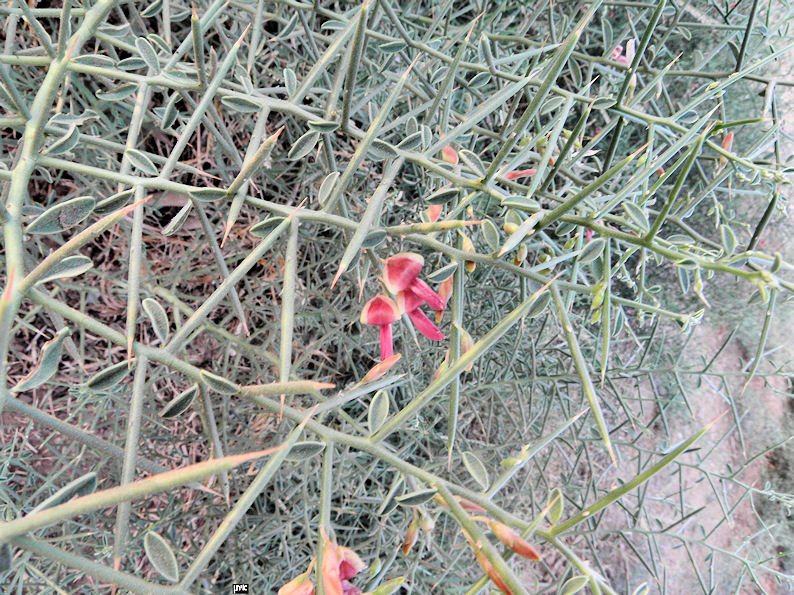
Abb.: Alhagi maurorum
Medik. 1878 - Kameldorn - Camel Thorn
[Bildquelle: Eitan f / Wikimedia. -- GNU FDLicense]
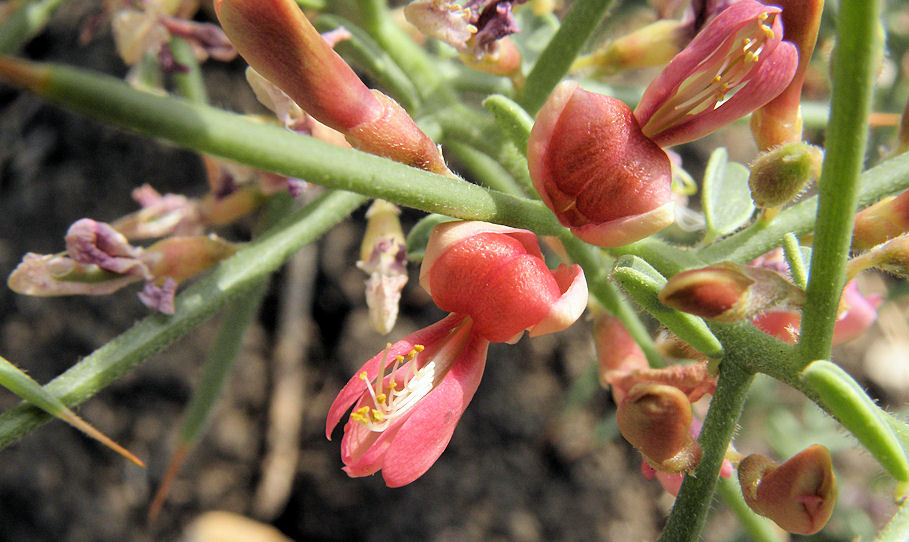
Abb.: Alhagi maurorum
Medik. 1878 - Kameldorn - Camel Thorn
[Bildquelle: Eitan f / Wikimedia. -- GNU FDLicense]
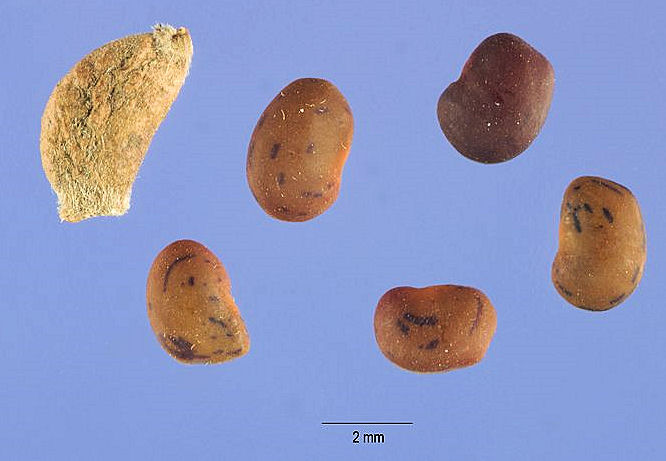
Abb.: Alhagi maurorum Medik. 1878 - Kameldorn - Camel
Thorn
[Bildquelle: USDA-NRCS / Wikipedia. -- Public
domain]
"Hedysarum alhagi. Willd. iii. 1171.
[...]
Sans. Yasa, or yavasa.
Pers. Shooturk has from its being the common food of the camel.
A native of Hindoostan, and generally found in a dry, rather barren, sandy soil. Its branches are used for the screens, called Tattees, employed during the hot dry winds, common in many parts of Southern Asia. In the neighbourhood of Candahar and Mirut and the bank of the Chilchuk, manna is said to be procured from it. This substance exudes from the plant after spring-rains and is gathered by merely shaking it off. See Fothergill, p. 257. In the Dooab, where it is common, it is for the most parts herbaceous and eaten down to the ground by cattle."
[Quelle: Roxburgh, William <1751-1815>: Flora indica, or, Descriptions of Indian plants / by the late William Roxburgh. -- Serampore : Printed for W. Thacker, 1832. -- Vol. 3, S. 344f.]
"ALHAGI MAURORUM, Den.
Fig.—Jaub. & Spach. Ill., t. 101.
Camel thorn
Hab.—N.-W. Provinces, Upper Gangetic plain and Concan.
[...]
ALHAGI CAMELORUM, Fisch.
Hab.—Khorasan.
[...]
History, Uses, &c.—These plants, in Sanskrit Duralabha (difficult to be laid hold of), in Persian Khar-i-buz or Khar-i-shutr, and in Arabic Haj, or Algoul, are natives of the deserts of Egypt, Syria, Mesopotamia, Persia, and India as far south as the Concan, and have been supposed by some to be the Occhi of Pliny, and the ακανθα εν Αρια or 'Khorasan Thorn' of Theophrastus. Mahometan writers give Farakiyun or Athariyun as the Yunani names, both evidently post-classical ; the first appears to be derived from φερω to bear and ακη, a a point or dart, and the second from αθηρ a spike or spine. A Persian manna probably obtained from these plants is mentioned by Polyaenus, A. D. 163, under the name of υον μελι.
In the hot season when all the smaller plants die they send forth leaves and flowers. The generic name is derived from the Arabic Al-haju, which is pronounced by the Egyptian Arabs El-hagu. The plants are described in Sanskrit works as laxative, diuretic and expectorant, the thorny flower stalks and branches being the parts used. An extract obtainable by evaporating a decoction of A. Maurorum is called Yavasakara; it has a bitter sweet taste, and is used as a demulcent in coughs. There is no mention in Sanskrit books of manna being obtained from the plant; indeed none is produced upon it in India. The Hindus use the fresh juice as a diuretic, generally in combination with laxatives and aromatics. (Cf. Sarngadhara and Chakradatta.) In. Mahometan works, under the names of Haj and Kbir-i-shutr, or camel thorn, a description of the plants will be found. They are considered to be aperient, actenuant and alexipharmic. A poultice, or fumigation with them is recommended to cure piles, the expressed juice is applied to opacities of the cornea, and is directed to be snuffed up the nose as a remedy for megrim. An oil is prepared with the leaves as an external application in rheumatism ; the flowers are applied to remove piles. Ainslie notices A. Maurorum as one of the sources of manna. In the Bengal Dispensatory and Pharmacopoeia of India it is also noticed o n this account. Under the name of Taranjabin Mahometan writers describe Alhagi manna. Mir Muhammad Husain says that it is collected in Khorasan, Mawaruunahr, Kurjistan, and Hamadan by cutting the plants and shaking them in a cloth to separate the manna. According to Aitchison the country round Rui-Khauf is famous for this manna. An inferior kind is made by dissolving what still adheres in water and evaporating it to a suitable consistence. He describes it as aperient and cholagogue, more digestible than Shirkisht, expectorant, a good purifier of the blood from corrupt and adust humours when given in diet drinks such as barley water, &c. ; diuretic, and with milk, fattening and aphrodisiac. In Bombay fine clean white samples of Taranjabin are sometimes obtainable during the season of import (November to January), but unless very carefully preserved it soon spoils in the moist climate of the Western Coast, running together, and becoming a brown sticky mass. The dried plant of A. Maurorum is always obtainable under the name of Jawasa, and the ripe fruit with manna adhering to it under the name of Taranjabin. In the Concan, the plant is smoked along with Black Datura, Tobacco, and Ajwan seeds as a remedy for asthma.
Description.--A. Maurorum is a low shrub, armed with copious subpatent hard pungent spines, 1/2 to 1 inch long."
[Quelle: Pharmacographia indica : a history of the principal drugs of vegetable origin met with in British India / by William Dymock [1834-1892], C. J. H. Warden and David Hooper [1858-1947]. -- Bd. 1. -- London, 1890. -- S. 417ff.]
Fabaceae (Hülsenfrüchtler)
Holziges Kraut
| 11. pṛṣṇparṇī pṛthakparṇī citraparṇy aṅghrivallikā kroṣṭuvinnā siṃhapucchī kalaśī dhāvanī guhā
पृश्निपर्णी पृथक्पर्णी चित्रपर्ण्य् अङ्घ्रिवल्लिका । [Bezeichnungen für Uraria picta (Jacq.) Desv. ex DC. 1825:]
|
Colebrooke (1807): "Chaculiya. Explanations differ; the names in both lines being synonymous according to some; but denoting two distinct plants according to others, The first seems to be Hedysarum lagopodioides [=Uraria lagopodioides (L.) DC. 1825]. [11. c./d.:] Ramvasac."
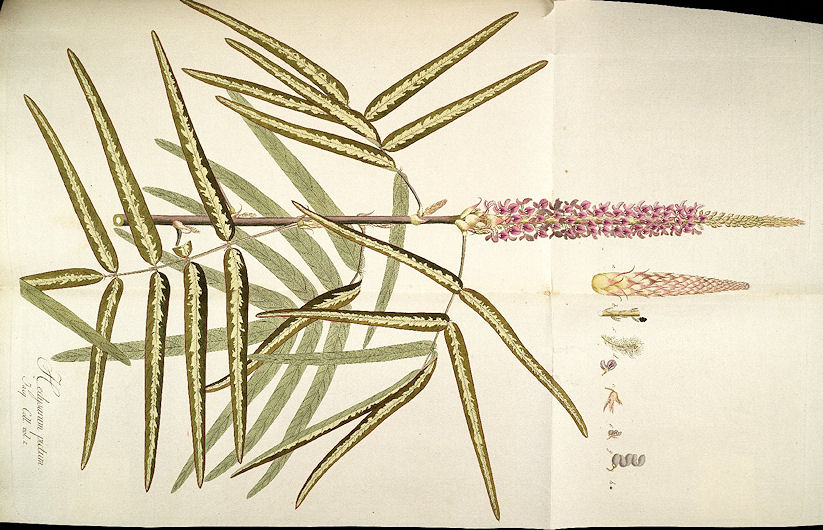
Abb.: Uraria picta (Jacq.) Desv. ex DC. 1825
[Bildquelle: Icones plantarum rariorum / editae Nicolao Josepho Jacquin. -- Vol.
3. -- 1793. -- Tab. 567.]
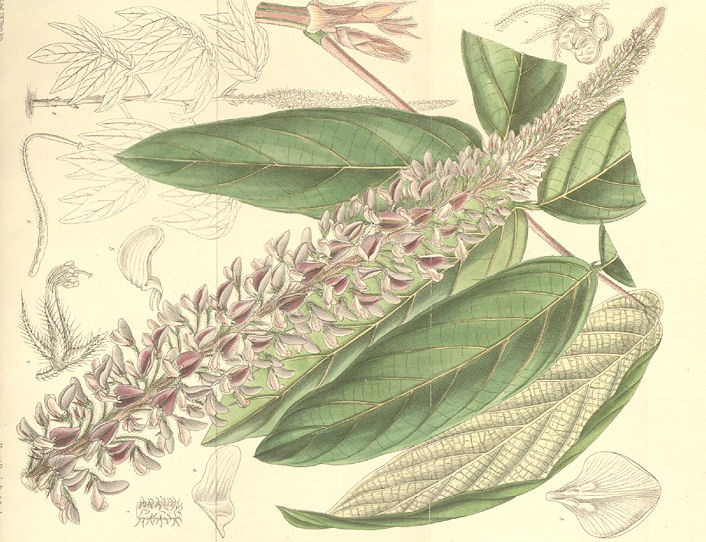
Abb.: Uraria picta
(Jacq.) Desv. ex DC. 1825
[Bildquelle: Curtis's Botanical Magazine, v. 120 (1894), Tab. 7377]
"Uraria picta, Desv., Jacq. Ic. t. 567. [...] is supposed by the Hindus to be an antidote to the poison of the Phursa snake (Echis carinata); it grows along the shady banks of water-courses, and blossoms towards the end of the rains. [...] The medicinal properties attributed to this plant also appear to be entirely fanciful."
[Quelle: Pharmacographia indica : a history of the principal drugs of vegetable origin met with in British India / by William Dymock [1834-1892], C. J. H. Warden and David Hooper [1858-1947]. -- Bd. 1. -- London, 1890. -- S. 427.]
"URARIA LAGOPOIDES.
Fig.—Burm. Fl. Ind. 68, t. 53, f. 2.
Hab.—Nipal and Bengal to Ava.
[...]
History, Uses, &c.--This plant is of interest as forming one of the ingredients of the Dasamula already mentioned (see Tribulus terrestris). On this account it is much used in Hindu medicine, but seldom alone. It is supposed to have alterative, tonic, and anti-catarrhal properties. The Sanskrit name, Prisniparni, signifies "spotted leaf." In Vedic times the plant was invoked as a goddess. According to Susruta it was given to women in the seventh month of their pregnancy with milk to prevent abortion. The Atharva-veda informs us that Prisniparni kills the monster Kanva, who wants to eat the germ. Another Sanskrit name is Atiguha, which signifies "great mystery."
[...]
The medicinal properties attributed to this plant appear to be entirely fanciful."
[Quelle: Pharmacographia indica : a history of the principal drugs of vegetable origin met with in British India / by William Dymock [1834-1892], C. J. H. Warden and David Hooper [1858-1947]. -- Bd. 1. -- London, 1890. -- S. 426f.]
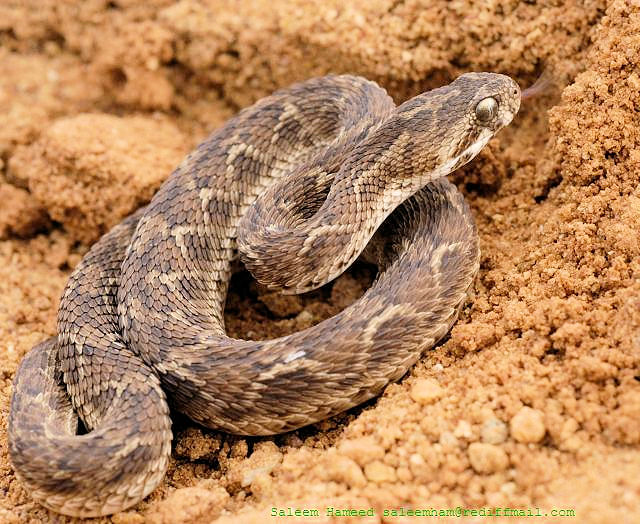
Abb.: Echis carinatus Schneider 1801 - Gemeine
Sandrasselotter, Bannerghatta National Park - ಬನ್ನೇರುಘಟ್ಟ ನ್ಯಾಷನಲ್ ಪಾರ್ಕ್,
Karnataka
[Bildquelle: Saleem Hameed / Wikipedia. --
Creative Commons
Lizenz (Namensnennung)]
Solanaceae (Nachtschattengewächse)
Stachliges Kraut
| 12. nidigdhikā spṛśī vyāghrī bṛhatī kaṇṭakārikā pracodanī kulī kṣudrā duḥsparśā rāṣṭrikety api
निदिग्धिका स्पृशी व्याघ्री बृहती कण्टकारिका । [Bezeichnungen für Solanum surattense Burm. 1768:]
|
Colebrooke (1807): "Sort of prickly nightshade. Solanum jacquini, Willd. [1797. = Solanum surattense Burm. 1768]"
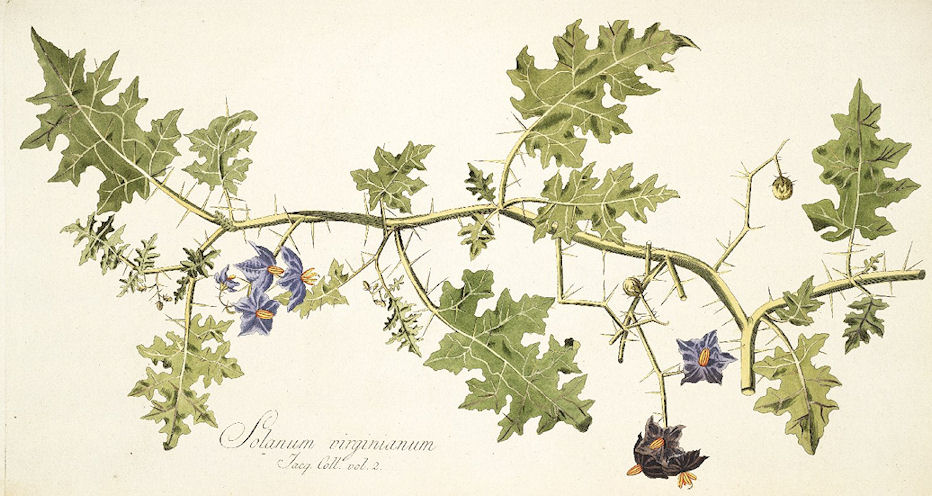
Abb.: Solanum surattense Burm. 1768
[Bildquelle: Icones plantarum rariorum / editae Nicolao Josepho Jacquin. -- Vol.
2. -- 1786 - 1793. -- Tab. 332]
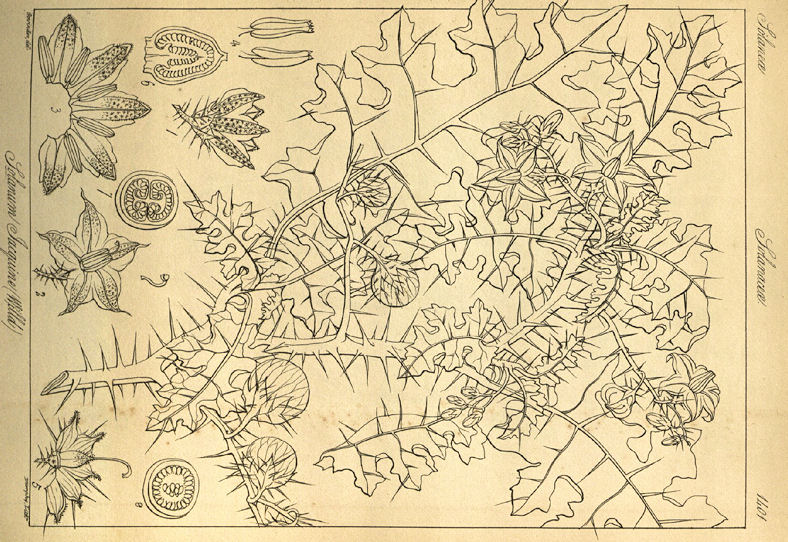
Abb.: Solanum surattense Burm. 1768
[Bildquelle: Wight Icones IV, Tab. 1401, 1850]
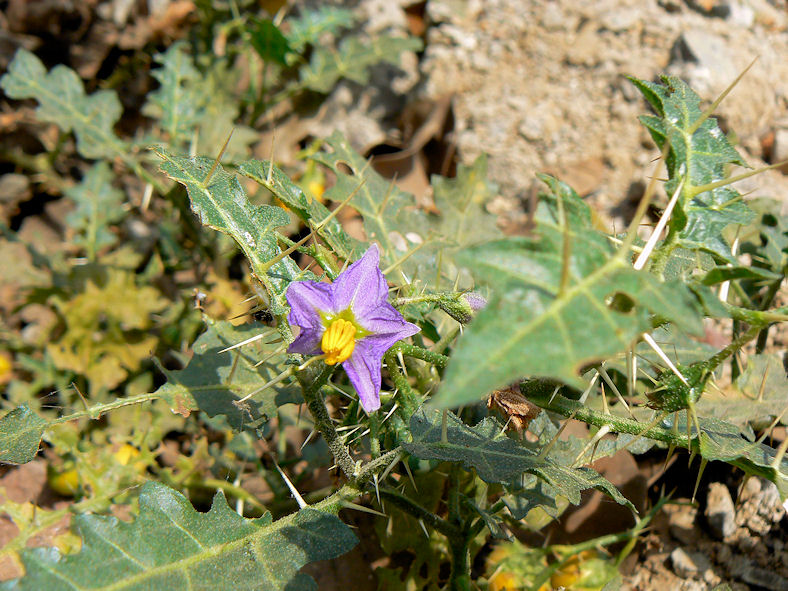
Abb.: Solanum surattense Burm. 1768, Maharashtra
[Bildquelle: dinesh_valke. --
http://www.flickr.com/photos/dinesh_valke/2095676520/. -- Zugriff am
2010-10-18. --
Creative
Commons Lizenz (Namensnennung, keine kommerzielle Nutzung, keine
Bearbeitung)]
"Solanum Jacquini. Willd. sp. i. 1041.
[...]
A native of Bengal, where it is generally found on road sides near villages. It is in blossom, and produces ripe fruit most part of the year."
[Quelle: Roxburgh, William <1751-1815>: Flora indica, or, Descriptions of Indian plants / by the late William Roxburgh. -- Serampore : Printed for W. Thacker, 1832. -- Vol. 1, S. 569.]
"Solanum Jacquini (Willd.) [...]
Description.—Procumbent, diffuse, prickly; [...] corolla bluish purple.
Fl. All the year.
Wight Icon. t. 1401.
Coromandel. Travancore.
The varieties are—
- Fruit larger, plant less armed. S. diffusum.—Roxb. Fl. Ind. i. 568.—S. xanthocarpum, Willd. Coromandel. Deccan.
- Fruit smaller; plant strongly armed. S. Jacquini, Willd.—Roxb. Fl. Ind. L 569.—Kanta-karee. Flowers bright blue. Bengal.
Medical Uses.—The fruit is bitter and sub-acid, considered an expectorant by the natives, and given by them in coughs and consumptive complaints; also in decoction in humoral asthma. In the West Indies the juice of the berry is used in cases of sore throat. The fruits are much esteemed by the natives, who eat them in their curries. For this purpose the plant is cultivated in the Circars.—(Ainslie. Roxb.) This plant has diuretic properties assigned to it, and is largely employed in catarrhal and febrile diseases. The stems, flowers, and fruit are bitter and carminative, and are prescribed in cases of burning feet, attended with a vesicular watery eruption.—(Calc. Med. Phys. Trans, ii. 406. Fumigations with the burning seeds are in great repute in the cure of toothache. It acts as a powerful sialagogue, and by these means probably relief is obtained.—Pharm. of India."
[Quelle: Drury, Heber <1819 - 1872>: The useful plants of India : with notices of their chief value in commerce, medicine, and the arts. -- 2d ed. with additions and corrections. London : Allen, 1873. -- xvi, 512 p. ; 22 cm. -- s.v.]
"SOLANUM XANTHOCARPUM, Schrad. et Wendl. Fig.—Schrad. et Wendl, Sert. Hanov. 8, t. 2 ; Jacq. Jc. Rar. iii, t. 832 ; Wight Ic. t. 1401.
Syn.—S. Jacquini
Hab.—Throughout India
[...]
History, Uses, &c.—This plant is of importance in Hindu medicine, as its root is one of the Dasamula or "ten roots" so often prescribed in decoction by their physicians. (See Tribulus terrestris.) In the Nighantas it is called Kantakara and Kantakini, "thorny", Nidigdhika, "clinging"; Vyaghri, "tigress"; and Dush-pradarshani, "which cannot be touched" ; and is described as aperient, pungent, bitter, digestive, diuretic, alterative, astringent and anthelmintic; useful in fever, cough, asthma, flatulence, costivenees and heart disease. It is also thought to promote conception in the female. In practice the drug is generally combined with other expectorants, demulcents and aromatics.
The following proscription from the Bhavaprakasha is quoted in "Dutt's Hindu Materia Medica" :—Kantakaryavileha or electuary of S. Jacquini. Take of Kautakari 12 1/2 seers, water 64 seers, boil till reduced to one-fourth and strain. Boil the strained decoction till reduced to the consistence of a fluid extract, and add to it the following substances in fine powder, namely, Tinospora cordifolia, Piper Chaba, Plumbago zeylanica, Cyperus rotundus, Rhus Kakrasingi, long pepper, black pepper, ginger, Alhagi maurorum, Clerodendron Siphonanthus, Vanda Rooxburghii, and Zedoary root, each 8 tolas, sugar 2 1/2 seers, sesamum oil and clarified butter each one seer. Boil together until reduced to the proper consistence. Lastly, add honey one seer, bamboo manna and long pepper in fine powder each half a seer.
This electuary is given to allay cough. The drug is also used in decoction with long pepper and honey, and with salt and asafoetida for asthma.
Mahometan writers, under the Arabic name of Hadak, or the Persian Badinjan-i-barri (wild egg plant), mention three kinds of Solanum, having somewhat similar properties. Their small kind, or Hejazi, appears to be the Solanum xanthocarpum, which they recommend in asthma, cough, dysuria, catarrhal fever, leprosy, costiveness and stone in the bladder. Under the name of Cundunghatrievayr, Ainslie (ii. 90) notices the use of this drug in Southern India as an expectorant. The stems, flowers, and fruit, according to Dr. Wilson (Calcutta Med. Phys. Trans., Vol. II., p. 406), are bitter and carminative, and are prescribed in those forms of Ignipeditis, which are attended with a vesicular, watery eruption. Fumigations with the vapour of the burning seeds of this plant are in high repute in the cure of toothache; they are smoked in a chilam like tobacco and the natives have the idea that the smoke kills the insects which they suppose cause the pain. The ancients used the seeds of Henbane in the same way. (Scrib. Comp. 54) They act as a powerful sialogogue, and thus afford relief. (Phar. of India, p. 181.) In the Concan 2 tolas of the juice of the fresh plant, with 2 tolas of Hemidesmus juice, are given in whey as a diuretic, and the root with chiretta and ginger is given in decoction as a febrifuge. Dr. Peters, of the Bombay Medical Service, informs us that in Bengal the plant is much used as a diuretic in dropsy."
[Quelle: Pharmacographia indica : a history of the principal drugs of vegetable origin met with in British India / by William Dymock [1834-1892], C. J. H. Warden and David Hooper [1858-1947]. -- Bd. 2. -- London, 1891. -- S. 557ff.]
Fabaceae (Hülsenfrüchtler)
Bis 2 m hoher Strauch
| 13. nīlī kālā klītakikā grāmīṇā madhuparṇikā rañjanī śrīphalī tutthā droṇī dolā ca nīlinī
नीली काला क्लीतकिका ग्रामीणा मधुपर्णिका । [Bezeichnungen für Indigofera tinctoria L. 1753 - Indigostrauch - True Indigo:]
|
Colebrooke (1807): "Indigo. Indigofera tinctoria."
1 तुत्था - tutthā f.: blaues Kupfersulfat (früher: Kupfervitriol): Chalkanthit: Cu[SO4] · 5 H2O
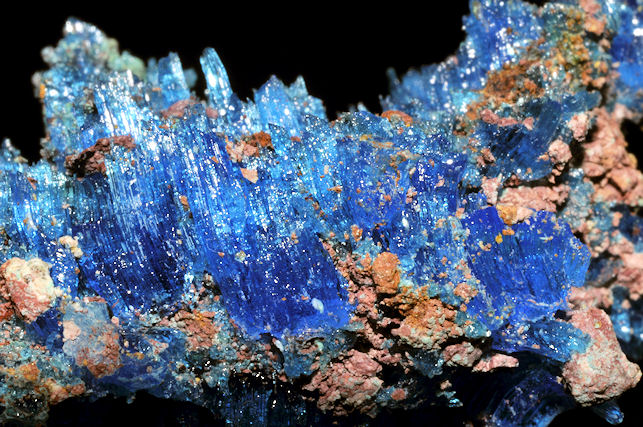
Abb.: तुत्था - tutthā f.:
blaues Kupfersulfat (früher: Kupfervitriol): Chalkanthit: Cu[SO4] · 5 H2O
[Bildquelle: Parent Géry / Wikimedia. -- Public domain]
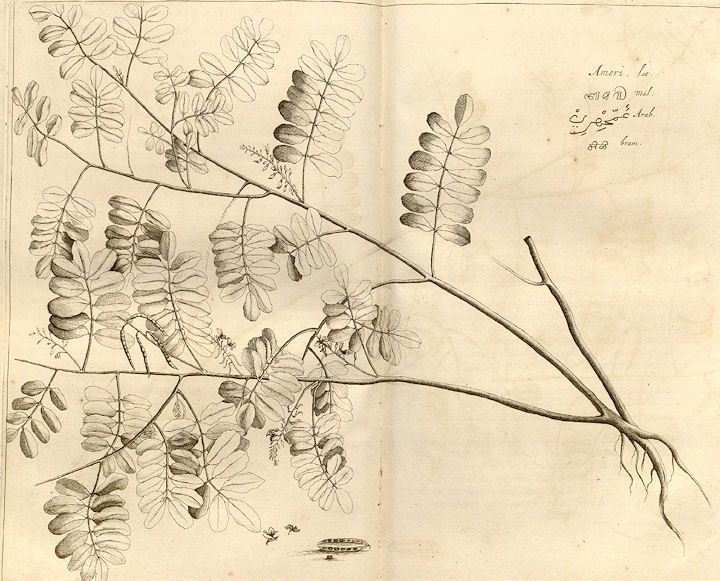
Abb.: नीली । Indigofera tinctoria L. 1753 -
Indigostrauch - True Indigo
[Bildquelle: Hortus malabaricus I. Fig. 54, 1678]
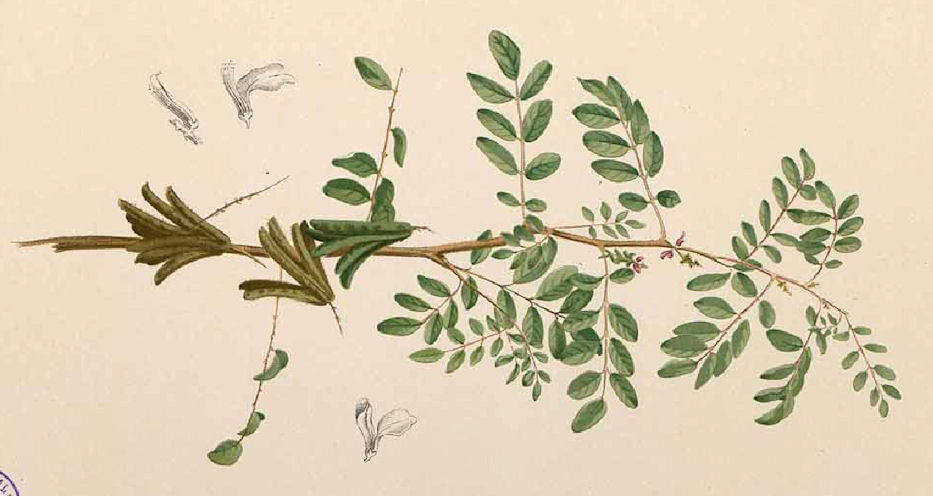
Abb.: श्रीफली । Indigofera tinctoria L. 1753 -
Indigostrauch - True Indigo
[Bildquelle. Flora de Filipinas 1880 / Wikimedia.
-- Public domain]
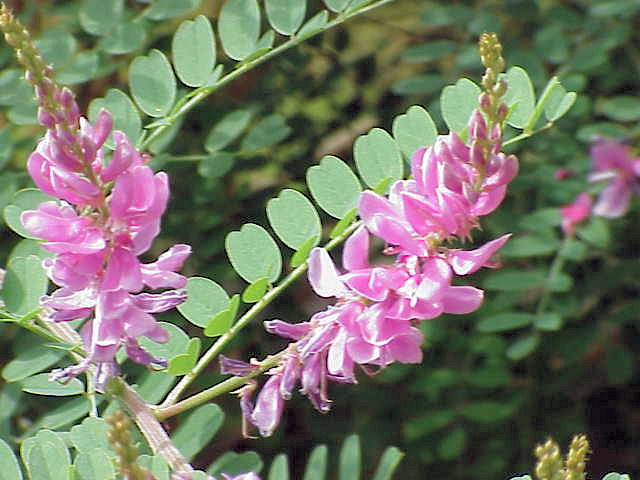
Abb.: मधुपर्णिका ।
Indigofera tinctoria L. 1753 - Indigostrauch - True Indigo
[Bildquelle: Kurt Stueber / Wikimedia. -- GNU FDLicense]
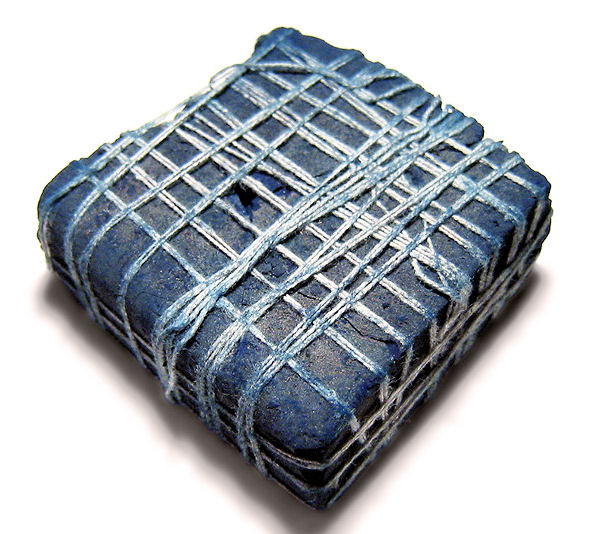
Abb.: Indigo
[Bildquelle: Evan Izer / Wikipedia. --
Creative Commons
Lizenz (Namensnennung, share alike)]
"Indigofera tinctoria. Willd. iii. 1237.
Shrubby.
[...]
Sans. Nili.
[...]
Ameri. Rheed. Mal. i. t. 54.
Indicum. Rumph. Amb. v. t. 80.
Native place uncertain, for though now common in a wild state over most parts of India, yet is in genera! not remote from places where it is or has been cultivated."
[Quelle: Roxburgh, William <1751-1815>: Flora indica, or, Descriptions of Indian plants / by the late William Roxburgh. -- Serampore : Printed for W. Thacker, 1832. -- Vol. 3, S.279f.]
"Indigofera tinctoria (Linn.) Common Indigo [...]
Description.—Shrub, 2-3 feet, erect, pubescent; [...]
Fl. July—Aug.
W. & A. Prod. L 202.— Wight Icon. t. 365.—Roxb. Fl. Ind. iii. 379.
I. Indica, Lam.—Rheede, i 54.
Quilon. Concans. Cultivated in Bengal and elsewhere.
Medical Uses.—With regard to the medical properties of this plant, Ainslie states that the root is reckoned among those medicines which have the power of counteracting poisons, and that the leaf has virtues of an alterative nature, and is given in hepatitis in the form of a powder mixed with honey. The root is also given in decoction in calculus; and the leaves rubbed up in water and applied to the abdomen are efficacious in promoting urine. Indigo itself is frequently applied to reduce swellings of the body. Lunan states that the negroes in Jamaica use a strong infusion of the root mixed with rum to destroy vermin in the hair. Powdered indigo has been employed in epilepsy and erysipelas, and sprinkled on foul ulcers is said to cleanse them. The juice of the young branches mixed with honey is recommended for aphths of the mouth in children. The wild indigo, I. paucifolia (Delile), is considered an antidote to poisons of all kinds. The root boiled in milk is used as a purgative, and a decoction of the stem is considered of great efficacy in mercurial salivation used as a gargle.—Ainslie. Beng. Disp. Lindley.
Economic Uses.—According to Loureiro, the indigo plant is spontaneous in China and Cochin China, and is cultivated all over those vast empires. The ancients were acquainted with the dye which we call indigo, under the name of Indicum. Pliny knew that it was a preparation of a vegetable substance, but he was not acquainted with the plant, nor with the process of making the dye. Even at the close of the sixteenth century it was not known in England what plant produced it. The celebrated traveller Marco Polo thus mentions indigo as one of the products of Quilon, where the plant grows wild. " Indigo, also, of excellent quality and in large quantities, is made here. They procure it from a herbaceous plant, which is taken up by the root, and put into tubs of water, where it is suffered to remain till it rots, when they press out the juice. This, upon being exposed to the sun and evaporated, leaves a kind of paste, which is cut into small pieces of the form in which we see it brought to us." To the present day indigo is manufactured at Quilon, though probably some hundred years ago it was made in considerable quantities. The account given above is a tolerably correct one of the rude process of its manufacture. It is one of the most profitable articles of culture in Hindostan, chiefly because labour and land are cheaper than anywhere else, and partly because the raising of the plant and its manufacture may be carried on even without the aid of a house. It is chiefly cultivated in Bengal in the delta of the Ganges, on those districts lying between the Hooghly and the main stream of the former river. The ground is ploughed in October and November after the cessation of the rains, the seeds are sown in March and beginning of April. In July the plants are cut when in blossom, that being the time when there is the greatest abundance of dyeing matter. A fresh moist soil is the best, and about 12 lb. of seeds are used for an acre of land. The plants are destroyed by the periodical inundations, and so last only for a single year. When the plant is cut it is first steeped in a vat till it has become macerated and parted with its colouring matter, then the liquor is let off into another vat, in which it undergoes a peculiar process of beating to cause the fecula to separate from the water; the fecula is then let off into a third vat, where it remains some time* after which it is strained through cloth bags and evaporated in shallow wooden boxes placed in the shade. Before it is perfectly dry it is cut into small pieces an inch square; it is then packed up for sale. Indigo, however, is one of the most precarious of Indian crops, being liable to be destroyed by insects, as well as inundation of the rivers. It is generally divided into two classes—viz., the Bengal and Oude indigo. Madras indigo is not much inferior to that grown in Bengal.
In the Jury Report of the Madras Exhibition it is said, in former years the usual mode of extracting indigo, as practised in Southern India, was from the dry leaf, a process which will be found minutely described in the pages of Heyne and Roxburgh. But this is now almost entirely superseded by the better system of the green leaf manufacture, which is followed in all the indigo-growing districts of this Presidency, save the province of South Arcot. In the latter, the dry leaf process is still persevered in, but probably it is so only because of the distance to which the leaf has generally to be carried before it reaches the factory, and the consequent partial drying that takes place on the journey. Notwithstanding the importance of the traffic, the general manufacture is so indifferently conducted, or rather on so imperfect a system, that the value of the article produced is seriously diminished, and its currency injured as an article of trade. It is not that the quality of Madras indigo is inferior to the ordinary run of that of Bengal, but indigo is commonly manufactured over the Madras Presidency in driblets, one vat-owner often not producing enough to fill even a chest; and the consequence is, that no one can make a purchase of a quantity of indigo in the Madras market upon a sample, as is commonly done in Bengal,— that every parcel, and often the same chest, is of mixed qualities, and that the value of the dye becomes thereby disproportionately depreciated at home.
The best indigo comes from the district of Kishnagur, Jessore, Moorshedabad, and Tirhoot. Roxburgh stated that he extracted most beautiful light indigo from the I. ccerzdea—(Roxb.), and in greater quantities than he ever procured from the common indigo plant.*—Roxb. Simmonds. Jury Rep. Mad. Exhib.
* For a detailed account of the process of planting and preparing Indigo, see Appendix E."
[Quelle: Drury, Heber <1819 - 1872>: The useful plants of India : with notices of their chief value in commerce, medicine, and the arts. -- 2d ed. with additions and corrections. London : Allen, 1873. -- xvi, 512 p. ; 22 cm. -- s.v.]
"APPENDIX E. The following memorandum regarding the cultivation and manufacture of Indigo, as carried on in the Benares Province, is by Claud Hamilton Brown, Esq. of Mirzapore :—
Soil.—The richest loam is supposed to give the best produce, though lighter soils frequently give finer-looking plants. Moist low soils are not suitable, but a great deal depends upon the subsoil, as the root grows vertically and to a great depth. High stony lands are to be avoided, excepting the sites of old villages, where, from the presence of lime and animal or vegetable matter, very fine crops are frequently produced, particularly in a season when the rains are heavy. Fields that have recently had heavy crops—Maize (Holcus), Indian corn (Zea), Urhur (Phaseolus), &c.—recently taken off them should be avoided.
Cultivation. — Immediately on the setting in of the periodical rains, say 15th to 30th June (in these parts), the lands should be well and carefully ploughed (three ploughings), the seed thrown in broadcast, at the rate of 8 lb. per beegah, and the land smoothed over with a henga (rudimentary harrow). The plant generally shows itself in three or five days. As soon as it has got two or three inches high, with six or eight leaves, all weeds must be carefully removed, and a second weeding is again requisite by the time the plant is six or seven inches high. While weeding, any place where the seed may have failed to germinate can be resown, by sprinkling the seed on the surface and dibbling it in where required. In about ninety days the plant begins to flower, and is then ready for cutting.
Manufacture. — The plant is cut at about 6 inches from the ground, and carried to the steeping-vats with as little delay as possible, strewn horizontally in the vats, and pressed down by means of beams fixed into side-posts, bamboos being placed under the beams. Water must be immediately run in, sufficient just to cover the plant. If water is not at once let in, the plant will heat, and become spoiled.
Steeping. — The time for steeping depends much on the temperature of the atmosphere, and can only be learnt by experience and careful watching of the vats; but it may be mentioned that in close sultry weather, wind east, therm. 96° in the shade, eleven or twelve hours are sufficient. In dry cool weather, wind west, fifteen or sixteen hours are sometimes requisite. If the plant is very ripe, the vat will be ready sooner than if the plant was young and unripe.
It is most important to steep exactly the proper time, the quality and quantity of your produce being dependent on this being done. As a guide, the following signs may be mentioned, as showing that the vat is ready to be let off:—
As soon as the water begins to fall in the vat.
When the bubbles that rise to the surface burst at once.
On splashing up the surface water, it has an orange tinge mingling with the green.
The smell of the water is also a great guide; when ripe it should have a sweetish pungent odour, quite different from the raw smell of the unripe green-coloured water. The first of the water, when let off into the beating-vat, has a rich orange colour; and from the depth of this you can judge whether the vat has been a proper time steeping.
Beating.—This is performed by men who enter the water (about seven to each vat) and agitate it either by the hands or by a wooden , paddle, at the first gently, but gradually increasing as the fecula begin to separate, which is known by the subsidence of the froth and the change of the colour of the water from green to dark blue. The time usually necessary for beating is from one and three-quarters to three hours, but no positive rule can be given for this.
The following are common modes of testing the state of the vat:—
1st, Take a little of the water in a white plate or saucer and let it stand. If the fecula subside readily, and the water remains of Madeira colour, the beating may be stopped.
2d, Dip a coarse cloth in the vat and wring out the water, observing its colour ; if green, the beating must be continued, but if Madeira or brownish colour, it is ready.
3d, When sufficiently beaten, the surface of the water will, as soon as the beating is suspended, become of a peculiar glassy appearance and the froth subside, with a sparkle and effervescence like champagne.
Three or four chatties of cold water or weak lime-water are then sprinkled over the surface to hasten the precipitation of the fecula, which does not completely take place in less than three or four hours. The water must then be drawn off from the surface through plug-holes made for the purpose in a stone slab inserted in the wall of the vat. The fecula remaining at the bottom are removed to the boiler.
Boiling.—Bring it to the boiling as soon as possible, and keep it there for five or six hours ; while boiling, it must be stirred to prevent the indigo burning, and skimmed with a perforated ladle. Its being sufficiently boiled is known by its assuming a glossy appearance. When sufficiently boiled it is run off to the straining-table, where it remains twelve or fifteen hours draining ; it is then taken to the press and gradually pressed. This takes twelve hours. It is then ready to be taken out, cut, stamped, and laid in the drying- house to dry. A good size of steeping-vat is 16 feet by 14 by 4 3/4; the beating-vat to be somewhat smaller and shallower. A beegah contains 27,224 feet. Two hundred maunds of plant do very well if they yield one maund (82 lb.) of any indigo. A vat of above size holds about 100 maunds of plants.
The plant sown, say, in June or July, is cut three months afterwards (Now-dah) and manufactured, and a second crop will be taken from it the following Khoontee (August). The second cutting gives the largest produce and best quality; the third (Teersalee), but it is seldom allowed to grow three years."
[Quelle: Drury, Heber <1819 - 1872>: The useful plants of India : with notices of their chief value in commerce, medicine, and the arts. -- 2d ed. with additions and corrections. London : Allen, 1873. -- xvi, 512 p. ; 22 cm. -- S. 473ff.]
"INDIGOFERA TINCTORIA, Linn.
Fig.—Rheede, Hort. Mal i. t 54; Wight Ic. t. 365.
Dyer's Indigo
Hab.—Western India, cultivated elsewhere.
[...]
History, Uses, &c.-—Indigo, in Sanskrit Nila, a word which signifies dark blue or black, appears to have been known in the East as a dye and medicine from a very remote period. Its importance as an article of trade is indicated by the Sanskrit synonym Banigbandhu, or "trader's friend." It was probably exported from Cambay, Broach and Thana at a very early period, certainly from the latter port B. C. 30. What Dioscorides calls Indicon, and Pliny and Vitruvius Indicum, was a blue pigment brought from India, and used both in painting and dyeing. When powdered it gave a black powder, and when suspended in water it produced an agreeable mixture of blue and purple. It belonged to the costly dye-stuffs, and was often adulterated by the addition of earth. On this account, that which was soft without any roughness, and which resembled an inspissated juice, was esteemed the best. Both Pliny and Dioscorides speak of two kinds, one of which adheres to reeds, in the form of slime or scum thrown up by the sea ; the other was scraped from the sides of dye-pans in the form of a purple-coloured scum. The ancients considered Indicum to be astringent, and used it for ulcers and inflammation, and to cleanse and heal wounds. (See Beckmann's Hist. of Invent. II., p. 258, where the subject is fully discussed.) The early Arabian physicians identified Indicum with Nil, which they regarded as a kind of Indian woad. Ibn Sina calls it El-wasmah-el-Hindiya, and it was also called Idlim, which was an Arabian name for woad, as appears from a passage in Abu Hanifeh, who says :—"An Arab of the desert, of the Sarah tribe, told me that the Idlimeh is a plant that rises upon a stem about a cubit in height, and has branches at the extremities of which are .what resemble the blossoms-of the coriander, and it (the plant) is dust-coloured. " In Ibn Sina's time woad appears to have been superseded by indigo, as he describes wasmeh as wark-un-nil, " or leaves of the Nil." In the 13th century, Marco Polo relates that he saw Indigo, which the dyers used, made in the kingdom of Coulan or Coilum, and he describes the process for preparing it. Persian writers on Indian drugs state that before the time when the English began to cultivate indigo, the best kind made in India was known as Baiana, from the name of a place in the Shahjehanabad district where it was made, and the record of the cargoes of the ships which arrived in Holland from the East Indies in 1631, show that the first had 13,539 lbs. of Sirches indigo ; the second 82,734 lbs. of Guzerat indigo ; the third 66,996 lbs. of the same ; the fourth 50,795 lbs. of Bajana indigo ; the fifth 32,251 lbs. of Sirches indigo; the sixth 59,698 lbs. of Bajana indigo ; and the seventh 27,532 lbs. of Sirches. The value of the indigo brought in these ships was at least 500,000 dollars.
The indigo plant was not known in Europe until the close of the 16th century.
Both Hindus and Mahometans consider the plant to have attenuant properties ; they prescribe it in whooping-cough, affections of the lungs and kidneys, palpitation of the heart, enlargement of the spleen or liver and dropsy. Indigo applied to the navel of children is said to act upon the bowels; it is applied to the hypogastrium to promote the action of the bladder.
A poultice or plaster of the leaves is recommended in various skin affections, and is used as a stimulating application to old ulcers, haemorrhoids, &c. Indigo is applied to the bites and stings of venomous insects and reptiles to relieve the pain, also to burns and scalds, and in Bengal is commonly applied to wounds, &c, of horses and cattle.
The plant has a great repute in some parts of India as a prophylactic against hydrophobia, so much so as to be known among the natives as "the clog-bite shrub." A wineglassful of the juice of the leaves is administered in the morning, with or without milk, for three days, to those who have been bitten by dogs supposed to be mad. People who have taken it inform us that beyond slight headache no disagreeable effect is produced, but that when a larger dose has been given it has proved purgative. In addition to the internal administration, the expressed leaves are each day applied to the bitten part as a poultice. Rheede, speaking of indigo, says—"viribus veneni obsistit." Ainslie notices the use of the root by the Hindus in hepatitis. It would appear that the wild indigo (I. paucifolia Delile.) is considered to have the same medicinal properties as I. tinctoria and its variety I. anil. For Roth's observations on the use of Indigo in epilepsy and other spasmodic see Brit. and For. Med. Rev., July 1836, p. 211. His account of its physiological effects is as follows :—"Shortly after taking it, the patient experiences a sense of constriction at the fauces, and the impression of a metallic taste on-the tongue. These are followed by nausea, and frequently by actual vomiting. The intensity of these symptoms varies in different cases. In some the vomiting is so violent as to preclude the further use of the remedy. The matter vomited presents no peculiarity except its blue colour. When the vomiting has subsided, diarrhoea usually occurs: the stools are more frequent, liquid, and of a blue or blackish colour. The vomiting and diarrhoea are frequently accompanied by cardialgia and colic Occasionally these symptoms increase, and the use of the remedy is in consequence obliged to be omitted." Dyspepsia and giddiness sometimes succeed. The urine has a brown, dark, violet colour; but Dr. Roth never found the respiratory matter tinged with it. After the use of indigo for a few weeks, twitchings of the muscles sometimes were observed, as after the use of strychnia.
The seeds of these plants powdered and steeped in arrack or rum, yield a tincture which is used to destroy lice.
Cultivation and production.—-Indigo is chiefly cultivated in Bengal in the delta of the Ganges, on those districts lying between the Hooghly and the main stream of the former river. The ground is ploughed in October and November after the cessation of the rains; the seeds are sown in March and the beginning of April. In July the plants are cut when in blossom, that being the time when there is the greatest abundance of dyeing matter. A fresh moist soil is the best, and about 12 lbs. of seeds are used for an acre of land. The plants are destroiyed by the periodical inundations, and so last only for a single year. The cut plants are first steeped in water, when they ferment with evolution of CO2, the yellow liquor is then run off into another vat, when it is-vigorously mixed with air by manual labour or machinery. By this means the leucindigo (white indigo) contained in the solution is oxidised and the indigo separates out as a blue scum winch finally settles to the bottom. The supernatant liquor is then run off, and the indigo is boiled with water for several hours, pressed and dried. (Watts' Dict. of Chem.) Before it is perfectly dry it is cut into cubes three inches square; it is then packed up for sale.
Indigo is one of the most precarious of Indian crops, being liable to be destroyed by insects as well as inundation of the rivers. It is generally divided into two classes, viz., Bengal and Oude indigo. Madras indigo is not much inferior to that grown in Bengal.
Description.—A shrub 2 to 3 feet, erect, pubescent;"
[Quelle: Pharmacographia indica : a history of the principal drugs of vegetable origin met with in British India / by William Dymock [1834-1892], C. J. H. Warden and David Hooper [1858-1947]. -- Bd. 1. -- London, 1890. -- S. 406ff.]
Fabaceae (Hülsenfrüchtler)
Bis 60 cm hohes Kraut
| 14. avalgujaḥ somarājī suvalliḥ somavallikā kālameṣī kṛṣṇaphalī bākucī pūtiphaly api
अवल्गुजः सोमराजी सुवल्लिः सोमवल्लिका । [Bezeichnungen für Psoralea corylifolia L. - Harzklee:]
|
Colebrooke (1807): "Somraj. Conyza (or Serratula) anthelmintica [L. 1763 = Baccharoides anthelmintica (L.) Moench 1794."
Psoralea corylifolia L. - Harzklee
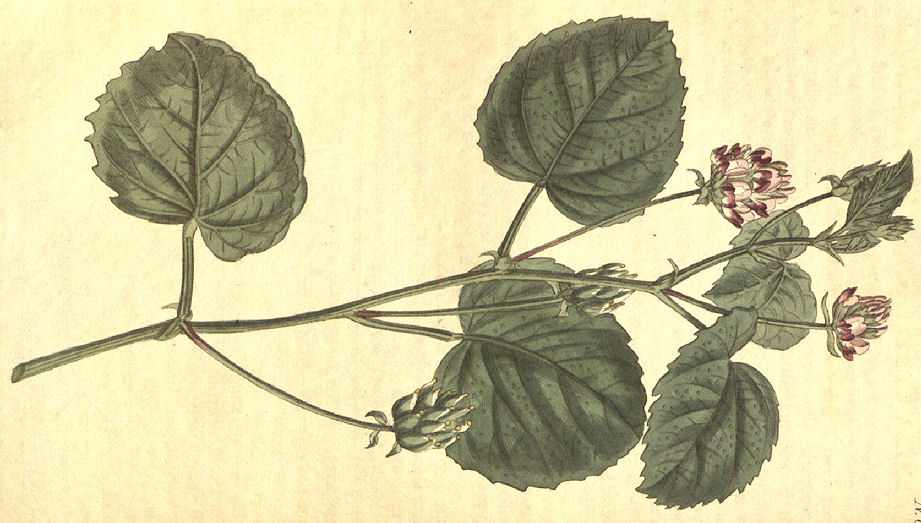
Abb.: सोमराजी ।
Psoralea corylifolia L. - Harzklee
[Bildquelle: Curtis's Botanical Magazine, v. 18 (1803), Tab. 665]
"Psoralea corylifolia. Willd. iii. 1351. Burm. Ind. 172. t. 49.
Annual,
[...]
A native of various parts of India, and commonly found in the vicinity of villages during the rainy and cold seasons."
[Quelle: Roxburgh, William <1751-1815>: Flora indica, or, Descriptions of Indian plants / by the late William Roxburgh. -- Serampore : Printed for W. Thacker, 1832. -- Vol. 2, S. 587f.]
"Psoralea corylifolia (Linn.) N. O. Lequminosae [...]
Description. — Herbaceous, erect, 2 feet; [...] flowers violaceous or pale flesh-coloured.
Fl. July— Aug.
W. & A. Prod,. i. 198.—Roxb. Fl. Ind. iii. 387.—Burm. Ind. t. 49.
Peninsula. Bengal.
Uses, &c.—The seeds, which are somewhat ovate and of a dark- brown colour, have an aromatic and slightly bitter taste. The natives prescribe them as stomachic and deobstruent, and also use them in cases of leprosy and other cutaneous affections.—Ainslie."
[Quelle: Drury, Heber <1819 - 1872>: The useful plants of India : with notices of their chief value in commerce, medicine, and the arts. -- 2d ed. with additions and corrections. London : Allen, 1873. -- xvi, 512 p. ; 22 cm. -- s.v.]
"PSORALIA CORYLIFOLIA, Linn,
Fig.—Burm. Fl. Ind. t. 49; Bot. Mag. t. 665.
Hab.—Himalaya to Ceylon.
[...]
History, Uses, &c.—Sanskrit writers mention a plant called Lata-kasturika or Lata-kasturi as growing in the Deccan ; it has been supposed by most writers on Indian Materia Medica to be the Musk Mallow; but as that plant does not grow in the Deccan, and P. corylifolia is very common there and is known in Bengal as Lata-kasturi, we think it probable that it is the plant alluded to, especially as the seeds are used in making a perfumed oil which is applied to the skin. Native works on Materia Mediea describe the seeds as hot and dry, or according to some, cold and dry, lenitive, fragrant, stimulant and aphrodisiac. They are recommended in leprosy, and other chronic skin diseases which depend upon a vitiated state of the Wood, and are given internally and applied externally as a plaster; whence the synonym Kushtanasmi; they are also said to be useful in febrile bilious affections and as an anthelmintic and diuretic. The Hindus class them with the रसायन (rasayan) or alchemic drugs. Ainslie mentions their use in Southern India as a stomachic and deobstruent, and says that they are prescribed in lepra and other inveterate cutaneous affections. Some years ago the seeds were extensively tried in Bombay by Dr. Bhao Daji and others, as a remedy in leprosy, with some success.
Dr. Kanny Loll Dey strongly recommends the oleo-resinous extract of the seeds diluted with simple unguents as an application in leucoderma. He says—" After application for some days the white patches appear to become red or vascular; sometimes a slightly painful sensation is felt. Occasionally some small vesicles or pimples appear, and if these be allowed to remain undisturbed, they dry up, leaving a dark spot of pigmentary matter, which forms as it were a nucleus. From this point, as well as from the margin of the patch, pigmentary matters gradually develops which ultimately coalesce with each other, and thus the whole patch disappears. It is also remarkable that the appearance of fresh patches is arrested by its application." (Phar. Journ., Sept. 24th, 1881.) In the hands of other observers, however only negative results have been obtained by this mode of treatment.
Several species of Psoralia have been used medicinally in America, and have been found to act as gentle, stimulating, and tonic nervines. (For an interesting account of the American Psoralias, see Maisch., Amer. Journ. Pharm., July 1889.)"
[Quelle: Pharmacographia indica : a history of the principal drugs of vegetable origin met with in British India / by William Dymock [1834-1892], C. J. H. Warden and David Hooper [1858-1947]. -- Bd. 1. -- London, 1890. -- S. 412f.]
Baccharoides anthelmintica (L.) Moench 1794
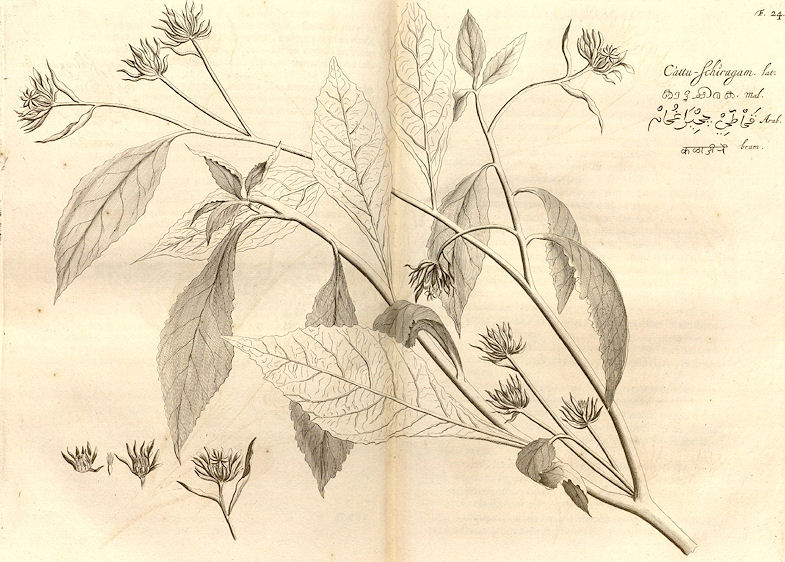
Abb.: Baccharoides
anthelmintica (L.) Moench 1794
[Bildquelle: Hortus malabaricus II. Fig.
24, 1679]
"Serratula anthelmintica. Roxb.
Annual.
[..]
Vernonia anthelmintica. Willd. iii. 1634.
Cottu-shiragom. Rheed. Mal. ii. t. 24.
Sans, Somraj.
Conyza anthelmintica. Linn.
Is a pretty large, erect, annual species, common on high dry uncultivated ground, and rubbish. It flowers during the cold season."
[Quelle: Roxburgh, William <1751-1815>: Flora indica, or, Descriptions of Indian plants / by the late William Roxburgh. -- Serampore : Printed for W. Thacker, 1832. -- Vol. 3, S. 405f.]
"Vernonia anthelmintica (Willd,.) N. O. Asteraceae.
Purple Flea-bane [...]
Description.—Annual; [...] flowers purplish.
Fl. Nov.— Dec.
Serratula anthelmintica, Roxb. Fl. Ind. iii 405.
Conyza anthelmintica, Linn.—Rheede, ii. t. 24.
Peninsula. Bengal.
Medical Uses.—The seeds are very bitter, and are considered powerfully anthelmintic and diuretic, and are also an ingredient of a compound powder prescribed in snake-bites. An infusion of them is given on the Malabar coast for coughs and in cases of flatulency. Reduced to powder and mixed with lime-juice, they are used to expel pediculi from the hair.—(Ainslie.) The seeds are about an eighth of an inch in length, of a dark-brown colour, covered with whitish scattered hairs, cylindrical, tapering towards the base, marked with about ten paler longitudinal ridges, and crowned with a circle of brown scales, and are nauseous and bitter to the taste. Dr Gibson regards them as a valuable tonic and stomachic, in doses of 20 to 25 grains.—(Pharm. of India,) It is stated by Ainslie that the V. cinerea (Less.) is used in decoctions by the natives to promote perspiration in fevers."
[Quelle: Drury, Heber <1819 - 1872>: The useful plants of India : with notices of their chief value in commerce, medicine, and the arts. -- 2d ed. with additions and corrections. London : Allen, 1873. -- xvi, 512 p. ; 22 cm. -- s.v.]
"VERNONIA ANTHELMINTICA, Willd.
Fig.—Burm. Thes. 210, t. 95 ; Rheede Hort. MaL. ii., t. 24.
Hab.—Throughout India.
[...]
History, Uses, &C—The Sanskrit names of this common Indian plant are Vakuchi, Somaraji or Somarajin and Avalguja. It has long been highly esteemed as one of the principal remedies for leucoderma and psoriasis, and is also used as an anthelmintic in combination with other remedies. For administration in skin diseases Chakradatta directs the drug to be powdered along with an equal quantity of black sesamum, and a drachm of the powder to be taken in the morning with tepid, water, after perspiration has been induced by exercise or exposure to the sun. The diet should consist of milk and rice. In leucoderma, a decoction of emblic myrobalans and catechu is given in addition to the powdered Vakuchi. Externally the drug is applied in skin diseases in a variety of forms, such, as paste, oil, &c. Vakuchi is described in the Nighantas as sweet, pungent, digestive, bitter, alterative, astringent, cold, cardiacal, dry, antiphlegmatic ; a remedy for cough, fever, and intestinal worms. The author of the Makhzan-el-Adwiya describes Kali-jiri, and states that it is given internally to remove phlegm and worms from the intestines, and that a poultice or plaster of it is used to disperse cold tumors. He concludes by saying that the drug is not often prescribed internally, as it is thought to have injurious effects, but that it is much used as a cattle medicine. Indian Mahometan druggists sell this drug as a substitute for Atrilal (Anthriscus Cerefolium). Ainslie says: "The small dark-coloured and extremely bitter seeds of this annual plant are considered as powerfully anthelmintic, and are also an ingredient of a compound powder prescribed in snake-bites." Rheede states that an infusion of them is given on the Malabar Coast for coughs and against flatulency. The dose of the seed in powder, when administered in worm cases, is one pagoda weight twice daily. (Materia Ind. ii., p. 54). According to the Pharmacopeia of India, the ordinary dose of the bruised seed as an anthelmintic, administered in electuary with honey, is about 1 1/2 drachm, given in two equal doses at the interval of a few hours, and followed by an aperient; the worms are generally expelled in a lifeless state. Br M. Ross speaks favourably of an infusion of the powdered seeds (in doses of from 10 to 30 grains) as a good and certain anthelmintic for ascarides. In Travaucore the bruised seeds, ground up in a paste with lime juice, are largely employed as a means of destroying pediculi. Dr. Gibson, as the result of personal experience, regards them as a valuable tonic and stomachic in doses of 20 to 25 grains ; diuretic properties are also assigned to them. (Pharmacopoeia of India, p. 126.) In the Concan the following formula is in vogue as an antiperiodic—Vernonia seeds, Chiretta, Picrorhiza root, Dikamali, Rocksalt and Ginger, p. aeq. Powder, and give 6 massas in cold water in which a red hot tile has been quenched, every morning."
[Quelle: Pharmacographia indica : a history of the principal drugs of vegetable origin met with in British India / by William Dymock [1834-1892], C. J. H. Warden and David Hooper [1858-1947]. -- Bd. 2. -- London, 1891. -- S. 241f.]
Piperaceae (Pfeffergewächse)
Kletterranke
| 15. kṛṣṇopakulyā vaidehī māgadhī capalā kaṇā uṣaṇā pippalī śauṇḍī kolātha karipippalī कृष्णोपकुल्या वैदेही मागधी चपला कणा । [Bezeichnungen für Piper longum L. 1753 - Langer Pfeffer - Indian Long Pepper:]
|
Colebrooke (1807): "Long pepper."
1 वैदेही - vaidehī f.: Videherin ; मागधी - māgadhī f.: Magadherin
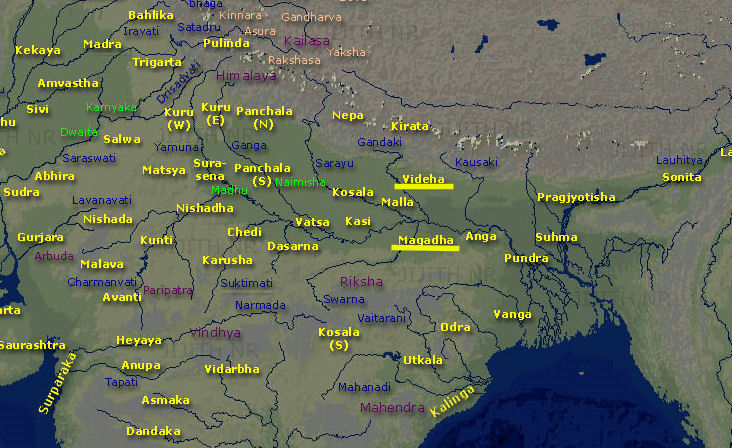
Abb.: Lage von Videha und Magadha
[Bildquelle: JIJITH NR / Wikimedia. -- GNU FDLicense]
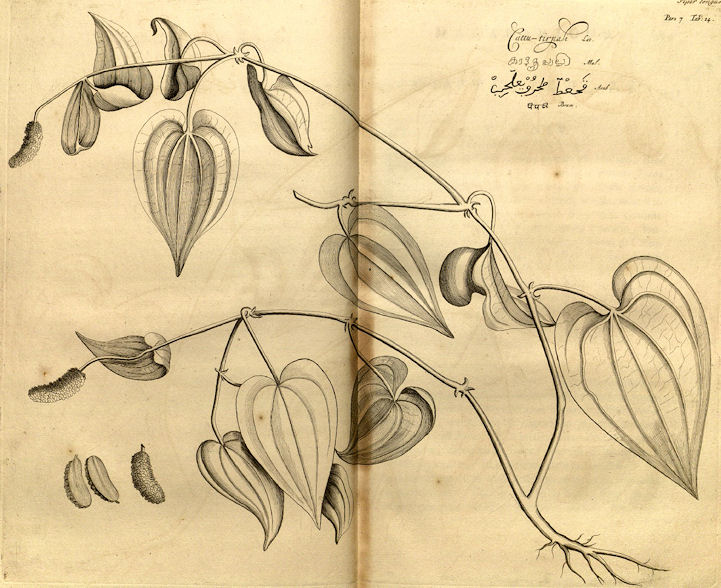
Abb.: पिप्पली । Piper longum L. 1753 - Langer
Pfeffer - Indian Long Pepper
[Bildquelle: Hortus malabaricus VII. Fig. 14, 1686]
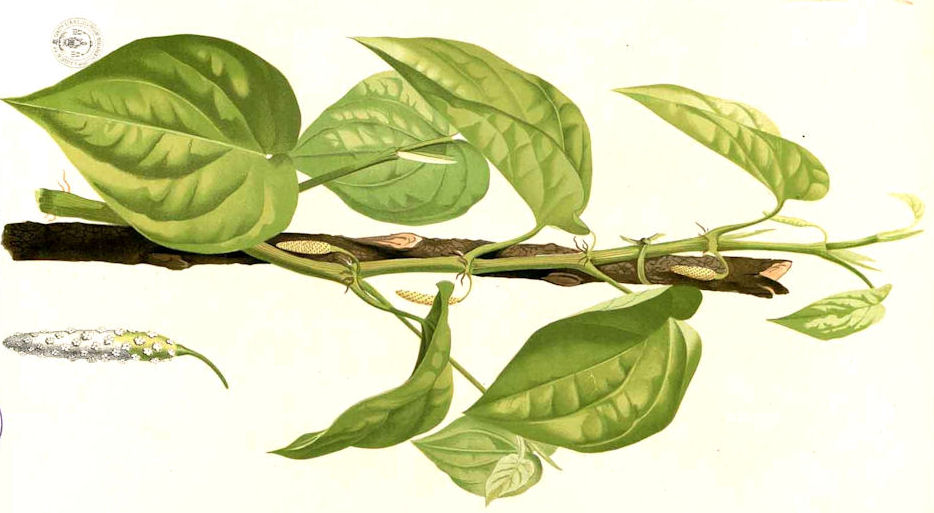
Abb.: उपकुल्या ।
Piper longum L. 1753 - Langer Pfeffer - Indian Long Pepper
[Bildquelle. Flora de Filipinas 1880 / Wikimedia.
-- Public domain]
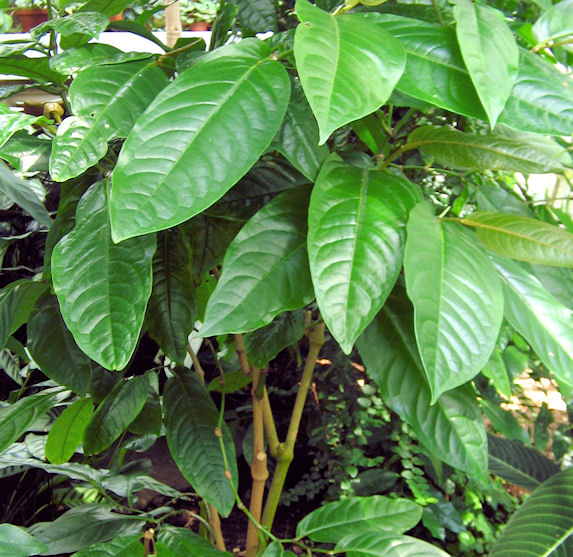
Abb.: चपला ।
Piper longum L. 1753 - Langer Pfeffer - Indian Long Pepper
[Bildquelle: Kembangraps / Wikimedia. -- GNU FDLicense]
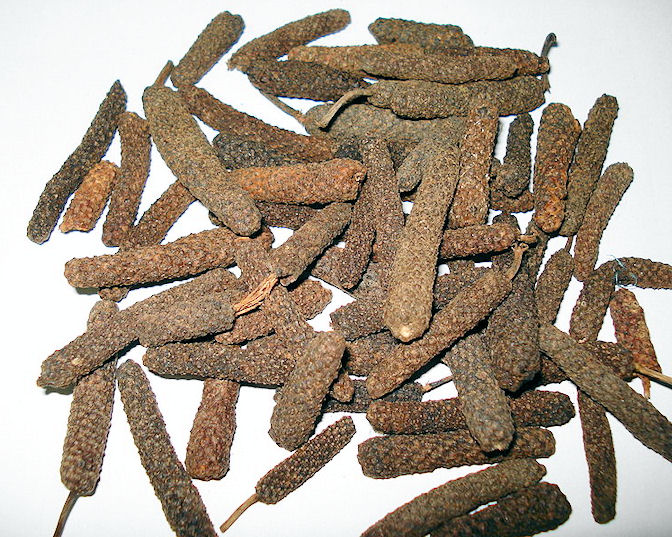
Abb.: कणा । Piper
longum L. 1753 - Langer Pfeffer - Indian Long Pepper
[Bildquelle: Miansari66 / Wikimedia. -- Public domain]
"Piper longum. Willd. i. 161.
[...]
Cutta-tirpali. Rheed. Mal. 7. p. 27. t. 14.
Sans. Krishna, Oopukoolya, Videhee, Mugudhee, Chupula, Kuna, Ooshuna, Pippulee, Shoundee, Kola.
English. Long pepper.
[...]
The plant I have found wild amongst bushes, on the banks of water courses, up towards the Circar mountains. It flowers and bears fruit during the wet and cold seasons.
[...]
Obs. It is in Bengal only, so far as I have been able to learn, that this plant is cultivated for its pepper. When the pepper (ament) is full grown, it is gathered and daily exposed to the sun, till perfectly dry ; after which it is packed up in bags for sale.
The roots, and thickest parts of the creeping stems, when cut into small pieces and dried, form a considerable article of commerce all over India, under the name of Pippula moola; for which purpose it is particularly cultivated in many of the vallies amongst the Circar mountains. This sort is more esteemed, and bears a higher price than that of Bengal, where by far the largest proportion is cultivated. It is, as well as the pepper, chiefly employed medicinally, and the consumption of both these drugs is very great.
Cultivation in Bengal. The long pepper is not propagated by seed, but by suckers, and requires to be cultivated upon a rich, high, and dry soil. The suckers are transplanted soon after the setting in of the periodical rains, and the pepper (which is preserved merely by drying it in the sun), is gathered in the month of January, after which the stalk, and branches of the plant wither, and the roots only remain alive. A bigha of land (the third of an English acre) will yield in the first year about a maund (eighty-four pounds) of the pepper, in the second year four maunds ; and in the third, six ; after which, as the plant becomes annually less and less productive, the roots are grubbed up, dried, and sold ; and fresh roots, or young shoots are set in their stead, the earth requiring merely a slight covering of manure. The plants are never to be watered, and at the commencement of the hot season the roots are to be carefully covered with straw to preserve them against the heat of the sun. The plants should be set about five feet asunder. Large quantities of this pepper and also of the roots are exported to Bombay, and Surat ; where both are in great demand, the first for culinary, the latter for medicinal purposes. The ryots in this part of the country, usually sow radishes, or barley, or plant brinjals (Solanum melongena), in the intermediate space between the plants."
[Quelle: Roxburgh, William <1751-1815>: Flora indica, or, Descriptions of Indian plants / by the late William Roxburgh. -- Serampore : Printed for W. Thacker, 1832. -- Vol. 1, S. 154ff.]
"Chavica Boxburghii (Miq.) Long Pepper [...]
Description.—Stem somewhat shrubby, the sterile ones decumbent, the floriferous ones ascending, [...]
Wight Icon. t. 1928.
Piper longum, Linn.—Roxb. Fl. Ind. i. 154—Rheede, vii. t. 14.
Banks of watercourses. Circar mountains. South Concans. Bengal
Medical Uses.—This plant is extensively cultivated; the female catkins dried form the long Pepper of the shops. " I have never," says Wight, "met with it except in gardens, and then only as single plants." It is readily propagated by cuttings. The stems are annual, but the roots live several years; and when cultivated, usually yield three or four crops, after which they seem to become exhausted, and require to be renewed by fresh planting. The berries of this species of Pepper are lodged in a pulpy matter like those of P. nigrum. They are at first green, becoming red when ripe. Being hotter when unripe, they are then gathered and dried in the sun, when they change to a dark-grey colour. The spikes are imported entire. The taste of the berries is pungent, though rather faint. On the Coromandel coast the natives prescribe the berries in an infusion mixed with honey for catarrhal affections. The roots are given by natives in palsy, tetanus, and apoplexy. These and the thickest parts of the stem are cut into small pieces and dried, and much used for medical purposes. The berries have nearly the same chemical composition and properties as the black Pepper, and are said to contain pipeline.— (Wight. Ainslie. Lindley.) The root is in great repute among the natives. It is called Peepla-mool in the Taleef-Shereef, where it is described as bitter, stomachic, and producing digestion. In Travancore an infusion of the root is prescribed after parturition, with the view of causing expulsion of the placenta.—Pharm. of India."
[Quelle: Drury, Heber <1819 - 1872>: The useful plants of India : with notices of their chief value in commerce, medicine, and the arts. -- 2d ed. with additions and corrections. London : Allen, 1873. -- xvi, 512 p. ; 22 cm. -- s.v.]
"PIPER LONGUM, Linn. Fig.—Bentl. and Trim., t. 244; Miq. III. Pip., t. 30; Hayne, Arnz. Gewächs. xiv., t. 20; Wight Ic., t. 1928; Rheede, Hort. Mal. vii. t. 14.
Hab.—Hotter provinces of India.
[...]
History, Uses, &c.—As we have already stated, we think it highly probable that long pepper was the kind of pepper first known to the ancient inhabitants of Western Asia and Europe. (See P. nigrum.) In Sanskrit works on medicine, P. longum is described under the name of Pippali, and bears the synonyms of Chapala, Pala, Magadhi "growing in South Bihar," Kana, Shaundi, &c. It is considered to be digestive, sweet, cold, bitter, emollient and light; useful in rheumatism, asthma, cough, abdominal enlargements, fever, leprosy, gonorrhoea, piles and spleen. Old long pepper is to be preferred to fresh. A mixture of long pepper, long pepper root, black pepper and ginger in equal parts, is prescribed by several writers as a useful combination for catarrh and hoarseness. As an alterative tonic, long pepper is recommended for use in a peculiar manner. An infusion of three long peppers is to be taken with honey on the first day, then for ten successive days the dose is to be increased by three peppers every day, so that on the tenth day the patient will take thirty at one dose. Then the dose is to be gradually reduced by three daily, and finally the medicine is to be omitted. Thus administered, it is said to act as a valuable alterative tonic in. paraplegia, chronic cough, enlargements. of the spleen and other abdominal viscera. Long pepper and black pepper enter into the composition of several irritating snuffs; boiled with ginger, mustard oil, buttermilk and curds, it forms a liniment used in sciatica and paralysis. In the Concan the roasted aments are beaten up with honey and given in rheumatism ; they are also given powdered with black pepper and rock salt (two parts of long pepper, three of black, and one of salt) in half tola doses for colic. Mahometan writers,, under the name of Darfilfil, describe long pepper as a resolvent of cold humours; they say it removes obstructions of the liver and spleen, and promotes digestion by its tonic properties; moreover, it is aphrodisiacal, diuretic, and emmenagogue. Both it and the root (Filfil-muiyeh) are much prescribed in palsy, gout, lumbago, and other diseases of a similar nature. A collyrium of long pepper is recommended for night blindness; made into a liniment it is applied to the bites of venomous reptiles. We learn from Roxburgh (Flora Indica, I., p. 155) "that it is in Bengal only that Piper longum is cultivated for its pepper; When the ament is full-grown, it is gathered and daily exposed to the sun till perfectly dry; after which it is packed in bags for sale. The roots and thickest part of the creeping stems, when cut into small pieces and dried, form a considerable article of commerce all over India, under the name of Pippali-mula, for which purpose it is particularly cultivated in many of the valleys amongst the Sircar mountains; This sort is. more esteemed, and bears a higher price than that of Bengal, where by far the largest portion is cultivated. It, as well as the pepper, is chiefly employed medicinally, and the consumption of both these drugs is very great." Piper longum was formerly cultivated at Poway, near Bombay; it appears to grow well in gardens in Bombay, but requires plenty of manure.
Pippali-mula, with the synonyms Kana-mula, Katu-granthi, Ushana-granthika, Chataka and Chataka-shira, is described in the Nighantas as having the same properties as long pepper. P. Chaba, which produces the long pepper of European commerce, is the Chavi, Chavika and Chavya of Sanskrit writers. It is considered to have the same properties as P. longum. The aments are sold in the bazars as Mothi pippali, and the stem as Chab, Chai or Chavak.
The oblong black pepper of Theophrastus (H. P., ix., 22) was probably long pepper. Dioscorides, in his article upon the three peppers, mentions a pepper root, and says it resembles Costus, has a hot taste, and causes salivation when chewed. This drug was probably Galangal, which is known as Pan-ki-jar or root of Piper Betle, because its odour somewhat resembles that of Betle leaves."
[Quelle: Pharmacographia indica : a history of the principal drugs of vegetable origin met with in British India / by William Dymock [1834-1892], C. J. H. Warden and David Hooper [1858-1947]. -- Bd. 3. -- London, 1893. -- S. 176ff.]
Piperaceae (Pfeffergewächse)
Kletterranke
| 15. c./d. uṣaṇā
pippalī śauṇḍī kolātha
karipippalī 16. kapivallī kolavallī śreyasī vaśiraḥ pumān cavyaṃ tu cavikā kākaciñcī-guñje tu kṛṣṇalā
उषणा पिप्पली शौण्डी कोलाथ
करिपिप्पली ॥१५
ख॥ [Bezeichnungen für Piper retrofractum Vahl 1804 (= Piper chaba Hunter) - Javapfeffer - Java Longpepper:]
[Bezeichnungen für die Pflanze von Piper retrofractum Vahl 1804 (= Piper chaba Hunter) - Javapfeffer - Java Longpepper:]
|
Colebrooke (1807): "Another sort." [16c.:] "The plant. Or synonymous with the preceeding ; or else the name of a different plant ; Tetranthera apetala, R[oxb. 1798 = Litsea glutinosa (Lour.) C. B. Rob. 1911]."
Piper retrofractum Vahl 1804 - Javapfeffer - Java Longpepper
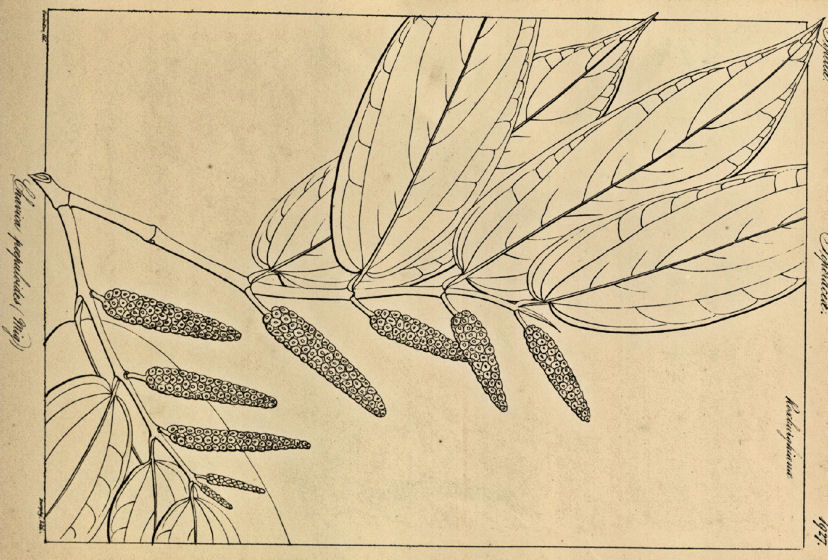
Abb.: Piper
retrofractum Vahl 1804 (= Piper chaba Hunter) - Javapfeffer -
Java Longpepper
[Bildquelle: Wight Icones VI, Tab. 1927, 1853]
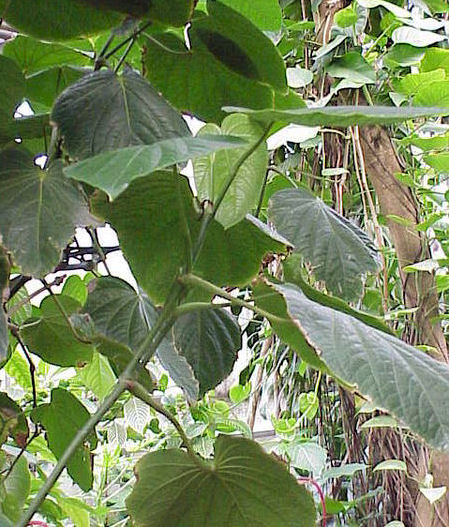
Abb.: Piper retrofractum Vahl 1804 - Javapfeffer - Java
Longpepper
[Bildquelle: Kurt Stueber / Wikimedia.
-- GNU FDLicense]
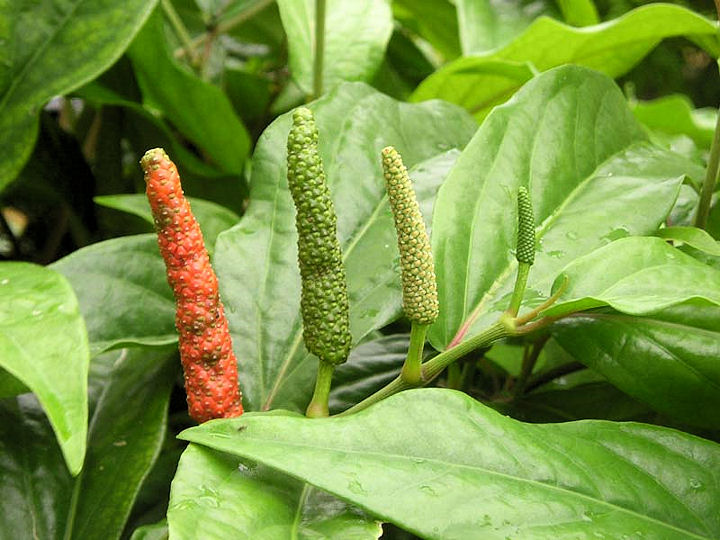
Abb.: Piper retrofractum Vahl 1804 -
Javapfeffer - Java Longpepper, Vietnam
[Bildquelle:
Robert Lafond. --
http://www.flickr.com/photos/bobvietnam/3497937854/. -- Zugriff am
2010-10-18. --
Creative Commons Lizenz (Namensnennung, share alike)]
Litsea glutinosa (Lour.) C. B. Rob. 1911
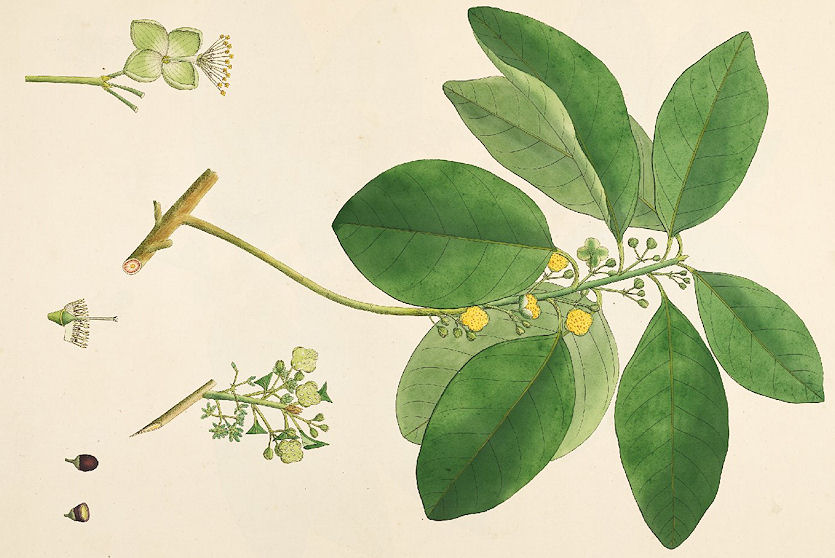
Abb.: Litsea glutinosa
(Lour.) C. B. Rob. 1911 (Roxb.:
Tetranthera apetala)
[Bildquelle: Roxburgh. -- Vol II. -- 1795. -- Pl. 147. -- Image courtesy
Missouri Botanical Garden.
http://www.botanicus.org. --
Creative Commons Lizenz
(Namensnennung, keine kommerzielle Nutzung)]
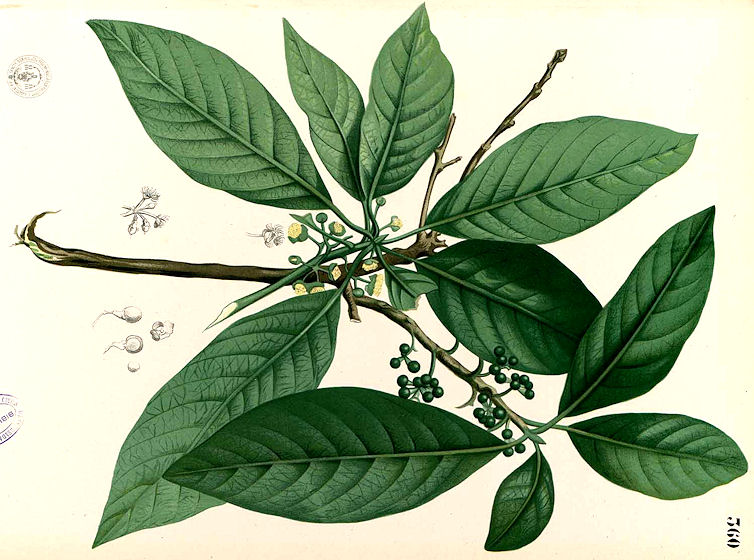
Abb.: Litsea glutinosa
(Lour.) C. B. Rob. 1911
[Bildquelle: Flora de Filipinas, 1880 /
Wikipedia. -- Public domain]
"Tetranthera apetala. Corom, pl. ii. N. 147.
[...]
Tomex sebifera. Willd. ii. p. 840.
Gaja-pippali. Asiat. Res, iv, p. 303.
Laurus involucrata. KÖnig's Mss. and Retz. Obs. vi. p. 27.
Sebifera glutinosa. Lourier. Cochin, Ch. 783.
[...]
This grows to be a middle sized tree, is a native of the mountainous parts of the Circars. Flowers in June, when the rains begin."
[Quelle: Roxburgh, William <1751-1815>: Flora indica, or, Descriptions of Indian plants / by the late William Roxburgh. -- Serampore : Printed for W. Thacker, 1832. -- Vol. 3, S. 819f.]
Fabaceae (Hülsenfrüchtler)
Kletterranke
| 16. c./d. cavyaṃ tu
cavikā kākaciñcīguñje tu kṛṣṇalā चव्यं तु चविका काकचिञ्ची-गुञ्जे तु कृष्णला ॥१६ ख॥ [Bezeichnungen für Abrus precatorius L. 1763, rote Varietät - Paternostererbse - Indian Liquorice:]
|
Colebrooke (1807): "Retti. Abrus precatorius."
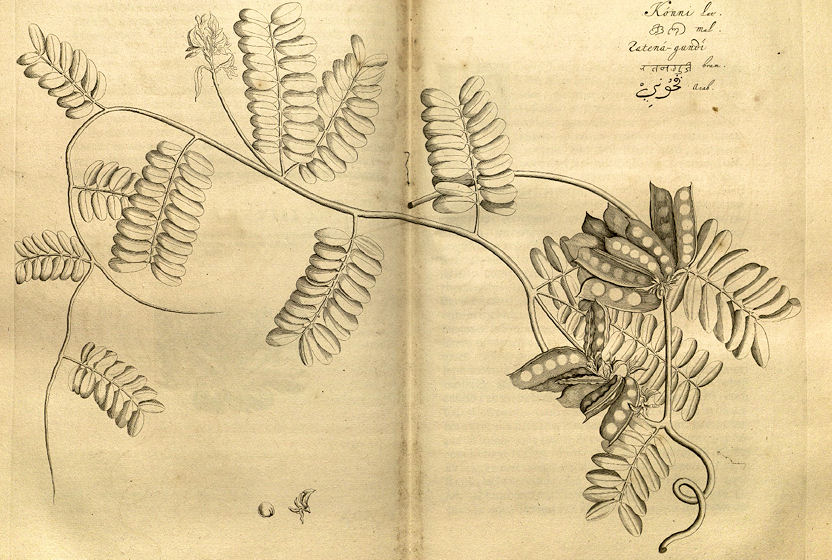
Abb.: Abrus precatorius L. 1763 -
Paternostererbse - Indian Liquorice
[Bildquelle: Hortus malabaricus VIII. Fig. 39, 1688]
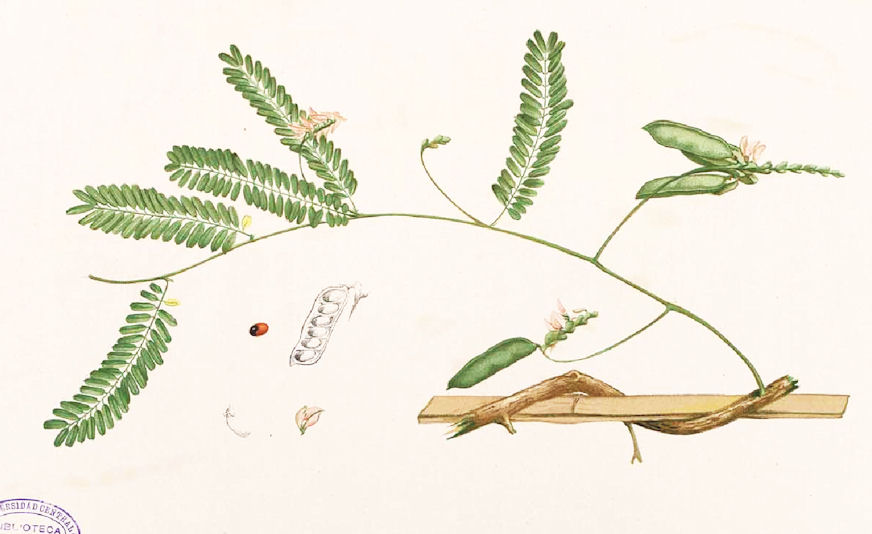
Abb.: Abrus precatorius
L. 1763 - Paternostererbse - Indian Liquorice
[Bildquelle. Flora de Filipinas 1880 / Wikimedia. -- Public domain]
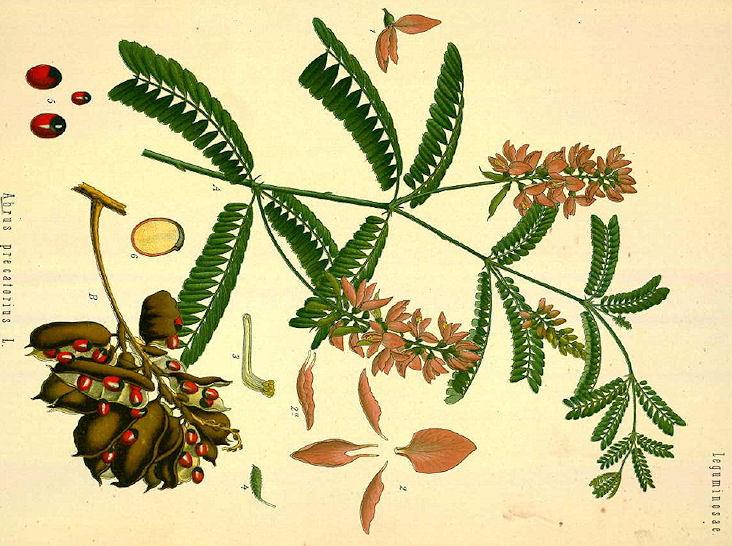
Abb.: Abrus precatorius L. 1763 -
Paternostererbse - Indian Liquorice
[Bildquelle: Köhler, 1883-1914]
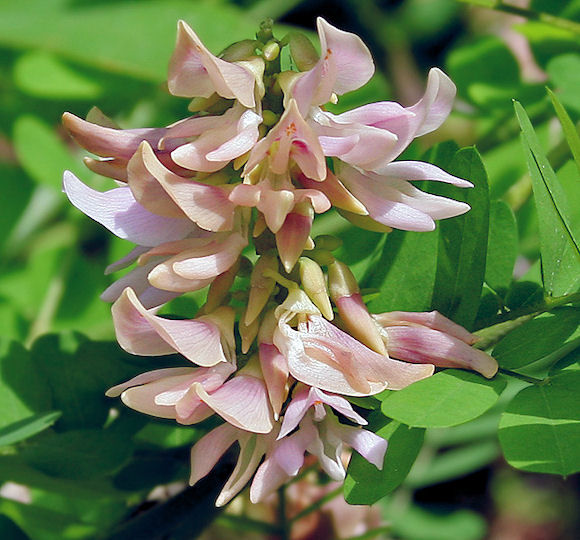
Abrus precatorius L. 1763 -
Paternostererbse - Indian Liquorice, Hyderabad -
హైదరాబాద్ -
حیدرآباد, Andhra Pradesh
[Bildquelle: J. M. Garg / Wikipedia. --
GNU FDLicense]
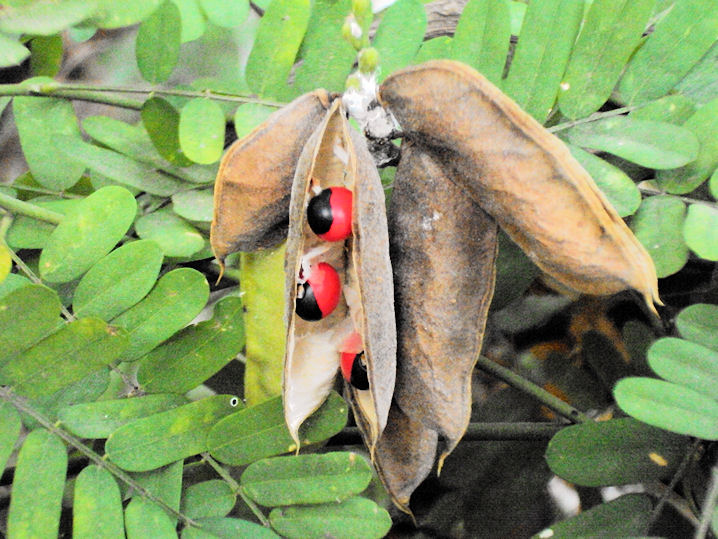
Abb.: Abrus precatorius
L. 1763 - Paternostererbse - Indian Liquorice
[Bildquelle: பரிதிமதி / Wikimedia. --
Creative Commons
Lizenz (Namensnennung, share alike)]
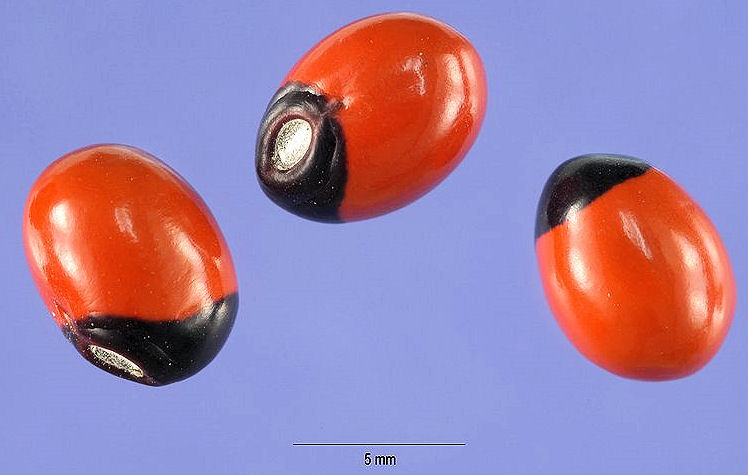
Abb.: Abrus precatorius
L. 1763 - Paternostererbse - Indian Liquorice
[Bildquelle: USDA-NRCS / Wikipedia. -- Public domain]
"Abrus precatorius. Willd.
Sans. Gunja, Krishnala, its red seed Ruttika.
[...]
Konni. Rheed. Mal. viii. t. 39.
Abrus. Rumph. Amb. v. t. 32.
Phaseolus arborescens, &c. Pluck. Alm. 294. t. 214. f. 5.
Gunja. Asiat. Res. ii. 154, and 499.
This is one of the most common plants in every part of India.
Flowering-time the close of the rains.
[...]
The seeds are often used as weights by jewellers.
The root is employed as a substitute for liquorice, (Glycyrrhiza glabra,) being like it, sweet and mucilaginous.
Of this pretty plant, I have met with three varietes in India, viz.
With rose-coloured flowers, red seed, and black eye.
With (lark-coloured flowers, black seed, and white eye.
- With white flowers, white seed, and black eye."
[Quelle: Roxburgh, William <1751-1815>: Flora indica, or, Descriptions of Indian plants / by the late William Roxburgh. -- Serampore : Printed for W. Thacker, 1832. -- Vol. 3, S. 257ff.]
"Abrus precatorius (Linn.) N. O. Leguminosae. Wild or country Liquorice [...]
Description. — Twining; [...]
Fl. April—October.
W. & A. Prod. L 236.—Roxb. Flor. Ind. iii. 257.
Glycine abrus, Linn.— Rheede Mal. viii. t. 39.
Southern Peninsula. Mysore. Hindostan. Assam.
Medical Uses.—The root yields an extract similar in medicinal properties to Liquorice, though somewhat bitterish. The leaves yield even, more than the root. The latter, mixed up with honey, are applied externally to swellings; and, pulverised and chewed with sugar, are given to mitigate coughs. Lunan states that in Jamaica they are used instead of tea In Java the roots are considered demulcent, and the mucilage is there combined with some bitter. The seeds are occasionally employed externally in ophthalmia. The white seeds are considered to act as a poison, producing vomiting and convulsions, but not unusually fatal to man. The smallest fatal dose is one tolah. The expressed juice of the leaves is said to be useful in aphthae.—Ainslie. Powell's Punj. Prod.
Economic Uses.—There are five varieties of this creeper, with scarlet, black, white, yellow, and blue seeds. The scarlet are most common. These, which have a jet-black spot at the top, are used by jewellers and druggists as weights, each weighing almost uniformly one grain. The goldsmiths reduce them to a fine powder, and in this state use them to increase adhesion in the more delicate parts of manufactured ornaments. They are also used for beads and rosaries, whence the specific name. The Hindoos prize them for necklaces and other ornaments. In Hindoostan they are known as the Retti weights.—Lindley. Ainslie."
[Quelle: Drury, Heber <1819 - 1872>: The useful plants of India : with notices of their chief value in commerce, medicine, and the arts. -- 2d ed. with additions and corrections. London : Allen, 1873. -- xvi, 512 p. ; 22 cm. -- s.v.]
"ABRUS PRECATORIUS, Linn. Fig.—Rheede, Hort. Mai. viii. t. 39 ; Bentl. and Trim., t. 77.
Jamaica Wild Liquorice, Jequirity
Hab .—India and other hot countries.
[...]
History, Uses, &c.—This plant is mentioned by Susruta and the older Sanskrit writers, it must therefore have long been in use as a medicine among the Hindus; they describe two varieties, namely, red and white-seeded. The seeds are said to be poisonous, and are used internally in affections of the nervous system, and externally in skin diseases, ulcers, and as an application to fistulas to excite inflammatory action. The root is described as emetic. Examples of compound medicines containing the seeds, extracted from Sarangadhara, Chakra datta, and the Bhavaprakasa will be found in Dutt's Hindu Materia Medica, p. 152. Mahometan writers under the name of Ain-ed-dik (cock's eye) describe the seeds, and state that they are hot and dry, tonic and aphrodisiac. Their use by goldsmiths as a weight is alluded to in the following well known Doha (couplet) :—
Sonā kahe sunār se, "uttum mhāri jāt
Kāle munh ki ghungehi, aur tule hamāre sāth."My rank is of the highest, said the gold to the goldsmith, shall I be weighed against that black-faced seed! Sloane, in 1700, appears to have been the first to suggest the use of Abrus root as a substitute for liquorice. Prosper Alpinus, who visited Egypt in 1592, only mentions the use of the seeds as beads, and states that they are sometimes eaten, but are very unwholesome ; he calls the plant "abrus," a name probably of Coptic origin, but possibly derived from the Greek
αβρος, pretty. Greek and Latin writers do not mention any plant bearing this name. Dr. Burton Brown (Punjab Poisons) records a case in which 40 seeds of Abrus, administered internally, caused purging and vomiting, with symptoms of collapse and suppression of urine; the patient recovered under the use of stimulants.In the Concan singers chew the leaves of the white-seeded variety as a remedy for hoarseness; they are also chewed with cubebs and sugar to cure aphthae of the mouth. In spermatorrhoea with bloody discharges, equal parts of the juice of white Abrus leaves and Henna leaves are rubbed with the root of Holostemma Rheedii, cummin, and sugar, and administered. Abrus seeds are said to have been used for centuries in Brazil as a popular remedy for granular lids and pannus, and attention was called to this practice in Europe in 1862, without apparently leading to any experiments with the drug.
Ainslie says:—"This root, when dried, coincides so exactly with the liquorice root of the shops, that it is. often sold for it in the bazaars in Bengal." Other writers repeat the same statement, one which we cannot confirm, as we consider the root to bear very little resemblance to liquorice either as regards appearance or qualities ; as pointed out by Mr. Moidin Sheriff, the leaves are by far the sweetest part of the plant, and from them a tolerable extract may be made, but in most parts of India, where true liquorice is obtainable in any quantity as an article of commerce, it would be much more expensive to collect them than to use liquorice."
[Quelle: Pharmacographia indica : a history of the principal drugs of vegetable origin met with in British India / by William Dymock [1834-1892], C. J. H. Warden and David Hooper [1858-1947]. -- Bd. 1. -- London, 1890. -- S. 430f.]
Zygophyllaceae (Jochblattgewächse)
Ein bis zweijähriges, bis 50 cm hohes Kraut
| 17. palaṅkaṣā tv
ikṣugandhā śvadaṃṣṭrā svādukaṇṭakaḥ gokaṇṭako gokṣurako vanaśṛṅgāṭa ity api
पलंकषा त्व् इक्षुगन्धा श्वदंष्ट्रा
स्वादुकण्टकः । [Bezeichnungen für Tribulus terrestris L. 1753 - Burzeldorn - Cat's Head:]
|
Colebrooke (1807): "Goccharu. Barleria (or Ruellia) longifolia [L. 1756 = Hygrophila schulli M. R. Almeida & S. M. Almeida 1987; siehe unten Vers 23a./b.]. The name seems to be also applied to Tribulus lanuginosus [L. 1753 = Tribulus terrestris L. 1753]."
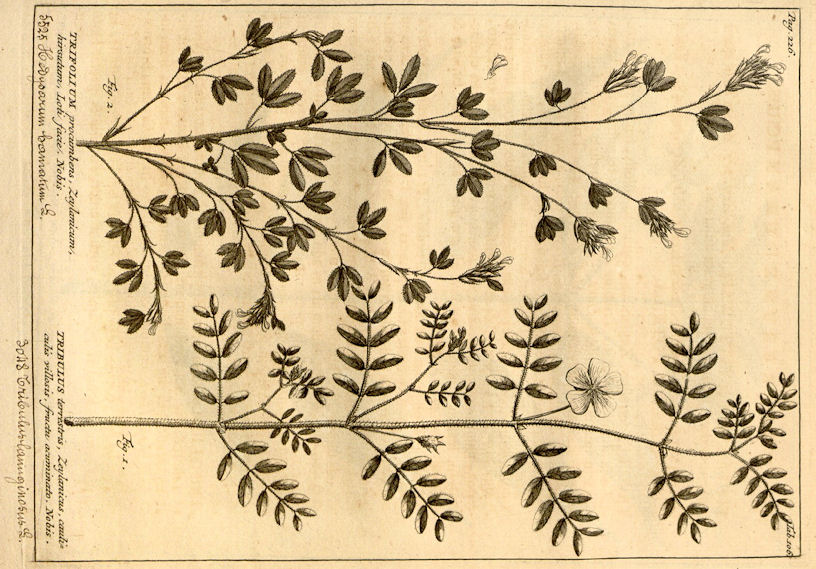
Abb.: गोकण्टकः । Tribulus
terrestris L. 1753 - Burzeldorn - Cat's Head
[Bildquelle: Thesaurus zeylanicus :exhibens plantas in insula Zeylana nascentes,
inter quas plurimae novae species & genera inveniuntur, omnia iconibus
illustrata, ac descripta / cura & studio Joannis Burmanni, 1737. -- Tab. 106]
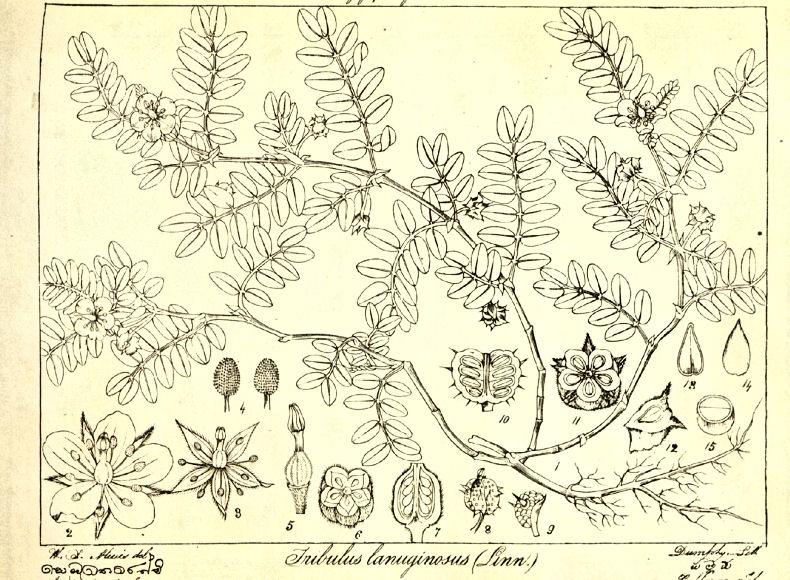
Abb.: स्वादुकण्टकः ।
Tribulus terrestris L. 1753 - Burzeldorn - Cat's Head
[Bildquelle: Wight Icones I, Tab. 98, 1840]
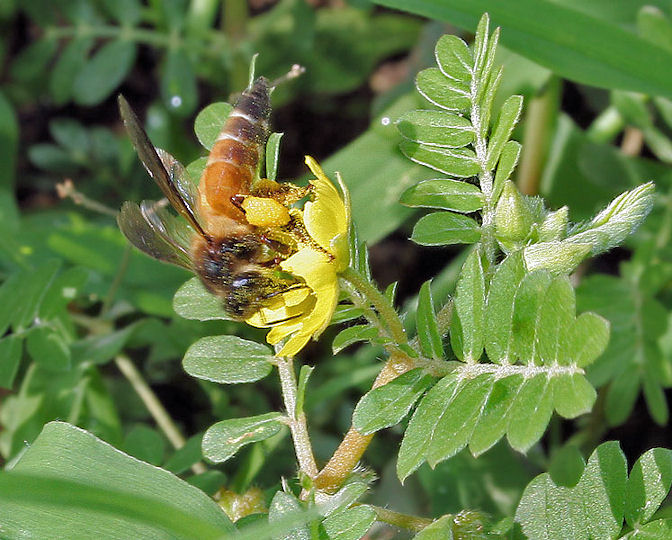
Abb.:
इक्षुगन्धा । Tribulus terrestris L. 1753 - Burzeldorn - Cat's Head,
Hyderabad -
హైదరాబాద్ -
حیدرآباد, Andhra Pradesh
[Bildquelle: J. M. Garg / Wikipedia. --
GNU FDLicense]

Abb.:
स्वादुकण्टकः । Tribulus terrestris L. 1753 - Burzeldorn - Cat's
Head, Hyderabad -
హైదరాబాద్ -
حیدرآباد, Andhra Pradesh
[Bildquelle: J. M. Garg / Wikipedia. --
GNU FDLicense]
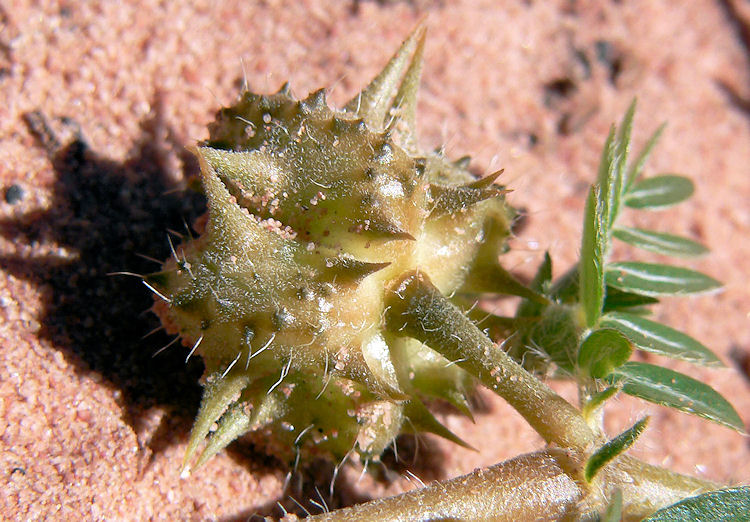
Abb.: पलङ्कषा ।
Tribulus terrestris L. 1753 - Burzeldorn - Cat's Head, Nevada, USA
[Bildquelle: Stan Shebs / Wikimedia. -- GNU FDLicense]
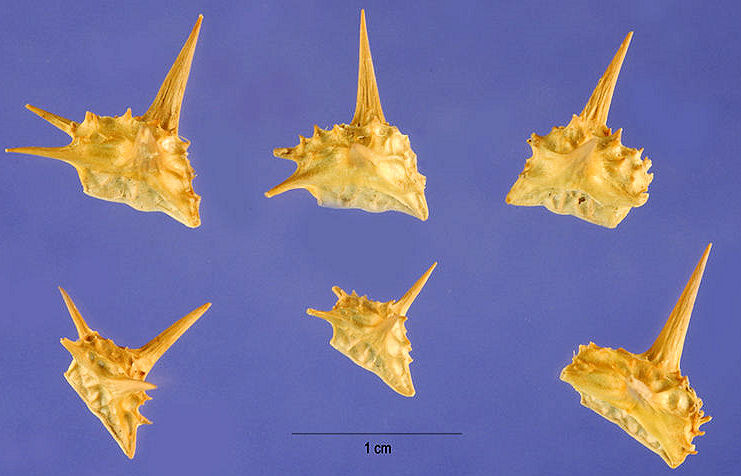
Abb.: श्वदंष्ट्रा
। Tribulus terrestris L. 1753 - Burzeldorn - Cat's Head
[Bildquelle: USDA-NRCS / Wikipedia. -- Public domain]
"Tribulus lanuginosus. Willd. 2. 566.
[...]
Tribulus terrestris zeylanicus. Burm. zeyl. 1. 106. f.1.
Sans. Gokshooruka.
Common on pasture land in many parts of India, producing flowers and ripe seed great part of the year."
[Quelle: Roxburgh, William <1751-1815>: Flora indica, or, Descriptions of Indian plants / by the late William Roxburgh. -- Serampore : Printed for W. Thacker, 1832. -- Vol. 2, S. 401f.]
"Tribulus lanuginosus (Linn.) N. O. Zygophyllaceae.
[...]
Description.—Trailing; [...] flowers solitary, bright yellow, sweet-scented.
Fl. All the year.
W. & A. Prod. i. 145.—Roxb. Fl. Ind. ii. 401.— Wight Icon. i. t. 98.
Coromandel. Deccan. Bengal. Travancore.
Medical Uses.—There is a variety common in the southern parts of the Peninsula with red flowers called in Tamil Yerra-Pulleroo, whose leaves have the smell of cloves. Of the present one the leaves and root are said by the natives to possess diuretic qualities; and are prescribed in decoction. The seeds powdered are given in infusion to increase the urinary discharge, and are also used in dropsy and gonorrhoea.—(Ainslie.) The herb is said to be astringent and vermifuge, and the seeds cordial.—Powell's Punj. Prod."
[Quelle: Drury, Heber <1819 - 1872>: The useful plants of India : with notices of their chief value in commerce, medicine, and the arts. -- 2d ed. with additions and corrections. London : Allen, 1873. -- xvi, 512 p. ; 22 cm. -- s.v.]
"TRIBULUS TERRESTRIS, Linn.
Fig-—Wight Ic. t. 98.
Small Caltrops
Hab.—India and other warm countries.
[...]
History, Uses, &c.—This plant is the Gokshura and Ikshugandha of Sanskrit writers; the first of these names signifies "cow's hoof" from the resemblance of the cocci when adhering together in pairs, as is frequently the case, to a cloven hoof, the second alludes to the aroma of the plant.
The Hindus use the fruit and root; they regard them as having cooling, diuretic, tonic and aphrodisiac properties, and use them in gonorrhoea and dysuria. The root is one of the ten drugs which go to form the Dasamula Kvatha, a compound decoction often mentioned in Sanskrit works. The ten plants are Desmodium gangeticum, Uraria lagopodioides, Solanum Jacquini, Solanum indicum, Tribulus terrestris, Aegle Marmelos, Calosanthes indica, Gmelina arborea, Stereospermum suaveolens, and Premna spinosa. The first five of these are called Hrasva (or laghu) pancha mula, or the five minor plants, and the last five, Vrihat pancha mula, or the five major plants. According to Loureiro, T. terrestris is astringent.
It is the Khasak or Hasak of the Arabs and Persians; and is well described by Ainslie, who says:—"It is a common plant near the Dardanelles, and is called in modern Greek τριβολια. Dioscorides calls it τριβολος and Pliny tribulus ; they both describe two kinds, 'terrestris' and 'aquaticus,.' The latter is the Trapa natans, Linn., or Water Chestnut. In the Pharmacopoeia of India the use of T. terrestris as a diuretic in Southern India is noticed." In Pudakota the flowers rubbed with silver are applied in inflammation of the cornea. The action of this drug on the mucous membrane of the urinary passages appears to resemble closely that of Buchu and Uva Ursi; it may often be advantageously combined with opium and hyoscyamus."
[Quelle: Pharmacographia indica : a history of the principal drugs of vegetable origin met with in British India / by William Dymock [1834-1892], C. J. H. Warden and David Hooper [1858-1947]. -- Bd. 1. -- London, 1890. -- S. 243f.]
Ranunculaceae (Hahnenfußgewächse)
Kraut
| 18. viśvā viṣā prativiṣātiviṣopaviṣāruṇā śṛṅgī mahauṣadhaṃ cātha kṣīrāvī dugdhikā same विश्वा विषा प्रतिविषातिविषोपविषारुणा । [Bezeichnungen für Aconitum heterophyllum Wall. ex Royle:]
|
Colebrooke (1807): "Atis. Betula ? As. Res. vol. vi. p. 573."
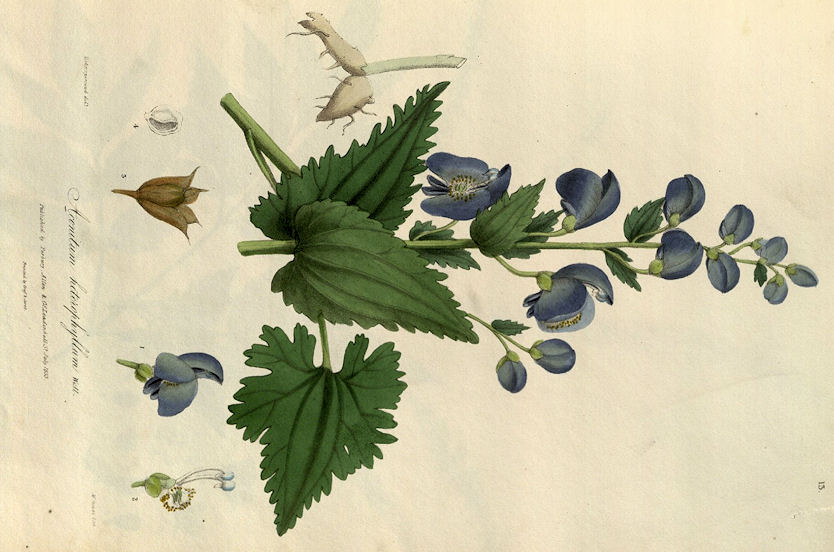
Abb.: अतिविषा । Aconitum heterophyllum Wall. ex
Royle
[Bildquelle: Royle, J. Forbes <1799-1858>: Illustrations of the botany and other
branches of the natural history of the Himalayan Mountains :and of the flora of
Cashmere. -- Vol 2: Plates. -- London : Allen, 1839. -- Pl. 13.]
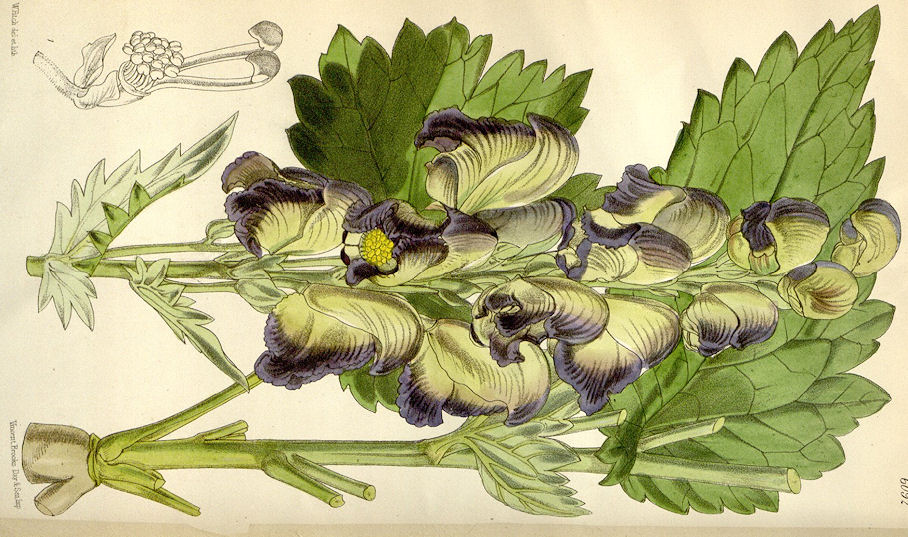
Abb.: शृङ्गी ।
Aconitum heterophyllum Wall. ex Royle
[Bildquelle: Curtis's Botanical Magazine, v. 100
(1874), Tab. 6092]
"Aconitum heterophyllum (Wall.) [...]
Description.--Shrub ; [...] flowers blue.
Royle ii. t. 13.
Himalaya.
Medical Uses.—The root of this species of Aconite, known by the name of Atees, has long been celebrated as a tonic and valuable febrifuge. It is generally sold in the bazaars as a fine white powder, but is somewhat expensive. There is a spurious substance called by the same name, which is only the root of the Asparagus sarmentosus. The true Atees is intensely bitter and slightly astringent, with abundant farina, which is free from any noxious qualities. It is probably not so injurious a poison as the Bish, as it is attacked by insects, while the other is not. There are two kinds, one black and one white, both bitter and astringent, pungent and heating, aiding digestion, useful as tonic medicines and aphrodisiac. The present species is found also on the Himalaya at elevations from 9000 to 10,000 feet.—Royle. Annals of Med. Science, 1856.
The roots are about an inch long, of an oblong-oval pointed form, light grey externally, white inside, and of a pure bitter taste.
Modern experience confirms the value of Atees as an antiperiodic. Dr Balfour was eminently successful in many cases of fever which came under his treatment with its employment. He, however, stated in his reports the necessity of selecting the best specimens, as much of inferior quality is sold in the bazaars. He advises that every root should be broken across, and all which are not pure white be discarded. The other species of Aconite found on the Himalaya, and yielding similar properties, are, A. palmatum (Don) and A. luridum (H. & T.)—Pharm. of India. Indian Annals of Med. Science, v. 548."
[Quelle: Drury, Heber <1819 - 1872>: The useful plants of India : with notices of their chief value in commerce, medicine, and the arts. -- 2d ed. with additions and corrections. London : Allen, 1873. -- xvi, 512 p. ; 22 cm. -- s.v.]
"ACONITUM HETEROPHYLLUM, Wall
Fig.—Bentl. and Trim., t. 7.
Hab.—West temperate Himalaya from Kumaon to Hansora.
[...]
History, Uses, &c. The earliest notices of Ativisha (counteracting poison) are to be found in Hindu works on Materia Medica, Sarangadhara and Chakradatta, where it is recommended as a remedy in fevers, diarrhoea, dyspepsia and cough, also as an alexipharmic; those in Arabic and Persian works are short, and apparently copied from them ; they direct it to be prescribed in combination with aromatics, astringents and sometimes with other bitters, such as Bonduc-nuts, Tinospora, Holarrhena, &c. It is an ingredient in Bal-goli, a pill given to infants to keep them quiet, which contains thirty-one drugs, of which three are narcotics, viz., Bhang, Opium and Datura, and the remainder bitters and aromatics. This pill is sold by all the native druggists, and, it need hardly be said, is most fatal to children. The author of the Makhzan-el-Adwiya calls Atis an Indian root, resembling a small specimen of Aristolochia longa and says that some authorities describe three kinds, viz., Atis, Part-bikhta, and Shamkand ; but others only two kinds—white and black. He says it is aphrodisiacal and tonic, checks diarrhoea, and removes corrupt bile and cold humours and the diseases arising from them.
The early English physicians in India appear to have been chiefly impressed with its antiperiodic and tonic action in fevers, and the drug has until quite a recent date been much administered as an antiperiodic in doses of about 30 grains every four or six hours. The discovery that the active principle, Atisine, is only present in very small quantities in Atis, seems to have brought the drug into discredit, and the European demand for it has much fallen off. The evidence collected by Dr. Gr. Watt for his Dictionary of the Economic Products of India indicates that Atis is now considered an indifferent antiperiodical by medical men. Dr. M. Sheriff consuliders that the ordinary doses are only useful as a tonic, and that two drams or more should be given as an antiperiodic. Probably the native estimate of the drug, as given above from the Makhzan, is not far from the truth, viz., that it is tonic and digestive and often useful in dyspepsia with diarrhoea."
[Quelle: Pharmacographia indica : a history of the principal drugs of vegetable origin met with in British India / by William Dymock [1834-1892], C. J. H. Warden and David Hooper [1858-1947]. -- Bd. 1. -- London, 1890. -- S. 15f.]
Euphorbiaceae (Wolfsmilchgewächse)
Euphorbia thymifolia: Bodendecker
|
18. c./d. śṛngī mahauṣadhaṃ cātha kṣīrāvī dugdhikā same शृङ्गी महौषधं चाथ क्षीरवी दुग्धिका समे ॥१८ ख॥ [Bezeichnungen für Euphorbia thymifolia L. 1753 + Euphorbia hirta L. - Behaarte Wolfsmilch:]
|
Colebrooke (1807): "Dudhi. Asclepias rosea, (R.[oxb.]) [= Oxystelma esculentum (L. f.) R. Brown 1810] and other species."
"The Sanskrit names Kshiri, Kshirini, Kshira-kshava, Dugdha, Dugdhika, Dugdhapashana, &c., are loosely applied to a number of milky plants, but more especially to the edible Asclepiads, such as Oxystelma esculentum, Holostemma Rheedii [Wall.], Caralluma edulis [(Edgew.) Benth. ex Hook. f.] and fimbriata [Wall.]. These plants as well as other Asclepiads are also called Yugmaphalottama, and Uttama-phalini, in allusion to their "twins," which are favourite vegetables of the Hindus." [Quelle: Pharmacographia indica : a history of the principal drugs of vegetable origin met with in British India / by William Dymock [1834-1892], C. J. H. Warden and David Hooper [1858-1947]. -- Bd. 2. -- London, 1891. -- S. 457f.]
Euphorbia thymifolia L. 1753
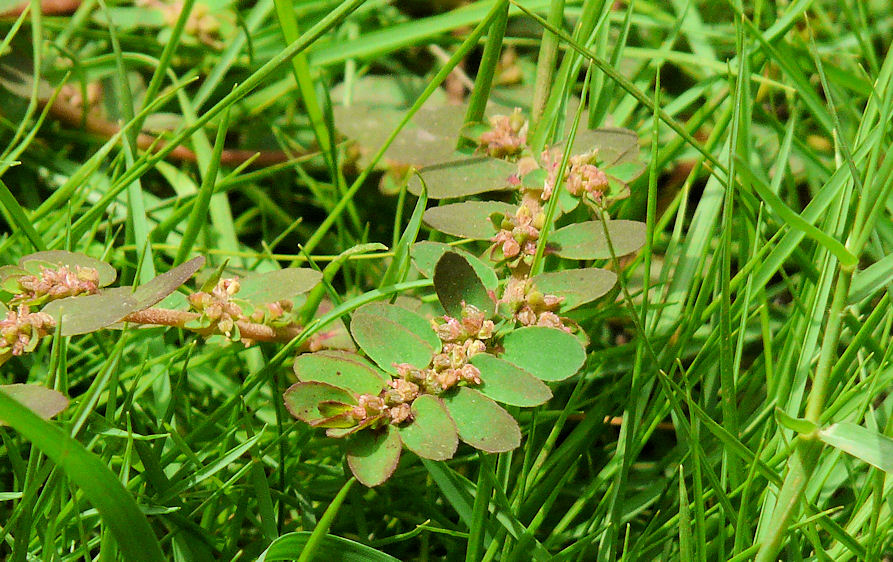
Abb.: Euphorbia thymifolia L. 1753
[Bildquelle: dinesh_valke. --
http://www.flickr.com/photos/dinesh_valke/2696439002/. -- Zugriff am
2010-11-14. --
Creative
Commons Lizenz (Namensnennung, keine kommerzielle Nutzung, share alike)]
"Euphorbia thymifolia. Willd. 2. 898.
[...]
A native of gravelly spots, and in flower most part of the year."
[Quelle: Roxburgh, William <1751-1815>: Flora indica, or, Descriptions of Indian plants / by the late William Roxburgh. -- Serampore : Printed for W. Thacker, 1832. -- Vol. 2, S. 473.]
"Euphorbia thymifolia (Linn.) [...]
Description.—Branches pressing flat on the earth, [...]
Fl. Nearly all the year.
Roxb. Fl. Ind. ii. 473.
Peninsula. Bengal Dry situations near woods.
Medical Uses.—The leaves and seeds are slightly aromatic and astringent. In a dried state they are given as a vermifuge. The leaves when carefully dried smell like tea.— Ainslie."
[Quelle: Drury, Heber <1819 - 1872>: The useful plants of India : with notices of their chief value in commerce, medicine, and the arts. -- 2d ed. with additions and corrections. London : Allen, 1873. -- xvi, 512 p. ; 22 cm. -- s.v.]
"EUPHORBIA THYMIFOLIA, Burm.
Fig.—-Burm. Thes. Zeyl, t. 105, f. 2; Rheede, Hort. Mal., x. t. 33.
Hab.—Throughout India and Ceylon, Central Asia, and all hot countries, except Australia.
[...]
History, Uses, &C.—This plant is not mentioned in the standard Sanskrit medical works, but, along with the allied species E. granulata, Forsk., E. microphylla, Heyne, and E. Clarkeana, Hook., which the natives do not distinguish from it, it is used medicinally in most parts of India and the East. The author of the Khuldsat-el-tajarib states that it is a small milky prostrate plant with slender reddish stems, and opposite leaves about the size of a split lentil seed, very common about Merv in sandy ground. It is hot and dry in the first of the third degree; the expressed juice or powdered plant with wine is given as a remedy for the bites of venomous reptiles, and is applied externally to the bitten part; with milk it acts as a purgative and expels all noxious humors from the body. According to Ainslie, the Sanskrit name is Rakta-vindu-chhada, which would imply that it is a remedy for Rakta-vindu, "gonorrhoea with sanious discharge." He remarks:—" The very small leaves and seeds of this low-growing annual plant, which, in their dried state, are slightly aromatic and a little astringent, are given by the Tamool doctors, in worm cases, and in certain bowel affections of children; they are commonly administered in the form of powder, and in buttermilk, to the quantity of one pagoda and a quarter weight in the course of the day on an empty stomach. The leaves when carefully dried smell something like tea." (Mat. Ind., ii., 75.) Irvine states that it is used as a stimulant and laxative in Northern India. In the Concan the juice is used to cure ringworm, and mixed with chloride of ammonium for the cure of dandriff. O'Shaughnessy says that the juice is a violent purgative, and that the fresh plant is, by the Arabs, applied to wounds. In the Dict. Econ. Prod. of India, it is stated, on the authority of the Rev. A. Campbell, that the Santals use the root of this plant, which they call Nanha-pusi-toa, as a remedy for amenorrhea.
Description.—A much branched annual prostrate plant."
[Quelle: Pharmacographia indica : a history of the principal drugs of vegetable origin met with in British India / by William Dymock [1834-1892], C. J. H. Warden and David Hooper [1858-1947]. -- Bd. 3. -- London, 1893. -- S. 249f.]
Euphorbia hirta L. - Behaarte Wolfsmilch
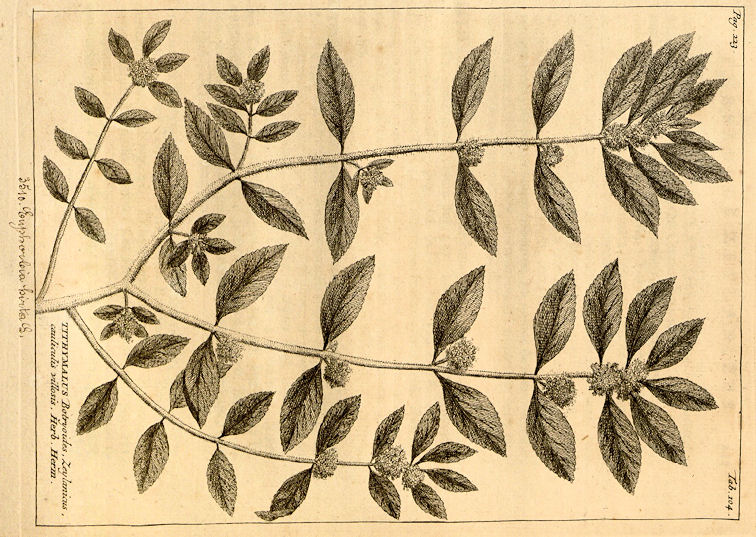
Abb.: Euphorbia hirta L. - Behaarte Wolfsmilch
[Bildquelle: Thesaurus zeylanicus :exhibens plantas in insula Zeylana nascentes,
inter quas plurimae novae species & genera inveniuntur, omnia iconibus
illustrata, ac descripta /cura & studio Joannis Burmanni, 1737. -- Tab. 104]
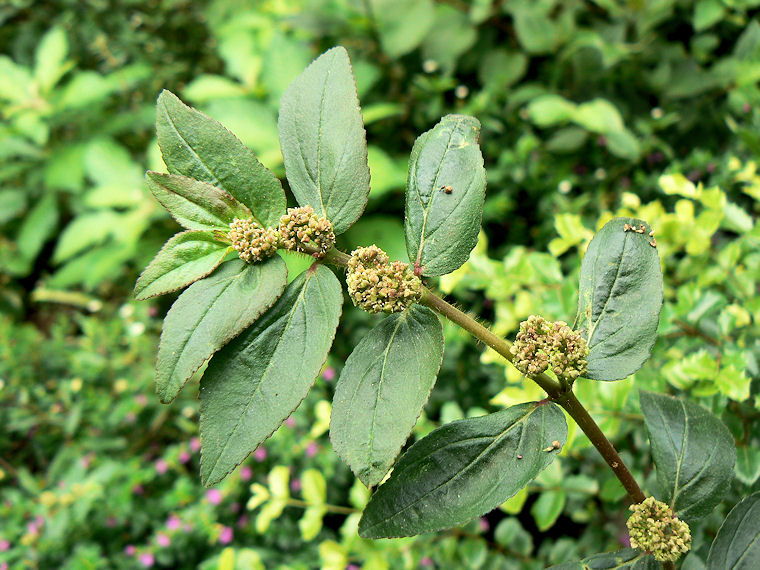
Abb.: Euphorbia hirta L. - Behaarte Wolfsmilch,
Maharashtra
[Bildquelle: dinesh_valke. --
http://www.flickr.com/photos/dinesh_valke/1367413654/. -- Zugriff am
2010-11-14. --
Creative
Commons Lizenz (Namensnennung, keine kommerzielle Nutzung, keine
Bearbeitung)]
Oxystelma esculentum (L. f.) R. Brown 1810
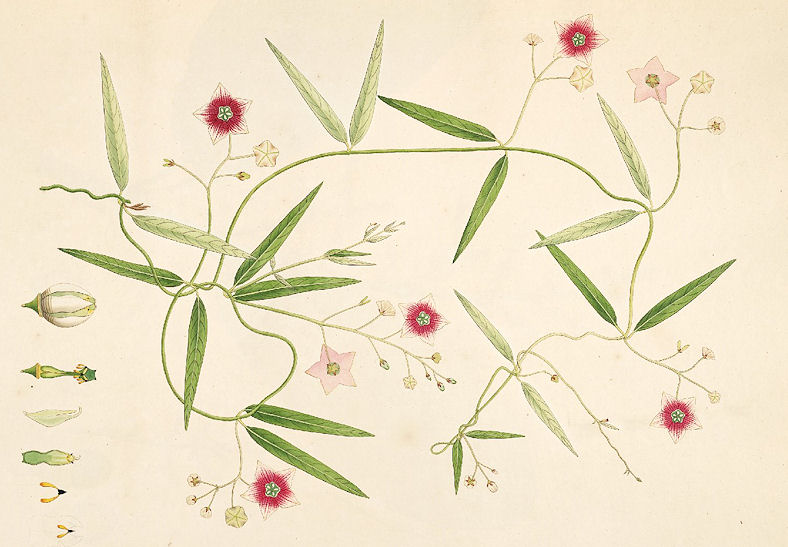
Abb.: Oxystelma
esculentum (L. f.) R. Brown 1810
[Bildquelle: Roxburgh. -- Vol I. -- 1795. -- Tab. 11. -- Image courtesy Missouri
Botanical Garden. http://www.botanicus.org.
--
Creative Commons Lizenz
(Namensnennung, keine kommerzielle Nutzung)]
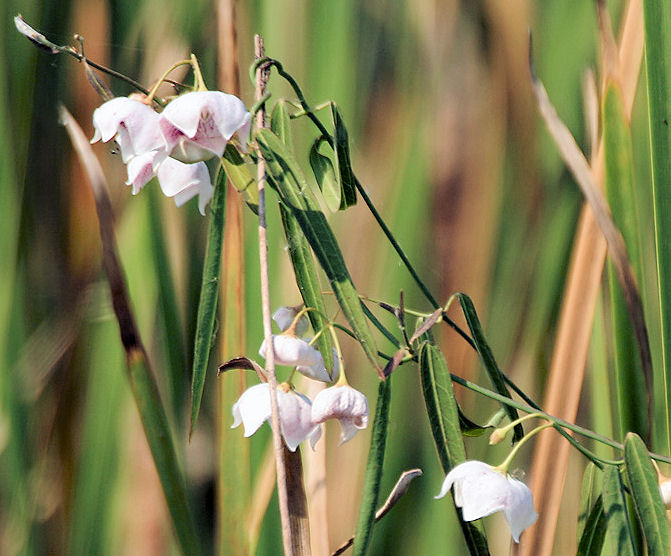
Abb.: Oxystelma
esculentum (L. f.) R. Brown 1810
[Bildquelle: J. M. Garg /
Wikimedia. -- GNU FDLicense]
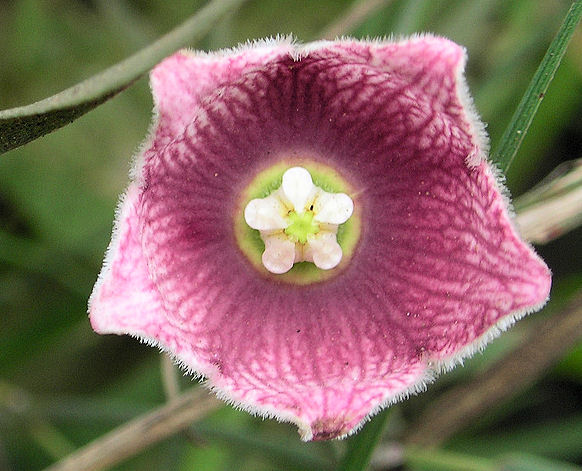
Abb.: Oxystelma esculentum (L.
f.) R. Brown 1810
[Bildquelle: Lalithamba. --
http://www.flickr.com/photos/45835639@N04/4308480907/. -- Zugriff am
2010-11-14. --
Creative Commons Lizenz (Namensnennung)]
"Asclepias rosea. Roxb.
[...]
Periploca esculenta, Will. 1. 1250. R. Corom. pl. 1. N. 11.
Periploca esculenta of König. See Suppl. plant. 168.
Dooghdika, (or milk plant ;) is its Sanscrit name. See Asiatic Researches, 4. 268.
It is a twining perennial ; growing in hedges, and amongst bushes on the banks of water courses, pools, &c. Leaves deciduous during the dry season. In flower and foliage during the rainy season.
[...]
On this Coast I do not find the natives ever eat it, or apply it to any purpose whatever ; cattle however eat it. Its elegant flowers render it well deserving of a place in the flower Garden. Every part abounds with milk, hence its names in various Asiatic languages."
[Quelle: Roxburgh, William <1751-1815>: Flora indica, or, Descriptions of Indian plants / by the late William Roxburgh. -- Serampore : Printed for W. Thacker, 1832. -- Vol. 2, S. 40f.]
Caralluma fimbriata Wall.
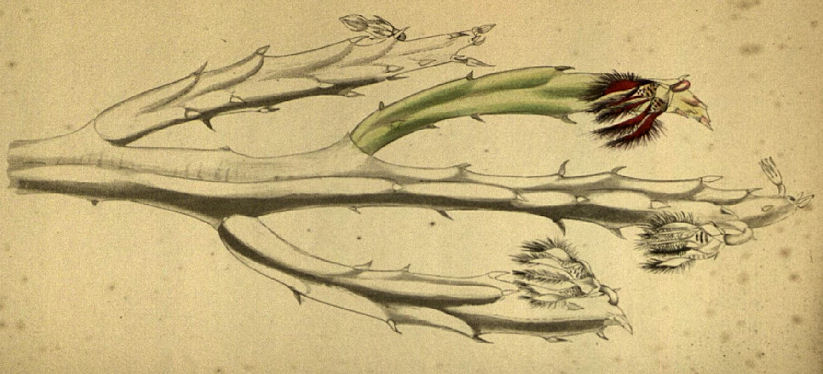
Abb.:
Caralluma fimbriata Wall.
[Bildquelle: The botanical cabinet : consisting of coloured delineations
of plants, from all countries, with a short account of each, directions for
management, &c, &c. -- Vol. 19 (1832). -- Tab. 1863]
Asparagaceae (Spargelgewächse)
Kletterstrauch
| 19. śatamūlī bahusutābhīrur indīvarī varī ṛṣyaproktā-bhīrupatrī-nārāyaṇyaḥ śatāvarī 20. a./b. aherur atha pītadru-kāleyaka-haridravaḥ शतमूली बहुसुताभीरुर् इन्दीवरी वरी । [Bezeichnungen für Asparagus racemosus Willd. 1799:]
|
Colebrooke (1807): "Śatavari. Asparagus racemosus."
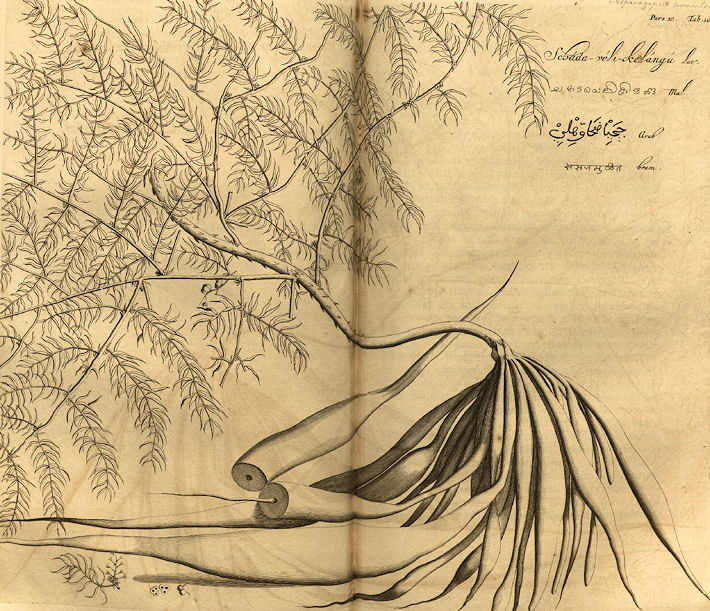
Abb.: शतमूली ।
Asparagus racemosus Willd. 1799
[Bildquelle: Hortus malabaricus X. Fig. 10, 1690]
"Asparagus racemosus. Ed. sp. Willd. 2. 152.
Shrubby, scandent. Thorns solitary, recurved.
[...]
Sans. Suta-moolee.
A native of various parts of India. Flowering: time the cold season, then it perfumes the air to a considerable distance with the delightful fragrance of its flowers ; seeds ripe in March."
[Quelle: Roxburgh, William <1751-1815>: Flora indica, or, Descriptions of Indian plants / by the late William Roxburgh. -- Serampore : Printed for W. Thacker, 1832. -- Vol. 2, S. 151f.]
"Asparagus racemosus (Willd.) N. O. Liliaceae. [...]
Description.—A straggling climbing shrub; [...] flowers small, white.
Fl. Nov.—Dec.
Roxb. Fl. Ind. ii. 151.— Wight Icon. t. 2056.
Travancore. Deccan.
Medical Uses.—This plant, says Roxburgh, will perfume the air to a considerable distance, owing to the delightful fragrance of its flowers. The root boiled in milk is given in bilious affections. It is necessary to remove the bark previous to administering it, as it is considered poisonous. The leaves boiled and mixed with ghee are applied externally to promote suppuration in boils and tumours.— (Roxb. Aiml.) It acts also as a diuretic, and is used in special diseases. It increases the appetite and removes pains in the bowels, and is also considered to prevent the confluence of small-pox.—(Punj. Prod.) The A. sarmentosus (Willd.), also a native of the Peninsula, has also medicinal qualities. It is known as the Sufed Mush; and on this Modeen Sheriff remarks (Suppl. to Pharm. of India, p. 59): " There are two kinds of Sufed Mush, one found in the bazaars of Southern India, and the other elsewhere. The former is the dried and split roots of Asparagus sarmentosus. Dried it is useless as a medicine, but when fresh it is nutrient and demulcent The Sufed Mush of all other parts is the real drug to which the name is applicable, and is the root of Asparagus ascendens. It is a useful medicine, and is better than Salep, for which it is used as a substitute. It is known under the Dukhanee name of Shakakul-hindi. It grows in Rohilcund (Pharm. of India, Suppl.) The roots of the A. sarmentosus are often candied, in which state they are occasionally brought from China. They are also pickled in vinegar, and used as tonics, and also boiled in oil and applied in diseases of the skin."—Ainslie. J. Graham."
[Quelle: Drury, Heber <1819 - 1872>: The useful plants of India : with notices of their chief value in commerce, medicine, and the arts. -- 2d ed. with additions and corrections. London : Allen, 1873. -- xvi, 512 p. ; 22 cm. -- s.v.]
"ASPARAGUS RACEMOSUS, Willd.
Fig.—Wight, Ic, t. 1056.
Hab. —Throughout India.
ASPARAGUS SARMENTOSUS, Wind.
Fig.—Rheede, Hort. Mal. x., t. 10.
Hab.—Upper India, Concan, and Deccan.
[...]
History, Uses, &c.—These two plants appear to be the Satavari and Maha-satavari of the Nighantas: among the synonyms of the first, we find Dvipika, Dvipa-satru, Varaghantika, Narayani, and Sata-padi; the synonyms of the second are very similar, amongst them we note Bahu-puttrika, Dagdha, and Bhasma-roha. Both plants are considered to be heavy and cold, sweet, demulcent, galactogogue, tonic, and strengthening, and to remove bilious and rheumatic humors, blood diseases, and swellings; they are used both internally and in the preparation of several medicated oils. The tubers are candied and eaten as a sweetmeat. The fresh juice of the root is given with honey as a demulcent in bilious dyspepsia or diarrhoea (Sarangadhara). As an aphrodisiac, Chakradatta directs four sers of the juice of the roots and four sera of ghi to be boiled in forty sirs of milk, and to be flavoured with sugar or honey, and long pepper.
The chief use of the drug, however, is in the preparation of medicated oils for external application in nervous and rheumatic affections and urinary disorders. The Narayana taila, a Popular remedy of this kind, contains the barks of Aegle Marmelos, Premna integrifolia, Oroxylum indicum, Eruthrina indica, Stereospermum suaveolens and Boerhavia repens, the fruit of Tribulus terrestris, and the leaves of Solanum xanthocarpum, Solanum indicum, Sida cordifolia and Sida rhombifolia, of each twenty tolas. The whole collection is boiled in 64 sers of water down to one-fourth and strained. To the strained decoction is added four sers each of the juice of Satavari and prepared scsamum oil, sixteen sers of cows' or goats' milk, and a paste prepared with four tolas of each of the following drugs—
Fennel seeds, wood of Cedrus Deodara, root of Nardostachys Jatamansi, liquid storax, Acorus root, sandalwood, herb of
Limnanthemum cristatum, costus, cardamoms, leaves of Dexmodium gangeticum, of Uraria lagopoides, of Phaseolus trilobus, and of Teramnus labialis, roots of Whitania somnifera, Vanda Roxburghii, and Boerhavia repens, rock salt. The whole is then reboiled and perfumed. (Chakradatta.)
Description.—Both plants are scandent woody shrubs,"
[Quelle: Pharmacographia indica : a history of the principal drugs of vegetable origin met with in British India / by William Dymock [1834-1892], C. J. H. Warden and David Hooper [1858-1947]. -- Bd. 3. -- London, 1893. -- S. 482ff.]
Berberidaceae (Berberitzengewächse)
Bis 3 m hoher Strauch
| 20. aherur
atha pītadru-kāleyaka-haridravaḥ dārvī pacaṃpacā dāruharidrā parjanīty api
अहेरुर् अथ
पीतद्रु-कालेयक-हरिद्रवः । [Bezeichnungen für Berberis aristata DC. 1821 - Begrannte Berberitze - Chitra:]
|
Colebrooke (1807): "Daruhaldi. Amomum xanthorhizon, Roxb. [= Amomum xanthorhizon Roxb. ex Steud. = Zingiber montanum (J. König) Link ex A. Dietr. 1831 - Bengal-Ingwer - Bengal Ginger, Cassumunar Ginger]"
Berberis aristata DC. 1821 - Begrannte Berberitze - Chitra
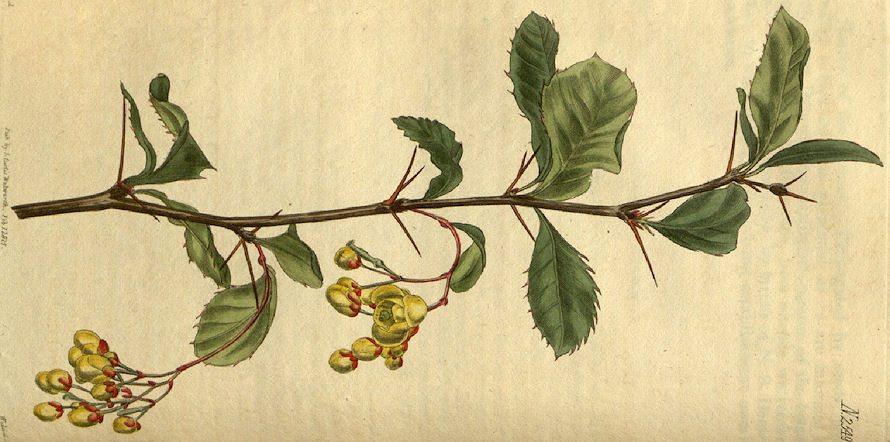
Abb.:
दारुहरिद्रा । Berberis aristata
DC. 1821 - Begrannte Berberitze - Chitra
[Bildquelle: Curtis's Botanical Magazine, v. 52 (1825), Tab. 2549]
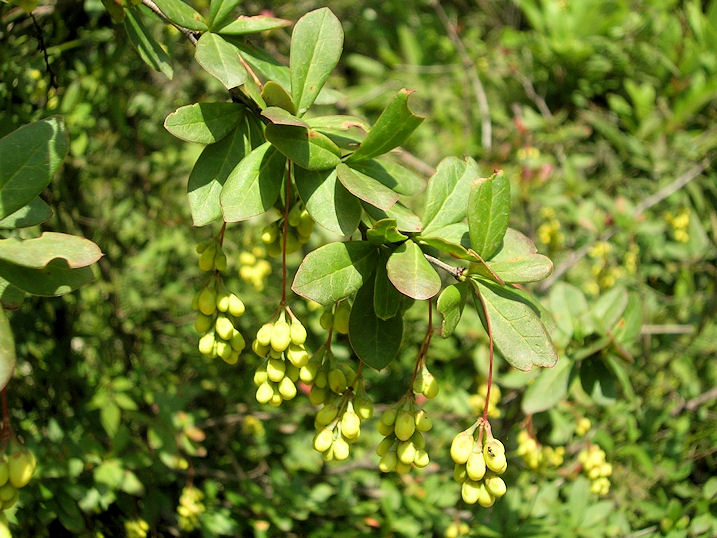
Abb.: पर्जनी । Berberis aristata DC. 1821
- Begrannte Berberitze - Chitra, Uttarakhand
[Bildquelle: L. Shyamal / Wikimedia. --
Creative Commons
Lizenz (Namensnennung, share alike)]
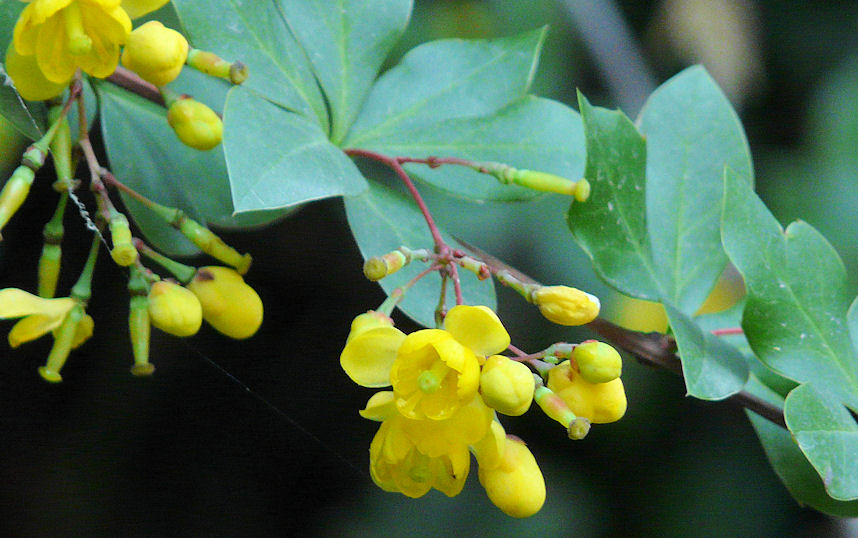
Abb.: पीतद्रुः । Berberis aristata DC.
1821 - Begrannte Berberitze - Chitra, Shimla -
शिमला,
Himachal Pradesh
[Bildquelle: dinesh_valke. --
http://www.flickr.com/photos/dinesh_valke/2558095589/. -- Zugriff am
2010-10-18. --
Creative
Commons Lizenz (Namensnennung, keine kommerzielle Nutzung, share alike)]
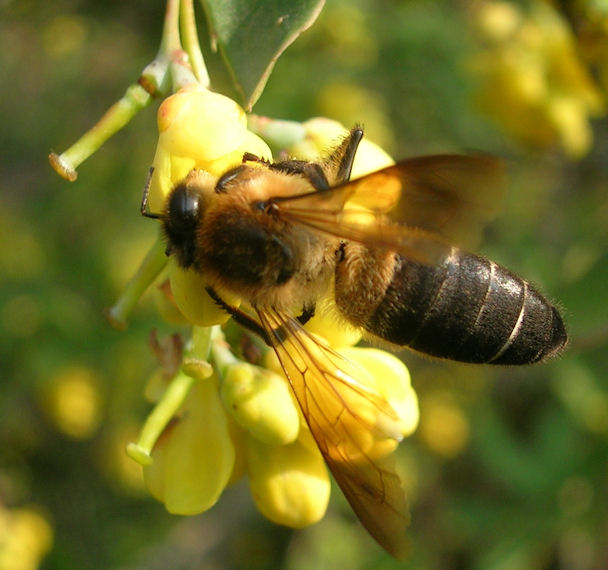
Abb.:हरिद्रुः । Berberis aristata DC.
1821 - Begrannte Berberitze - Chitra, Uttarakhand
[Bildquelle: L. Shyamal / Wikimedia. --
Creative Commons
Lizenz (Namensnennung, share alike)]
"Berberis tinctoria (Lesch.) Dyer's Berberry
Description.—Shrub, 6-10 feet; [...] flowers yellow; berries 2-3 seeded.
Fl. Jan.—ApriL
W. & A. Prod. i. 16.
Neilgherries. Pulney mountains.
Economic Uses.—This species of Berberry, found on the Neilgherries, serves, as the name implies, for dyeing a yellow colour. The roots contain 17 per cent of useful colouring matter. According to Leschenault, who had the wood analysed, it contained the yellow colouring principle in a greater state of purity than the common English Berberry. According to recent investigations, this, species is identical with the B. aristata.—(Dec.) It ranges on the mountains of India from the Himalaya to the Neilgherries, and to Newera Ellin, in Ceylon. It is a handsome and ornamental shrub, remarkable for its fine large compound racemes of flowers; the fruit is of an oblong shape and brownish-purple colour, with little or no bloom. It is very distinct from other species, and grows quickly. The root and wood are of a dark yellow colour, and form the yellow wood of Persian .authors. In Nepaul the fruit of this .species is dried like raisins.—Wight. Loudon, Journ. Agri. Hort. Soc., iii. 272."
[Quelle: Drury, Heber <1819 - 1872>: The useful plants of India : with notices of their chief value in commerce, medicine, and the arts. -- 2d ed. with additions and corrections. London : Allen, 1873. -- xvi, 512 p. ; 22 cm. -- s.v.]
"BERBERIS, ARISTATA, DC.
Fig.—Bentl. and Trim., t. 16.
Nepaul Barberry
Hab.—Temperate Himalaya, Nilgiri Mountains, Ceylon.
B. LYCIUM, Boyle.
Ophthalmic Barberry
Hab.—Western Himalaya from Garwhal to Hazara.
B. ASIATICA, - Roxb.
Fig.—Deless. Ic. Sel. ii. t. 1.
Hab .—Himalaya, Behar on Parasnath.
[...]
History, Uses, &c.—Varions species of Barberry occur oh the Himalaya and Nilgiri mountains in India, at elevations between 6,000 and 10,000 feet. The wood (Daruharidra), extract (Rasanjana), and probably the fruit, have been used by the natives from a very early date. The Greeks were acquainted with the extract under the name of Indian Lycium as long ago as the first century; it would appear, though, that there were other kinds of Lycium in use at that time. (Confer. Pharmacographia, p. 84.*) The early Arabian writers were also acquainted with it by the name of Huziz-i-Hindi,+ and mention its Indian name, which some of them derive from Ras, juice, and Uth (uthna, to boil). Hakim Abd-el-Hamid describes its manufacture from the powdered wood by exhaustion with water, filtration, and admixture with an equal bulk of cow's milk, the mixture being finally evaporated to the consistence of an extract, and enveloped in leaves; this method of preparation is the same as that described in Sanskrit works.
* Dios. i. 117; Plin. 24, 76, 77; Cels. 5, 26 ; 6, 7; 8, 6 ; Scrib. Larg. Comp. 19, in the early stage of ophthalmia.
+ They describe two kinds, Maki or the λυκιον of the Greeks, and Hindi or Indian ; the former was derived from Rhamnus infectorius, the berries of which are used in dyeing leather yellow.
Royle, in 1833, brought Rusot more prominently to the notice of Europeans; since then it has been pretty extensively employed as a tonic and febrifuge. The root-bark of Barberry is now official in the Pharmacopoeia of India, it is noticed in the Tuhfat-el-inuminin under the name of Arghis, and is said to possess all the properties of Mamiran. Surgeon-General Cornish, of Madras, states that the Nilgiri Barberry bark (Mullu-kulla- puttai Tam.,) has been used in the treatment of ague with good results. A similar opinion appears to be generally held by medical men in India. In the bazaars the stern, extract and fruit are always obtainable; the two first are considered cold and dry, and are prescribed in combination with other bitters and aromatics, as tonics and antiperiodics, especially when bilious symptoms and diarrhoea are present; they are also used in menorrhagia. Rusot mixed with opium, alum, rock salt, chebulic myrobalans, and various other-drugs, is much used as an external application in inflammatory swellings, and is rubbed in round the orbit in painful affections of the conjunctiva; it is also used mixed with honey as an application to aphthae, and abrasions and ulcerations of the skin, and mixed with milk it is dropped into the eye in conjunctivitis. The fruit is cooling and acid. Berberine in doses of grain given subcutaneously kills rabbits, with symptoms of prostration and fall of temperature; but a dose eight times as great given to them by the mouth has no action, and 15 grains only produce in man slight colicky pains and diarrhoea. Is said to cause contraction of the intestines and of the spleen, and to lessen oxidation in the blood. (Lauder Brunton.) The drugs which contain this alkaloid are very useful in malarial dyspepsia accompanied by a febrile condition."
[Quelle: Pharmacographia indica : a history of the principal drugs of vegetable origin met with in British India / by William Dymock [1834-1892], C. J. H. Warden and David Hooper [1858-1947]. -- Bd. 1. -- London, 1890. -- S. 64ff.]
Zingiber montanum (J. König) Link ex A. Dietr. 1831 - Bengal-Ingwer - Bengal Ginger, Cassumunar Ginger
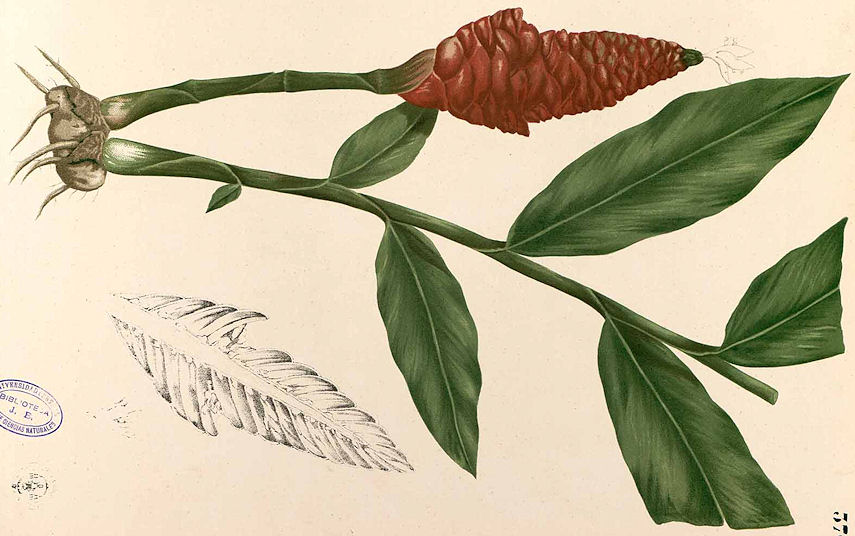
Abb.: Zingiber montanum (J. König) Link ex A. Dietr. 1831
- Bengal-Ingwer - Bengal Ginger, Cassumunar Ginger
[Bildquelle: Flora de Filipinas, 1880 /
Wikipedia. -- Public domain]
Acoraceae (Kalmusgewächse)
Bis 120 cm hohe, ausdauernde krautige Pflanze
| 21. vacogragandhā ṣaḍgranthā golomī śataparvikā śuklā haimavatī vaidhyamātṛ-siṃhyau tu vāśikā
वचोग्रगन्धा षड्ग्रन्था गोलोमी शतपर्विका । [Bezeichnungen für Acorus calamus L. - Kalmus - Calamus:]
|
Colebrooke (1807): [21a./b.:] "Orris root. Iris pseudacorus ? [L. 1753 - Sumpfschwertlilie]" [21c.:] "A white sort. Acorus calamus."
Acorus calamus L. - Kalmus - Calamus
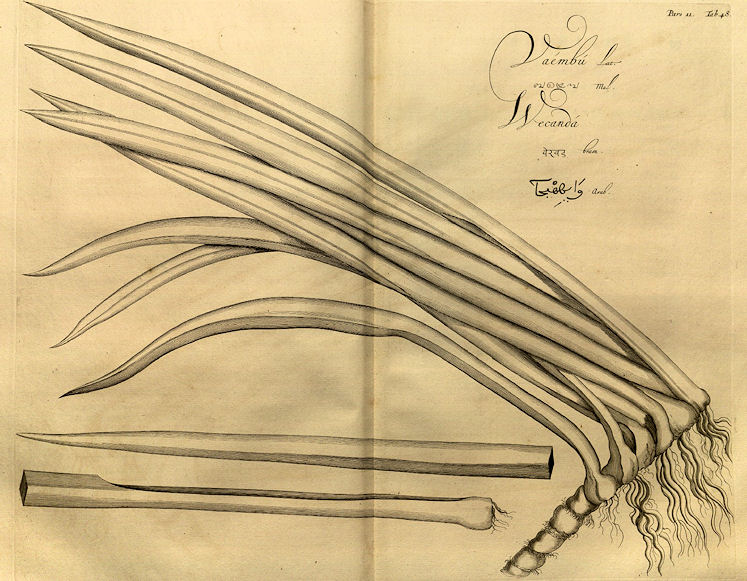
Abb.: वचा । Acorus calamus L. - Kalmus - Calamus
[Bildquelle: Hortus malabaricus XI. Fig. 48, 1692]
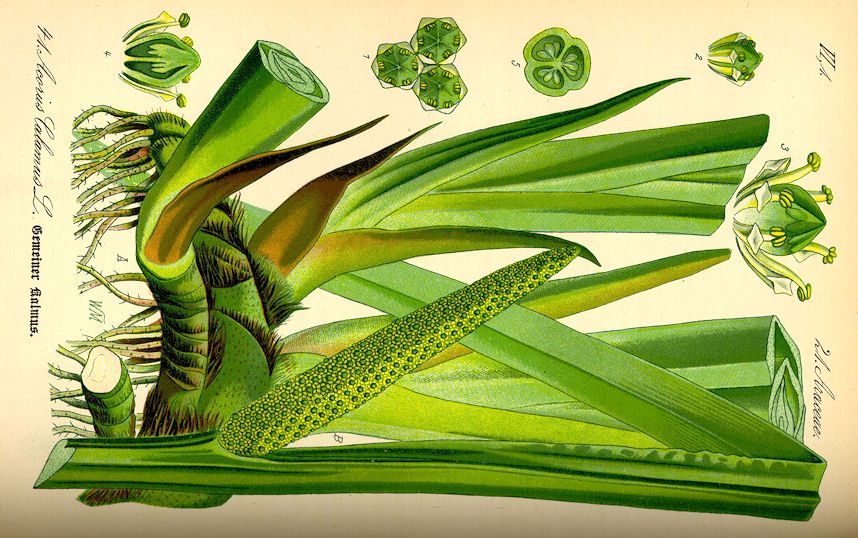
Abb.: गोलोमी । Acorus calamus L. - Kalmus - Calamus
[Bildquelle: Thomé 1885 / Wikimedia. -- Public domain]
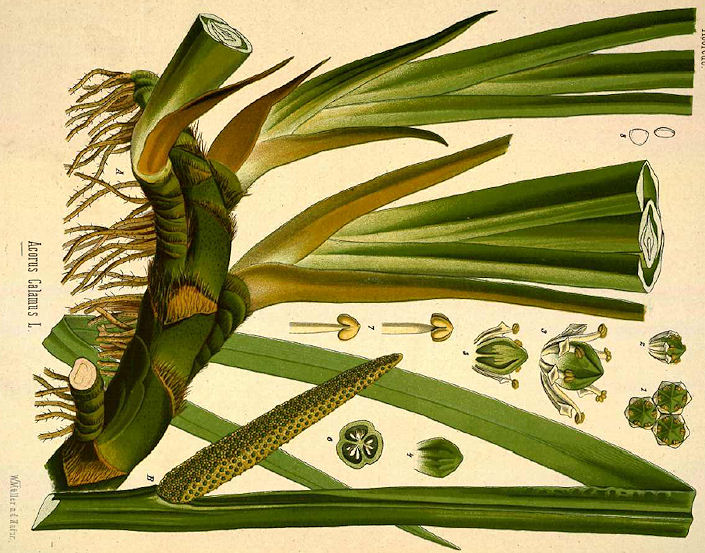
Abb.: शतपर्विका । Acorus calamus L. - Kalmus -
Calamus
[Bildquelle: Köhler, 1883-1914]
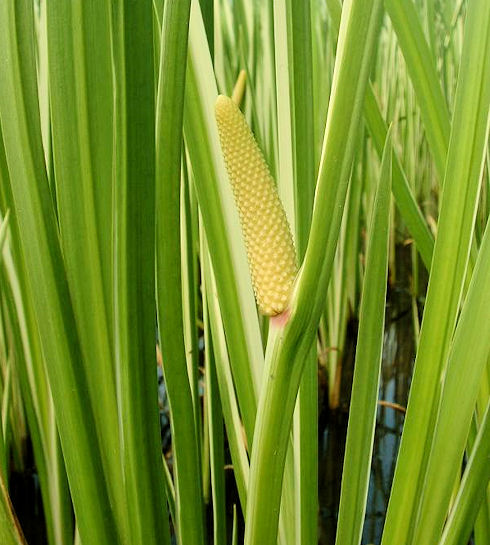
Abb.: शुक्ला । Acorus
calamus L. - Kalmus - Calamus, Frankreich
[Bildquelle: J. F. Gaffard / Wikimedia. -- GNU FDLicense]
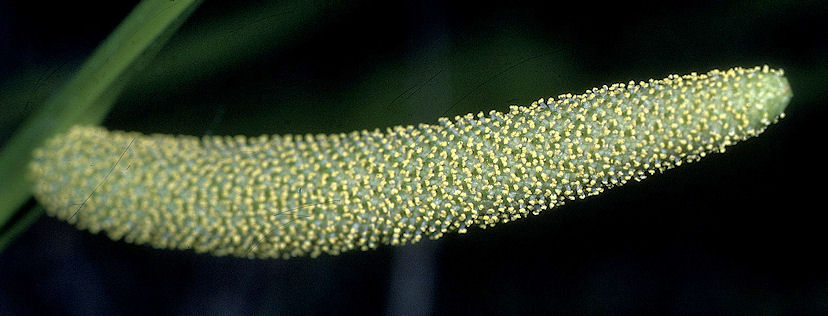
Abb.: उग्रगन्धा ।
Acorus calamus L. - Kalmus - Calamus
[Bildquelle: USDA-NRCS / Wikimedia. -- Public domain]
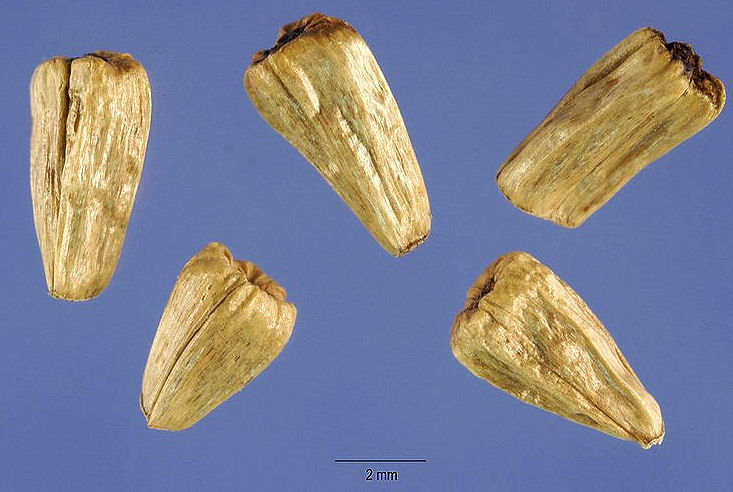
Abb.: Samen von Acorus
calamus L. - Kalmus - Calamus
[Bildquelle: USDA-NRCS / Wikimedia. -- Public domain]
"Acorus calamus. Willd. 2. 199.
[...]
Vaembu, Rheed. Mal. 11. t. 48.
Sans. Vucha.
Sweet flag, or Calamus aromaticus. Mat. Med,
It is common in gardens throughout India."
[Quelle: Roxburgh, William <1751-1815>: Flora indica, or, Descriptions of Indian plants / by the late William Roxburgh. -- Serampore : Printed for W. Thacker, 1832. -- Vol. 2, S. 169.]
"Acorus calamus (Linn.) N. O. Orontiaceae. Sweet-flag, [...]
Description. — Perennial, semi-aquatic; [...]
Fl. May—June.
Roxb. Flor. Ind. ii. 169.
A. odoratus, Lam.—Rheede, xi. t. 60.
Damp marshy places. Malabar.
Medical Uses. — An aromatic bitter principle exists in the rhizomes, for which reason they are regarded as useful additions to tonic and purgative medicines, being much given to children in cases of dyspepsia, especially when attended with looseness of bowels. Beneficially employed also in chronic catarrh and asthmatic complaints. Dr Pereira has remarked that the rhizomes might be substituted for more expensive spices or aromatics. The flavour is greatly improved by drying. In Constantinople they are made into a confection, which is considered a good stomachic, and is eaten freely during the prevalence of epidemic disease. They are supposed, moreover, to be antidote for several poisons.—(Pereira. Thomson. Ainslie.) In low fevers they are considered an excellent stimulant diaphoretic, and also very serviceable in atonic and choleraic diarrhoea, and as a useful external application in chronic rheumatism, the powdered rhizome being rubbed up with Cashew spirit Dr A. T. Thomson notices the root-stock favourably as an antiperiodic, and Dr Royle employed it successfully in intermittent fevers. It is also highly useful for destroying and keeping away insects.—Pharm. of India.
Economic Uses.—The leaves contain an essential oil, to which they owe their fragrance, and which in England is used by the perfumers, mixed with the farina of the rhizomes, in the manufacture of hair-powders. They are also used for tanning leather and perfuming various substances.—Ainslie."
[Quelle: Drury, Heber <1819 - 1872>: The useful plants of India : with notices of their chief value in commerce, medicine, and the arts. -- 2d ed. with additions and corrections. London : Allen, 1873. -- xvi, 512 p. ; 22 cm. -- s.v.]
"ACORUS CALAMUS, Linn.
Fig.—Bentl. and Trim., t. 279; Rheede, Hort. Mal. xi., t. 48.
Sweet-Flag
Hab.—Central Asia. Cultivated throughout India.
[...]
History, Uses, &c.—This plant bears the Sanskrit names of Vacha " talking," Shadgrantha " six-knotted," Ugragandha "strong smelling," Jatila "having entangled hair," &c., and is described in the Nighantas as hot, pungent, bitter, stomachic and emetic; useful for clearing the voice by removing phlegm, and in colic. As an emetic it is administered in doses of about 80 grains with half a ser of tepid salt water; in dyspepsia it is given in combination with asafoetida, long pepper, black pepper, ginger, chebulic myrobalans, sonchal salt, and the tubers of Aconitum heterophyllum, of all equal parts, in doses of half a drachm. As a stimulant or nervine it is used in combination with other remedies in low fevers, epilepsy, and insanity. The authors of the Pharmacographia remark—"The descriptions of Acoron, a plant of Colchis, Galatia, Pontus, and Crete, given by Dioscorides and Pliny, certainly refer to this drug." The Arabian physicians also agree in identifying it with the Acoron of the Greeks, a name probably derived from the Persian Agar. Ibn Sina describes the drug under the name of Waj, and quotes Galen with regard to its properties, and all the Arabian and Persian physicians reproduce what Dioscorides has written concerning ακορον. That this plant is not the Calamus aromaticus of the ancients appears to be evident, as Pliny describes both Acoron and Calamus aromaticus. The Arabians also do not identify the plant with Calamus aromaticus, but describe the latter under the name of Kasab-ed-darira and identify it with Swertia Chirata. Haja Zein states that in his time (1368) Kasab-ed-darira came from Calicut, where it was called by the natives Baringa; if this statement is correct, the drug used by him must have been either Premna herbacea or serratum, the Bharinga of the Hindus. Royle supposes Calamus aromaticus to have been an Andropogon. Mahometan writers describe it as deobstruent and depurative, useful for the expulsion of the phlegmatic humours, which they suppose to be the cause of paralysis, dropsy, and many other diseases; they recommend it to be given to children to bite when teething, and prescribe it in calculous affections. It has also a reputation as a diuretic, emmenagogue, and aphrodisiac, and is applied in the form of poultice to paralysed limbs and rheumatic swellings. A pessary composed of Acorus, saffron, and mare's milk is used to promote delivery; a hip bath of the decoction is also said to be efficient for this purpose. Dr. Ondaatji, Colonial Surgeon of Ceylon, has brought to notice the use of sweet-flag as an anthelmintic in that island. He says: "An infusion of the rhizome given to young children acts effectually, as I have Been many such cases treated among the natives." Dr. Evers at the Seoni Main Dispensary has found the drug very effectual in dysentery. He uses the following decoction:—Bruised rhizome 2 ozs., Coriander 1 dr., Black pepper 1/2 dr., Water one pint. Boil down to 12 ounces, and let cool. Dose for an adult 1 ounce three times a day ; for a child 1 to 3 drachms, sweetened with sugar, two or three times a day. He also remarks:—"The decoction is not only useful in dysentery and diarrhoea, but also in the bronchitic affections of children." I have often taken it myself when suffering from a bad cold in the chest. (Ind. Med. Gazette, Feb. 1875.)
The evidence collected by Dr. Watt for Dict. Econ. Prod. of India testifies to the value of Acorus as an aromatic bitter and stimulant, especially useful in allaying distressing cough."
[Quelle: Pharmacographia indica : a history of the principal drugs of vegetable origin met with in British India / by William Dymock [1834-1892], C. J. H. Warden and David Hooper [1858-1947]. -- Bd. 3. -- London, 1893. -- S. 539f.]
Iris pseudacorus L. 1753 - Sumpfschwertlilie
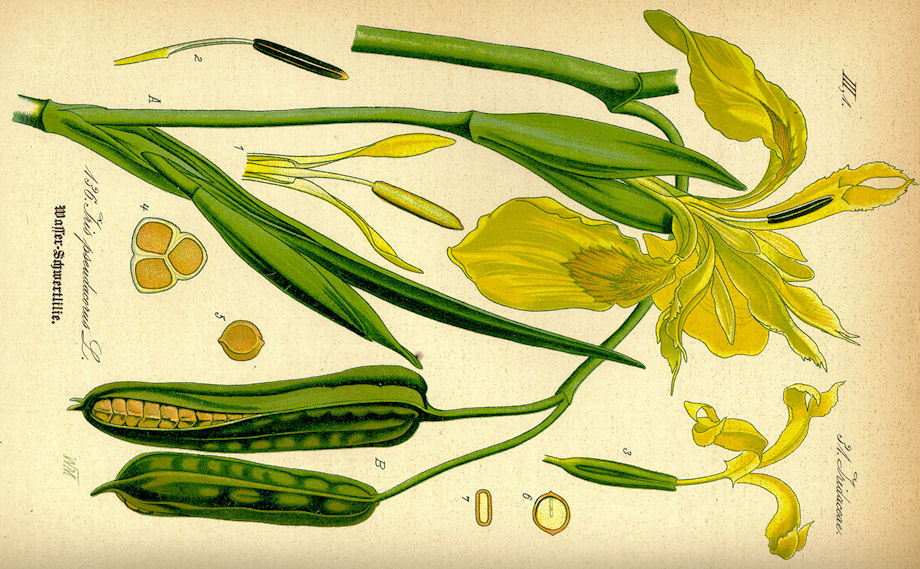
Abb.: Iris pseudacorus
L. 1753 - Sumpfschwertlilie
[Bildquelle: Thomé 1895 / Wikimedia. -- Public domain]
Acanthaceae (Akanthusgewächse)
Großer (bis 3 m hoher) Strauch oder kleiner Baum
| 21. c./d. śuklā
haimavatī vaidhyamātṛ-siṃhyau tu vāśikā 22. a./b. vṛṣo 'ṭarūṣaḥ siṃhāsyo vāsako vājidantakaḥ
शुक्ला हैमवती
वैद्यमातृ-सिंह्यौ तु वासिका ॥२१ ख॥ [Bezeichnungen für Justicia adhatoda L. 1753 - Indisches Lungenkraut:]
|
Colebrooke (1807): "Justicia. Justicia adhatoda & ganderussa [sic!, richtig gendarussa Burm. f.]."
Justicia adhatoda L. 1753 - Indisches Lungenkraut
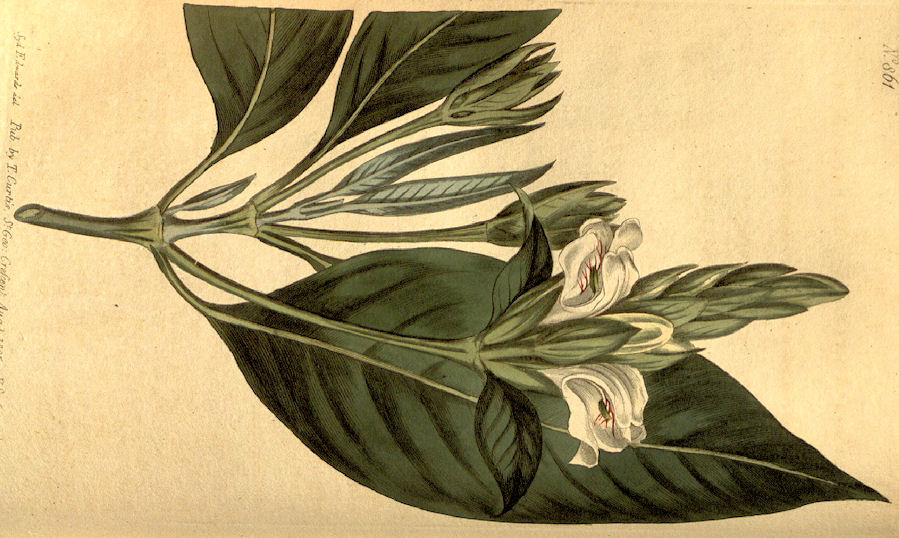
Abb.: सिंही । Justicia adhatoda L. 1753 -
Indisches Lungenkraut
[Bildquelle: Curtis's Botanical Magazine, v. 22 (1805), Tab. 861]
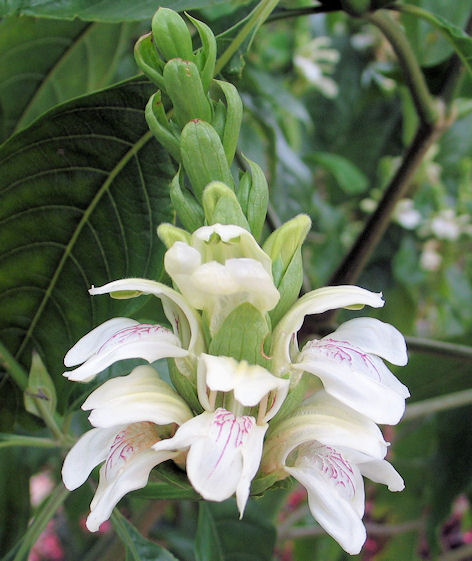
Abb.: सिंहास्यः । Justicia adhatoda L.
1753 - Indisches Lungenkraut
[Bildquelle: ShineB / Wikimedia. -- GNU FDLicense]
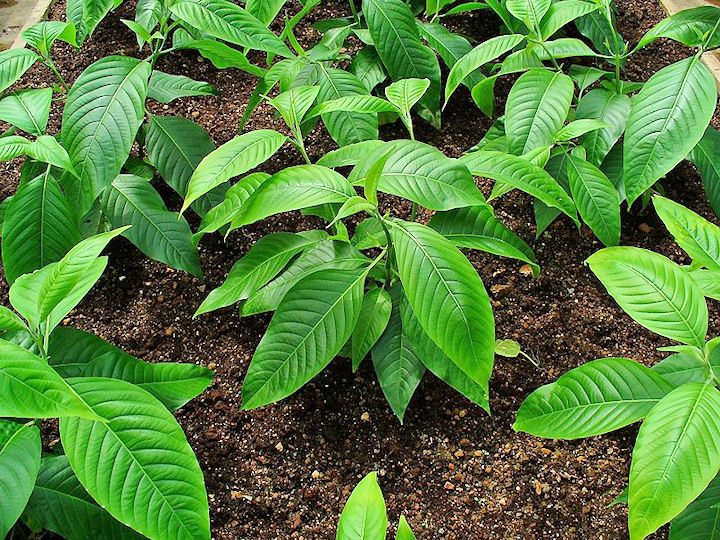
Abb.: अटरूषः । Justicia adhatoda L. 1753
- Indisches Lungenkraut
[Bildquelle: H. Zell / Wikimedia. -- GNU FDLicense]
"Justicia Adhatoda. Willd. 1. 98.
Sub-arboreous. [...]
Sans. Vidyumatri, Singhee, Vasika, Vrisha, Uturoosha, Singhashya, Vasooka, Vajiduntuka.
This small tree or large shrub, is common over most parts of India. Flowering- time the cold season.
[...]
Obs. The wood is soft, and esteemed very fit for making charcoal for gun-powder."
[Quelle: Roxburgh, William <1751-1815>: Flora indica, or, Descriptions of Indian plants / by the late William Roxburgh. -- Serampore : Printed for W. Thacker, 1832. -- Vol. 1, S. 126f.]
"Adhatoda Vasica (Nees). Malabar nut [...]
Description.—Shrub, 8-10 feet; [...] flower whitish, spotted, sulphur-coloured at the throat, and at the limb with dark purple lines.
Fl. Feb. —April.
Justicia Adhatoda, Linn.—Roxb. Fl. Ind. i. 126.
Peninsula Bengal. Nepaul.
Medical Uses.—The juice of the leaves is given in a dose of two drams with one dram of the juice of fresh ginger as an expectorant in coughs, asthma, and ague. They are bitterish and subaromatic, and are administered in infusion and electuary.—(Journ. Agri. Hort. Soc. of India, x. 28.- Ainslie). The leaves, flowers, and root, especially the flowers, are considered antispasmodic, and are given in cases of asthma and intermittent fever. They have also been successfully employed in chronic bronchitis, and other pulmonary and catarrhal affections when not attended with fever.—(Pharm. of India. Ind. Annals of Med. Science, x. 156.) The leaves are given to cattle as medicine, and to man for rheumatism. The fresh flowers are bound over the eyes in cases of ophthalmia—(Stewarts Punj. Plants.) The leaves are given in conjunction with other remedies by the native doctors internally in decoction, as anthelmintic.—Ainslie. Roxb."
[Quelle: Drury, Heber <1819 - 1872>: The useful plants of India : with notices of their chief value in commerce, medicine, and the arts. -- 2d ed. with additions and corrections. London : Allen, 1873. -- xvi, 512 p. ; 22 cm. -- s.v.]
"Adhatoda Tranquebariensis (Nees). N. O. Acanthaceae.
[...]
Description.—Fruticulose, hoary-pubescent; [...] flowers axillary, solitary, ascending on a terminal spike, yellowish, purple-dotted.
Fl. Feb.—March.
Dec. Prod. xi, 399.
Gendarussa Tranquebariensis, Nees ap. Wall. Pl. As. Rar. iii. 105.
Justicia Tranquebariensis, Linn.
J. parvifolia, Lam.—Wight Icon. t. 462.
Eastern coasts of Peninsula.
Medical Uses.—The juice of the leaves is reckoned cooling and aperient, and is given to children in small-pox. The bruised leaves are applied to blows and other external injuries.—Ainslie."
[Quelle: Drury, Heber <1819 - 1872>: The useful plants of India : with notices of their chief value in commerce, medicine, and the arts. -- 2d ed. with additions and corrections. London : Allen, 1873. -- xvi, 512 p. ; 22 cm. -- s.v.]
"ADHATODA VASICA, Nees.
Fig.—Lam. III., t 12, f. 1; Bot. Mag., t. 861; Griff. Ic. Pl. As., t. 424; Rheede Hort. Mal. ix., t. 43.
Malabar nut tree
Hab.—India, from the Punjab and Assam to Ceylon.
[...]
History, Uses, &C—This shrub has a considerable reputation all over India as an expectorant and antispasmodic, and is largely prescribed in consumption and other chest affections attended with cough and hectic fever. Sanskrit writers call it Vasaka, Vansa, Vrisha, Sinha-mukhi " lion-mouthed" Sinha-parni "lion-leaved," and Atarūsha, Atarusha or Atarushaka, and direct the fresh juice of the leaves to be given in doses of one tola (180 grs.), with the addition of honey and long pepper, in cough. Dutt, in his Hindu Materia Medica, gives several compound preparations of the drug extracted from Sarangadhara and the Bhavaprakasa, and remarks that there is a saying that no man suffering from phthisis need despair as long as the Vasaka plant exists. In the Nighantas it is described as removing phlegm, bile, and impurities of the blood, a remedy for asthma, cough, fever, vomiting, gonorrhoea, leprosy, and phthisis. Persian writers upon Indian Materia Medica notice the plant under its Hindustani name of Arusa. The author of the Makhzan-el-Adiviya describes it correctly, and says that the wood is used to make toothpicks and gunpowder. Medicinally the flowers are useful in hectic, heat of blood, and gonorrhoea, the root in cough, asthma, febrile disturbances, and gonorrhoea; the fruit is sometimes hung round the necks of children to keep them from catching cold. Ainslie states that "In Ceylon, the Malabar nut tree is said to grow to the height of fourteen or fifteen feet, and is there called Wanapala. The flowers, leaves, and root, but especially the first, are supposed to possess antispasmotic qualities; and are prescribed in certain cases of asthma, and to prevent the return of rigor in intermittent fever; they are bitterish and sub-aromatic, and are administered in infusion and electuary. In the last mentioned form the flowers are given to the quantity of about a teaspoonful twice daily." (Mat. Ind., II., p. 3.) Roxburgh remarks that the wood is well fitted for making charcoal for gunpowder.
Strong testimony in favour of the remedial properties of the drug was furnished to the authors of the Pharmacopoeia of India by Drs. Jackson and Dutt, who employed it with marked success in chronic bronchitis, asthma, and other pulmonary and catarrhal affections. Cases illustrative of its effects in catarrh, bronchitis, and phtisis have been published by Mr. O. C. Dutt. (Indian Annals of Med. Sci., 1865, Vol. X., p. 156.)
In Bengal the leaves are smoked in asthma; good evidence of their value when thus used has been collected by Dr. G. Watt in the "Dict. of the Economic Products of India." Dr. Watt has also brought to notice the use of Adhatoda leaves in rice cultivation in the Sutlej Valley. The fresh leaves are scattered over recently flooded fields prepared for the rice crop, and the native cultivators say that they not only act as a manure, but also as a poison to kill the aquatic weeds that otherwise would injure the rice. Experiments conducted by us show that the infusion acts upon the cells of these plants in the same manner as certain chemical reagents, by contracting their contents and causing their disintegration; it also proves poisonous to any animalcules, frogs, leeches, &c, present in the water; on the higher animals the leaves do not have this effect.
Description.—A small tree or large shrub, flowering in the cold season ;"
[Quelle: Pharmacographia indica : a history of the principal drugs of vegetable origin met with in British India / by William Dymock [1834-1892], C. J. H. Warden and David Hooper [1858-1947]. -- Bd. 3. -- London, 1893. -- S. 50f.]
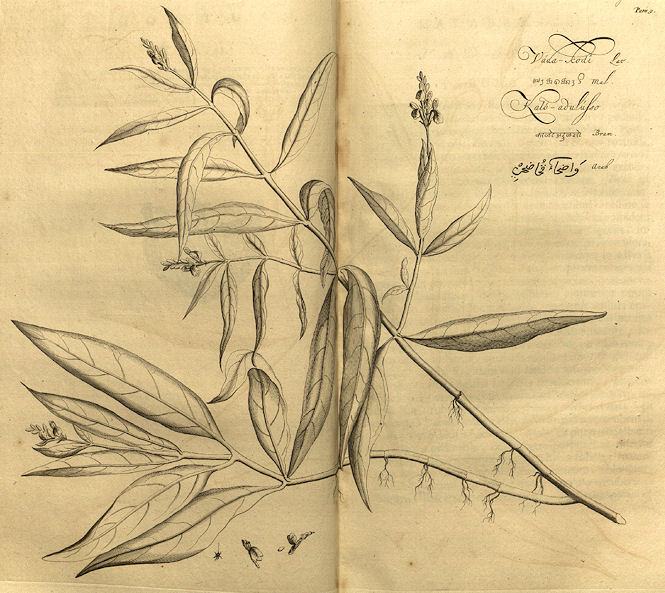
Abb.: Justicia gendarussa Burm. f.
[Bildquelle: Hortus malabaricus IX. Fig. 42, 1689]
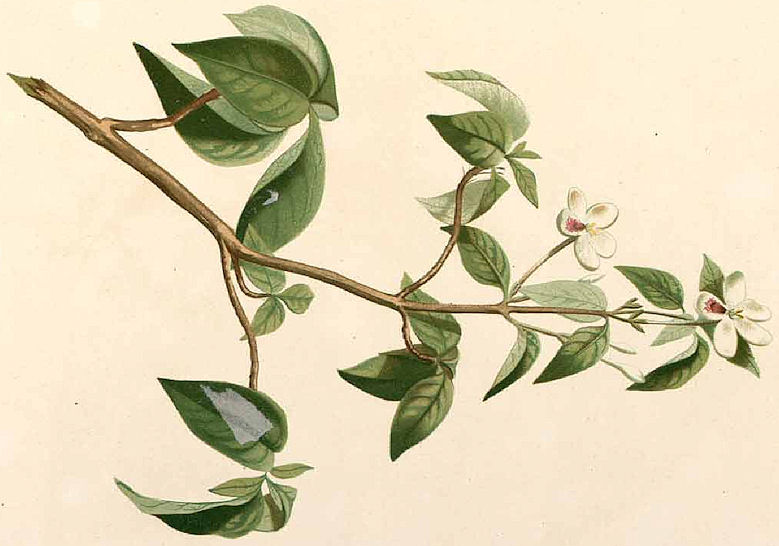
Abb.: Justicia
gendarussa Burm. f.
[Bildquelle: Flora de Filipinas, 1880 / Wikipedia. -- Public domain]
"Justicia Gendarussa. Linn. sp. pl. ed. Willd. 1. 87.
Shrubby, [...]
Vada-Kodi. Rheed. MaL. 9. p. 79. t. 42.
Gendarussa. Rumph. Amb. A. p. 70. t. 28.
A handsome shrub. I have never met with it wild, but in gardens it is common, and stows readily from slips and cuttings ; it is in flower during the wet season chiefly. I am told it is indigenous on the Malay Islands."
[Quelle: Roxburgh, William <1751-1815>: Flora indica, or, Descriptions of Indian plants / by the late William Roxburgh. -- Serampore : Printed for W. Thacker, 1832. -- Vol. 2, S. 128.]
"Justicia Gendarussa, Linn., f., is the Vedakodi of Rheede (Hort. Mai. ix., t. 42), who says that the juice with mustard is used as an emetic in asthma, and a bath of the leaves in rheumatism. According to Louvet, it is emetic and very efficient in the colic of children. In Reunion it is called " Guerit petit colique."
Description.—In gardens it is usually seen in a stunted form, as it is kept closely cut;"
[Quelle: Pharmacographia indica : a history of the principal drugs of vegetable origin met with in British India / by William Dymock [1834-1892], C. J. H. Warden and David Hooper [1858-1947]. -- Bd. 3. -- London, 1893. -- S. 48.]
Fabaceae (Hülsenfrüchtler)
Kletterranke
| 22. c./d. āsphoṭā girikarṇī syād viṣṇukrāntāparājitā आस्फोटा गिरिकर्णी स्यद् विष्णुक्रान्तापराजिता ॥२२ ख॥ [Bezeichnungen für Clitoria ternatea L. 1753 - Blaue Schamblume - Butterfly Pea:]
|
Colebrooke (1807): "Clitoria. Clitoria ternatea."
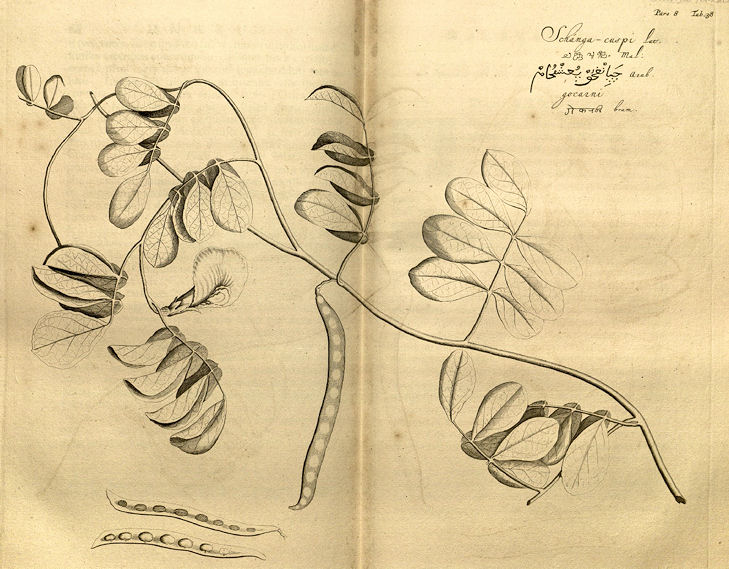
Abb.: अपराजिता । Clitoria ternatea L. 1753 -
Blaue Schamblume - Butterfly Pea
[Bildquelle: Hortus malabaricus VIII. Fig. 38, 1688]
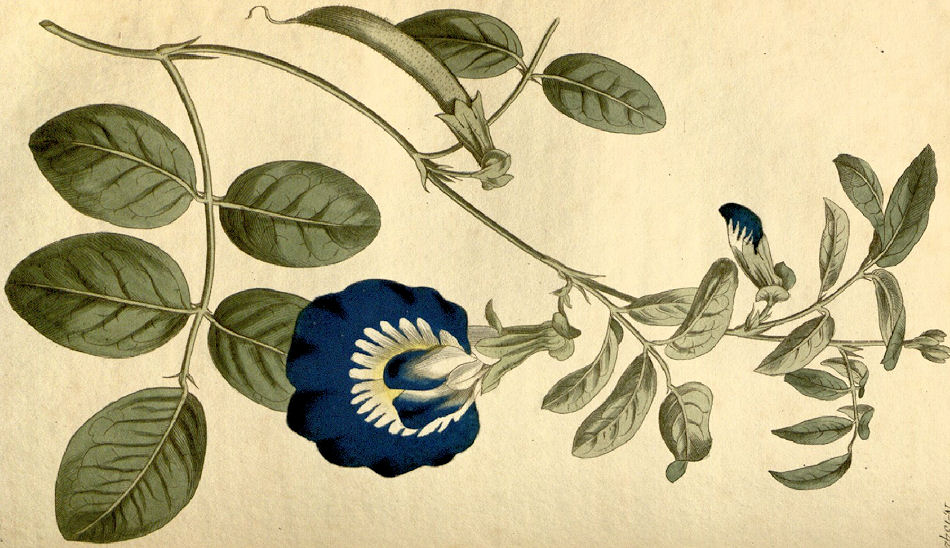
Abb.: अपराजिता । Clitoria ternatea L. 1753 -
Blaue Schamblume - Butterfly Pea
[Bildquelle: Curtis's Botanical Magazine, v. 37 (1813), Tab. 1542]
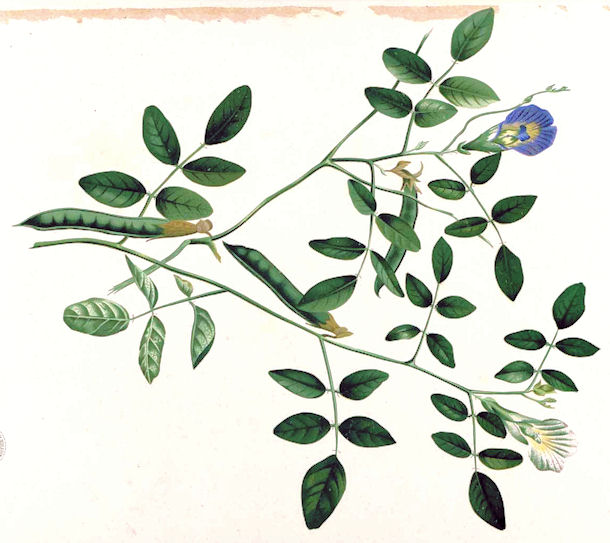
Abb.:
गिरिकर्णी । Clitoria ternatea L.
1753 - Blaue Schamblume - Butterfly Pea
[Bildquelle. Flora de Filipinas 1880 / Wikimedia. -- Public domain]
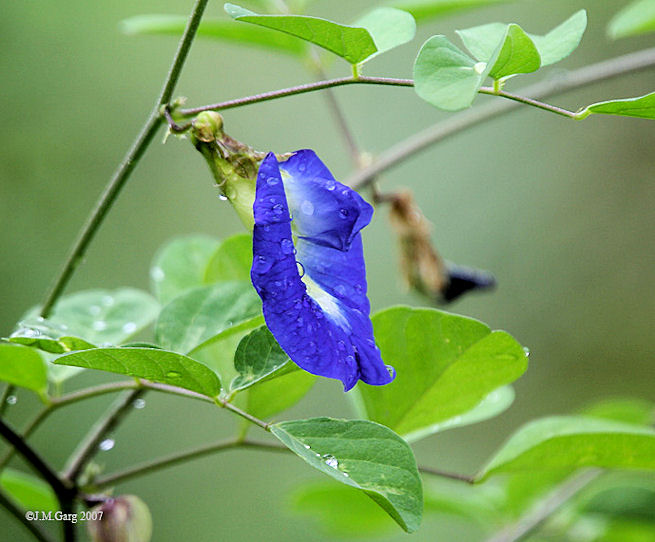
Abb.: विष्णुक्रान्ता ।
Clitoria ternatea L. 1753 - Blaue Schamblume - Butterfly Pea, Kolkata -
কলকাতা, West
Bengal
[Bildquelle: J. M. Garg / Wikipedia. --
GNU FDLicense]
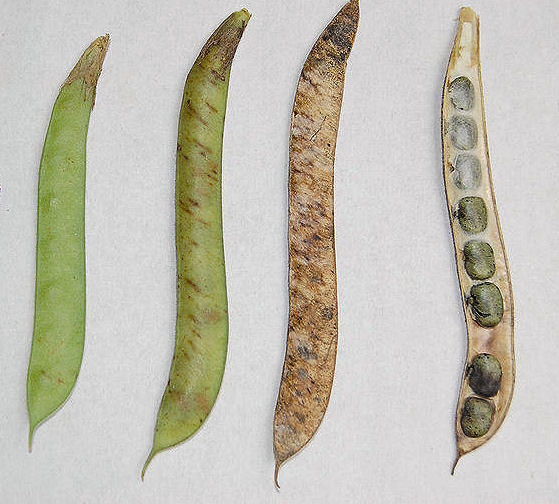
Abb.: आस्फोटा ।
Clitoria ternatea L. 1753 - Blaue Schamblume - Butterfly Pea
[Bildquelle: Tux the penguin / Wikimedia. -- GNU FDLicense]
"Clitoria Ternatea. Willd. iii. 1068.
Shrubby, twining. [...]
Sans. Asphota, Uparajita.
Flos coeruleus. Rumph. Amb. v. f. 31.
Schanga cuspi. Rheed. Mai. viii. t. 38.
Common in every hedge all over India, and in flower the greater part of the year. Its root probably is not inferior to jalap as a cathartic ; the powdered seed is also purgative."
[Quelle: Roxburgh, William <1751-1815>: Flora indica, or, Descriptions of Indian plants / by the late William Roxburgh. -- Serampore : Printed for W. Thacker, 1832. -- Vol. 3, S. 321.]
"Clitorea Ternatea (Linn.) N. O. Leguminosae. [...]
Description.—Climbing herbaceous plant; [...] flowers white or blue.
Fl. All the year.
W. & A. Prod. i. 205.—Roxb. Fl. Ind. iii. 321. —Rheede, viii t. 38.
Common in the Peninsula.
Medical Uses.—The powdered seeds are a useful purgative.* The root is used in croup : it sickens and occasions vomiting. It is also given as a laxative to children, and is also diuretic. Of the two varieties, that with the white flowers is said to be the best. Dr O'Shaughnessy states that he repeatedly tried the root in order to ascertain the truth of its alleged emetic effects, but the results were not satisfactory, and he could not recommend its use.—Roxb. Beng. Disp.
*In combination with cream of tartar, this forms a safe and efficient laxative. The alcoholic extract is also a useful preparation. The cost is trifling, as the seeds are easily procurable."
[Quelle: Drury, Heber <1819 - 1872>: The useful plants of India : with notices of their chief value in commerce, medicine, and the arts. -- 2d ed. with additions and corrections. London : Allen, 1873. -- xvi, 512 p. ; 22 cm. -- s.v.]
Acanthaceae (Akanthusgewächse)
Einjähriges Kraut
| 23. a./b. ikṣugandhā tu
kāṇḍekṣu-kokilākṣekṣurakṣurāḥ इक्षुगन्धा तु काण्डेक्षु-कोकिलाक्षेक्षुरक्षुराः ।२३ क। [Bezeichnungen für Hygrophila schulli M. R. Almeida & S. M. Almeida 1987:]
|
Colebrooke (1807): "Barleria. Barleria longifolia [L. 1756 = Hygrophila schulli M. R. Almeida & S. M. Almeida 1987] : but applied also to Capparis spinosa [L. 1753 - Kapernstrauch - Caper Plant]."
1 कोकिलाक्ष - kokilākṣa m.: Koelauge (kokila m.: Eudynamys scolopaceus L. 1758 - Koel oder Cuculus canorus L. 1758 - Kuckuck)
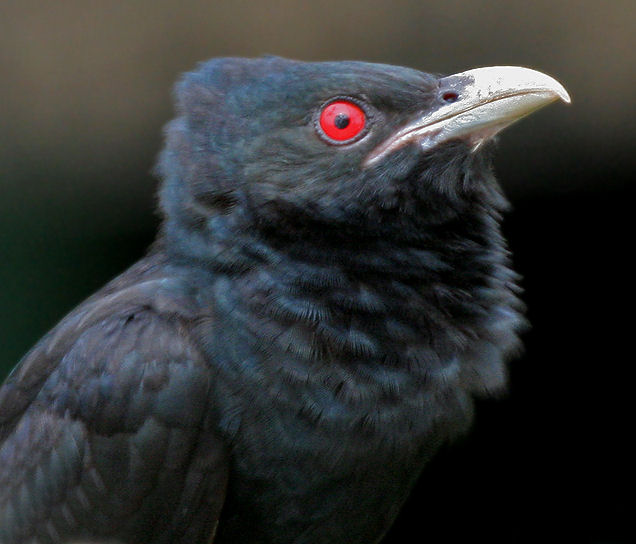
Abb.: Eudynamys
scolopaceus L. 1758 - Koel, Kolkata -
কলকাতা,
West Bengal
[Bildquelle: J. M. Garg / Wikimedia commons. -- GNU FDLicense]
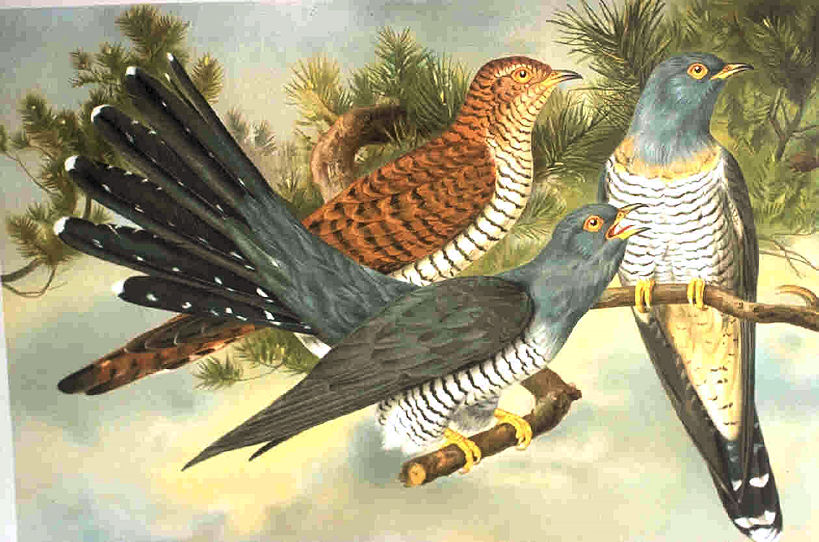
Abb.: Cuculus canorus
L. 1758 - Kuckuck
[Bildquelle: Naumann 1897-1905 / Wikipedia. -- Public domain]
Hygrophila schulli M. R. Almeida & S. M. Almeida 1987
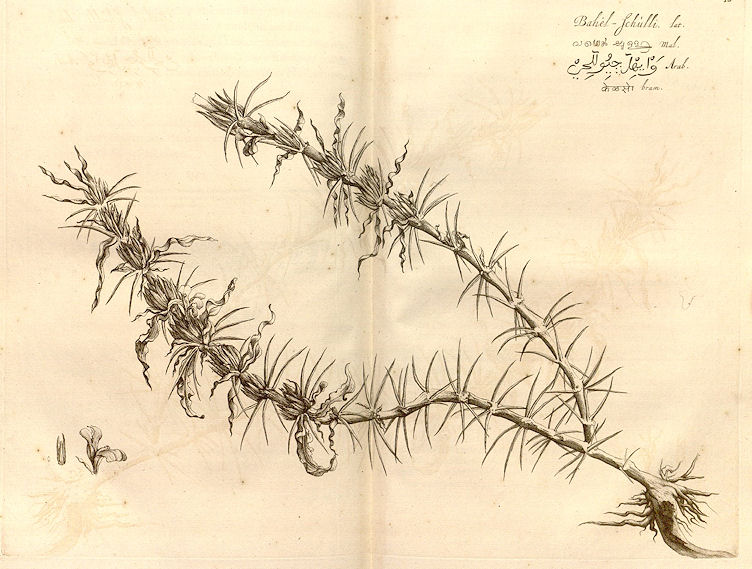
Abb.: क्षुरः ।
Hygrophila schulli M. R. Almeida & S. M. Almeida 1987
[Bildquelle: Hortus malabaricus II. Fig. 45, 1679]
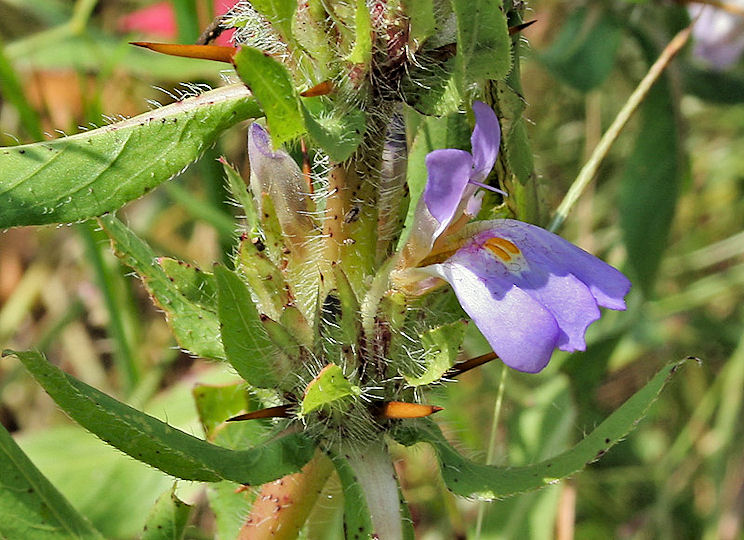
Abb.: इक्षुगन्धा ।
Hygrophila schulli M. R. Almeida & S. M. Almeida 1987, Narsapur -
నరసాపురం, Andhra Pradesh
[Bildquelle: J. M. Garg / Wikipedia. --
GNU FDLicense]
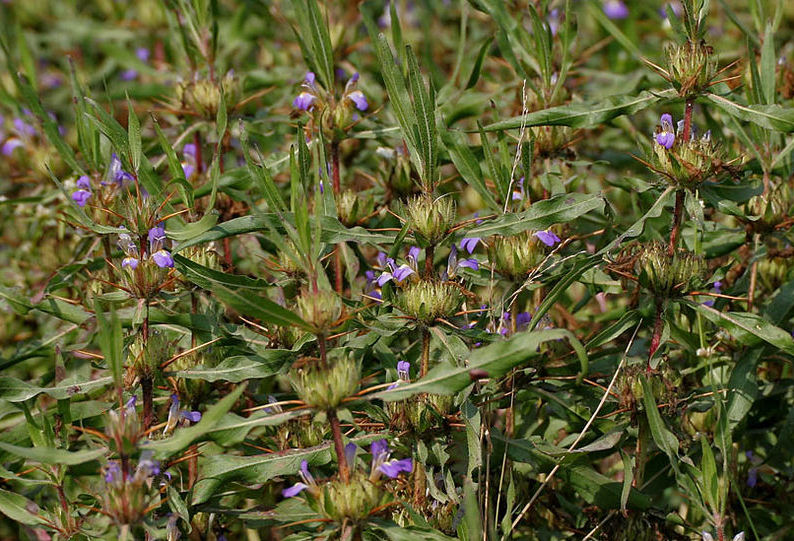
Abb.: कोकिलाक्षः ।
Hygrophila schulli M. R. Almeida & S. M. Almeida 1987, Hyderabad -
హైదరాబాద్ -
حیدرآباد, Andhra Pradesh
[Bildquelle: J. M. Garg / Wikipedia. --
GNU FDLicense]
"Ruellia longifolia, Roxb.
Herbaceous. [...9
Gecantaca, its Sanscrit name. See Asiat, Res, v. p. 291.
Barleria longifolia. Linn, sp. pl. ed. Willd. iii. 375.
Bahel-schulli. Rheed. Mal. ii. t. 45.
Is common in low wet places all over India. Flowering time, the cold season."
[Quelle: Roxburgh, William <1751-1815>: Flora indica, or, Descriptions of Indian plants / by the late William Roxburgh. -- Serampore : Printed for W. Thacker, 1832. -- Vol. 3, S. 50.]
"Asteracantha longifolia (Nees). N. O. Acanthaceae.
[...]
Description.—Annual; [...] flowers in whorls, axillary, blue or bright violet; [...]
Fl. July—Dec.
Wight Icon. t. 449.
Barleria longifolia, Linn.
Ruellia longifolia, Roxb. Fl. Ind. iii. 50.—Rheede, ii. t. 45. Malabar. Bengal
Medical .Uses.—This plant may commonly be met with by the side of paddy-fields and other damp situations. The roots are considered tonic and diuretic, administered in decoction. They are also employed in dropsical affections and gravel. The leaves boiled in vinegar are reckoned diuretic.—Ainsl. Pharm. of India."
[Quelle: Drury, Heber <1819 - 1872>: The useful plants of India : with notices of their chief value in commerce, medicine, and the arts. -- 2d ed. with additions and corrections. London : Allen, 1873. -- xvi, 512 p. ; 22 cm. -- s.v.]
Abb.: Capparis spinosa L. 1753 - Kapernstrauch - Caper Plant
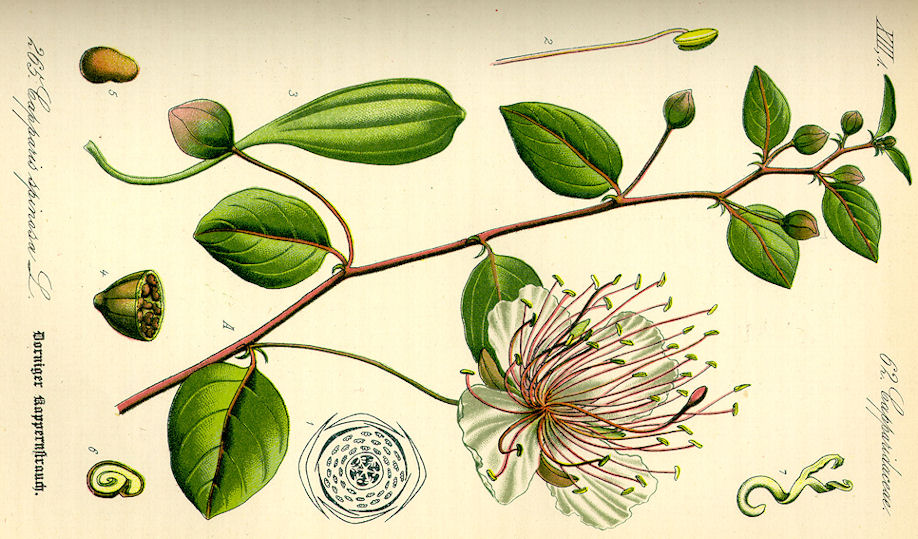
Abb.: Capparis
spinosa
L. 1753 - Kapernstrauch - Caper Plant
[Bildquelle: Thomé 1885 / Wikipedia. -- Public domain]
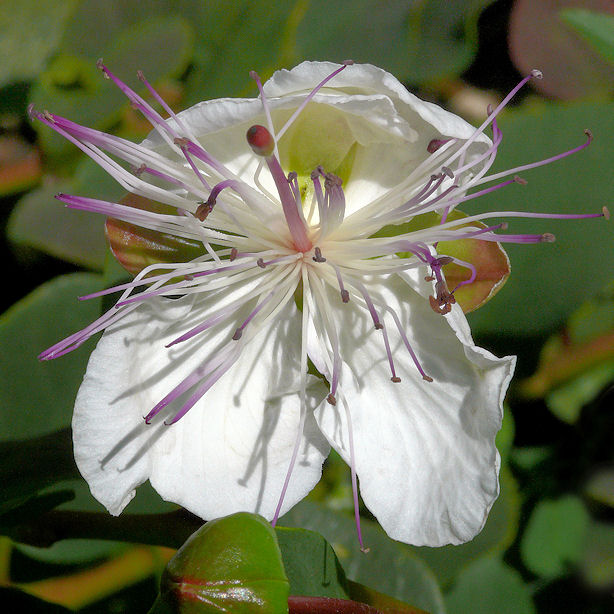
Abb.: Capparis spinosa L. 1753 - Kapernstrauch -
Caper Plant, Kalifornien
[Bildquelle:
James Gaither. --
http://www.flickr.com/photos/13892958@N07/3911537245. -- Zugriff am
2010-11-20. --
Creative Commons Lizenz (Namensnennung, keine kommerzielle Nutzung, keine
Bearbeitung)]
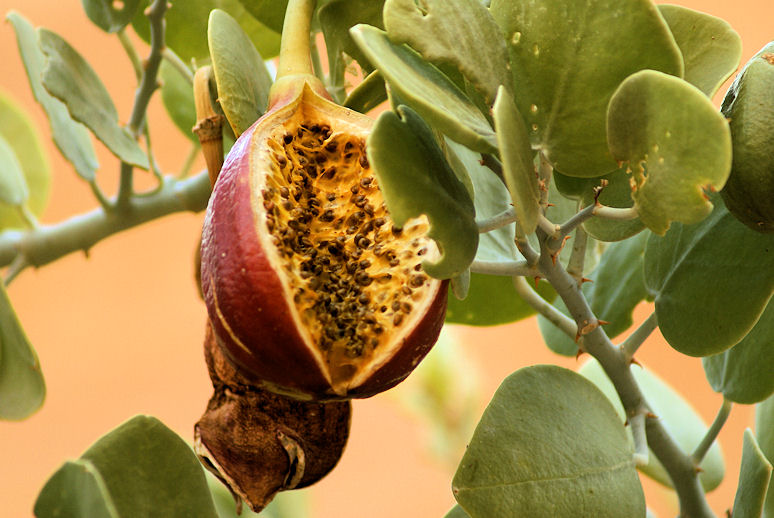
Abb.: Reife Frucht
von Capparis spinosa L. 1753 - Kapernstrauch - Caper Plant
[Bildquelle: Florian Prischl / Wikimedia Commons.
-- GNU FDLicense]
"CAPPARIS SPINOSA, Linn. Fig.— Var. 2, rupestris, Sibth., Flor. Graec, t. 487. Var. 3, vulgaris, Royle, Illus. 73 [sic!]. Var. 4, leucophyta, Deless. Ic. Sel. iii., t. 10.
Caper plant
Hab.—Europe, Asia, Africa, &c.[...]
History, Uses, &C—This plant is widely distributed, being found in Afghanistan, West Asia, Europe, North Africa, Australia, and the Sandwich Islands. The common Indian and Oriental form, Var. 3 of Hooker's Flora of British India grows on hilly ground in many parts of India. Caper bark does not appear to have been known as a medicine to the Hindus until introduced by the Mahometans, but the fruits of C. sepiaria, Linn. (Kakadani), and of C. aphylla, Roth (Karira), are mentioned by Sanskrit writers. Capparis is mentioned by both Greek and Latin writers, and its medicinal properties were probably made known to the Arabs through them. The Syrian name is Kabar and the Turkish Kabarish; in Persia it is called Kabar and Karak. The author of the Makhzan-el-Adwiya gives a good description of the plant, and says that the root bark is the most active part, and generally used. He considers it to be hot and dry, and to act as a detergent and astringent, expelling cold humors; it is therefore recommended in palsy, dropsy, and gouty and rheumatic affections; the juice of the fresh plant is directed to be dropped into the ear to kill worms, just as Cleome juice is used in India ; all parts of the plant are said to have a stimulating and astringent effect when applied externally. Ainslie mentions the drug as an imported article, and notices its use as an external application to malignant ulcers. The physiological action of Caper bark is very similar to that of Senega, and depends upon the presence in it of a principle similar to, if not identical with, saponin (see Saponaria Vaccaria). The fresh plant develops a volatile oil having the properties of garlic oil."
[Quelle: Pharmacographia indica : a history of the principal drugs of vegetable origin met with in British India / by William Dymock [1834-1892], C. J. H. Warden and David Hooper [1858-1947]. -- Bd. 1. -- London, 1890. -- S. 131f.]
Apiaceae (Doldenblütler)
Bis 2 m hohes Kraut
| 23. c./d. śāleyaḥ syāc chītaśivaśchatrā madhurikā
miśī 24. a./b. miśreyāpy atha sīhuṇḍo vajradruḥ snuk snuhī guḍā शालेयः स्याच् छीतशिवश् छत्रा मधुरिका मिशी ॥२३ ख॥ [Bezeichnungen für Foeniculum vulgare Mill. 1768 - Fenchel - Fennel:]
|
Colebrooke (1807): "Anethum. Anethum sowa [Roxb. ex Fleming = Anethum graveolens L. 1753 - Ackerdill] and pammorium, R[oxb. ex Fleming 1832 = Anethum graveolens var. hortorum Alef 1866 - Garten Dill]"
Foeniculum vulgare Mill. 1768 - Fenchel - Fennel
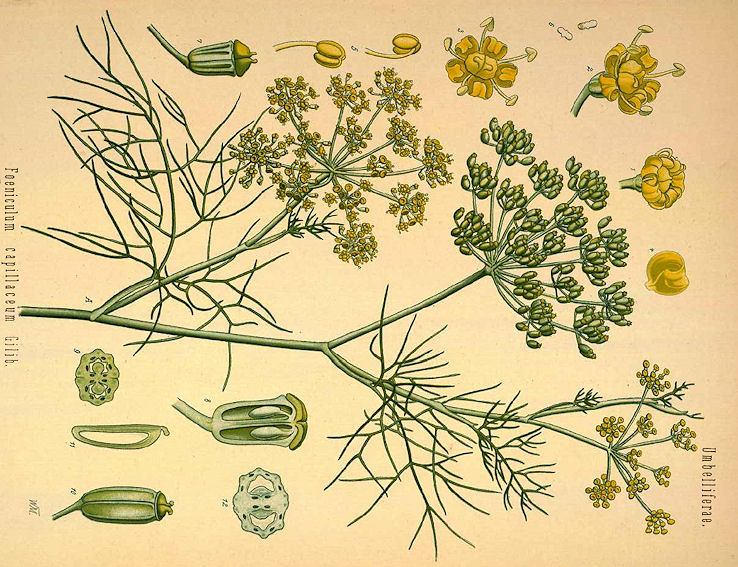
Abb.: मिशी । Foeniculum vulgare Mill. 1768 -
Fenchel - Fennel
[Bildquelle: Köhler, 1883-1914]
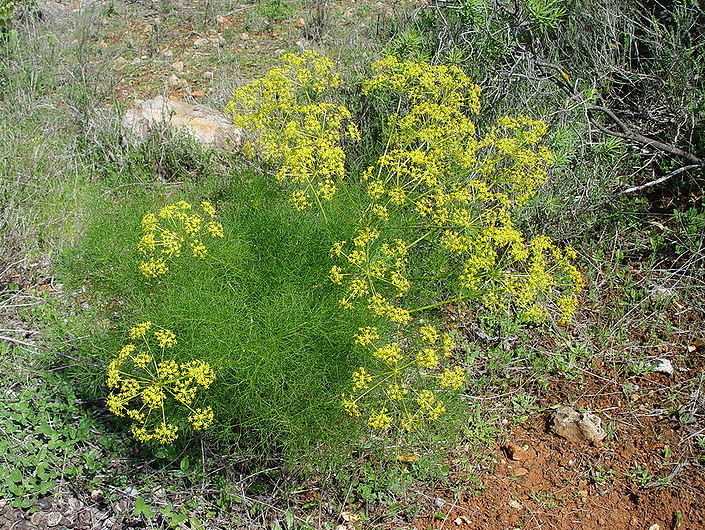
Abb.: छत्रा ।
Foeniculum vulgare Mill. 1768 - Fenchel - Fennel
[Bildquelle: Carsten Niehaus / Wikimedia. -- GNU FDLicense]
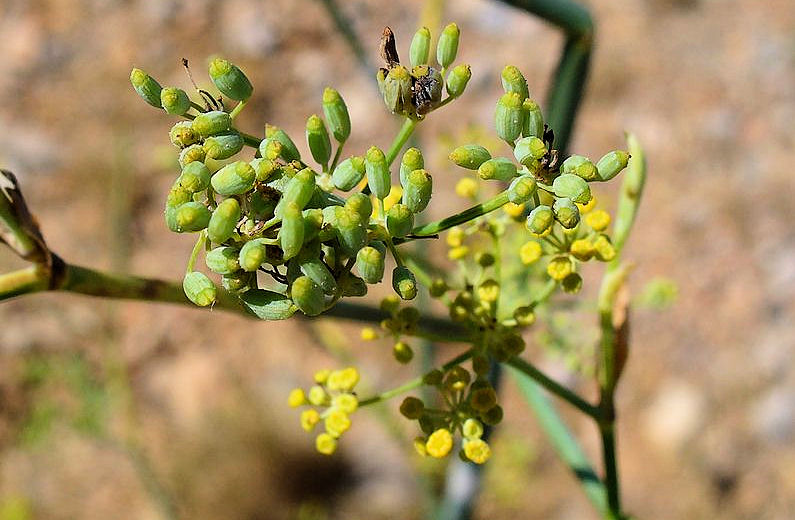
Abb.: मधुरिका ।
Foeniculum vulgare Mill. 1768 - Fenchel - Fennel
[Bildquelle: H. Zell / Wikimedia. -- GNU FDLicense]
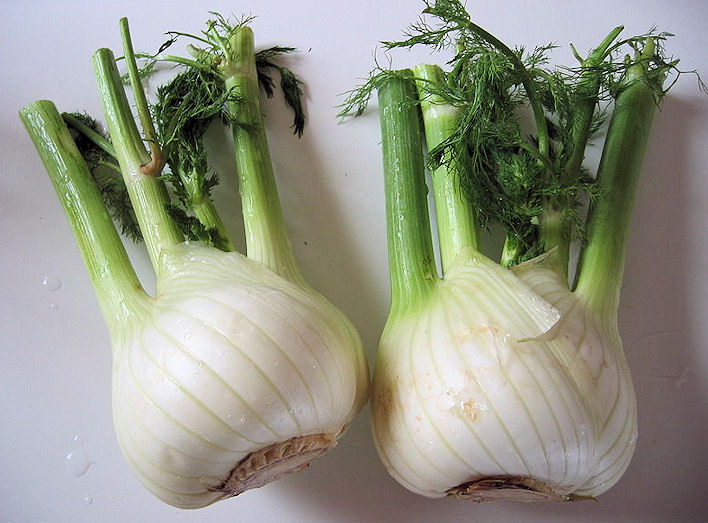
Abb.: Foeniculum
vulgare Mill. 1768 - Fenchel - Fennel
[Bildquelle: Arnaud 25 / Wikipedia. -- Public domain]
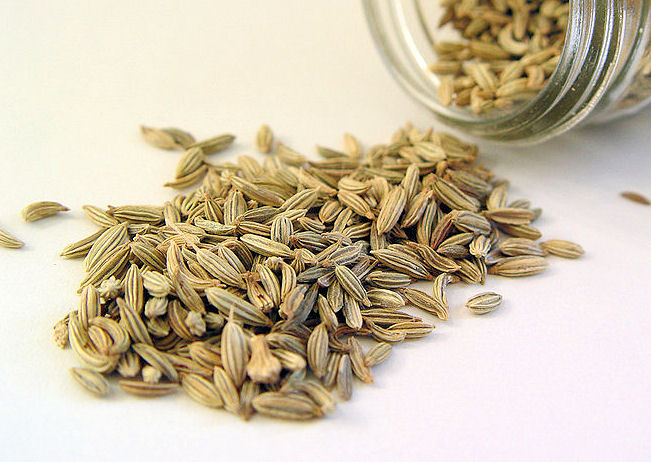
Abb.: Foeniculum
vulgare Mill. 1768 - Fenchel - Fennel
[Bildquelle: Howcheng / Wikipedia. -- GNU FDLicense]
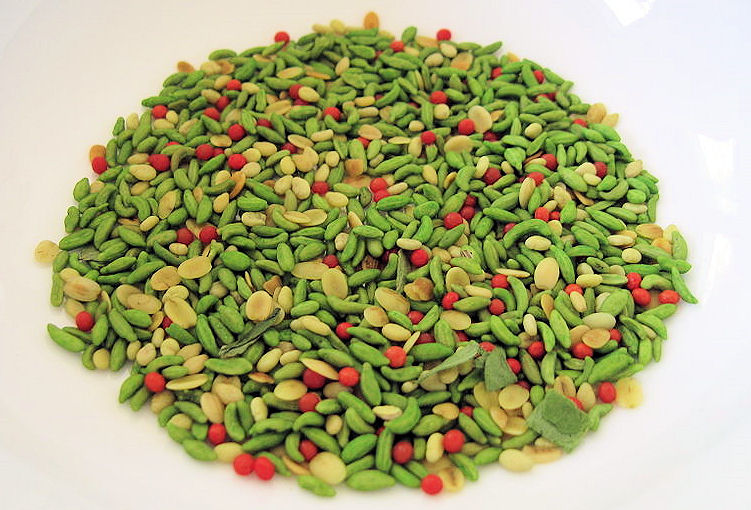
Abb.: मिश्रेया । Green
Mukhwas - a sugar-coated spice mix, mainly fennel, used as an after-dinner mouth
freshener with Indian cuisine.
[Bildquelle: Martyvis / Wikipedia. -- GNU FDLicense]
"FOENICULUM VULGARE, Gartn.
Fig.—Bentl. and Trim., t. 123.Fennel (Eng.), Fenouil (Fr.).
Hab.—Cultivated in India.[...]
History, Uses, &C.—Fennel is identified by Mahometan writers as the μαραθρον of the Greeks, who also called it μαραθρον. It is mentioned by Hippocrates and Dioscorides as a diuretic and emmenagogue, and the juice was supposed to sharpen the eyesight. Nicander and Pliny mention certain superstitious notions concerning fennel, which are expressed in the following lines by Macer Floridus (De Vir. Herb.):—
Cum vino cunctis obstat haec herba venenis;
Hac morsa, serpens oculos caligine purgat,
Indeque compertum est humanis posse mederi
Illam luminibus, atque experiendo probatum—
Urinas purgat et menstrua sumpta resolvit,
Vel si trita super pecten haec herba ligetur—
Tradunt auctores ejus juvenescere gustu.
Serpentes, et ob hoc senibus prodesse putatur.Indian Sweet Fennel is rather smaller and straighter than the European article, but in other respects is similar to it. Fennel fruit is used by the natives of India as a condiment and as an aromatic adjunct to medicines. A distilled water, known as Ark-i-badian, is prepared from it. The Sanskrit name is Madhurika (sweet). As pointed out by Mr. M. Sheriff in his Appendix to the Pharmacopoeia of India, this plant and the anise are often confounded in Arabic and Persian works on Materia Medica. The Persians call the fruits of both Razianahy but the Hindu dealers in Bombay call Fennel Wariari and Anise Erva-dos. The root of fennel is rather an important medicine in native practice, being to the present day esteemed as one of the five opening roots of the ancients."
[[Quelle: Pharmacographia indica : a history of the principal drugs of vegetable origin met with in British India / by William Dymock [1834-1892], C. J. H. Warden and David Hooper [1858-1947]. -- Bd. 2. -- London, 1891. -- S. 124f.]
Anethum graveolens L. 1753 - Ackerdill
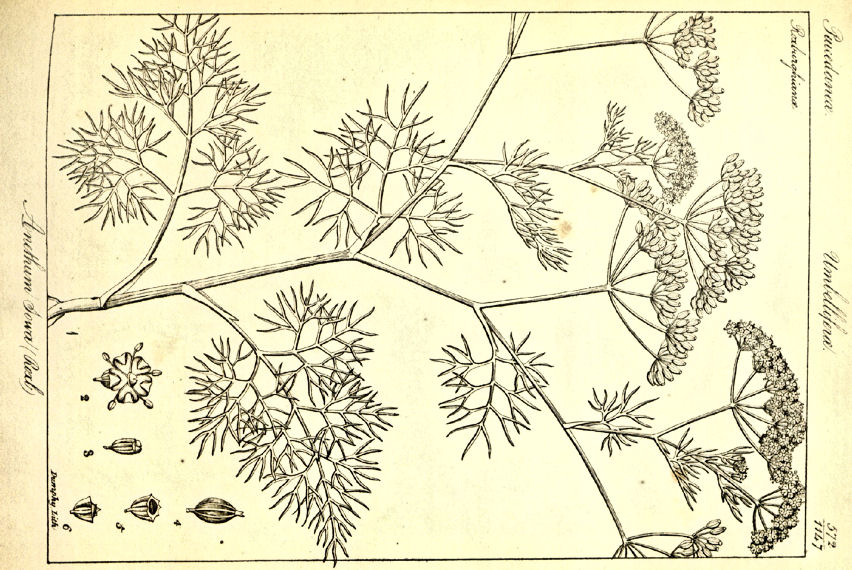
Abb.: Anethum graveolens L. 1753 - Ackerdill
[Bildquelle: Wight Icones II, Tab. 572, 1843]
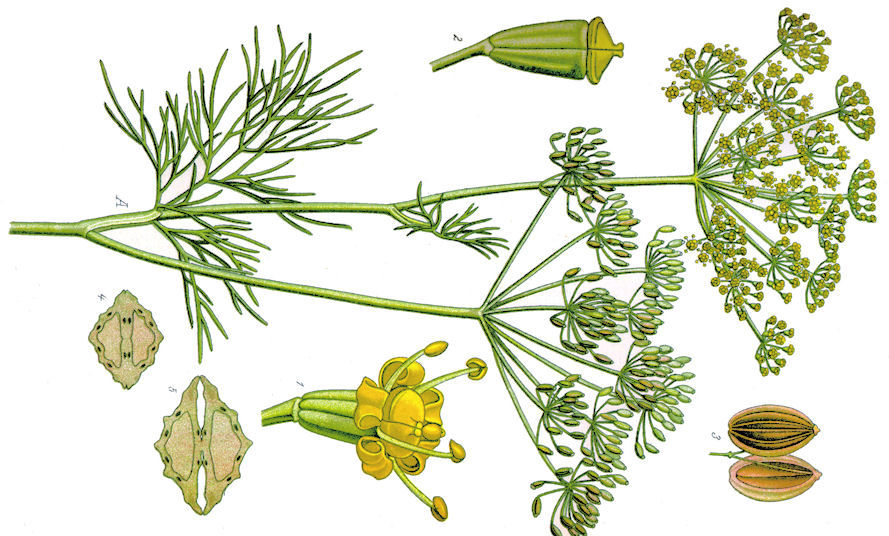
Abb.: Anethum graveolens L. 1753 - Dill
[Bildquelle: Thomé 1885 / Wikimedia. -- Public domain]
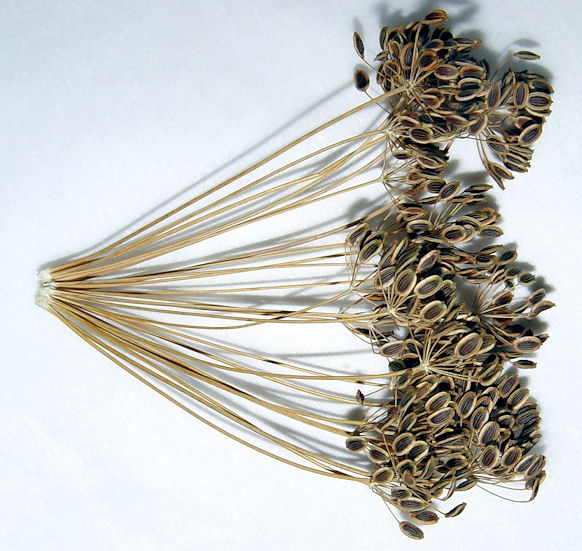
Abb.: Anethum graveolens L. 1753 - Dill, Österreich
[Bildquelle: Mnolf / Wikimedia. -- GNU FDLicense]
"Anethum Sowa. Roxb.
Annual. [...]
Sans. Mishreya.
A native of Bengal, where it is cultivated for the seeds, which are much used for culinary and medicinal purposes. Time of culture the cold season.
Root annual, in fact of only a few months duration.
[...]
The seeds are to be met with in every market over India, they are much used by the natives in their curries, and also for medicinal uses."
[Quelle: Roxburgh, William <1751-1815>: Flora indica, or, Descriptions of Indian plants / by the late William Roxburgh. -- Serampore : Printed for W. Thacker, 1832. -- Vol. 2, S. 96.]
"Anethum Sowa (Roxb.) N. O. Apiaceae. Dill or Bishop's weed [...]
Description.—Annual, 2-4 feet, erect; [...] flowers yellow.
Fl. Feb.—April.
W. & A. Prod, i 372.—Wight Icon. t. 572.—Roxb. Flor. Ind. ii 96.
A. graveolens, Wall.
Bengal. Cultivated in the Peninsula.
Medical Uses.—The seeds are to be met with in every Indian bazaar. They form one of the chief ingredients in curry-powder. They yield a valuable oil, prepared by distillation, and used medicinally. Bruised and boiled in water and mixed with the roots, these seeds are applied externally in rheumatic and other swellings of the joints. The leaves, applied warm and moistened with a little oil, are said to hasten suppuration.—Ainsl. Roxb."
[Quelle: Drury, Heber <1819 - 1872>: The useful plants of India : with notices of their chief value in commerce, medicine, and the arts. -- 2d ed. with additions and corrections. London : Allen, 1873. -- xvi, 512 p. ; 22 cm. -- s.v.]
"Anethum Panmori. Roxb.
Annual [...]
Sans. Mudhoorika. Mayuri. See Asiat. Res. 11. 156.
Like Sowa this plant is cultivated in various parts of Bengal during the cold season for the seed, which the natives eat with their betle and also use in their curries. Seed time the close of the rains, about the end of October. Harvest in March, when the plants perish.
[...]
Seeds exactly as in Anethum Foeniculum and with the same taste.
The seeds of this plant, for which it is cultivated, possess a pleasant, warmish, very sweet taste, and aromatic smell so much like sweet fennel that I should certainly have thought them at most nothing but varieties of the same species, if I had not had both growing before me for several years in the Botanic Garden at Calcutta where plants of Foeniculum reared from Europe seed do not blossom till the second year, during which period the leaves are bifarious, infinitely larger and more divided than in Panmuhuree, which is an annual plant of only four or five months duration with the leaves at all times scattered, fewer and more remote.
From my Anethum Sowa, Panmori differs very conspicuously in many respects, but the best mark is in the seeds. In this they are longer, less flattened and without an membranaceous rim, or border. In that, much flattened with a thin margin, like that of A. graveolens."
[Quelle: Roxburgh, William <1751-1815>: Flora indica, or, Descriptions of Indian plants / by the late William Roxburgh. -- Serampore : Printed for W. Thacker, 1832. -- Vol. 2, S. 94ff.]
"PEUCEDANUM GRAVEOLENS, Benth.
Fig.—Bentl. and Trim., t. 132.Dill, (Eng.),
Hab.—Cultivated in India.[...]
History, Uses, &c.—Dill seed is much esteemed by the natives of India, who use it as a condiment and medicine. An infusion of it is given as a cordial drink to women after confinement. The leaves moistened with oil are used as a stimulating poultice or suppurative, The Sanskrit names are Misreya and Shatapushpa. Mahometan writers describe Shibbit as resolvent and deobstruent, carminative, diuretic, and emmenagogue. The Persian name is Shud and the Yunani Anitun.
Description.—The fruits of the Indian plant, which has by some been called Anethum Sowa, do not differ in any important respect from those of the European plant."
[Quelle: Pharmacographia indica : a history of the principal drugs of vegetable origin met with in British India / by William Dymock [1834-1892], C. J. H. Warden and David Hooper [1858-1947]. -- Bd. 2. -- London, 1891. -- S. 129f.]
Euphorbiaceae (Wolfsmilchgewächse)
Kleiner Baum
| 24. miśreyāpy
atha sīhuṇḍo vajraḥ snuk strī snuhī guḍā samantadugdhātho vellam amoghā citrataṇḍulā मिश्रेयाप्य् अथ
सीहुण्डो वज्रद्रुः स्नुक् स्नुही गुडा । [Bezeichnungen für Euphorbia neriifolia L. 1753 - Oleander-Wolfsmilch - Oleander Spurge:]
|
Colebrooke (1807): "Euphorbia. Including divers species, as Tirucalli [Euphorbia tirucalli L. 1753 - Latex-Wolfsmilch - Rubber Euphorbia] &c."
"Under Euphorbiacese, Norman Chevers, quoting Dr. H. Cleghorn of Madras, says :—" There are several species of Euphorbia, as the E. neriifolia, antquorum, acaulis and others which abound in a milky juice. This produces a blister when rubbed on the integuments, and serious inflammation if dropped into the eye. Several cases have happened within my knowledge, where the sight has been endangered from this cause (ind. Med. Jurisprudence.)" [Quelle: Pharmacographia indica : a history of the principal drugs of vegetable origin met with in British India / by William Dymock [1834-1892], C. J. H. Warden and David Hooper [1858-1947]. -- Bd. 3. -- London, 1893. -- S. 261.]
Euphorbia neriifolia L. 1753 - Oleander-Wolfsmilch - Oleander Spurge
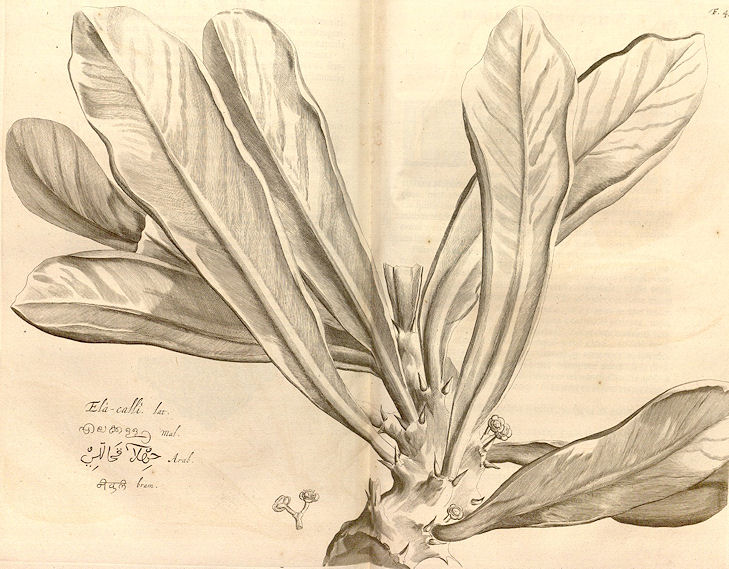
Abb.: समन्तदुग्धा । Euphorbia neriifolia L. 1753
- Oleander-Wolfsmilch - Oleander Spurge
[Bildquelle: Hortus malabaricus VI. Fig. 43, 1686]

Abb.: वज्रद्रुः । Euphorbia neriifolia L. 1753 -
Oleander-Wolfsmilch - Oleander Spurge
[Bildquelle: Plantarum historia succulentarum = Histoire des plantes grasses /
par A.P. Decandolle ; avec leurs figures en couleurs, dessinées par P.J.
Redoute, 1799 - 1837. -- Vol 1. -- Tab. 46]
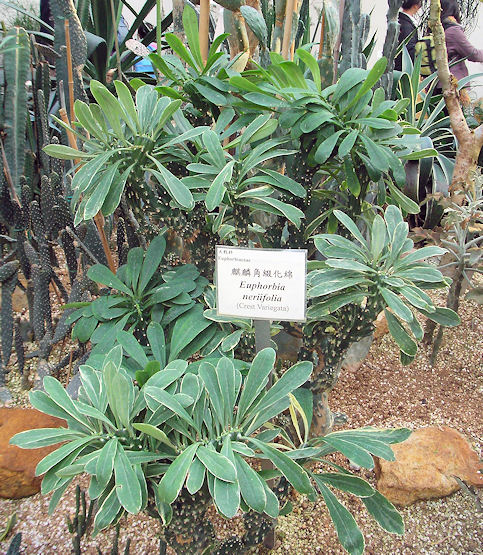
Abb.: स्नुही ।
Euphorbia neriifolia L. 1753 - Oleander-Wolfsmilch - Oleander Spurge, Hong
Kong
[Bildquelle: Tequila / Wikimedia. -- GNU FDLicense]
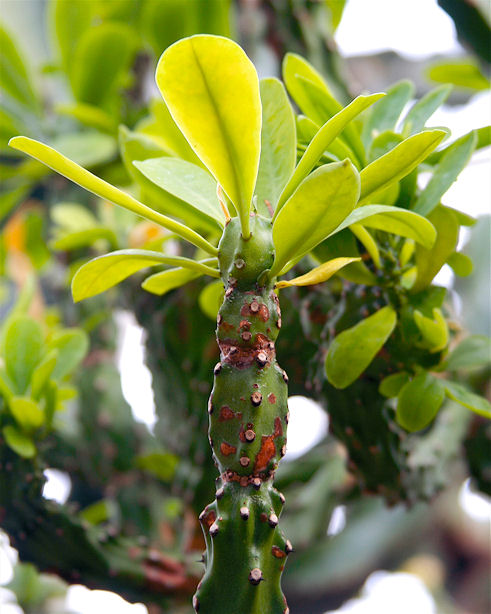
Abb.: गुडा । Euphorbia neriifolia L. 1753
- Oleander-Wolfsmilch - Oleander Spurge, USA
[Bildquelle:
Dan Mullen. --
http://www.flickr.com/photos/8583446@N05/4363329128/. -- Zugriff am
2010-10-18. --
Creative
Commons Lizenz (Namensnennung, keine kommerzielle Nutzung, keine
Bearbeitung)]
"Euphorbia nereifolia. Willd. 2. 984.
Arboreous. [...]
Ela-calli. Rheed. MaL. 2. t. 43.
Tibimalus zeylanicus,. Pluck. 2. t. 330. f. 4.
[...]
It grows to be a small, poor looking tree, delighting in an almost dry, barren soil. Flowering time the hot season."
[Quelle: Roxburgh, William <1751-1815>: Flora indica, or, Descriptions of Indian plants / by the late William Roxburgh. -- Serampore : Printed for W. Thacker, 1832. -- Vol. 2, S. 467f.]
"EUPHORBIA NERIIFOLIA, Linn.
Fig,—DC. Plant. Grasses, i. t. 46 ; Rumph. Herb. Amb. iv., t. 40.
Hab.—Deccan Peninsula, Beluchistan, Malay Islands. Cultivated elsewhere.
[...]
EUPHORBIA ANTIQUORUM, Linn.
Fig.— Wight Ic, t. 897 ; Rheede, Hort. Mal. ii. t. 42.
Hab.—Throughout the hotter parts of India and Ceylon.
[...]
History, Uses, &c.—These two plants are included under the Sanskrit names of Snuhi, Sehunda, Vajra, Vajra-tundi, Vajra-dantaka, Gandira and Maha-taru, and are supposed to ward off lightning strokes, on which account they are sometimes cultivated in pots placed on exposed positions in Hindu houses. They are sacred to Mansā, the goddess of serpents. In some parts of India, in July and August, on Tuesdays and Thursdays, the natives approach the trees with offerings of rice, milk, and sugar, praying to be delivered from snake-bites. They also employ the root mixed with black pepper as a medicine for the cure of snake-bites internally and externally. Dutt informs us that in Bengal, on the fifth day after the full moon of the month Srawan, E. neriifolia is planted in the courtyard of Hindu houses and worshipped.
In Western India there is a curious custom among the Concani Brahmins in connection with this plant. At the time of the Dewali they cut a portion of the stem, hollow it out, and fill it with oil, in which they place a wick. The little lamp thus formed is lighted and carried from house to house with the object of depositing it unextinguished in the house of some friend or acquaintance, saying at the same time, " A son-in-law for you," that is, wishing them good fortune (Nevadunga). The people of the house pretend not to want it, and try to extinguish the light by throwing water at it. These lamps are also placed upon little heaps of cowdung and worshipped.
In the Nighantas the plants are described as purgative, pungent, digestive, bitter and heavy, and are said to be useful in constipation, flatulent distention, tumours, swellings, abdominal enlargements, rheumatism, spleen, leprosy, mania and jaundice.
They abound in an acrid milky juice, which is a popular application to warts and other cutaneous affections. The native doctors purify arsenious acid by packing it in a hole made in a piece of the stem, closing the hole and exposing the stem to the action of fire until it is charred. The milky juice of E. neriifolia is usually administered internally by soaking other purgatives and aromatics in it, so that by absorption of the juice their purgative properties become increased. A similar method is adopted when the juice is applied externally, a tent or issue pea being prepared with some finely powdered drug and steeped in it. Ainslie tells us that the native practitioners prescribe the juice as a purge and deobstruent, in those visceral obstructions and dropsical affections which are consequent of long-continued intermittent fever, the quantity given for a dose being about 1/4 of a pagoda weight (20 grs.). Externally, mixed with margosa oil, it is
applied to limbs which have become contracted from rheumatism. (Mat. Ind., vol. II., p. 97.) In Bombay the root is mixed with country liquor to make it more intoxicating, and the juice is used to kill maggots in wounds, and is dropped into the ear to cure earache, a practice common to many parts of India. In the Concan the stem is roasted in ashes, and the expressed juice, with honey and borax, given in small doses to promote the expectoration of phlegm ; sometimes the juice of Adulsa is added. For asthma, Miidar flowers, Aghada root, and Gokaran root are steeped in the juice, powdered and given with honey and chebulic myrobalans. Dose about 4 grains. The author of
the Makhzan-el-Adiviya, under the name of Zakum (Euphorbia), describes four Indian species, which are probably E. antiquorum,
E. neriifolia, E. Nvulia and E. Tirucalli. The milky juice of the first, he says, is mixed with the flour of Cicer arietinum, roasted, and administered in pills as a remedy for gonorrhoea. It has a strong purgative action. The juice of the second and third species is heated and dropped into the ear for the cure of earache ; heated with salt it is given as a remedy in whooping cough, asthma, dropsy, leprosy, enlarged spleen, dyspepsia, jaundice, flatulence, colic, calculus, tumours, &c. The fourth species yields a milky juice, having similar properties. Sprengel identifies E. neriifolia with the Mahudaneh of Ibn Sina, also called Hab-el-muluk, a purgative seed of a reddish
brown colour and like a vetch. [...] Ibn Sina describes Mahudaneh as tricoccous and like a large filbert; he says, the name of the plant is Shibab. It cannot be E. neriifolia, which has seeds no larger than a grain of mustard. In the Dict, of Econ. Prod., published by the Government of India, it is stated, on the authority of Dr. J. H. Thornton, that the juice of M. antiquorum mixed with burnt borax and common salt is used as an application to painful joints and swellings. Dr. Thornton says:—"The fresh milky juice is a direct irritant both when taken internally and applied externally. Taken in very small quantities, it is a drastic purgative." E. trigona, Haworth, the Kattimandu or "knife medicine" of the Telugus, so named because it is used for fixing knife blades in their handles, and E. Nivulia, Ham., have similar properties."
Description.—E. neriifolia is a small, fleshy, glabrous tree or shrub"[Quelle: Pharmacographia indica : a history of the principal drugs of vegetable origin met with in British India / by William Dymock [1834-1892], C. J. H. Warden and David Hooper [1858-1947]. -- Bd. 3. -- London, 1893. -- S. 253ff.]
"Euphorbia nivulia (Buch.) [...]
Description.—Tree; [...] flowers greenish yellow.
Fl. March—April
Wight Icon. t. 1862.—Roxb. FL Ind. ii. 467.
E. nereifolia, Linn.—Rheede, ii. t. 43.
Concans. Bengal Coromandel.
Medical Uses.—The juice of the leaves of this plant is used internally as a purgative; mixed with Margosa oil it is applied externally in certain cases of rheumatism. On the western coast the bark of the root boiled in rice-water and arrack is given in dropsy. The leaves simply warmed in the fire will promote urine externally applied, while their juice warmed is a good remedy in ear-ache, and is occasionally rubbed over the eyes to remove dimness of sight.—(Ainslie. Rheede.) The pulp of the stem, mixed with green ginger, is given to persons who have been bitten by mad dogs, previous to the appearance of hydrophobia.—Journ. of Agri.-Hort. Soc. x. 37."
[Quelle: Drury, Heber <1819 - 1872>: The useful plants of India : with notices of their chief value in commerce, medicine, and the arts. -- 2d ed. with additions and corrections. London : Allen, 1873. -- xvi, 512 p. ; 22 cm. -- s.v.]
Euphorbia tirucalli L. 1753 - Latex-Wolfsmilch - Rubber Euphorbia

Abb.: Euphorbia
tirucalli L. 1753 - Latex-Wolfsmilch - Rubber Euphorbia
[Bildquelle: Hortus malabaricus II. Fig. 44, 1679]
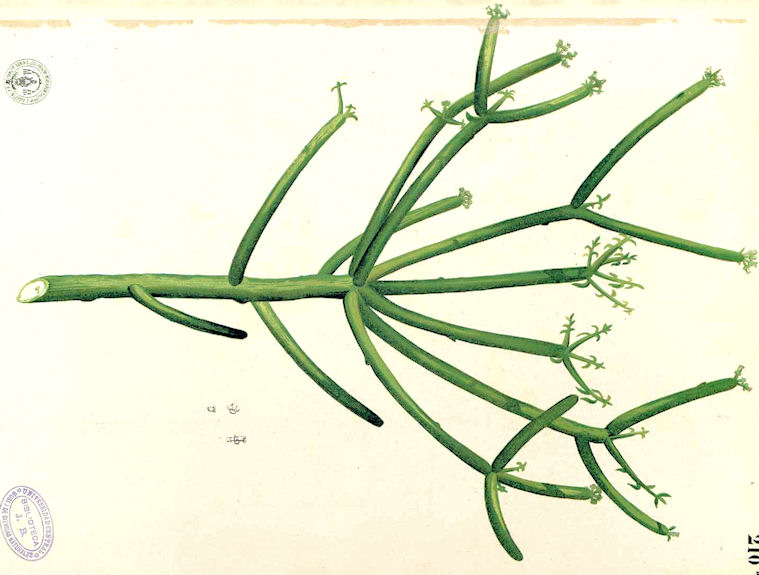
Abb.: Euphorbia
tirucalli L. 1753 - Latex-Wolfsmilch - Rubber Euphorbia
[Bildquelle: Flora de Filipinas, 1880 / Wikipedia. -- Public domain]
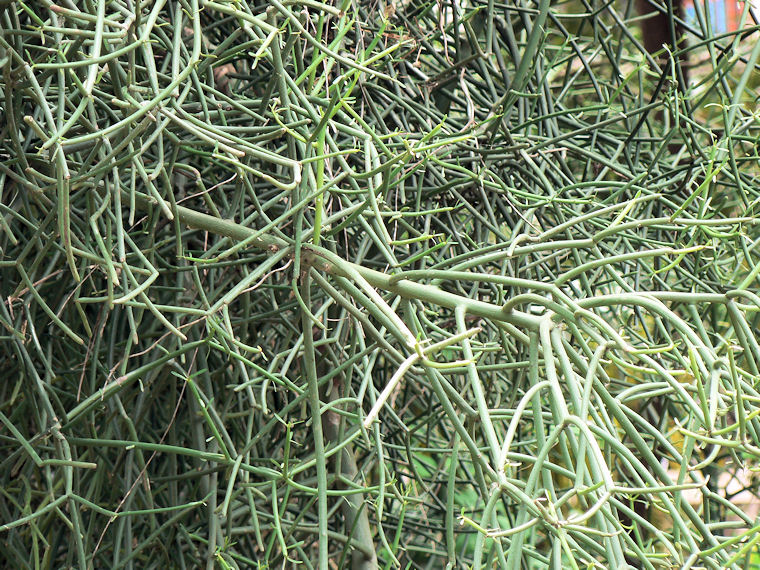
Abb.: Euphorbia
tirucalli L. 1753 - Latex-Wolfsmilch - Rubber Euphorbia, Maharashtra
[Bildquelle: dinesh_valke. --
http://www.flickr.com/photos/dinesh_valke/819499579/. -- Zugriff am
2010-11-14. --
Creative
Commons Lizenz (Namensnennung, keine kommerzielle Nutzung, keine
Bearbeitung)]
"Euphorbia Tirucalli. Willd. 2. 890.
Arboreous, unarmed branchlets, [...]
Tirucalli. Rheed. Mal 2 t. 44.
Ossifraga lactea. Rumph. Amb. 7. t. 29.
A native of various parts of India ; when well advanced in age and size it flowers during the rains. About Madras it is very generally employed for fences, and there called Milk hedge."
[Quelle: Roxburgh, William <1751-1815>: Flora indica, or, Descriptions of Indian plants / by the late William Roxburgh. -- Serampore : Printed for W. Thacker, 1832. -- Vol. 2, S. 470.]
"Euphorbia tirucalli (Linn.) Milk-hedge or Indian Tree Spurge [...]
Description.—Tree unarmed, 20 feet; [...]
Fl. June—Sept.
Roxb. Fl. Ind. ii. 470.—Rheede, ii. t 44.
CoromandeL Malabar. Bengal.
Medical Uses.—The fresh acrid juice of this plant is used as a vesicatory. Rheede says that a decoction of the tender branches is given in colic, and the milky juice mixed with butter as a purgative, on the Malabar coast. It is used among the natives as a good manure. Goats will eat the plant notwithstanding its acrid juice. The bark and small branches are ingredients used in dyeing cotton a black colour. The root in decoction is administered internally in pains in the stomach. On the Coromandel coast it is frequently employed for hedges, and is known as the milk-hedge.—Roxb."
[Quelle: Drury, Heber <1819 - 1872>: The useful plants of India : with notices of their chief value in commerce, medicine, and the arts. -- 2d ed. with additions and corrections. London : Allen, 1873. -- xvi, 512 p. ; 22 cm. -- s.v.]
"EUPHORBIA TIRUCALLI, Linn. Fig.—-Rheede, Hort. Mal. ii. t. 44.
Milk-bush
Hab.—Africa. Cultivated in India and the East.
[...]
History, Uses, &c. —This shrub has been introduced into the East from Africa, and is much used for making fences round cultivated fields, as cattle will not break through it owing to the acrid nature of the milky juice. The earliest notice of E. Tirucalli that we know of is in the Kamus, which was written about the middle of the 14th century; it is there called dihan, the name by which it is still known in Arabia (Forskahl), and is described as a noxious plant, used to poison wild beasts. The plant is not mentioned in the Nighantas, but the juice is in general use among the natives of India as a purgative, and, applied locally, as a counter-irritant. Rheede states that a decoction of the root is given in certain cases of colic, and that the milky juice mixed with melted butter is prescribed as a purge. It is the Ossifraga lactea of Rumphius, who says that the bark is applied in Java to fractures. According to Horsfield, the Javanese, who call it Kayoo-oorb, also use it as a vesicant. Virey (Hist Nat., p. 299) says :—"Il guérit tres bien l'affection venérienne ; il est aussi purgatif et vomitif." Loureiro notices its caustic nature: " Occulos si tangat excaecat."
(Ainslie, Mat. Ind., ii., 133 and 425.) In the Concan 1 to 4 drops of the milky juice are given with treacle or the flour of Cicer arietinum as a purge, and the charcoal, which is very light, is used in making pastilles. Dr. G. Y. Hunter speaks of the juice as a good application in neuralgia. In Goa it is used for poisoning fish.Description.—A shrub or small tree, 15—20 feet"
[Quelle: Pharmacographia indica : a history of the principal drugs of vegetable origin met with in British India / by William Dymock [1834-1892], C. J. H. Warden and David Hooper [1858-1947]. -- Bd. 3. -- London, 1893. -- S. 252f.]
Myrsinaceae (Myrsinengewächse)
Kletterstrauch
| 24. c./d.
samantadugdhātho
vellam amoghā citrataṇḍulā 25. a./b. taṇḍulaś ca kṛmighnaś ca viḍaṅgaṃ puṃnapuṃsakam समन्तदुग्धाथो वेल्लम्
अमोघा चित्रतण्डुला ॥२४ ख॥ [Bezeichnungen für Embelia ribes Burm. f. 1768 - False Black Pepper:]
|
Colebrooke (1807): "Babreng. The seed is used as a vermifuge."
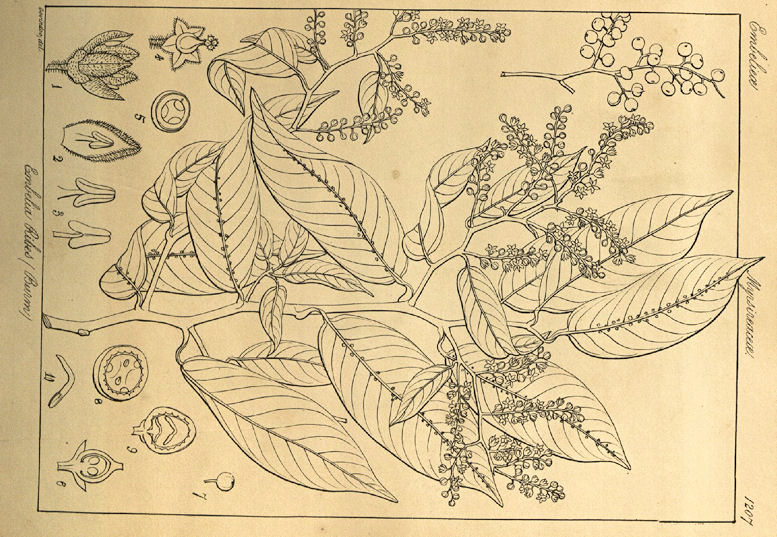
Abb.:
विडङ्गम् । Embelia ribes Burm. f.
1768 - False Black Pepper
[Bildquelle: Wight Icones IV, Tab. 1207, 1850]
"Embelia Ribes. Burm. Ind. 62. t. 23.
Shrubby, scandent. [...]
Ribesioides. Linn. fl. zeyl. N. 403.
Baberung, the vernacular name in the Silhet district.
An immense climber, a native of the forests on the east border of Bengal, where it blossoms in February and March ; and the seeds ripen towards the close of the rainy season.
[...]
The natives of the hills in the vicinity of Silhet, where the plants grow abundantly, gather the little drupes, and when dry sell them to the small traders in black-pepper, who fraudulently mix them with that spice, which they so resemble as to render it almost impossible to distinguish them by sight, and they are somewhat spicy withal."
[Quelle: Roxburgh, William <1751-1815>: Flora indica, or, Descriptions of Indian plants / by the late William Roxburgh. -- Serampore : Printed for W. Thacker, 1832. -- Vol. 2, S. 586f.]
"Embelia ribes (Burm.) N. O. Myrisinaceae. [...]
Description.—Large climbing shrub; [...]
Fl. Feb.—March.
Wight Icon. t. 1207.—Roxb. Fl. Ind. i. 586.
E. ribesioides, Linn.
Peninsula. Silhet.
Medical Uses.—The natives in the vicinity of Silhet, where the plant grows abundantly, gather the berries, and when dry sell them to the small traders in black pepper, who fraudulently mix them with that spice, which they so resemble as to render it almost impossible to distinguish them by sight or by any other means, as they are withal somewhat spicy. Given in infusion, they are anthelmintic. They are also administered internally in piles. Their pungency is ascribed by Decandollo to the quantity of some peculiar quality of the resinous substance. Boyle states they are cathartic. —Don. Boyle. Roxb."
[Quelle: Drury, Heber <1819 - 1872>: The useful plants of India : with notices of their chief value in commerce, medicine, and the arts. -- 2d ed. with additions and corrections. London : Allen, 1873. -- xvi, 512 p. ; 22 cm. -- s.v.]
"EMBELIA RIBES, Burm.
Fig.—Burm. Fl. Ind., t. 23; Lam. III., t. 133.
Hab.—Throughout India.
History, Uses, &c.—The Sanskrit name is Vidanga; it has many synonyms such as Vrisha-nasana "destroyer of the enemy " (worm) ; Suchitra-vija and Chitra-tandula, "having variegated seeds." Susruta describes the fruit as anthelmintic, alterative and tonic, and recommends its use along with liquorice root for the purpose of strengthening the body and preventing the effects of age. In the Nighantas it is described as bitter, pungent, hot, astringent, appetizing and light; useful for the removal of abdominal pains, worms, wind and skin diseases. The berries enter into the composition of several applications for ringworm and other skin diseases. Under the names of Birang-i-Kabuli and Biranj-i-Kabuli notices of the drug will be found in Mahometan works. The hakims consider it to be attenuant and a purgative of phlegmatic humours; also a valuable anthelmintic, especially against tapeworms. Ibn Sina describes it as a strong anthelmintic. Mr Muhammad Husain notices that it turns the urine red. He fixes the dose at three dirhems of the powder, and directs it to be given with fresh milk. Rheede figures a plant which appears to be Embelia robusta, and states that the seeds kill worms. Ainslie has the following short notice of it:—"Babreng is the Hindooie name of a vermifuge seed, common, I have been given to understand, in the higher provinces of Bengal, the Sanskrit name of which is Chitratandoola. What the plant is I know not." Roxburgh gives a full botanical description of the plant, and remarks that the berries are used to adulterate pepper. Royle notices their aperient properties. Vayvirang is in high repute as an anthelmintic among the country people, especially in cases of tapeworm, a disorder common among the Native Christians of the Coast. The dose is a teaspoonful of the powder twice a day for a child, and a dessertspoonful for an adult; it can hardly be called purgative; the taste is rather pleasant, slightly astringent, and faintly aromatic. The worm is expelled dead. A purgative should be given to prepare the
patient for the drug. It is a common practice to put a few berries of this plant in the milk that is given to young children ; they are supposed to prevent flatulence. Recently Dr. Harris (Lancet, July 23rd, 1887) has directed attention to the value of this drug as a remedy for tapeworm. He states that he has administered it for several years with good results to natives of India and Europeans ; he gives one to
four drachms with milk and curds early in the morning."[Quelle: Pharmacographia indica : a history of the principal drugs of vegetable origin met with in British India / by William Dymock [1834-1892], C. J. H. Warden and David Hooper [1858-1947]. -- Bd. 2. -- London, 1891. -- S. 349f.]
Malvaceae (Malvengewächse)
Kraut
| 25. c./d. balā vāṭyālakā ghaṇṭāravā tu śaṇapuṣpikā बला वाट्यालका घण्टारवा तु शणपुष्पिका ॥२५ ख॥ [Bezeichnungen für Sida cordifolia L. - Flannel Weed:]
|
Colebrooke (1807): "Sida. Sida cordifolia and rhombifolia [L. 1753 - Kuba-Jute - Cuban Jute], &c."
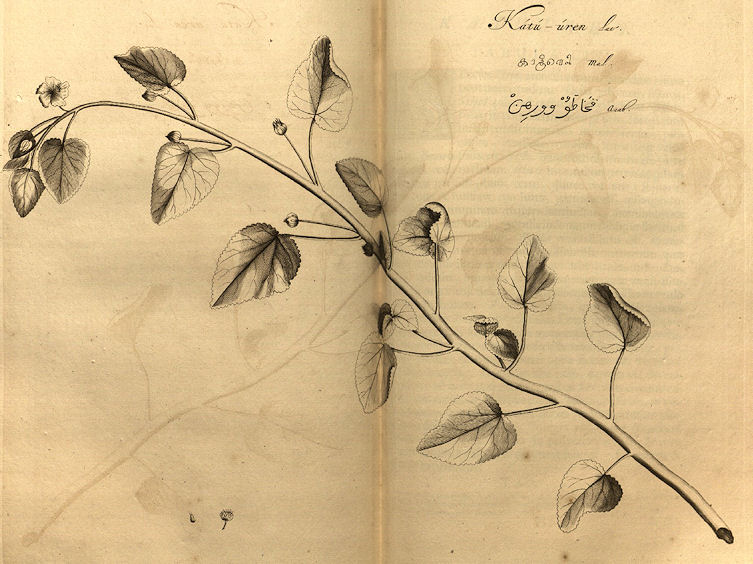
Abb.: बला । Sida cordifolia L. - Flannel Weed
[Bildquelle: Hortus malabaricus X. Fig. 54, 1690]
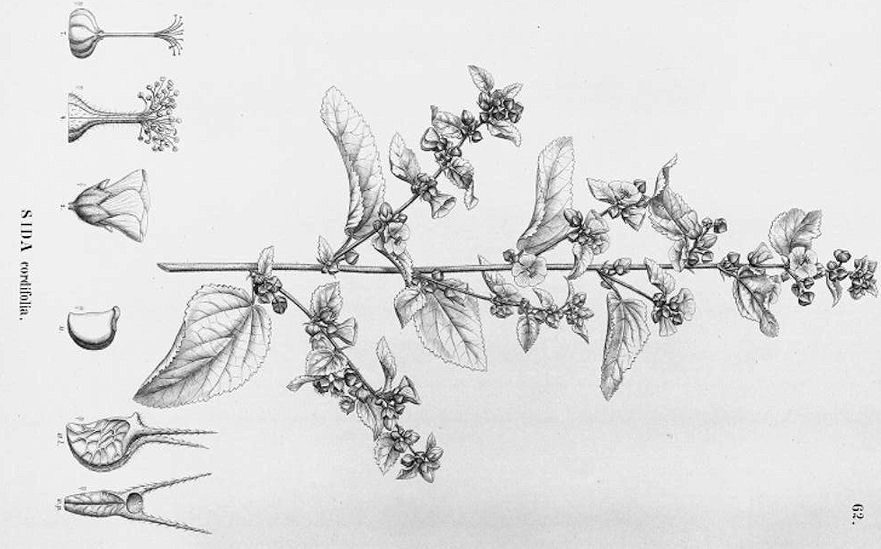
Abb.: वाट्यालका । Sida cordifolia
L. - Flannel Weed
[Bildquelle: Flora Brasiliensis 1886 / Wikimedia. -- Public domain]
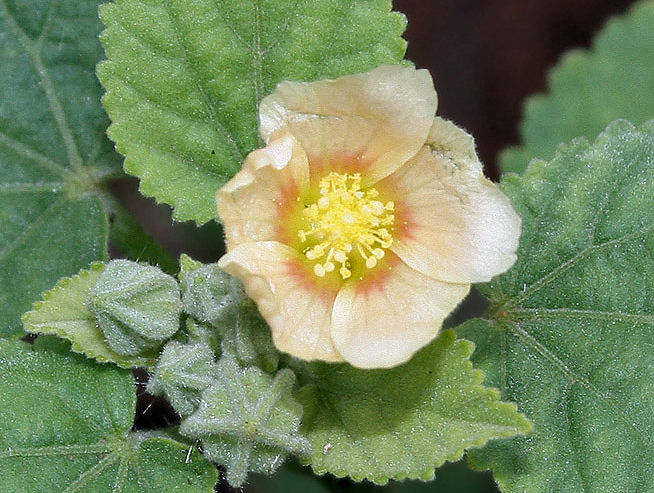
Abb.: बला । Sida cordifolia L. - Flannel Weed, Hyderabad -
హైదరాబాద్ -
حیدرآباد, Andhra Pradesh
[Bildquelle: J. M. Garg / Wikipedia. --
GNU FDLicense]
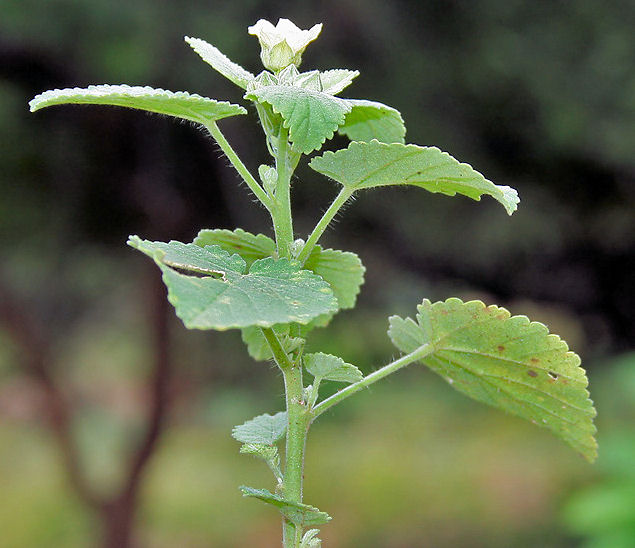
Abb.: बला । Sida cordifolia
L. - Flannel Weed, Hyderabad -
హైదరాబాద్ -
حیدرآباد, Andhra Pradesh
[Bildquelle: J. M. Garg / Wikipedia. --
GNU FDLicense]
"Sida cordifolia. Willd. iii. 758. Fleming in Asiat. Res. xi. 178,
Herbaceous, downy, and hairy. [...]
Katu-uren. Rheed. Mal. x. t. 54.
Batyulaka, its Sanscrit name..
A native of Coromandel, Bengal, &c. and with the rest blossoms during the rains, and cool season."
[Quelle: Roxburgh, William <1751-1815>: Flora indica, or, Descriptions of Indian plants / by the late William Roxburgh. -- Serampore : Printed for W. Thacker, 1832. -- Vol. 3, S. 177.]
"Sida carpinifolia, Linn. Fig.—Wight Ic, t. 95 ; Hort. MaL. x., 53.
Sida rhombifolia, Linn.
Fig.—Cav. Diss I., t.3, f. 12.
Sida cordifolia, Linn.
Fig.-Dil. El. 171, f. 209.
Sida spinosa, Linn.
Fig.—Cav. Diss I., t.1, f. 9.
Hab.—The tropics generally.
[...]
History, Uses, &c.--The plants belonging to this genus are known in Sanskrit by the general name Bala. Five kinds of Bala are mentioned in by Sanskrit medical writers under the name of Pancha-bala, viz., Bala, Nāgabala, Mahabala, Atibala and Rajabala. The Hindus regard the roots of the different species of Sida as cooling, astringent and tonic; they prescribe them in nervous and urinary diseases, and in fever. The root bark is beaten up with milk and sugar, and aromatics and stimulants are sometimes added. (For original prescriptions, see Dutt's "Hindu Materia Medica," p. 121.) In the Concan the leaves of S. cordifolia (Chikana) with other cooling leaves are applied in ophthalmia; the root-juice is used to promote the healing of wounds, and the juice of the whole plant pounded with a little water is given in 1/4 seer doses for gonorrhoea. The root of S. carpinifolia (Tupkaria) is applied with sparrow's dung to burst boils. The Mahometans consider Bala to be aphrodisiac. Ainslie notices several species of Sida, and the uses to which they are applied by the Hindus. The author of the Bengal Dispensatory, after a trial of the roots of Sida carpinifolia, was unable to satisfy himself as to its febrifuge action, but it was found to promote perspiration, to increase the appetite, and to act as a useful bitter tonic. In Goa the Portuguese value it as a diuretic, especially in rheumatic affections; they also use it as a demulcent in gonorrhoea. In Pudukota the plant of S. humilis, Willd., is ground with onions and administered with for gonorrhoea. Its Tamil name is Pelambaci. S. rhombifolia is called in Australia "Queensland Hemp," and in N.-S. Wales "Lucerne," as cows are very fond of it. It is also called "Jelly-leaf" on account of its mucilaginous nature. In the various species of Sida we have demulcent and emollient properties combined with bitterness."
[Quelle: Pharmacographia indica : a history of the principal drugs of vegetable origin met with in British India / by William Dymock [1834-1892], C. J. H. Warden and David Hooper [1858-1947]. -- Bd. 1. -- London, 1890. -- S. 206f.]
Sida rhombifolia L. 1753 - Kuba-Jute - Cuban Jute
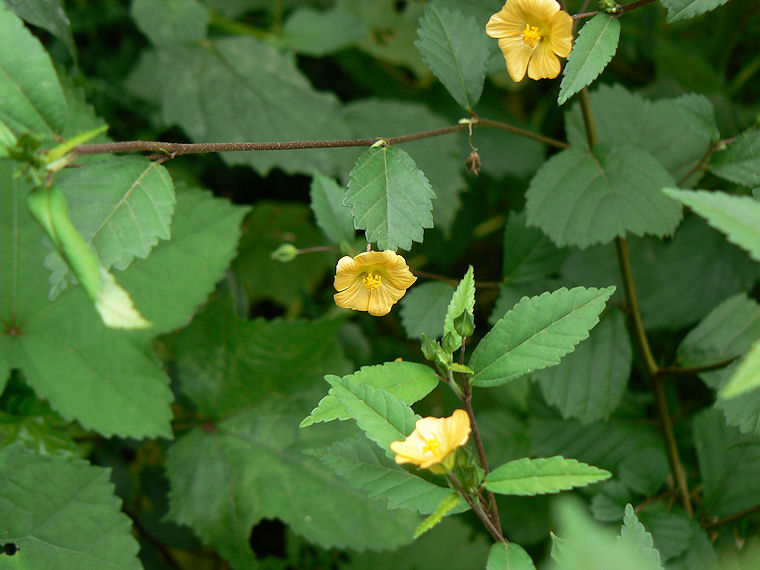
Abb.: Sida rhombifolia
L. 1753 - Kuba-Jute - Cuban Jute, Maharashtra
[Bildquelle: dinesh_valke. --
http://www.flickr.com/photos/dinesh_valke/1385638933/. -- Zugriff am
2010-11-14. --
Creative
Commons Lizenz (Namensnennung, keine kommerzielle Nutzung, keine
Bearbeitung)]
"Sida rhombifolia. Willd. iii, 740.
Shrubby, coloured.
[...]
Malvinda unicornis. Dill. Elth. 216. t. 172. f. 212.
Sida foliis lanceolato-rhomboidibus. Flor. Zeyl. N. 252.
A native of Bengal ; flowers during- the rainy season.
The bark of this and the last, (rhomboidea) yield abundance of very delicate flaxy fibres, and I think might be advantageously employed for many purposes. When the seed is sown thick on a good soil, the plants grow tall and slender, without branches, and every May fit for such purposes."
[Quelle: Roxburgh, William <1751-1815>: Flora indica, or, Descriptions of Indian plants / by the late William Roxburgh. -- Serampore : Printed for W. Thacker, 1832. -- Vol. 3, S. 176f.]
"Sida rhomboidea (Roxb.) [...]
Description.—Shrub; [...] flowers smallish, pale yellow.
Fl. Aug.—Dec.
W. & A. Prod, i. 57.—Roxb. Fl. Ind. iii. 176.
Negapatam. Coromandel. Assam. Cultivated.
Economic Uses.—The bark yields abundant delicate flaxy fibres. A line, after exposure to wet and the sun for ten days, bore 400 lb. The S. rhombifolia (Roxb.) is a native of Bengal, and also yields fibres. The Secretary of the Chamber of Commerce at Dundee, writing to Madras, says : "Of all the likely plants I have seen, the Sida rhomboidea appears to be the best, and I sincerely trust India will send us plenty of it Do use every exertion to have it cultivated, and sent home as a regular mercantile article, and I see no reason why we should not use as much of it as we do now of jute." It grows luxuriantly in Assam. From the length of its staple, its similarity to silk, and great strength, it would fetch a high price in England. A line only half an inch in circumference, after exposure to wet and sun for ten days, sustained a weight of 400 lb.—Hannay's Report to Agri.-Hort. Soc. Beng. 1862."
[Quelle: Drury, Heber <1819 - 1872>: The useful plants of India : with notices of their chief value in commerce, medicine, and the arts. -- 2d ed. with additions and corrections. London : Allen, 1873. -- xvi, 512 p. ; 22 cm. -- s.v.]
Sida carpinifolia L.
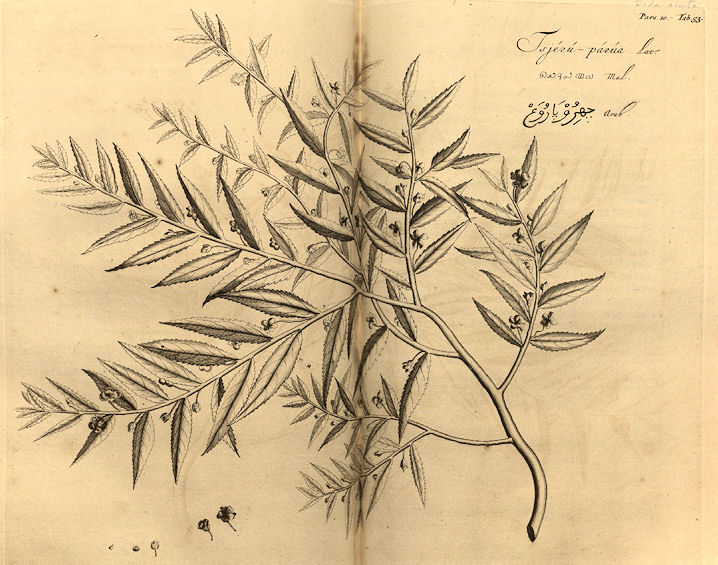
Abb.: Sida carpinifolia L.
[Bildquelle: Hortus malabaricus X. Fig. 53, 1690]
Fabaceae (Hülsenfrüchtler)
Kriecher
| 25. c./d. balā vāṭyālakā ghaṇṭāravā tu śaṇapuṣpikā बला वाट्यालका घण्टारवा तु शणपुष्पिका ॥२५ ख॥ [Bezeichnungen für Crotalaria verrucosa L. - Blue Rattlepod:]
|
Colebrooke (1807): "Crotalaria. Crotalaria retusa [L. 1753 - Devil Bean / Rattlebox], sericea [Retz. 1788 = Crotalaria spectabilis Roth 1821] and some other species."
Crotalaria verrucosa L. - Blue Rattlepod
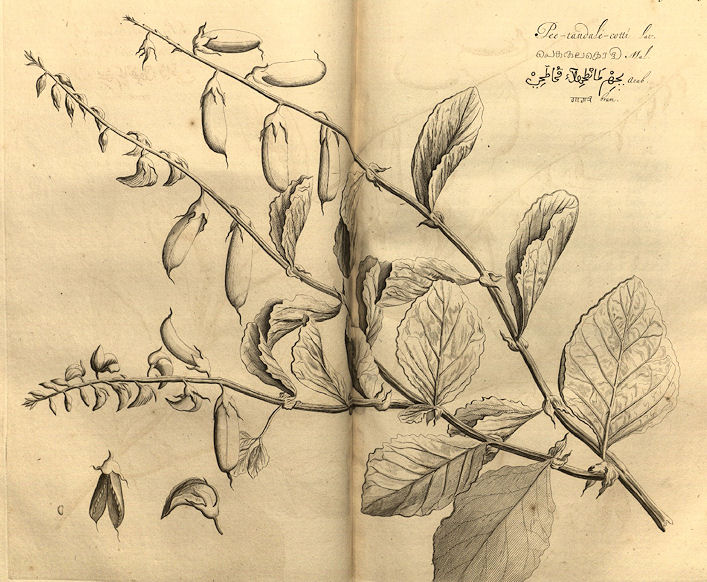
Abb.: घण्टारवा । Crotalaria verrucosa L. - Blue Rattlepod
[Bildquelle: Hortus malabaricus IX. Fig. 29, 1689]
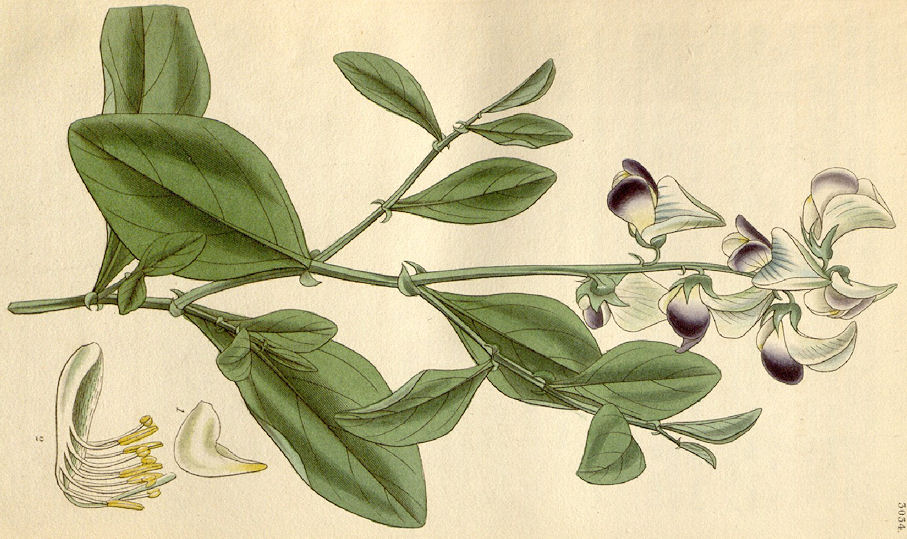
Abb.: शणपुष्पिका । Crotalaria verrucosa L. - Blue Rattlepod
[Bildquelle: Curtis's Botanical Magazine, v. 57 (1830), Tab. 3034]
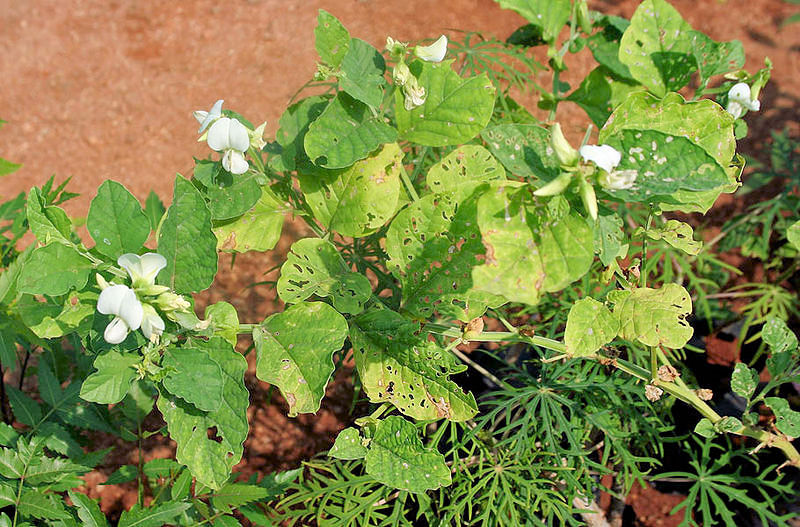
Abb.: शणपुष्पिका । Crotalaria verrucosa L. - Blue
Rattlepod, Rangareddy District - రంగా రెడ్డి
జిల్లా, Andhra Pradesh
[Bildquelle: J. M. Garg / Wikipedia. --
GNU FDLicense]
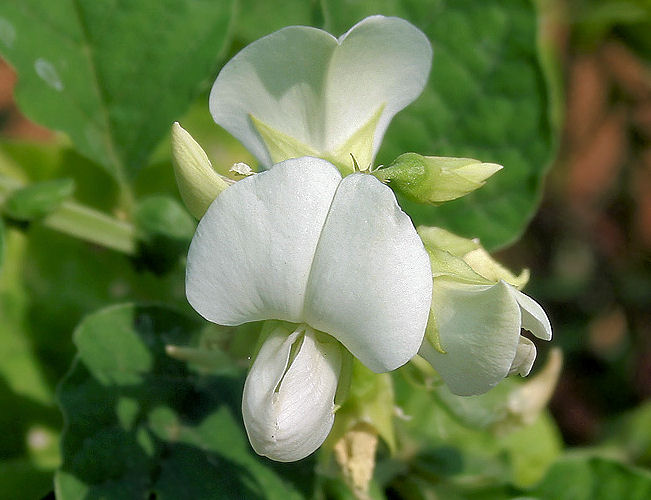
Abb.: शणपुष्पिका । Crotalaria verrucosa L. - Blue
Rattlepod, Rangareddy District - రంగా రెడ్డి
జిల్లా, Andhra Pradesh
[Bildquelle: J. M. Garg / Wikipedia. --
GNU FDLicense]
"Crotalaria verrucosa. Willd. iii. 977.
Annual [...] Legume sessil, many-seeded.
Pee-tandale-colti. Rheed. Mal. ix. t. 29."
[Quelle: Roxburgh, William <1751-1815>: Flora indica, or, Descriptions of Indian plants / by the late William Roxburgh. -- Serampore : Printed for W. Thacker, 1832. -- Vol. 3, S. 273.]
"CROTALARIA JUNCEA, Linn. Fig.—Roxb., Cor. Pl. t. 193; Bot. Mag. t. 1933; Rheede, Hort. Mal. ii. t. 26.
Hab.—Throughout the plains of India. Often cultivated.
[...]
History, Uses, &c.—-The seeds and leaves of this plant, in Sanskrit Sana, are used in Hindu medicine, and are considered to be cooling, and to purify the blood in febrile states of the system accompanied by cutaneous eruptions, such as impetigo, psoriasis, &c. They are also said to be emmenagogue in half drachm doses given twice a day, and are supposed sometimes to have caused abortion, but this is very improbable. The sacred thread of the Kshatrias is directed by Manu to be made of Crotalaria fibre.
C. verrucosa, Linn.
Bot. Mag. t. 3034; Wight, Ic. t. 200; Rheede, Hort. Mal. ix. t. 29,
found throughout the tropical regions of India, is called in Sanskrit Sana-pushpi, Dhavani, and Vrihatpushpi; it is described in the Nighantas as bitter and an expellant of bile and phlegm. This plant and several other species of the genus are included under the Sanskrit name of Ghantarava [...] in allusion to the rattling noise made by the seeds when the ripe pods are shaken, just as the generic name of the botanists is derived from the Greek κροταλον, a rattle or Castanet. Rheede (Hort. MaL. ix. p. 53) says that the juice of the leaves of C. verrucosa is supposed to diminish salivation. Ainslie, speaking of the same plant, says:—"The slightly bitter, but not unpleasant tasted juice of the leaves and tender stalks is prescribed by the Tamool doctors, both internally and externally, in cases of scabies and impetigo."
In Pudukota, C. retusa, Linn. (Bot. Mag. t. 2561 ; Rheede, Hort. Mal. ix. t. 25), is used for the same purpose. C. Sericea, Retz., is used in Bengal, and C. medicaginea, Lam., in the Punjab. C. Burhia, Hamilt., called Khip, Sis and Rharsan in the vernaculars, is considered
to be very cooling ; it is a naked looking, bushy plant, common in the arid districts of Northern India, which has the smell of broom when bruised.C. juncea is extensively cultivated for its fibres, from which tow is prepared. The nets of the Bombay fishermen are made of this fibre which is very strong and tans well. After the bark has been removed, the stems of the plant, which are perfectly straight and unbranched, are sold to the toy-makers; or cut in short lengths and dipped in brimstone to make firelighters for the Parsees, whose religion forbids them to blow fire when lighting or extinguishing it.
The Crotalarias appear to be used medicinally on account of their mucilaginous and emollient properties; the leaves might be used as a poultice like Althaea leaves."
[Quelle: Pharmacographia indica : a history of the principal drugs of vegetable origin met with in British India / by William Dymock [1834-1892], C. J. H. Warden and David Hooper [1858-1947]. -- Bd. 1. -- London, 1890. -- S. 400f.]
Crotalaria retusa [L. 1753 - Devil Bean / Rattlebox

Abb.: Crotalaria retusa
[L. 1753 - Devil Bean / Rattlebox
[Bildquelle: Hortus malabaricus IX. Fig. 25, 1689]
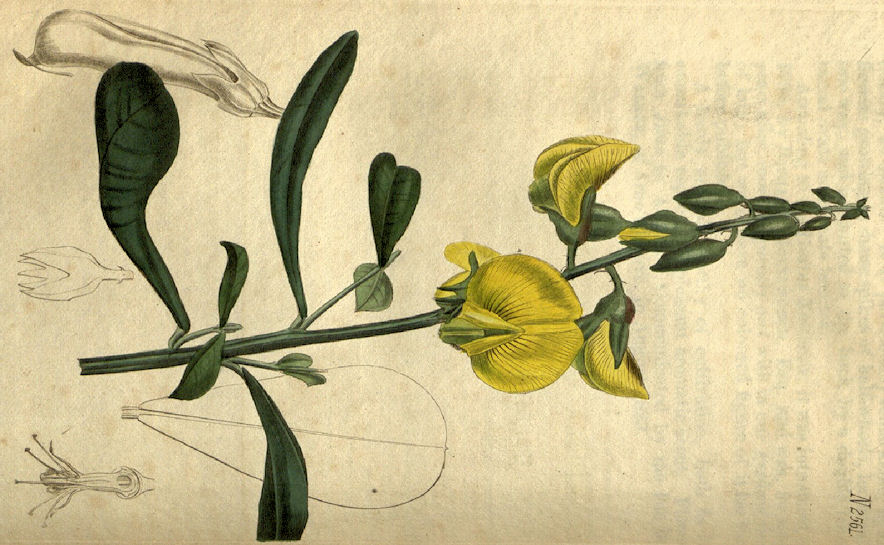
Abb.: Crotalaria retusa [L. 1753 - Devil Bean /
Rattlebox
[Bildquelle: Curtis's Botanical Magazine, v. 52 (1825), Tab. 2561]
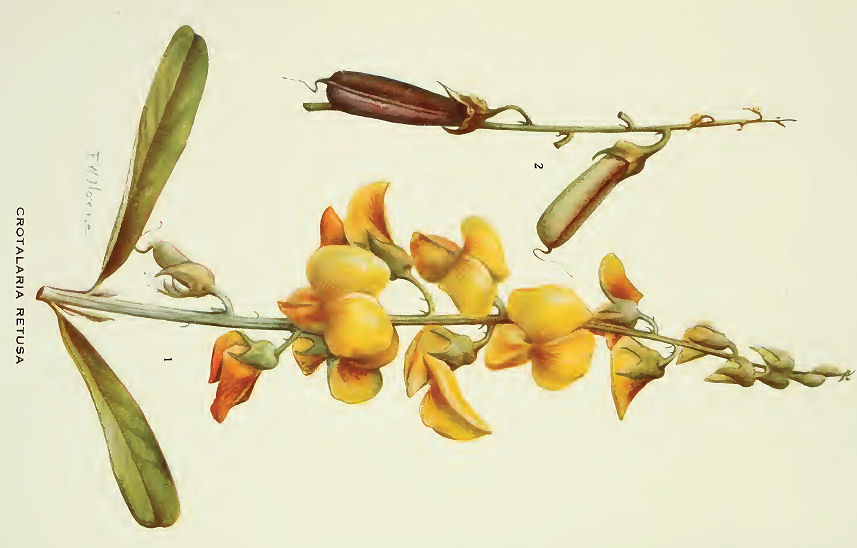
Abb.: Crotalaria retusa [L. 1753 - Devil Bean /
Rattlebox
[Bildquelle: Addisonia : colored
illustrations and popular descriptions of plants. -- Vol. 7 (1922). -- Pl. 248]
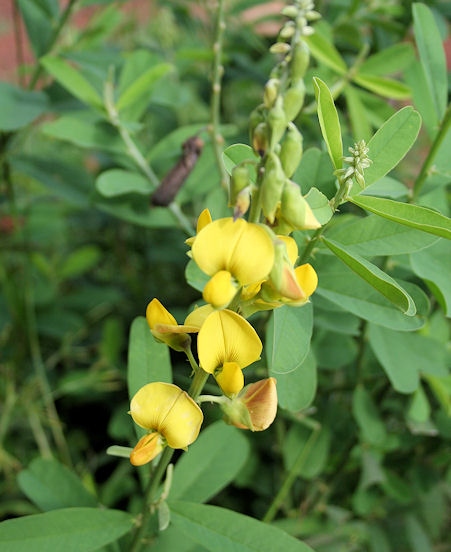
Abb.: Crotalaria retusa
[L. 1753 - Devil Bean / Rattlebox, Burkina Faso
[Bildquelle: Marco Schmidt / Wikimedia. --
Creative Commons
Lizenz (Namensnennung, share alike)]
"Crotalaria retusa. Willd. iii. 976.
Annual, and biennial. [...]
Tandale cotti. Rheed. Mal. ix. t, 25.
C. major. Rumph. Amb. v. t. 96. f. 1.
A common, but elegant plant, found in most parts of India. Flowering time the cool season.
Root often biennial, or more."
[Quelle: Roxburgh, William <1751-1815>: Flora indica, or, Descriptions of Indian plants / by the late William Roxburgh. -- Serampore : Printed for W. Thacker, 1832. -- Vol. 3, S. 272.]
Crotalaria spectabilis Roth 1821
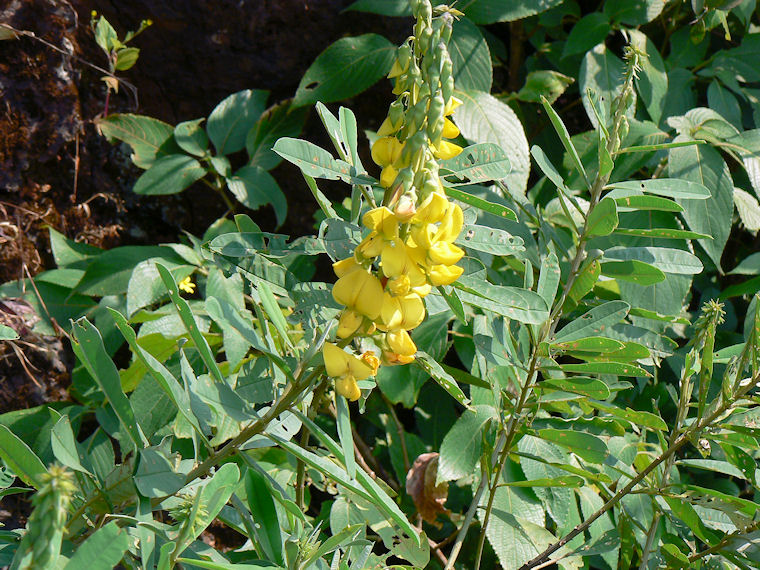
Abb.: Crotalaria
spectabilis Roth 1821
[Bildquelle: dinesh_valke. --
http://www.flickr.com/photos/91314344@N00/1651439952. -- Zugriff am
2010-11-14. --
Creative
Commons Lizenz (Namensnennung, keine kommerzielle Nutzung, keine
Bearbeitung)]
"Crotalaria sericea. Willd. iii. 975.
Annual [...]
C. sericea. Retz. Obs. v. p. 26.
Sans. Ghuntaruva.
A native of Bengal. Flowering and seed time the cold season.
Root ramous, generally annual. "
[Quelle: Roxburgh, William <1751-1815>: Flora indica, or, Descriptions of Indian plants / by the late William Roxburgh. -- Serampore : Printed for W. Thacker, 1832. -- Vol. 3, S. 273.]
Crotalaria juncea L. 1753 - Sunhemp
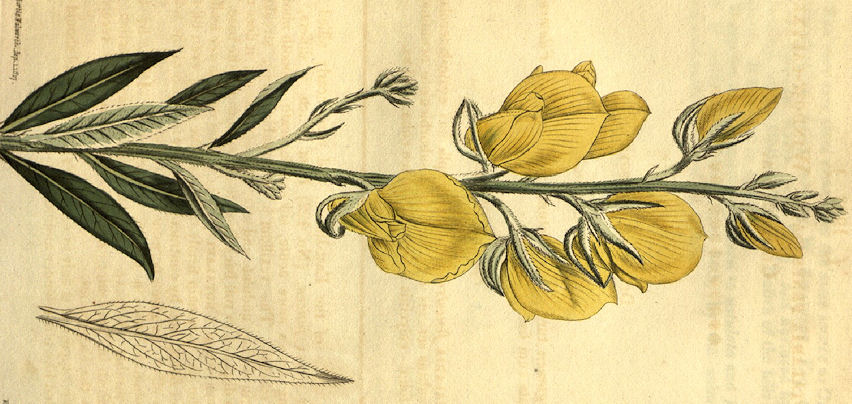
Abb.: Crotalaria juncea L. 1753 - Sunhemp
[Bildquelle: Curtis's Botanical Magazine, v. 44 (1816), Tab. 1933]
Vitaceae (Weinrebengewächse)
Kletterranke
| 26. a./b. mṛdvīkā gostanī drākṣā svādvī madhuraseti
ca मृद्वीका गोस्तनी द्राक्षा स्वाद्वी मधुरसेत् च ।२६ क। [Bezeichnungen für Vitis vinifera L. 1753 - Weinrebe - Grape Vine:]
|
Colebrooke (1807): "A grape."
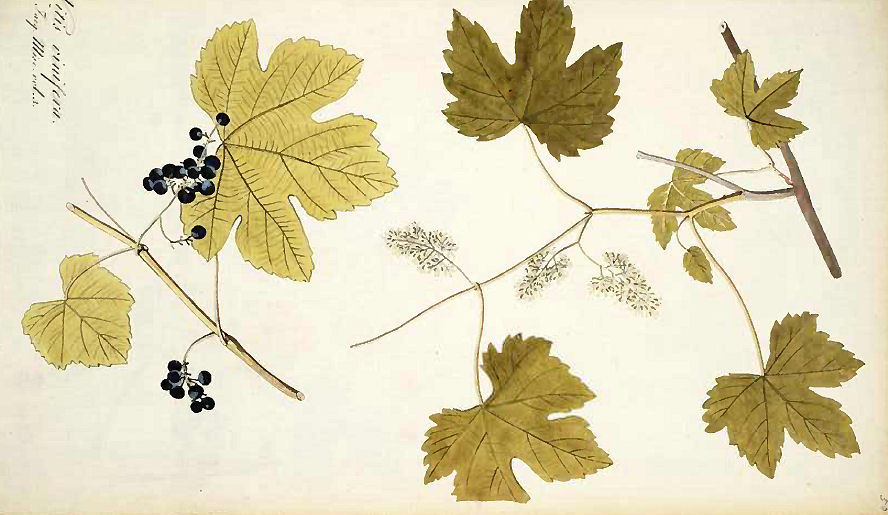
Abb.: द्राक्षा । Vitis vinifera L. 1753 - Weinrebe - Grape
Vine
[Bildquelle: Icones plantarum rariorum / editae Nicolao Josepho Jacquin. -- Vol.
1. -- 1786 - 1793. -- Tab. 50]
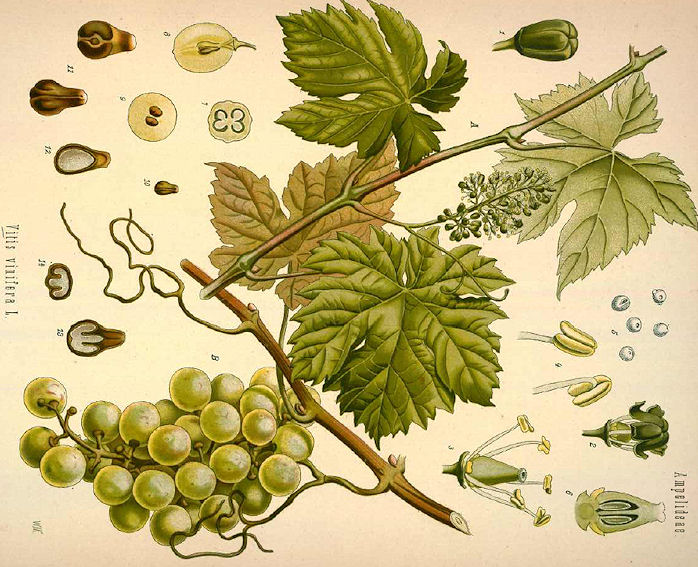
Abb.:
गोस्तनी । Vitis vinifera L. 1753 - Weinrebe - Grape Vine
[Bildquelle: Köhler, 1883-1914]
"VITIS VINIFERA, Linn. Fig.—Bentl. & Trim., t. 66.
The Vine
Hab.—N.-W. Himalayas. Cultivated elsewhere.
[...]
History, Uses, &c.—The cultivation of the Vine is of great antiquity. Noah planted a vineyard, and by drinking of the wine was made drunk. The wife of Jamshid tried to poison herself by drinking the juice of grapes, but the effects produced were such as to induce others to taste the poison. Hesiod gives directions for pruning the vine. According to Greek tradition, Dionysus taught all nations to cultivate the vine and to drink wine The Dionysus of the Greeks and the Indra of the Hindus are symbolical of the productive, overflowing, and intoxicating power of nature which often carries man away from his usual quiet and sober mode of living. The Soma of the Hindus and the original wine of Greek tradition was doubtless the celestial Amrita or Ambrosia. Grapes, in Sanskrit Draksha, are noticed by Susruta and Charaka ; in the dried state they were used in medicine on account of their demucent, laxative and cooling properties. It would also appear that a spirituous preparation was made from them, and was used as a stimulant under the name of Draksha arishta, the receipt for making which is as follows :-Raisins, 12 1/2 lbs, water 256 lbs , boil together until reduced to one-fourth and strain ; then add, treacle 50 lbs., cinnamon, cardamoms, folia malabathri, flowers of Mesua, ferrea, fruit of Aglaia Roxburghiana black pepper, long pepper and seeds of Embelia Ribes, all in fine powder, of each 2 3/4 ozs., and set aside for fermentation. Grapes are described by Dioscorides under the name of σταφυλη he also notices raisins (σταφις) and their medicinal properties. Pliny speaks of Uvae, grapes, and Acini passi,
raisins. The τρυξ οινου of the Greeks, Foex vini in Latin, is our Argol; the Mihh-el-tartir of the Arabs. Mahometan writers consider grapes and raisins to be attenuant, suppurative and pectoral; the most digestible of fruit, purifying the blood and increasing its quantity and quality; they say that they are more wholesome if kept a few days after being gathered, and that the skin and stones should not be eaten. The ashes of the wood are recommended as a preventive of stone in the bladder, cold swellings of the testes, and piles ; in the two last named diseases they are to be applied externally as well as given internally. The juice of unripe grapes, Husrum (Arab.), Ghureh (Pers.), is used as an astringent; it is the ομφακιον of Dioscorides, our Verjuice,and the Agresto of the modern Italians, who still use it in affections of the throat. The cut branches of the vine yield in spring an abundant sap, which was formerly used as a remedy for skin diseases, and is still a popular remedy in Europe for ophthalmia."[Quelle: Pharmacographia indica : a history of the principal drugs of vegetable origin met with in British India / by William Dymock [1834-1892], C. J. H. Warden and David Hooper [1858-1947]. -- Bd. 1. -- London, 1890. -- S. 357f.]
Convolvulaceae (Windengewächse)
Kletterranke
| 26. c./d. sarvānubhūtiḥ saralā tripuṭā trivṛtā
trivṛt 27. a./b. tribhaṇḍī rocanī śyāmā-pālindhyau tu suṣeṇikā
सर्वानुभूतिः सरला त्रिपुटा त्रिवृता त्रिवृत् ॥२६
ख॥ [Bezeichnungen für Operculina turpethum (L.) Silva Manso 1836 - Indian Jalap:]
|
Colebrooke (1807): "Teori : the white sort."
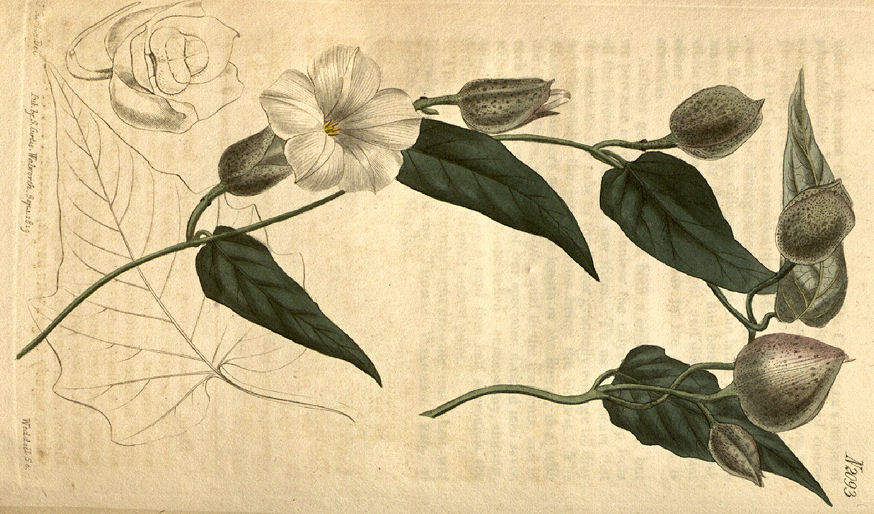
Abb.: रोचनी । Operculina turpethum (L.) Silva Manso 1836
- Indian Jalap
[Bildquelle: Curtis's Botanical Magazine, v. 46 (1817), Tab. 2093]
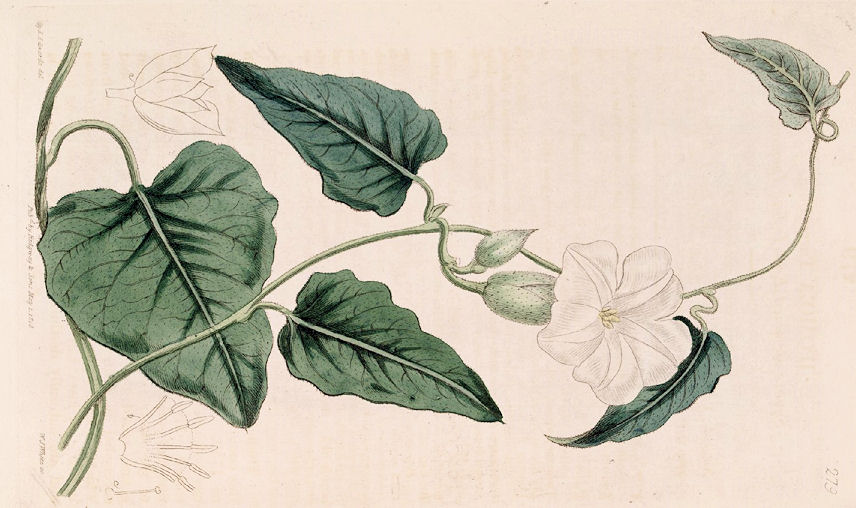
Abb.: त्रिवृत्
। Operculina turpethum (L.) Silva Manso 1836
- Indian Jalap
[Bildquelle: Botanical Register, v. 4 (1818), Tab. 279]
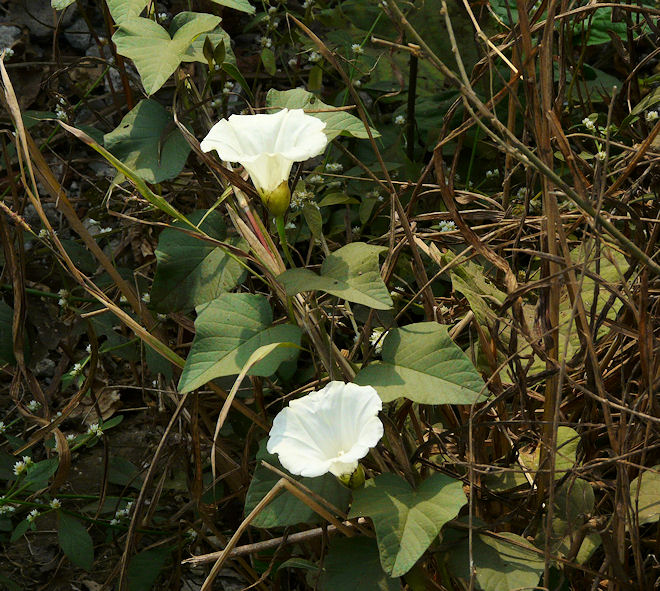
Abb.:
सर्वानुभूतिः
। Operculina turpethum (L.) Silva Manso 1836 - Indian
Jalap
[Bildquelle: dinesh_valke. --
http://www.flickr.com/photos/dinesh_valke/3031979402/. -- Zugriff am
2010-10-18. --
Creative
Commons Lizenz (Namensnennung, keine kommerzielle Nutzung, share alike)]
"Convulvulus Turpethum. Willd. sp. pl. i. 859.
Perennial.
Sans. Synonyma.
Common in hedges, &c. Flowering time the rainy season.
Root perennial. Stems twining, [...]
Obs. The bark of the roots is by the natives employed as a purgative, which they use fresh, rubbed up with milk. About six inches in length of a root as thick as the little finger, they reckon a common dose. Cattle do not eat the plant."
[Quelle: Roxburgh, William <1751-1815>: Flora indica, or, Descriptions of Indian plants / by the late William Roxburgh. -- Serampore : Printed for W. Thacker, 1832. -- Vol. 1, S. 476.]
"Ipomoea turpethum (B. Br.)
Indian Jalap[...]
Description.—Perennial, twining; [...] flowers white, with a tinge of cream colour.Fl. Nearly all the year.
Convolvulus turpethum, Linn.—Roxb. Fl. Ind. i. 476.
Malabar. Coromandel.
Medical Uses.—The bark of the root is employed by the natives as a purgative, which they use fresh rubbed up with milk. About 6 inches in length of the root is reckoned a dose. Cattle do not eat the plant. The root, being free from a nauseous taste and sinell, possesses a decided superiority over jalap, for which it might be substituted. Turpethum is derived from its Arabic name. A resinous substance exudes from the root when wounded, which might probably be turned to some account; it is merely the milky juice of the fruits dried. ^Roxburgh has a long note upon this plant, wherein he communicates the following information on the subject of its medical virtues, as received from Dr Gordon of the Bengal establishment:"The drug which this plant yields is so excellent a substitute for jalap, and deserves so much the attention of practitioners, that I doubt not the following account will prove acceptable. It is a native of all parts of continental and probably of insular India also, as it is said to be found in the Society and Friendly Isles and the New Hebrides. It thrives best in moist shady places on the sides of ditches, sending forth long climbing quadrangular stems, which in the rains are covered with abundance of large, white, bell-shaped flowers. Both root and stem are perennial. The roots are long, branchy, somewhat fleshy, and when fresh contain a milky juice which quickly hardens into a resinous substance, altogether soluble in spirits of wine. The milk has a taste at first sweetish, afterwards slightly acid; the dried root has scarcely any perceptible taste or smell. It abounds in woody fibres, which, however, separate from the more resinous substance in pounding, and ought to be removed before the trituration is completed. It is, in fact, in the bark of the root that all the purgative matter exists. The older the plant the more woody is the bark of the root; and if attention be not paid in trituration to the removal of the woody fibres, the quality of the powder obtained must vary in strength accordingly. It is probably from this circumstance that its character for uncertainty of operation has arisen, which has occasioned its disuse in Europe. An extract which may be obtained in the proportion of one ounce to a pound of the dried root would not be liable to that objection. Both are given in rather larger proportion than jalap. Like it, the power and certainty of its operation are very much aided by the addition of cream of tartar to the powder, or of calomel to the extract I have found the powder in this form to operate with a very small degree of tenesmus and very freely, producing three or four motions within two to four hours. It is considered by the natives as possessing peculiar hydragogue virtues, but I have used it also with decided advantage in the first stages of febrile affections."
According to the Kaja Nirghaunta, the Teoree is dry and hot; a good remedy against worms; a remover of phlegm, swellings of the limbs, and diseases of the stomach. It also heals ulcers, and is useful in diseases of the skin. It is known to be one of the best purgatives.
The Bhavaprakasha has the following observation: "The white Teoree is cathartic; it is pungent; it increases wind, is hot and efficacious in removing cold and bile; it is useful in bilious fevers and complaints of the stomach. The black sort is somewhat less efficacious; it is a violent purgative, is good in faintings, and diminishes the heat of the body in fevers with delirium."—(Ainslie. Roxb. Wallich's Obs.) It should be here added that it has entirely fallen into disuse in European practice; and Sir W. O'Shaughnessy found it so uncertain in its operation, that he pronounced it as unworthy of a place in the pharmacopoeia.—Pharm. of India."[Quelle: Drury, Heber <1819 - 1872>: The useful plants of India : with notices of their chief value in commerce, medicine, and the arts. -- 2d ed. with additions and corrections. London : Allen, 1873. -- xvi, 512 p. ; 22 cm. -- s.v.]
"IPOMOEA TURPETHUM, Br. Fig.—Bot. Reg., t.279; Bot. Mag., t. 2093
Hab.—Throughout India and Ceylon.
[...]
History, Uses, &c.—This drug, which bears the Sanskrit names of Triputa, "three-angled, " Trivrit, "three-fold," Kutaruna, Tinti and Nindika, is described in the Nighantas as pungent, cathartic, dry, sweet and hot; a dispellent of wind, fever, phlegm, bile and melancholy, and bitter and digestive. Sanskrit writers mention two varieties, Sveta—"white," and Krishna or Shyama, " black " ; the latter kind bears the names of Kala, Kalaparnu and Kalameshi and is described as a violent purgative. Its source has not been satisfactorily ascertained, but it is supposed to be the root of Lettsomia atropurpurea, Clarke,a native of Nipal and Sikkim. I. Turpethum is sacred to Siva, to whom the flowers are offered by the Hindus. It is one of the most common native cathartics, and has probably been in use all over India from a very early date. The usual method of administration is to rub down about a drachm of the root or stem with water, and add to it some rock salt and ginger, or sugar and black pepper. Under the name of Turbud, an Arab corruption of Triputa, Mahometan writers also mention two kinds, white and black, and direct the black to be avoided on account of its poisonous properties, which are said to resemble those of Hellebore. As regards the properties of Turbud they say that it is a drastic purgative of phlegmatic humors and bile; its action is promoted by combination with ginger; it is particularly beneficial in rheumatic and paralytic affections. Combined with chebulic myrobalans it is useful in melancholy and dropsies.
Ainslie says—"The Convulvulus Indicus alatus maximus had long a place in the British Materia Medica, but of late years has fallen into disuse. I find it mentioned by Avicenna under the name of Turbud ; but the first among the Arabs who prescribed it was Mesue (see Spreng., Rei Herbaria, Vol. I, p, 249), also Rhazes (c. 173). Alston in his Materia Medica speaks of turpeth as a strong and resinous cathartic, and recommended in his days in gout, dropsy and leprosy. The plant is known to the modern Greeks by the name of τουρπεθ ; it is a native of the Society and Friendly Isles, as well as of India, of the New Hebrides and of New Holland. Virey, in his Histoire Naturelle des Medicaments (p. 184), speaks of the root of the Convolvulus Turpethum as more drastic than the common jalap, which, however, it does not seem, is to be found in India." (Mat. Ind. II., p. 384.)
Wallich, Gordon, and Glass considered this drug to be of considerable value as a catharic. Sir W. O'Shaugnessy (Beng. Disp. p. 504) found it so uncertain in its operations that he pronounced it unworthy of a place in the Pharmacopoeia. In this opinion he is undoubtedly correct, as the active resins are present in the root in a much smaller proportion than in jalap, but as the drug is very cheap it might be used with advantage for preparing the commercial resin. Turpeth when administered by the mouth excites irritation of the stomach with nausea, colic, and watery, mucous stools ; in excessive doses it excites inflammation of the gastro-intestinal mucous membrane and bloody dejections. Like jalap it is an hepatic stimulant, increasing the secretion of biliary matter and rendering it more watery. Being a hydrogogue cathartic it is useful for the removal of dropsical effusions, and in such cases it acts best in combination with ginger in combination with ginger and bitartrate of potash. The dose should eo about double that of the ordinary jalap powder of commerce, equal to from 4 to 5 grains of the resin."
[Quelle: Pharmacographia indica : a history of the principal drugs of vegetable origin met with in British India / by William Dymock [1834-1892], C. J. H. Warden and David Hooper [1858-1947]. -- Bd. 2. -- London, 1891. -- S. 527ff.]
Convolvulaceae (Windengewächse)
Winde
| 27. tribhaṇḍī rocanī śyāmā-pālindhyau tu suṣeṇikā kālā masūravidalārdhacandrā kālameṣikā
त्रिभण्डी रोचनी श्यामा-पालिन्ध्यौ तु सुषेणिका । [Bezeichnungen für Ipomoea petaloides Choisy (?):]
|
Colebrooke (1807): "The black sort."
Die Identifikation (in Bhāvaprakāśa I, S. 259) mit Ipomoea petaloides Choisy bzw. die Existenz der so benannten Pflanze erscheint mir fraglich, da ich keinerlei zuverlässige Angaben zu Ipomoea petaloides Choisy finden kann. Vermutlich ist es nur eine dunkelblütige - oder in einem anderen Organ dunkle bzw. schwarze - Varietät vom Vorigen, Operculina turpethum (L.) Silva Manso 1836 - Indian Jalap.
Mehrjährige, krautige, bis 1 m hohe Pflanze
| 28. a./b. madhukaṃ klītakaṃ yaṣṭimadhukaṃ
madhuyaṣṭikā मधुकं क्लीतकं यष्टिमधुकं मधुयष्टिका ।२८ क। [Bezeichnungen für Glycyrrhiza glabra L. 1753 - Lakritze - Liquorice:]
|
Colebrooke (1807): "Liquorice. Glycyrrhiza glabra ? Or Abrus precatorius albus [siehe oben zu Vers 16c./d.], the root of which is substituted for liquorice."
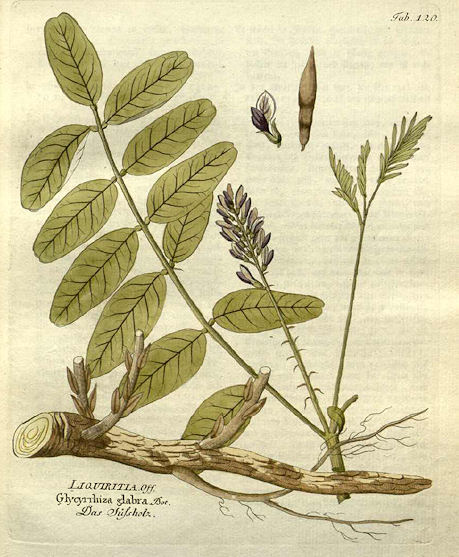
Abb.: मधुकम्
। Glycyrrhiza
glabra L. 1753 - Lakritze - Liquorice
[Bildquelle: Icones
plantarum medico-oeconomico-technologicarum cum earum fructus ususque
descriptione =Abbildungen aller medizinisch-ökonomisch-technologischen
Gewächse mit der Beschreibung ihres Gebrauches und Nutzens. -- Wien, 1800 -
1822. -- Bd. 2, Tab. 120]
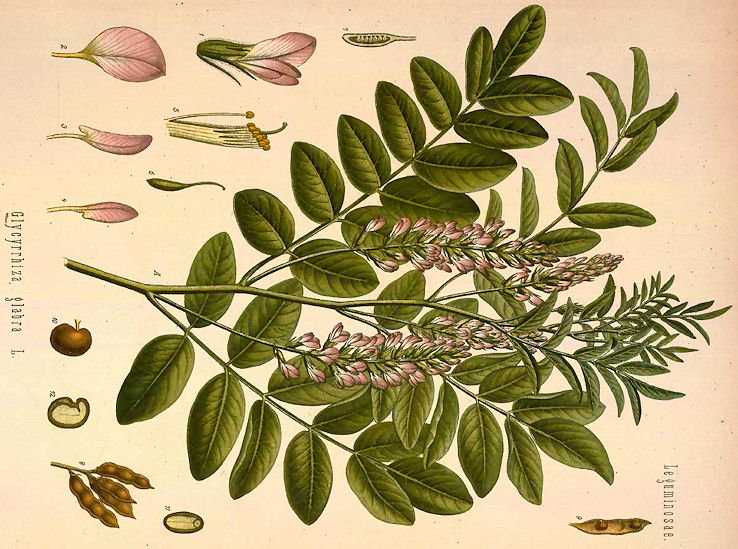
Abb.: मधुकम्
। Glycyrrhiza
glabra L. 1753 - Lakritze - Liquorice
[Bildquelle: Köhler, 1883-1914]
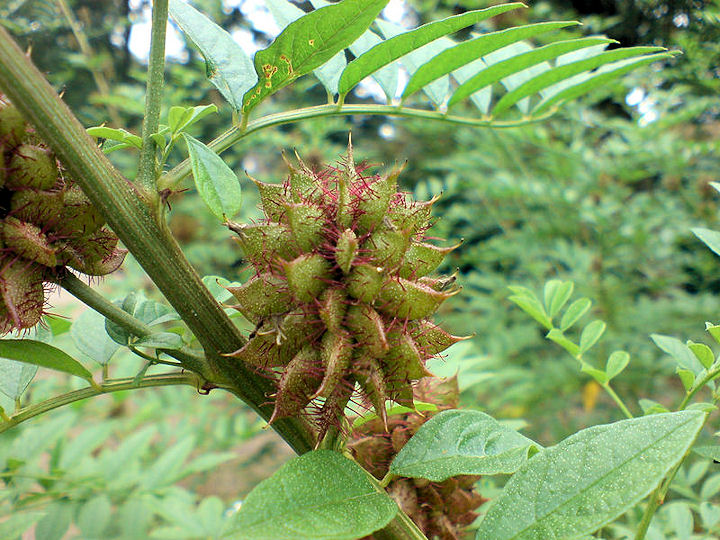
Abb.: यष्टिमधुकम्
। Glycyrrhiza
glabra L. 1753 - Lakritze - Liquorice, Bremen, Deutschland
[Bildquelle: Tubifex / Wikimedia. -- GNU FDLicense]
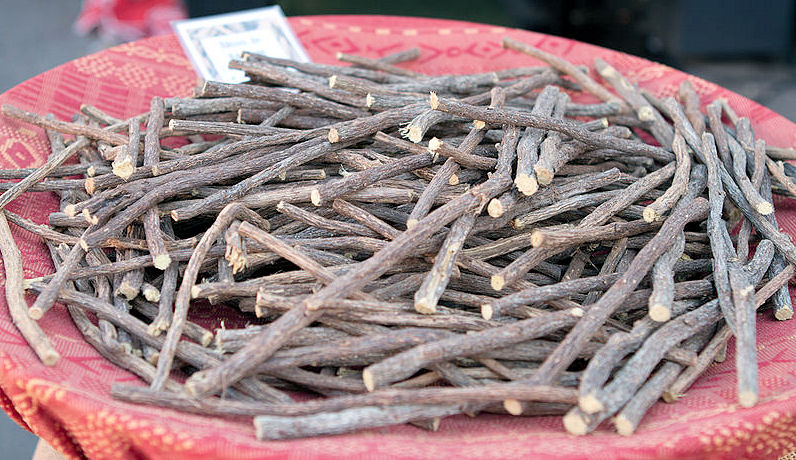
Abb.: मधुयष्टिका
। Glycyrrhiza
glabra L. 1753 - Lakritze - Liquorice, Frankreich
[Bildquelle: Georges Seguin / Wikimedia. -- GNU FDLicense]
"GLYCYRRHIZA GLABRA, Linn. Fig.—Bentl. and. Trim., t. 74.
[...]
History, Uses, &c.—Liquorice grows wild in Arabia Persia, Turkistan and Afghanistan, and has been introduced into the Punjab and Sind. Kinneir observed it growing abundantly near Basra, and Aitchison found it growing abundantly all over the Badghis and throughout the Harirud and Khorasan districts. In Persia glass-bottle-makers use the wood for melting their materials, as they say it gives a greater heat
than any other kind of fuel. The root, in Sanskrit called Yashtimadhu and Madhuka, must have been known to the Hindus from a very early date, as it is mentioned by Susruta. Hindu works describe it as demulcent, cooling and useful in cough, hoarseness, &c. It is also recommended as a flavouring agent, and enters into the composition of many external cooling applications.Abu Hanifeh describes Sus as a well-known plant, the expressed juice of which is an ingredient in medicine. He says the roots are sweet and the branches bitter. El Mutarrizi in the Mughrib states that the leaves are put into the beverage called nabid to make it strong. The modern Arabs call the root Irkes-sus, and make a strong infusion of it which they drink. The dried juice is called Rab-es-sus; it is made by the Arabs, Turkomans, and Persians at Yezd. In Persia the liquorice plant is called Mehak and Mazhu.
The author of the Makhzan-el-Adwiya gives a lengthy description of the plant, and directs the root to be decorticated before it is used. He says that the Egyptian is the best, next that of Irak, and then Syrian. The root is considered hot, dry and suppurative, demulcent and lenitive, relieving thirst and cough, and removing unhealthy humours, also diuretic and emmenagogue, useful in asthma and irritable conditions of the bronchial passages. Ibn Sina recommends the decoction in cold colic ; it is also dropped into the eyes to strengthen the sight. A poultice made of the leaves is said to be a cure for scald head and stinking of the feet or arm pits. Muhammad bin Ahmad
and Yohanna bin Serapion recommend the seeds as being the most active part of the plant.For an account of the history and cultivation of liquorice in Europe, the Pharmacographia may be consulted."
[Quelle: Pharmacographia indica : a history of the principal drugs of vegetable origin met with in British India / by William Dymock [1834-1892], C. J. H. Warden and David Hooper [1858-1947]. -- Bd. 1. -- London, 1890. -- S. 491f.]
Fabaceae (Hülsenfrüchtler)
Kletterranke
| 28. c./d. vidārī kṣīraśuklekṣugandhā kroṣṭī tu yā
sitā 29. a./b. anyā kṣīravidārī syān mahāśvetarkṣagandhikā
विदारी क्षीरशुक्लेक्षुगन्धा क्रोष्टी
तु या सिता
॥२८ ख॥ [Bezeichnungen für Pueraria tuberosa (Roxb.ex Willd.) DC 1825:]
Die weiße Varietät heißt क्रोष्टी - kroṣṭī f.: Kroṣṭī Eine andere Varietät heißt:
|
Colebrooke (1807): "Bhuincaonra : the dark sort. Convolvulus paniculatus [L. 1753 = Ipomoea mauritiana Jacq.]." [29a./b.:] "Another sort (pale)."
Pueraria tuberosa (Roxb.ex Willd.) DC 1825
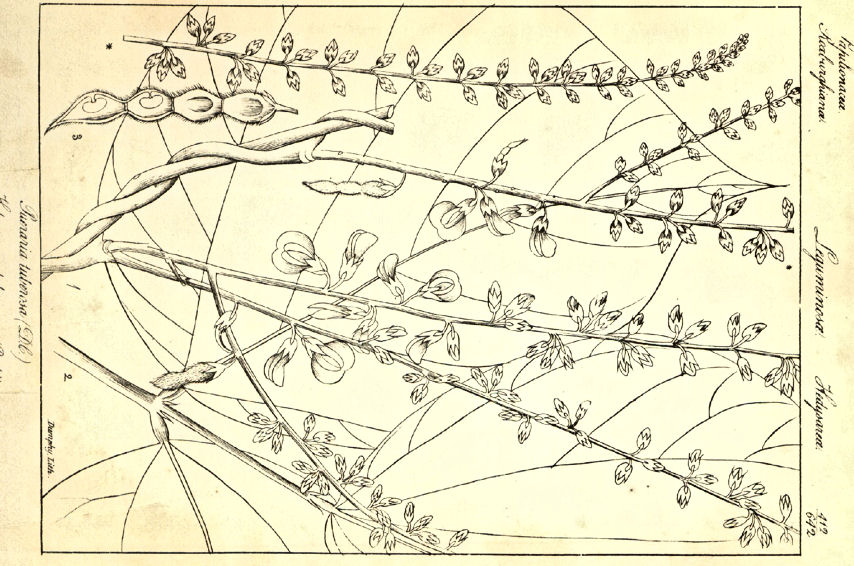
Abb.: विदारी
। Pueraria tuberosa
(Roxb.ex Willd.) DC 1825
[Bildquelle: Wight Icones II, Tab. 412, 1843]
"Hedysarum tuberosum. Willd. iii. 1197.
Shrubby, twining ; [...]
Kadsumi. Banks Icon. Kaempf. tab. 25.
A rare species, a native of the valleys far up amongst the mountains. It flowers during the hot season, at which time it is perfectly naked of leaves, being deciduous about the beginning of the cold season.
[...]
The root peeled and bruised into a cataplasm is employed by the natives of the mountains where it grows to reduce swellings of the joints."
[Quelle: Roxburgh, William <1751-1815>: Flora indica, or, Descriptions of Indian plants / by the late William Roxburgh. -- Serampore : Printed for W. Thacker, 1832. -- Vol. 3, S. 363f.]
"Pueraria tuberosa (Dec.) N. O. Leguminosae. [...]
Description.—Twining shrub; [...] flowers blue.
Fl. March—April.
W. & A. Prod. i. 205.— Wight Icon. t. 412.
Hedysarum tuberosum, Roxb. Fl. Ind. iii 363.
Circars. Malabar hills.
Medical Uses.—A rare species, according to Roxburgh; a native of valleys far up amongst the mountains. Its leaves are deciduous about the beginning of the cold season. Cataplasms are made from the large tuberous roots, used by the natives to reduce swellings in the joints.—Roxb."
[Quelle: Drury, Heber <1819 - 1872>: The useful plants of India : with notices of their chief value in commerce, medicine, and the arts. -- 2d ed. with additions and corrections. London : Allen, 1873. -- xvi, 512 p. ; 22 cm. -- s.v.]
"PUERARIA TUBEROSA, DC.
Fig.—Wight Ic. t. 412.
Hab.—Western Himalaya, tropical zone. W. Peninsula,
[...]
History, Uses, &c.—Roxburgh remarks that the root is an immense tuber, with acrid properties, and that it is used as a cataplasm to reduce swellings of the joints. O'Shaughnessy says that it is a native of the Punjab, and Cleghorn states that the tubers are exported to the plains. It may possibly be the Shurava of Sanskrit writers."
[Quelle: Pharmacographia indica : a history of the principal drugs of vegetable origin met with in British India / by William Dymock [1834-1892], C. J. H. Warden and David Hooper [1858-1947]. -- Bd. 1. -- London, 1890. -- S. 424]
Ipomoea mauritiana Jacq.
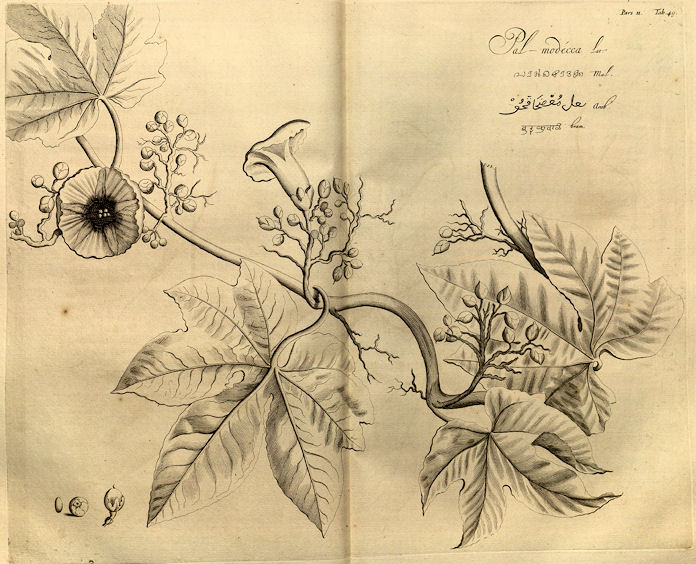
Abb.: Ipomoea mauritiana
Jacq.
[Bildquelle: Hortus malabaricus XI. Fig. 49, 1692]
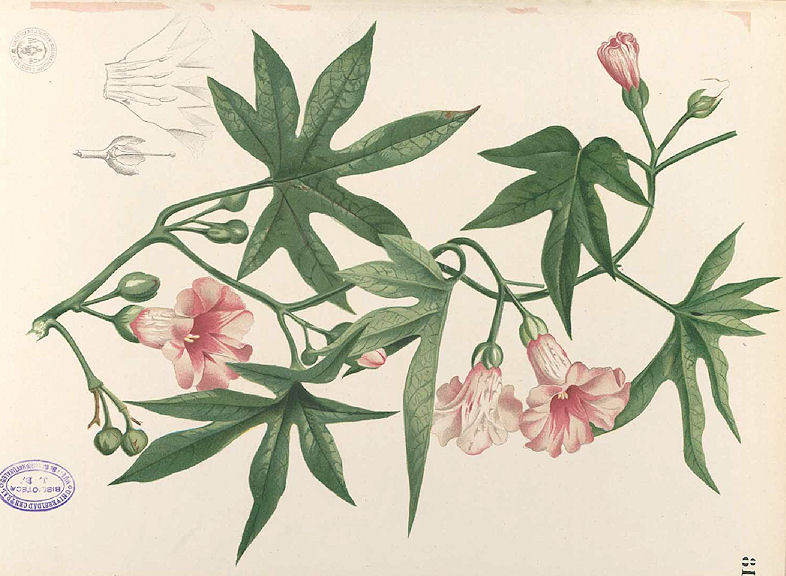
Abb.: Ipomoea mauritiana
Jacq.
[Bildquelle: Flora de Filipinas, 1880 /
Wikipedia. -- Public domain]
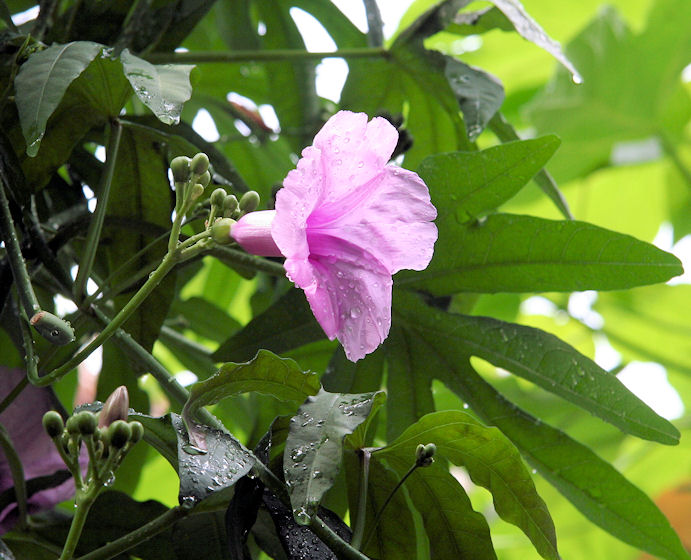
Abb.: Ipomoea mauritiana
Jacq.
[Bildquelle: Michael Wolf / Wikimedia. -- GNU FDLicense]
"Convulvulus paniculatus. Willd, sp. pl. i. 866.
Root tuberous, perennial, twining, smooth.
[...]
Pal-modecca. Rheed. Mal. xi. 101. t. 49. (Exclude Modecca. Rheed. Mal. viii. 39. t. 20.)
Ipomoea mauritiana. Jacq. Collect, iv. 206.
A native of hedges, thickets, &c.
Flowering-time the wet season.
Root perennial, tuberous. Stems and branches perennial ; [...]
Obs. Cattle eat it. The root is cathartic, and as such used by the natives where is grows."
[Quelle: Roxburgh, William <1751-1815>: Flora indica, or, Descriptions of Indian plants / by the late William Roxburgh. -- Serampore : Printed for W. Thacker, 1832. -- Vol. 1, S. 478.]
Verbenaceae (Eisenkrautgewächse)
Einjähriges Kraut
| 29. c./d. lāṅgalī śāradī toyapippalī śakulādanī लाङ्गली शारदी तोयपिप्पली शकुलादनी ॥२९ ख॥ [Bezeichnungen für Phyla nodiflora (L.) Greene 1899 - Teppichverbene - Frogfruit:]
|
Colebrooke (1807): "Canchara. Jussiaea repens [L. 1753]."
Phyla nodiflora (L.) Greene 1899 - Teppichverbene - Frogfruit
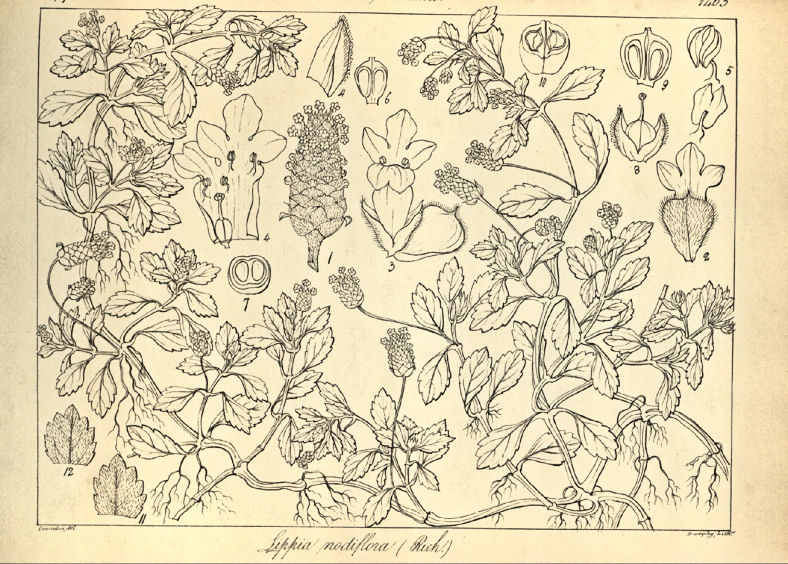
Abb.: शारदी । Phyla nodiflora (L.) Greene 1899 -
Teppichverbene - Frogfruit
[Bildquelle: Wight Icones IV, Tab. 1463, 1850]
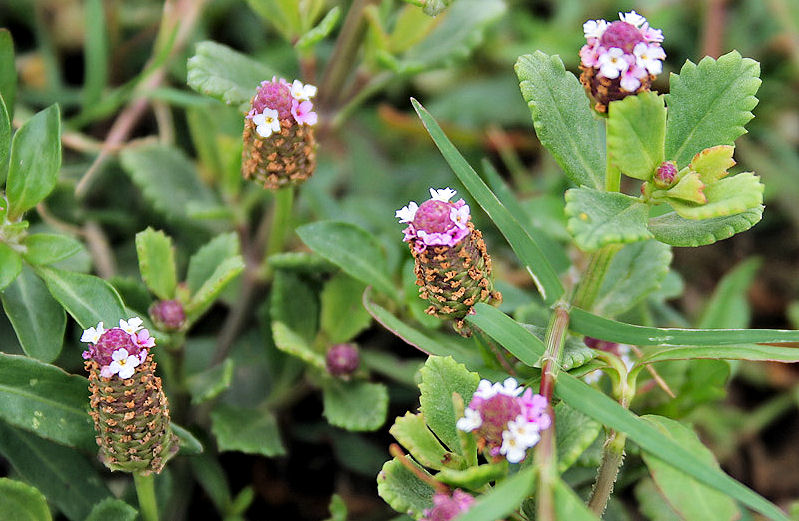
Abb.: तोयपिप्पली
। Phyla nodiflora (L.) Greene 1899 -
Teppichverbene - Frogfruit, Hyderabad -
హైదరాబాద్ -
حیدرآباد, Andhra Pradesh
[Bildquelle: J. M. Garg / Wikipedia. --
GNU FDLicense]
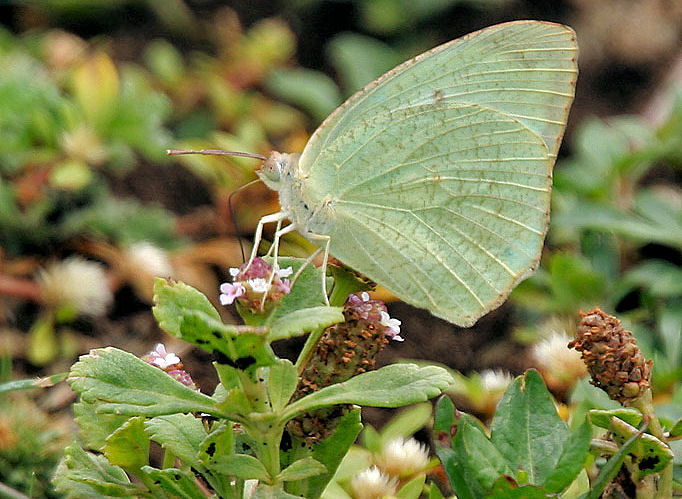
Abb.: लाङ्गली
। Mottled Emigrant (Catopsilia pyranthe) auf
Phyla nodiflora (L.) Greene 1899 - Teppichverbene - Frogfruit, Hyderabad -
హైదరాబాద్ -
حیدرآباد, Andhra Pradesh
[Bildquelle: J. M. Garg / Wikipedia. --
GNU FDLicense]
"LIPPIA NODIFLORA, Rich. Fig.—Wight III, t. 173b, fig. 2, and Ic. t. 1463, Sibth. Fl. Gr., t. 553; Lam. ill., t. 17.
Hab.—Throughout India and Ceylon.
[...]
History, Uses, &C»—According to Ainslie, the Sanskrit name is Vasira, but the Nighantas do not mention any plant
bearing this name vaśīra , with the synonym of Vasuka occurs, however, in Sanskrit literature, as the name of a plant. L. nodifiora is considered by the Hindus to be febrifuge and diuretic, and is administered in gonorrhoea combined with cumin seed. Locally it is applied in the form of paste to promote suppuration. The author of the Makhzan-el-Adwiya describes it under the name of Bukkan as hot and dry; he states that an infusion is useful in the febrile stage of colds, and that it is diuretic and useful in lithiasis. A poultice composed of the fresh plant is a good maturant for boils.Ainslie has the following notice of it: "The tender stalks and leaves, which are in a slight degree bitter, the native practitioners prescribe, when toasted, in infusion, in cases of children's indigestions, to the extent of two ounces twice daily; it is also sometimes ordered as a drink for women after lying-in. The plant is a native of Southern Italy and Sicily, as well as India, and has at different times had very different appellations bestowed on it, it being the Blairia nodiflora of Gaertner, the Zapania nodiflora of Lamarck, and the Vervena capitata of Forskahl."
[Quelle: Pharmacographia indica : a history of the principal drugs of vegetable origin met with in British India / by William Dymock [1834-1892], C. J. H. Warden and David Hooper [1858-1947]. -- Bd. 3. -- London, 1893. -- S. 57f.]
Jussiaea repens L. 1753
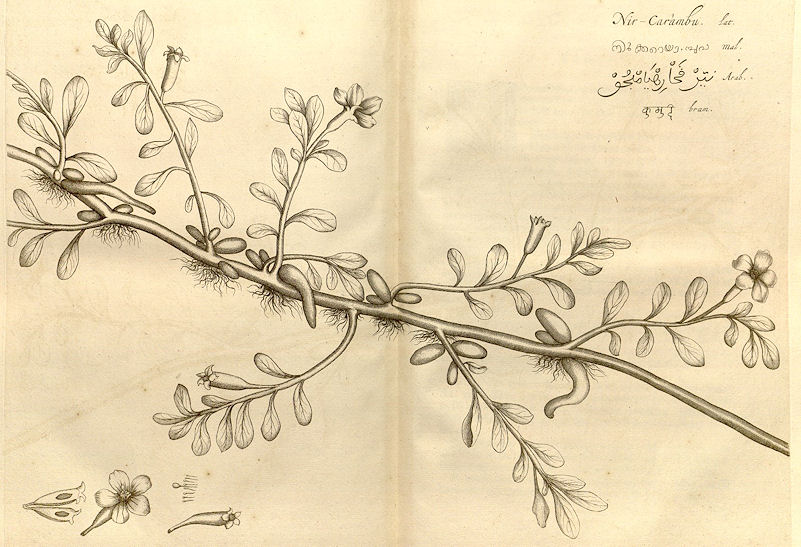
Abb.: Jussiaea repens
L. 1753
[Bildquelle: Hortus malabaricus II. Fig. 51, 1679]
"Jussieua repens. Willd. 2. 574.
Annual ;
[...]
Nir-carambu. Rheed. Mal.. 2. t. 51.
Sans. Bhooluvungga, also Langulee.
[...]
It is found in most parts of India, floating on lakes, and pools of fresh water ; in flower during the rainy season."
[Quelle: Roxburgh, William <1751-1815>: Flora indica, or, Descriptions of Indian plants / by the late William Roxburgh. -- Serampore : Printed for W. Thacker, 1832. -- Vol. 2, S. 401.]
Apiaceae (Doldenblütler)
Bis 1 m hohes Kraut
| 30. a./b. kharāśvā kāravī dīpyo mayūro locamastakaḥ खराश्वा कारवी दीप्यो मयूरो लोचमस्तकः ।३० क। [Bezeichnungen für Apium graveolens L. 1753 - Sellerie - Celery:]
|
Colebrooke (1807): "Celosia. Celosia cristata [L. = Celosia argentea var. cristata (L.) Kuntze 1891 - Hahnenkamm - Cockscomb]."
Apium graveolens L. 1753 - Sellerie - Celery
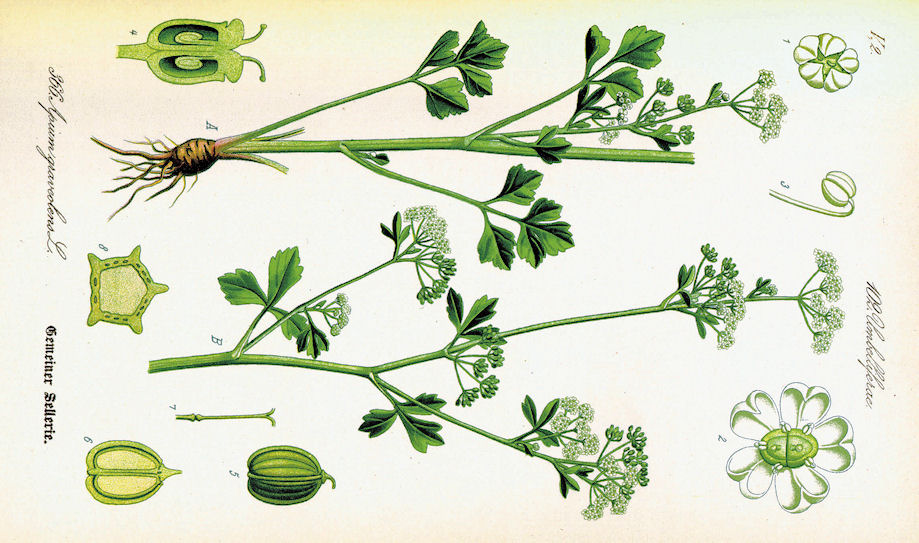
Abb.: दीप्यः । Apium graveolens
L. 1753 - Sellerie - Celery
[Bildquelle: Thomé 1885 / Wikimedia. -- Public domain]
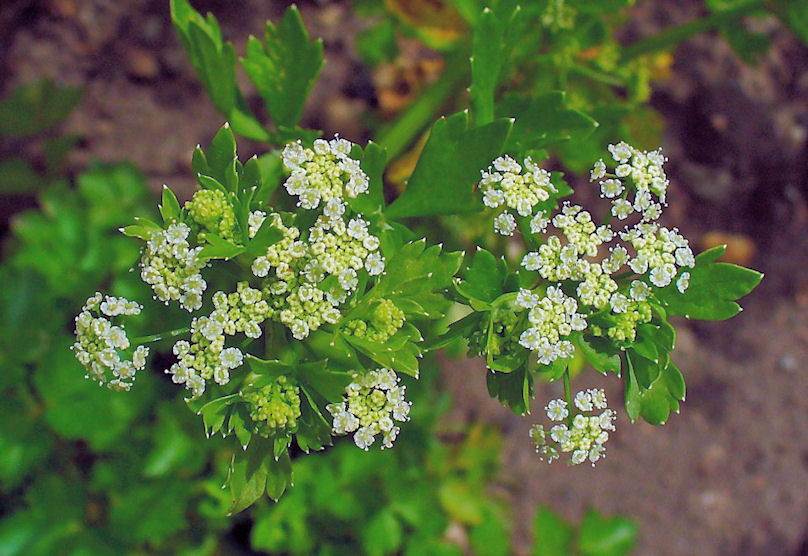
Abb.: मयूरः
। Apium graveolens
L. 1753 - Sellerie - Celery, Karlsruhe, Deutschland
[Bildquelle: H. Zell / Wikimedia. -- GNU FDLicense]
"APIUM GRAVEOLENS, Linn.
Fig.—Eng. Bot. xvii, t. 1210.
Celery
Hab.—N.-W. Himalaya, Persia.
[...]
History, Uses, &c.—Celery does not appear to have been known to the ancient Hindus. The Arabians probably obtained their knowledge of it from the Greeks. Dioscorides describes five kinds of σελιον. Sprengel refers two of these to Apium gravcolens, viz., σελιον κηπαιον and ελαιοσελιον, Var. sativum et sylvestre. The Selinon of Theophrastus (H. P, i, 15, 16, 19; iv. 9, viii. 5) was probably Celery; he also mentions Eleioselinon (vii., 6). Hipposelinon (ix., 1.), a diuretic, the root yielding a gum like scammony and Oreoselinon (vii., C).
Muhammad Husain, who wrote in India about one hundred and twenty years ago, informs us that Karafs is the celery of the Europeans and the Udasaliyun of the Greeks. He describes three other kinds, viz., Sakhri, in Greek Fiturasaliyun ; Nabti, in Greek Akusaliyun; and Tari, in Greek Shamariuiyun. What all of these may be, it is difficult to decide. Fiturasaliyun is now the bazar name in Bombay for the fruits of Prangos pabularia, but it is evidently a corruption of the Greek Petroselinon, and had once a different meaning, being described in Arabic works as like Ajowan*. The fruits imported into Bombay from Persia under the name of Karafs, and sold in the bazars as Bori-ajmud, agree in structure with those of A. graveolens. Mahometan writers describe Karafs as deobstruent and resolvent, and use it in the form of a poultice with barley meal; they recommend it internally as a pectoral and as a tonic and carminative adjunct to purgatives, also as a diuretic, emmenagogue, lithontriptic, and alexipharmic.
In European medicine apiol, a camphor common to the fruits of this plant and of parsley, has been recommended as an emmenagogue and febrifuge, but more exact observation has proved its inutility. The physiological effects produced by this substance are headache and passing intoxication, and after repeated ingestion, digestive disturbances, loss of appetite, and
Description.-—Karafs or Bori-ajmud imported into Bombay from Persia is a very small fruit.
*Adams considers πετροσελιον to be the Stone Parsley, Petroselinum mecedonicum, still cultivated in Europe."
[Quelle: Pharmacographia indica : a history of the principal drugs of vegetable origin met with in British India / by William Dymock [1834-1892], C. J. H. Warden and David Hooper [1858-1947]. -- Bd. 2. -- London, 1891. -- S. 124f.]
Celosia argentea L. 1753
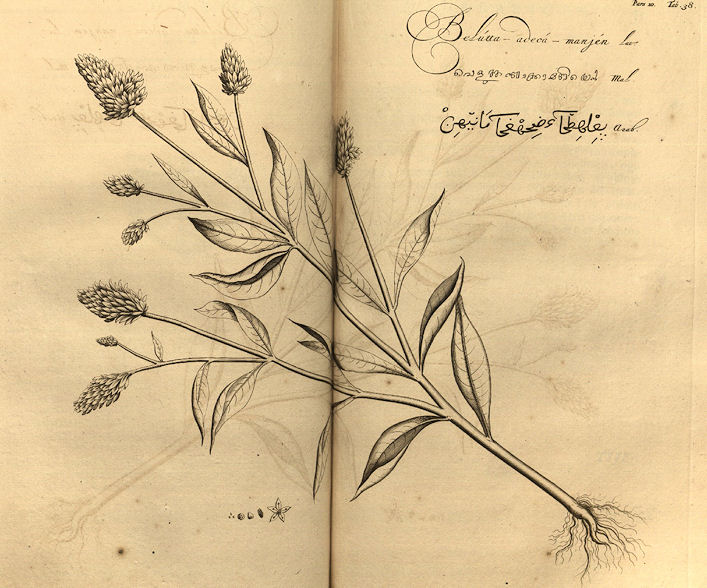
Abb.: Celosia argentea
L. 1753
[Bildquelle: Hortus malabaricus X. Fig. 38, 1690]
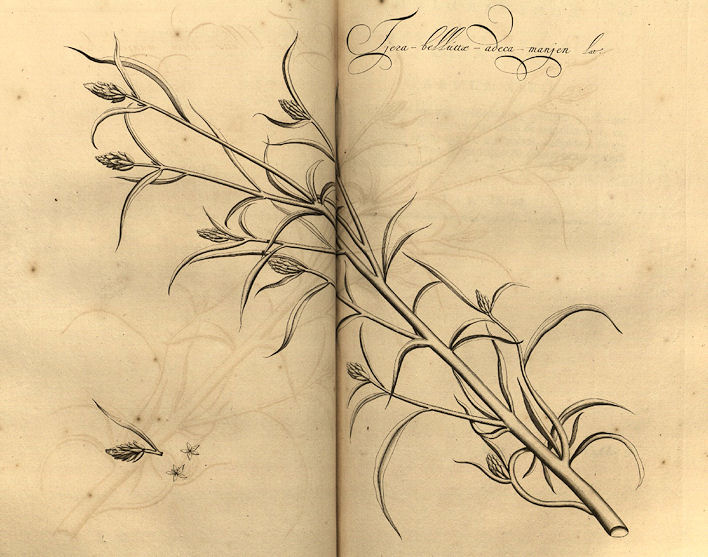
Abb.: Celosia argentea
L. 1753
[Bildquelle: Hortus malabaricus X. Fig. 39, 1690]
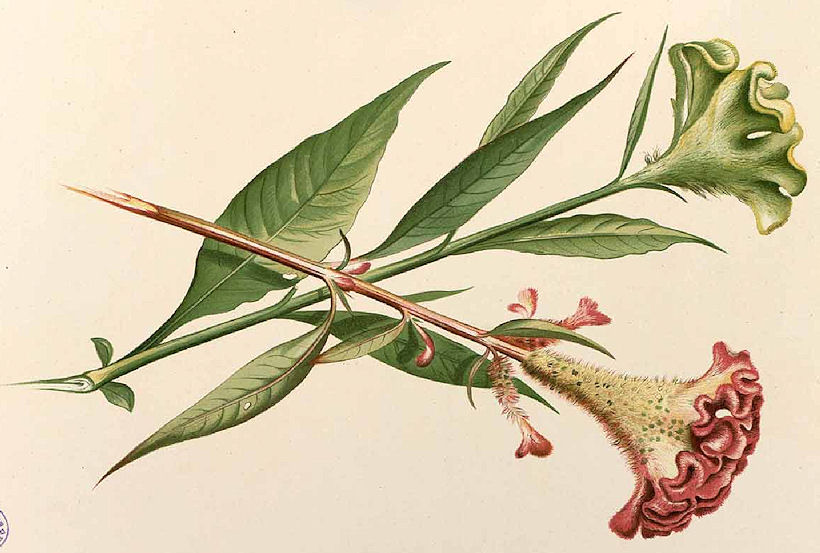
Abb.: Celosia argentea var.
cristata (L.) Kuntze 1891 - Hahnenkamm - Cockscomb
[Bildquelle: Flora de Filipinas, 1880 / Wikipedia. -- Public domain]
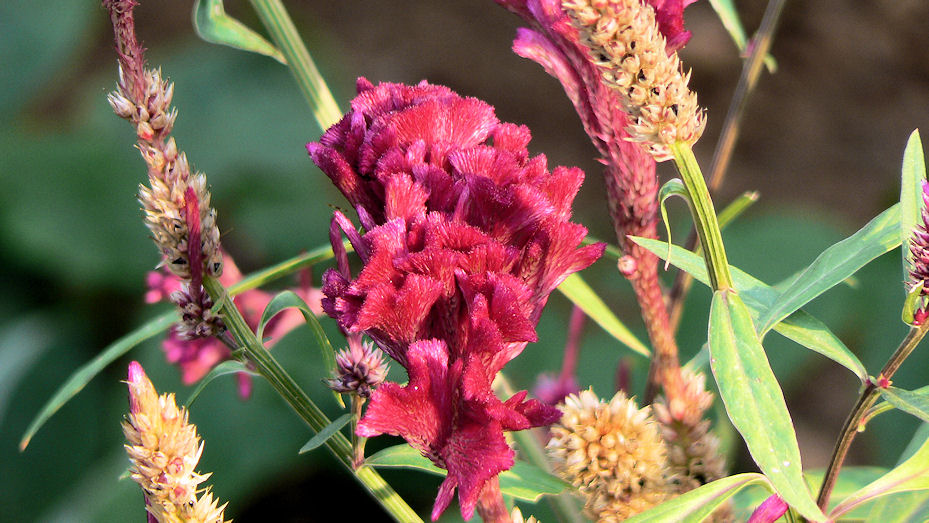
Abb.: मयूरः । Celosia argentea var.
cristata (L.) Kuntze 1891 - Hahnenkamm - Cockscomb, Maharashtra
[Bildquelle: dinesh_valke. --
http://www.flickr.com/photos/dinesh_valke/312647066/. -- Zugriff am
2010-11-14. --
Creative
Commons Lizenz (Namensnennung, keine kommerzielle Nutzung, keine
Bearbeitung)]
"CELOSIA ARGENTEA, Linn.
Fig.—Wight Ic, t. 1767; Rheede, Hort. Mal. v., t. 38, 39.
Hab.—Throughout India and tropical Asia.
[...]
History, Uses, &c.—This common annual plant is considered by some to be the Vitunna of Sanskrit writers ; when young and tender it is eaten as a vegetable, but is considered to be very heating. The seeds are considered an efficacious remedy in diarrhoea. Indian Mahometan writers on Materia Medica have adopted Sarwali as a substitute for the βρεταννικη of Dioscorides, and the Herba Britaunica of Pliny, which has been identified by Prof. Muntingius of Groningen as Rumex Hydρolapathum, Huds., our Water Dock, the Patience aquatique of the French, and Wasserampfer of the Germans. The author of the Mufaridat-i-Nmiri states that 180 grains of the seeds, with an equal quantity of sugar-candy, taken daily in a cup of milk, is a most powerful aphrodisiac.
Dr. Watt (Dict. Econ. Prod. Ind., ii. 240) states, on the authority of the Rev. A. Campbell, that the Santals extract a medicinal oil from the seeds."
[Quelle: Pharmacographia indica : a history of the principal drugs of vegetable origin met with in British India / by William Dymock [1834-1892], C. J. H. Warden and David Hooper [1858-1947]. -- Bd. 3. -- London, 1893. -- S. 139f.]
Apocynaceae (Hundsgiftgewächse)
Kletterranke
| 30. c./d. gopī śyāmā śārivā syād anantotpalaśārivā गोपी श्यामा शारिवा स्याद् अनन्तोत्पलशारिवा ॥३० ख॥ [Bezeichnungen für Cryptolepis buchanani Roem. & Schult.:]
|
Colebrooke (1807): "Syama-lata. Interpretations differ ; some referring to the two last terms, others the whole line, to a different plant."
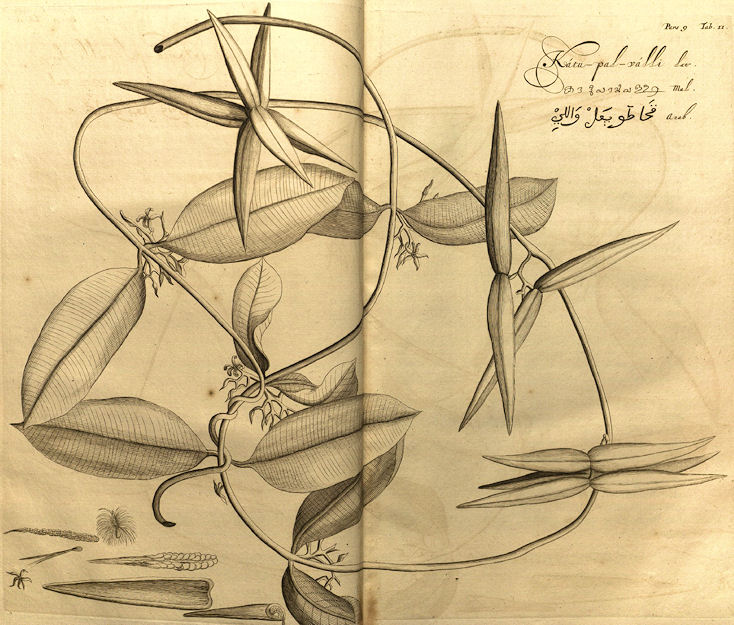
Abb.: गोपी । Cryptolepis buchanani Roem. & Schult.
[Bildquelle: Hortus malabaricus IX. Fig. 11, 1689]
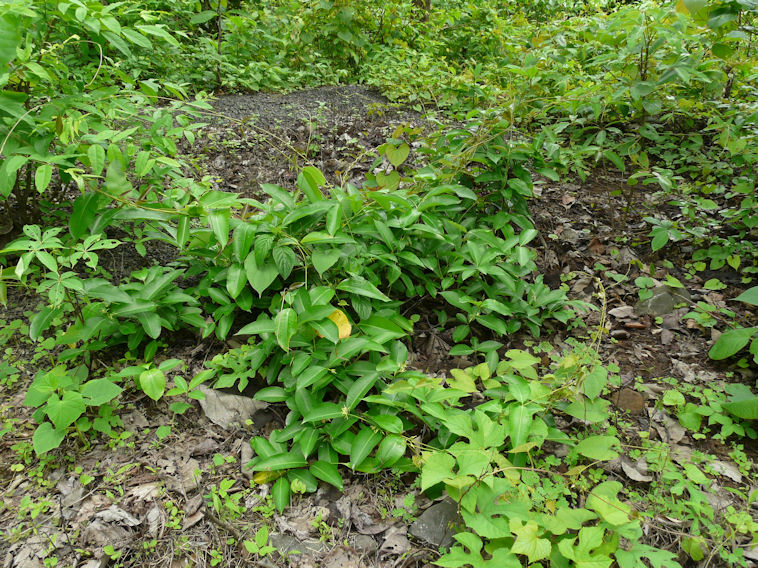
Abb.: अननता
। Cryptolepis
buchanani Roem. & Schult.
[Bildquelle: dinesh_valke. --
http://www.flickr.com/photos/dinesh_valke/2618299416/. -- Zugriff am
2010-10-18. --
Creative
Commons Lizenz (Namensnennung, keine kommerzielle Nutzung, share alike)]
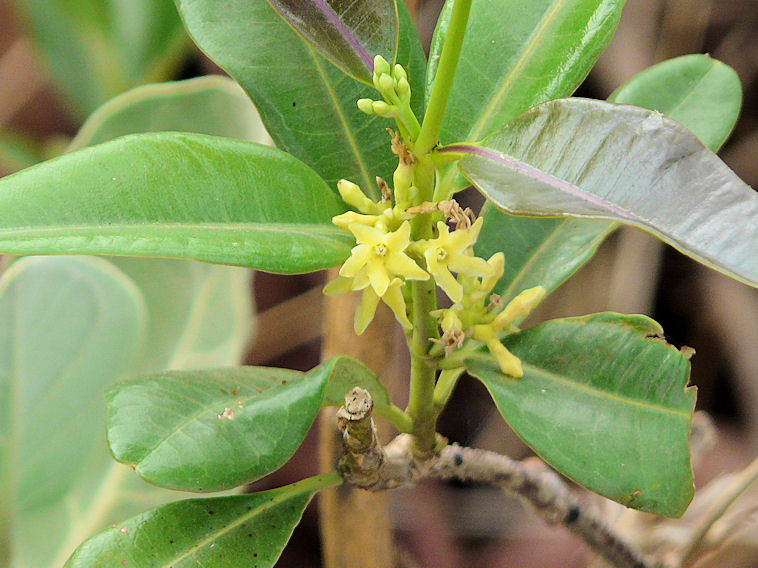
Abb.: उत्पलशारिवा
। Cryptolepis
buchanani Roem. & Schult.
[Bildquelle: dinesh_valke. --
http://www.flickr.com/photos/dinesh_valke/2463484893/. -- Zugriff am
2010-10-18. --
Creative
Commons Lizenz (Namensnennung, keine kommerzielle Nutzung, keine
Bearbeitung)]
| 31. yogyam ṛddhiḥ siddhi-lakṣmyau vṛddher apy āhvayā
ime योग्यं ऋद्धिः सिद्धिलक्ष्म्यौ वृद्धेर् अप्य् आह्वया इमे ॥३१॥ Folgendes sind Bezeichnungen Gedeih (वृद्धि - vṛddhi f.):
|
Colebrooke (1807): Nimmt an, dass die Bezeichnungen für Pflanzen namens ṛddhi bzw. vṛddhi sind, die er aber ebensowenig wie das PW identifizieren kann.